Commission, July 14, 2015, No M.7541
EUROPEAN COMMISSION
Decision
IAG / AER LINGUS
To the notifying party:
Dear Madam(s) and/or Sir(s),
Subject: Case M.7541 – IAG/AER LINGUS
Commission decision pursuant to Article 6(1)(b) in conjunction with Article 6(2) of Council Regulation No 139/20041 and Article 57 of the Agreement on the European Economic Area2
(1) On 27 May 2015, the Commission received a notification of a proposed concentration pursuant to Article 4 of Council Regulation (EC) No 139/2004 by which International Consolidated Airlines Group, S.A. ("IAG") acquires indirectly within the meaning of Article 3(1)(b) of the Merger Regulation control of the whole of Aer Lingus Group, plc. ("Aer Lingus") by way of a public offer (the "Transaction").
(2) IAG and Aer Lingus are hereinafter referred to as the "Parties".
1. THE PARTIES
1.1. IAG
(3) IAG is the holding company of each of British Airways Plc3 ("BA"), Iberia Líneas Aéreas de España, S.A.4 ("Iberia"), and Vueling Airlines, S.A.5 ("Vueling").6 The IAG airlines (BA, Iberia and Vueling) fly to around 200 destinations with approximately a further 200 destinations served under various codesharing relationships.
(4) BA has its main hub at London Heathrow (LHR) and also operates bases at London Gatwick (LGW) and London City (LCY). Iberia's main hub is at Madrid Barajas (MAD). Iberia also has franchise arrangements with Air Nostrum under the Iberia Regional brand. Vueling's main base is at Barcelona EI Prat (BCN). It also has significant operations at Malaga Airport (AGP), Brussels International (BRU) and Rome Fiumicino (FCO), as well as a number of smaller aircraft bases (1-3 aircraft) at other Spanish cities, depending on the season. Vueling rotates/overnights aircraft at a number of other airports in Europe.
(5) Both BA and IB are members of the oneworld alliance. Vueling is not a member of any alliance.
1.2. Aer Lingus
(6) Aer Lingus is a publicly listed Irish-based airline. Aer Lingus serves more than 75 destinations, primarily in the EEA and North America. Aer Lingus' main base is at Dublin (DUB) with operational bases at Belfast City (BHD), Cork (ORK), LGW, and Shannon (SNN).7
(7) Aer Lingus was previously a member of the oneworld alliance but has terminated the membership and left the alliance as of April 2007. Aer Lingus currently has codeshare agreements with Flybe8, United Airlines, Air Canada, KLM, BA, JetBlue and Etihad. Aer Lingus also has a franchise agreement with Stobart Air whereby Stobart Air operates services under the Aer Lingus Regional brand.
2. CONCENTRATION
(8) The proposed Transaction concerns an acquisition of sole control of Aer Lingus by IAG, through its subsidiary AERL Holding Limited, by way of a public offer.
(9) The offer document issued by IAG is subject to eight conditions precedent to closing. In particular, the Government Acceptance condition provides that the Minister for Finance of Ireland shall validly accept the offer in compliance with the requirements of the Irish Takeover Rules. The Ryanair Acceptance condition sets up that the Ryanair Group shall validly accept the offer under the same terms. The Connectivity Resolutions condition, negotiated between the Parties and the Irish Government, shall notably result in the creation of a new class of B share retained by the Minister for Finance and in the adoption of new rules governing the operation of the London-Heathrow slots currently held by Aer Lingus for up to seven years following the Transaction.
(10) Provided that all conditions are met, or where permitted waived by IAG, IAG will complete the offer and acquire sole control of Aer Lingus.
(11) The Transaction thus constitutes a concentration within the meaning of Article 3(1)(b) of the Merger Regulation.
3. EU DIMENSION
(12) The undertakings concerned have a combined aggregate world-wide turnover of more than EUR 5 000 million9. Each of them has an EU-wide turnover in excess of EUR 250 million, but each does not achieve more than two-thirds of its aggregate EU-wide turnover within one and the same Member State10. The notified operation therefore has an EU dimension.
4. MARKET DEFINITION
4.1. Overview of Parties' activities
(13) The Parties submit that the relevant product markets for the purpose of the assessment of the Transaction are (i) passenger air transport services, (ii) cargo air transport services,11 (iii) maintenance, repair and overhaul (MRO), (iv) ground handling, and
(v) landside cargo handling.
4.2. Air transport of passengers
(a) Origin and destination approach (O&D)
(i) Demand-side considerations
(14) In its decisional practice, the Commission has traditionally defined the relevant market for scheduled passenger air transport services on the basis of the "point of origin/point of destination" ("O&D") city-pair approach.12 Such a market definition reflects the demand-side perspective whereby passengers consider all possible alternatives of travelling from a city of origin to a city of destination, which they do not consider substitutable for a different city pair. As a result, every combination of a point of origin and a point of destination is considered a separate market.13
(15) The Parties do not object to this approach but submit that the market for passenger air transport services increasingly has a network dimension (in particular for long-haul carriers).14
(16) In addition, a large majority among all groups of respondents to the market investigation has confirmed the relevance of the O&D approach for the purpose of analysing the competitive effects on the overlap routes.15
(ii) Supply-side considerations
(17) The Commission has in its practice taken into consideration the network competition between airlines.16 This is particularly relevant on the supply-side, as network carriers build their network and decide to fly essentially on routes connecting to their hubs.
(18) While some network carriers argued that competition between carriers takes place on the network level,17 in line with the Commission's notice on market definition and with the Commission's decision practice,18 the Commission has given pre-eminence to demand-side substitution, whereby it considered that customers still need transportation from one point to another and that competition still takes place on an O&D city-pair basis.
(iii) Conclusion
(19) In light of the above, the effects of the Transaction will be primarily assessed on the basis of the city pair O&D approach, while all substitutable airports will be included in the respective points of origin and destination provided that they are perceived as substitutable by travellers. The question of airport substitutability will be examined for relevant O&D routes in Section IV.2.4.
(b) Distinction between groups of passengers
(20) The Commission has traditionally found that a distinction may be drawn between time sensitive ("TS" or premium) passengers and non-time sensitive ("NTS" or non-premium) passengers.19 Time sensitive passengers tend to travel for business purposes, require significant flexibility with their tickets (such as cost-free cancellation and modification of the time of departure, etc.) and tend to pay higher prices for this flexibility. Non-time sensitive customers travel predominantly for leisure purposes or to visit friends and relatives, book long time in advance, do not require flexibility with their booking and are generally more price-sensitive.
(21) The Parties do not regard the Commission's approach of distinguishing between TS and NTS passengers as meaningful,20 they consider21 that the line between TS and NTS passengers has never been clear-cut and has further blurred in recent years. In particular, the Parties submit22 that (i) airlines are increasingly offering a single cabin in their aircraft, and/or simply move the curtain (at least on short-haul flights) to change the demarcation between cabins, with little, if any, product differentiation; (ii) low-cost carriers ("LCCs") are increasingly attractive options for business travel; and (iii) any TS passengers buy restricted (or NTS) tickets and then simply purchase a second ticket or pay a fee if they are unable to make their booked flight.
(22) A majority of respondents in the market investigation has confirmed the Commission's approach of distinguishing between time sensitive and non-time sensitive passengers, acknowledging that this distinction was relevant for the assessment of the Transaction.23
(23) Several respondents24 have nonetheless indicated that the distinction between time sensitive and non-time sensitive passengers has become blurred; passengers are becoming increasingly price-sensitive in times of slow economic growth25 and more corporate customers apply lowest fare policies.26
(24) Moreover, several respondents to the market investigation have also indicated that on short-haul flights, the distinction between TS and NTS has become somewhat artificial.27 As argued by the Parties, there is indeed not much of a difference anymore in the offerings for TS and NTS passengers on short-haul routes. The transportation of both categories of passengers usually takes place in the same cabin and further product differentiation (e.g. included meals, newspapers and magazines) are mostly also available to NTS passengers for an upgrade fee.
(25) The market investigation has also shown that a substantial part of business customers increasingly choose LCCs for their business trips thus further levelling the differences between network carriers' traditional focus on TS customers and LCCs' traditional claim on NTS customers only.28 Conversely, European LCC carriers (who operate mostly, if not exclusively, short haul services) have developed over the recent years strategies to attract business customers. The "Business Plus" offering introduced recently by Ryanair is an example of this evolution.
(26) As concerns the argument that TS customers are willing to pay more for their ticket to have full flexibility regarding the time of their flight, TS customers increasingly adhere to the practice of buying restricted tickets and letting them lapse should they be impeded from taking the flight they had originally chosen.29 A substantial number of TS customers buy a new ticket for another flight instead.30
(27) For long-haul flights (in excess of six hours) however, a majority of respondents to the market investigation have indicated that a substantial part of the criteria originally justifying the distinction between TS and NTS is still in place (different cabins, different level of service, little competition yet from LCCs, etc.).31
(28) In light of the above, the Commission considers on balance that it is not appropriate in the present case to distinguish different markets for TS and NTS on short-haul flights. Instead a market comprising all passengers will be considered. Should it be necessary to distinguish between the needs of TS and NTS passengers on short-haul routes, this will be done in the framework of the competitive assessment.
(29) For long-haul routes, it may be still relevant to distinguish between TS and NTS passengers markets and the assessment will carried out for both groups of passengers. However, for the assessment of the Transaction, the conclusion on whether TS passengers and NTS passengers belong to the same market on long-haul flights can be left open as the outcome of the Commission's competitive assessment would not change under any alternative market definition.
(c) Markets for direct flights and indirect flights
(30) On a given O&D pair, passengers can travel either by way of a direct32 flight between the point of origin and the point of destination or by way of an "indirect" flight on the same O&D pair but via an intermediate destination.33
(31) The level of substitutability of indirect flights for direct flights largely depends on the duration of the flight. As a general rule, the longer the flight, the higher the likelihood that indirect flights exert a competitive constraint on direct flights.34
(32) When defining the relevant O&D markets for air transport services, the Commission has considered in previous decisions35 that with respect to short-haul routes (generally below 6 hours flight duration) indirect/indirect flights do not generally provide a competitive constraint to direct/direct flights absent exceptional circumstances (for example, the direct connection does not allow for a one-day return trip or the share of indirect flights in the overall market is significant).
(33) The Commission has in its practice36 considered that, with respect to long-haul routes (more than 6 hours flight duration), indirect flights constitute a competitive alternative to direct services under certain conditions (for example if they are marketed as connecting flights on the O&D pair in the computer reservation system).
(34) The Parties concur with the Commission's previous approach.37
(35) The respondents in the market investigation have demonstrated strong support for the distinction between direct and indirect flights for both short and long haul flights.38 A large majority of respondents to the market investigation confirmed that indirect services could constitute competitive alternatives to direct services as identified above.39 A majority of the respondents also confirmed that indirect services with a greater difference in duration constituted a smaller competitive constraint to direct services than indirect services with a shorter difference in duration.40
(36) However, for the assessment of the Transaction, the conclusion on whether or not direct and indirect flights belong to the same market can be left open as the outcome of the Commission's competitive assessment would not change under any plausible alternative market definition.
(d) Airport substitutability
(i) Framework of assessment
(37) When defining the relevant O&D markets for air transport services, the Commission previously found that flights from or to airports which have sufficiently overlapping catchment areas can be considered as substitutes in the eyes of passengers.
(38) In order to correctly capture the competitive constraint that flights from and to two (or more) different airports exerts on each other, a detailed analysis is necessary by taking into consideration the specific characteristics of the case at hand.41 Passengers take into account a number of elements like travel time, travel costs, flight times/schedules/frequencies and the quality of service when it comes to choosing between air transport services to and from different airports. The passenger's choice for one or the other airline service will ultimately be driven by a combination of these elements.
(39) The Commission's approach is to analyse the question of airport substitutability from the perspective of customers using the technique of bundling evidence.
(40) The evidence used to characterise airport substitutability includes inter alia a comparison of distances and travelling times to the indicative benchmark of 100 km/1 hour driving time,42 the outcome of the market investigation (views of the airports, the competitors, and other market participants), and the Parties' practices in terms of monitoring.
(41) Airport substitutability cannot be assessed in the abstract but can only be determined taking into account the characteristics of the passengers travelling on the routes at stake.
(42) In the present case, airport substitutability is particularly relevant for the routes to and from London, Belfast, Barcelona, New York and Chicago.
(ii) London airports
(43) The city of London is served by six airports, namely Heathrow (LHR), Gatwick (LGW), City (LCY), Stansted (STN), Luton (LTN) and Southend (SEN).
(44) The question of airport substitutability as regards the six London airports is relevant for two direct/direct overlap routes, namely ex-Dublin and ex-Belfast.
(45) Ex-Dublin, the Parties offer services from Heathrow. In addition, IAG flies to City, whereas Aer Lingus to Gatwick. Other competitors on the route are Ryanair which offers services from Gatwick, Luton and Stansted, and CityJet which operates from City.
(46) Ex-Belfast, the Parties operate from Heathrow. Aer Lingus flies also to Gatwick. Other competitors on the route are easyJet, which offers services from Gatwick, Luton and Stansted, and Flybe, which operates from City.
(47) Therefore, the substitutability of the London airports is relevant for determining to what extent the activities of the Parties overlap and for the assessment of the competitive constraints from airlines which currently operate or intend to operate in the near future at other London airports.
Precedents
(48) Previous Commission decisions suggested that a certain degree of substitutability exists between the London airports, at least for non-premium passengers.43
(49) Also, the Commission found in previous decisions that at least the airports of London Heathrow, London Gatwick, and London City were considered substitutable for both premium and non-premium passengers flying from London to Madrid and to Barcelona44 and that the airports of London Heathrow and London Gatwick were considered substitutable for both premium and non-premium passengers flying between London and Athens.45 The Commission also found evidence in past cases suggesting that a certain degree of substitutability may exist at least between some of these airports (i.e. Heathrow, Gatwick, and City) on specific routes.46
(50) In the IAG/Bmi decision47, the Commission assessed each of the relevant routes on the narrowest possible market, namely a market comprising flights to and from London Heathrow only. In addition, in line with the approach adopted in the decision relating to case M.5747 – Iberia/British Airways, the effects of the concentration were examined on a "London (three)" market comprising flights to and from Heathrow, Gatwick and City and also on a "London (five)" market comprising flights to and from Heathrow, Gatwick, City, Luton, and Stansted.
(51) In case M. 6663 – Ryanair/Aer Lingus III,48 the Commission considered that scheduled point-to-point passenger air transport services between Dublin, Cork, Shannon or Knock and the five London airports (Heathrow, Gatwick, City, Stansted and Luton) belong to the same market, while the question of whether Southend should also be treated as substitutable with the other London Airports was left open.
(52) In other decisions on long-haul flying from London, the Commission examined the effects of the concentration on a market comprising flights to and from Heathrow only, and on a wider market comprising flights to and from Heathrow, Gatwick and City, but the market definition was left open.49
Parties' views
(53) The Parties consider that all six London airports are substitutable regardless of the city-pair serviced on a market encompassing all passengers. In support of this assertion, they refer to the Commission's conclusion in case M. 6663 – Ryanair/Aer Lingus III.
(54) The Parties also argue that all six airports are attractive for TS passengers and are substitutable in terms of overall customer experience, due to the availability of similar "ground products" (online check-in, valet, bag drop, business lounge, etc.) at London airports, including similarities in IAG's own product offering at these airports.
(55) The Parties also refer to certain documents prepared some years ago by the UK CAA with respect to the various London airports.50 In addition, the six London airports have been considered as substitutable by the UK competition authorities, in the context of their review of Ryanair's minority stake in Aer Lingus.51
(56) The Parties also claim that the substitutability of London airports can also be seen by the way in which [IAG route planning strategy and monitoring activities].52
(57) As regards marketing activities, the Parties argue that the destination page on London for BA's website does not distinguish between the three London airports to which BA operates, simply stating "With regular flights to London from the world over, the city's never out of reach".53 However, among the documents the Parties submitted, there are also examples of advertisements for BA's Dublin and Belfast – London services that specifically single out London Heathrow: "To improve. To invest. To create the terminal voted the world's best. Flights from Dublin and Belfast now arrive into London Heathrow Terminal 5", or "Discover the world from Belfast. With connections via London Heathrow".54 Regarding Aer Lingus, the Parties submit that Aer Lingus' marketing strategy is generally city specific, focused around particular events in that city, regardless of the airport served in London, and that Aer Lingus' marketing campaigns are mainly run through newspapers, radio, and email emphasizing the level of frequencies it offers between Dublin and London. 55 In case M.6663 – Ryanair/Aer Lingus, it was also noted that on its website, under the destinations "London Gatwick", "London Luton" and "London Stansted", Ryanair describes the city of London and its main attractions.56 This is still the case today.
(58) Finally, the Parties acknowledge that airlines themselves may not be indifferent as to which London airport they fly to/from. In particular they refer to the importance of London Heathrow for network carriers. However, they argue that this fact should not prevent the Commission from concluding that services from any of the London airports are part of the same market.
Commission's assessment
(59) The assessment of a concentration shall be based on the specificities of the case
under review. Therefore, the assessment on the substitutability of London airports is tailored to the specificities of the present case, such as preferences of passengers travelling out of London to Dublin or Belfast, the degree of differentiation of the services offered by the merging parties and their competitors as well as the characteristics of each route.
(60) Regarding the availability of similar "ground products" at London airports, such similarities in offerings cannot constitute by themselves a basis for assessing demand-side substitutability of airports. Indeed, airports that are located in different, non-neighbouring countries, with no potential geographic overlap, could also provide similar ground products without being considered substitutable. The argument may however be relevant for the assessment of closeness of competition between carriers.
(61) Regarding documents prepared e.g. by the UK CAA with respect to the various London airports, the reports were already assessed by the Commission in the context of previous decisions.57 The Commission previously took the view that these various reports, even though they do support that there is indeed a certain degree of overlap between the catchment areas of the various London airports, are as such not sufficient to conclude whether or not flights offered from these various airports are substitutable for passengers travelling on specific routes.58 This conclusion still applies today.
(62) The Commission takes into account a range of evidence, enabling it to assess the extent to which substitution would take place, such as the 100km/1hour benchmark, the replies to competitors, airports and other relevant replies to the market investigation, the Parties' monitoring activities and internal documents.
(63) The travel distances and times between these airports and the centre of London, and certain other city districts, are summarised in Table 1:
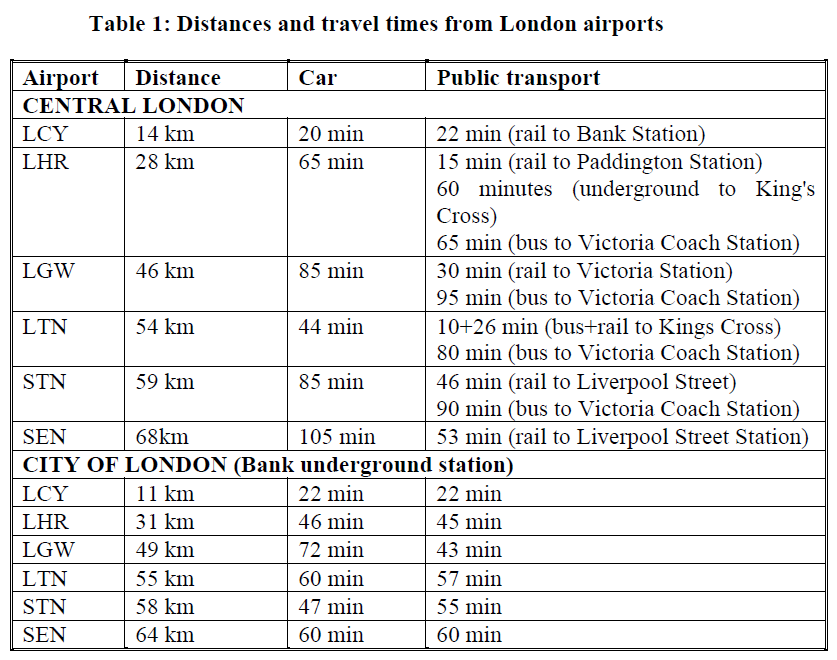

(64) All six airports are located within a 100 kilometre radius and an approximately one hour drive from London city centre as well as to other key financial London districts: the City of London (represented by Bank underground station) and London Docklands (represented by Canary Warf station). On the basis of the 100km/1 hour benchmark, all the London airports appear prima facie to be substitutable from the demand side for point-to-point scheduled passenger air transport services ex-Dublin and ex-Belfast in terms of distance and if the travel duration by car or public transport is considered.
(65) The Parties' internal documents indicate that both IAG and Aer Lingus take into consideration in their monitoring practices and commercial strategies the conduct of other airlines, including LCCs, across some London airports. [IAG route planning monitoring strategy]. [59] [60]
(66) In addition, [IAG assessment of constraint according to London airports]. This means that, although the Parties consider several London airports in their commercial strategies, the intensity of the competitive pressure exerted by the services offered by the Parties' rivals from a given London airport on the services provided by the Parties from another London airport may vary considerably.
(67) The market investigation indicates that there is a degree of differentiation across London airports for routes to/from Dublin or Belfast. The extent of such differentiation depends on several factors, such as the airport's catchment area, the types of services offered at the airport, and the different needs of passengers.61 For instance, the Dublin Airport Authority mentioned that ""[..] within this broad grouping of London airports there are likely to be varying degrees of substitutability between the individual airports/routes depending on price, market characteristics or intended use".62 Similarly, Ryanair answered that "A proper assessment requires a case-by-case analysis, taking into account of traffic origination, passengers profiles, distances involved, etc."63 Further, the degree of substitutability may also depend upon the length of the sector covered, as catchment areas increase with sector length. As pointed out by some market participants, for routes to London ex Dublin or Belfast, where the length of the sector is quite short, passengers may be less inclined to change their preferred airport, "as the additional time/cost required to get to their ultimate surface origin/destination is likely to be a greater proportion of the total travel time/cost".64
(68) The results of the market investigation on the substitutability between Heathrow and the other London airports on the London–Dublin and London–Belfast routes are assessed in detail in Sections V.6.1 and V.6.2 below.
(69) The Commission performed a quantitative analysis to determine the degree of competitive constraints exerted on Heathrow by Gatwick and City.65 The Commission's analysis assessed whether on a given city pair from London BA's and Aer Lingus' fares from Heathrow responded differently to an event specific to Heathrow than their fares from Gatwick and City, using the so-called difference-indifferences analysis. If the fares from Heathrow changed significantly more than the fares from Gatwick and City after a certain event, this would indicate that the competitive conditions at Heathrow were to some extent differentiated from those prevailing at Gatwick and City.
(70) The Commission used Heathrow-Glasgow, Heathrow-Edinburgh, Heathrow-Manchester (for BA) and Heathrow-Dublin (for Aer Lingus) as "event routes", that is, those routes where the event occurred.66 BA and Aer Lingus operate or operated also from Gatwick and City to the same destinations. The Commission used those routes as "control routes", that is, routes used to compare the evolution of the fares in the event routes.
(71) Although in some cases the observed variation in fares from Heathrow could not be linked based on the available information with a specific event under investigation, overall the results of the Commission's quantitative analysis indicated that BA's and Aer Lingus' fares from Heathrow appear to have responded differently than BA's and Aer Lingus' fares from Gatwick and City. Therefore, the empirical analysis suggests that the competitive conditions at Heathrow are to some extent differentiated from those prevailing at the other London airports.67
(72) The Parties presented a case study of the hub-to-hub Heathrow-Madrid airport pair, where it is argued that the fares in Heathrow-Madrid did not increase after the merger between BA and Iberia in 2011, and that there are several beneficial effects of a merger on a hub-to-hub airport pair.68 However, the study does not compare the Heathrow-Madrid fares with any other fare from another London airport to Madrid, which limits the insights that can be drawn from the study. Second, BA and Iberia were already under an alliance agreement since 2004, which allowed scheduling and pricing co-ordination. Hence, the 2011 merger would likely not have had any material effect on the pricing decisions of the merged entity BA-Iberia, as such decisions were already co-ordinated in the pre-merger period.69 For such limitations, the Commission considers the Parties' submission as inconclusive for the purpose of assessing the degree of competition across the London airports.
(73) The Parties also submitted another case study on London-Glasgow (previously submitted for the IAG/bmi merger) which argues in that the exit of bmi from the Heathrow-Glasgow airport pair did not have any material effect on the competition on the London-Glasgow city-pair.70 The study was already dismissed in the IAG/bmi decision.
(74) As a conclusion, in light of the above and of the other available evidence, the Commission considers that scheduled point-to-point passenger air transport services between Dublin and Belfast, and the six London airports belong to the same market. However London airports are differentiated and the degree of substitutability between the London airports is liable to vary depending on precisely which airports are taken into consideration for flights to/from Dublin or Belfast as well as on other factors, such as the preferences of passengers, the degree of differentiation of the services offered by the merging parties and their competitors, as well as the characteristics of each route.
(75) The assessment of the competitive constraints exercised on each of the relevant routes will be conducted in Section V.6.
(iii) Barcelona airports
(76) The city of Barcelona is served by three airports: El Prat (BCN), Girona-Costa Brava (GRO) and Reus (REU).
(77) The question of airport substitutability as regards El Prat, Girona-Costa Brava and Reus airport is relevant for the route ex-Dublin Airport, where Ryanair and the Parties both fly to El Prat airport (and in addition Ryanair flies from Girona-Costa Brava and Reus).
(78) In the Ryanair/Aer Lingus III decision, the Commission concluded that all three Barcelona airports were part of the same market for scheduled point-to-point passenger air transport services between Dublin and Barcelona.71
(79) The travel distances and times between these airports and the centre of Barcelona are provided in Table 2.
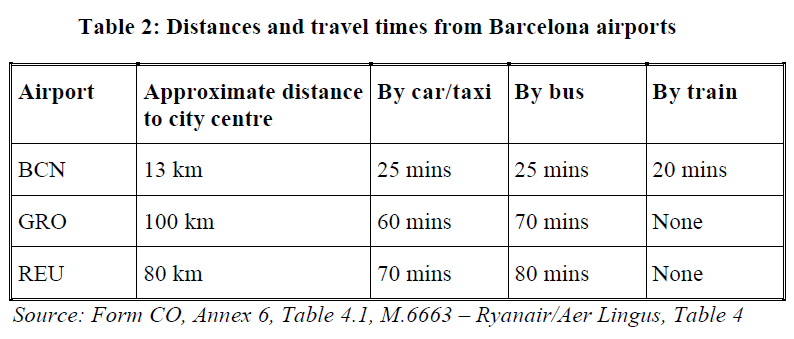
(80) The Parties submit that all three airports are substitutable for flights ex-Dublin.72
(81) All three airports are located within a 100 kilometre radius and an approximately one hour drive from Barcelona city centre. On the basis of the 100km/1 hour benchmark, Barcelona-El Prat, Girona-Costa Brava and Reus airports appear prima facie to be substitutable from the demand side for point-to-point scheduled passenger air transport services ex-Dublin in terms of distance and if the travel duration by car is considered.
(82) Some evidence collected through the market investigation indicates that point-to-point flights between Dublin on the one hand and the three Barcelona airports, would not belong to the same market. Indeed, the operator of Barcelona-El Prat, Girona-Costa Brava and Reus airport explained that "an increase by 5-10% in the price of flights is not enough to motivate a change of airport". 73 A majority of respondents to the market investigation in this particular case share this view.
(83) For the assessment of the Transaction, the conclusion on the substitutability of the three Barcelona airports can be left open, as no competition concerns arise under any alternative market definition.
(iv) Belfast airports
(84) Two airports serve the city of Belfast: Belfast International Airport (BFS)74 and George Best Belfast City Airport (BHD)75.
(85) The question of airport substitutability as regards the two Belfast airports is relevant for the route ex-London.
(86) Ex-London, the Parties fly to George Best Belfast City Airport. Other competitors on the route are easyJet, operating from Belfast International Airport, and Flybe, operating from George Best Belfast City Airport.
(87) As the Parties both fly to George Best Belfast City Airport, the substitutability of the two Belfast airports is not relevant for establishing the overlap, but for determining the competitive constraints from airlines which currently operate or intend to operate in the near future at the other Belfast airport.
(88) The Commission has not assessed the substitutability of the two Belfast Airports so far.
(89) The Parties consider that flights to/from both Belfast airports should be considered as substitutable.76 The Parties refer to two previous national regulatory authority decisions, with the UK Office of Fair Trading having found the two airports to be substitutable on both occasions.77
(90) The Parties also argue that both airports are attractive for TS passengers, and indicate that this is supported by the similarity of the "on the ground" products offered at each airport. Furthermore, the Parties claim that two events support supply-side substitutability: easyJet moved its Belfast–London service from George Best Belfast City Airport to Belfast International Airport in 2011 and Aer Lingus moved all of its services from Belfast International Airport to George Best Belfast City Airport in 2012.
(91) The travel distances and times between these airports and the centre of Belfast are provided in Table 3.

(92) Both Belfast airports are located within a 100 kilometre radius and less than one hour drive from Belfast city centre. On the basis of the 100km/1 hour benchmark, both Belfast airports appear prima facie to be substitutable from the demand side for point-to-point scheduled passenger air transport services ex-London in terms of distance and if the travel duration by car or public transport is considered.
(93) The George Best Belfast City Airport has one terminal, which provides capacity for six million passengers a year, and one runway. The second airport serving Belfast is Belfast International. This airport also has one terminal, which provides capacity for six million passengers a year, and two runways.
(94) During the market investigation, regarding the question of airport substitutability at both ends of the route, that is to say both at the Belfast end between the two Belfast airports, and at the London end between the various London airports, a majority of respondents indicated that flights on the routes George Best Belfast City Airport – London Heathrow or George Best Belfast City Airport – London Gatwick would not be substitutable with flights from Belfast International Airport (BFS) to another London airport. However, these results can be viewed in light of a significant degree of differentiation across London airports as previously described in Section IV.2.4.2. Indeed, a majority of respondents to the market investigation consider both Belfast airports to be substitutable for flights to/from London.
(95) In light of the above and of all other available evidence, the Commission considers that, for the relevant route, the two airports serving the city of Belfast (Belfast International Airport and George Best Belfast City Airport) belong to the same market.
(v) Chicago airports
(96) Chicago is served by two airports, O'Hare International Airport (ORD) and Midway International Airport (MDW). Long haul destinations in Europe, Asia, Africa, and the Middle East can be reached from O'Hare International, whereas Midway International focuses on services to North American destinations.
(97) The travel distances and times between these airports and the centre of Chicago are provided in Table 4.

(98) The Parties consider that O'Hare International Airport (ORD) and Midway International Airport (MDW) are substitutable.
(99) However, because the assessment of the Transaction would not change materially regardless of whether the two Chicago airports are considered to be part of the same market or not, the question of substitutability between these airports can be left open.
(vi) New York airports
(100) New York has three airports, namely JFK, Newark Liberty International Airport ("Newark") and La Guardia. La Guardia only serves North American destinations and there are no direct flights to and from La Guardia relevant for the assessment of the Transaction.78 La Guardia will therefore not be included in the airport substitutability analysis.
(101) The Parties consider that JFK and Newark should be regarded as substitutable for transatlantic flights from Dublin.79 Besides, the Parties refer to previous decisions where the Commission found that transatlantic services between London and JFK, on the one hand, and between London and Newark, on the other hand, were part of the same relevant market.80
(102) The travel distances and times between JFK and Newark and the New York city centre are provided in Table 5.

(103) JFK and Newark are located within a 100 kilometre radius and an approximately one hour drive from New York city centre. Furthermore, respondents to the market investigation have indicated that JFK and Newark are substitutable for both TS and NTS passengers.81
(104) Therefore, for the purpose of the assessment of the present transaction the Commission considers that JFK and Newark belong to the same market.
(e) Provision of access to flights of another carrier for connecting passengers in the context of interlining arrangements
(i) Parties' views
(105) The Parties consider that feed is not a relevant product market for the purposes of the application of the Merger Regulation; and that interlining and other feed traffic arrangements do not involve "supplies" made by an operator at a higher level of the supply chain to an operator at a lower level of the supply chain.82 In particular, the Parties submit83 that (i) airlines are not engaged in the provision of access to flights for connecting passengers. Rather, an airline designs its schedule, in part in conjunction with its partner airlines, to provide options for consumers to move from Point A to Point B. This resulting network may or may not provide connecting opportunities for third party carriers; and (ii) from the supply-side, an operator which operates a direct long-haul service can ensure that the operated sector has sufficient load-factor to be in several other ways than by using feed at points behind/beyond the relevant long-haul sector, including by attracting sufficient numbers of high margin point-to-point passengers from each end of the sector or by codesharing.
(ii) Commission's assessment
(106) "Connecting" or "transfer passengers" are passengers who fly indirectly on a given city-pair (e.g. Dublin-Chicago via London Heathrow). These passengers do not necessarily travel each "leg" or "sector" of their journey on the same carrier (e.g. the carrier who sold them the ticket). In particular for long-haul flights, traffic made up by passengers connecting at either or both ends of the route is commonly referred to as "feed traffic".
(107) There are a variety of agreements whereby single tickets may be sold for indirect journeys including two legs operated respectively by the two carriers which concluded the agreement. In the framework of such agreements, the carrier granting access to its flights to passengers connecting onto another carrier's flight and travelling with a single ticket issued by this second carrier provides an "input" to the latter and is remunerated for it. This "input" is used to supply the downstream service, i.e. a ticket for an indirect journey on a given city-pair. Two carriers that interline are thus engaged in a vertical relationship when one of them sells tickets for indirect journeys including one leg operated by the other carrier.84
(108) The main different types of "feeder traffic" or "interlining arrangements" are the following:85
a. IATA standard terms: IATA standards are effectively a default system for allowing passengers to travel from one place to another using two or more airlines. Multilateral Interline Traffic Agreement (MITA), which is the basis for giving carriers the ability to sell onto each other's service.86 MITAs provide a standard traffic document (i.e. passenger ticket) for these tickets and provide procedures for settlement of the revenue owed to the carrying airline (under the IATA Multilateral Prorate Agreement (MPA) and/or IATA Revenue Account Manual;87
b. Special Prorate Agreements (SPA), which provide a specific financial settlement in terms of flown tickets which can depart from the "default" financial settlement rules provided for by the MITA system88;
c. Codeshare agreements allowing one carrier to sell tickets on another carrier's flight under its own name and flight code. The carrier operating the flight is referred to as the ‘operating carrier', while the carrier marketing the flight under its own code is referred to as a ‘marketing carrier'. Although most airline alliance partners codeshare on flights (when permitted by regulators), not all codeshare agreements are between alliance partners. Codeshare agreements also include a set of operational and commercial agreements concerning at least access to, and prices for, seat inventory;
d. alliance memberships typically entail codesharing (although the details tend to be left to bilateral negotiations between the two relevant alliance members). Alliance membership typically implies a number of mutual obligations which go beyond those required by simple codesharing (for example, mutual Frequent Flyer Programme participation).
(109) These agreements are in principle mutually beneficial as they give each party the opportunity to increase its load factors. In principle, they also benefit passengers as they increase connection opportunities, allow passengers to be compensated in case of missed connections and spare them from taking back luggage at the connection airport.
(110) There are cases where both carriers can sell tickets for indirect journeys including one leg operated by the other party to the agreement. In such a situation, the vertical relationship is symmetrical: both carriers are active upstream and downstream in respect of one another. There are also cases where the ticket for the indirect journey is sold by a third party (e.g. a travel agent). In such situations, which also result from the existence of an agreement between the two carriers, these are active on closely related markets: they both provide inputs corresponding to each leg of the indirect journey, which are used to offer the downstream service (the indirect journey).
(111) Moreover, depending on which company sells a ticket for such indirect journeys (one of the two carriers or a third party such as a travel agent), the two carriers may be regarded as engaged in a vertical relationship or active on neighbouring markets.
(112) Overall, for the purposes of the present analysis, the exact nature of the relationship between the two carriers is of no relevance and the competitive assessment is the same no matter whether the two carriers are engaged in a vertical relationship or are active in closely related markets89, providing the "inputs" necessary to a sale of tickets for indirect journeys by a third party.90
(113) In any event, the carrier or distributor operating the downstream service sells a ticket for an indirect journey between two cities to a passenger. The downstream service is the market for the provision of air transport services between these two cities. As assessed above (see Section IV.2.1), this market has to be defined on an O&D basis, i.e. by reference to the two cities (or as the case may be, to the two airports) at both ends of the indirect itinerary. Depending on the specific O&D, such a downstream market may include services to various airports serving the same city and / or transport services relying on another mode than air.
(114) The carrier operating the upstream service provides to the downstream carrier or distributor access to its flights between one end of the city pair on which the indirect journey is offered, and a connecting airport (e.g. for indirect journeys between Dublin and San Francisco via London Heathrow, an upstream market for the provision of access to flights for connecting passengers corresponds to the Dublin–London Heathrow leg). Such an upstream market has to be also defined on the basis of the city / airport pair between which the flight to which access is provided is operated. Indeed, a carrier or distributor wanting to supply indirect journeys e.g. between Dublin and San Francisco via London Heathrow would need as an input access to flights between Dublin and London Heathrow. Flights between other cities cannot, in principle, constitute a valid substitute.
(115) Moreover, for the purposes of defining such an upstream market, it appears that when London Heathrow or London Gatwick is the connecting airport, it cannot be considered substitutable by other airports of the London area.
(116) Indeed, IAG underlines the possibility for connecting passengers to reach London Heathrow by transferring after flying to other London airports than Heathrow.
(117) However, respondents in the market investigation indicate that if certain cases of inter-airport connections may exist (mostly for very specific routings involving connections to/from Channel Islands at Gatwick), they appear to be marginal. In any event, inter-airport connections, while a growing trend, would hardly be regarded either by interlining carriers, travel agents or passengers connecting at Heathrow as an acceptable substitute for through-connections based on feed traffic to Heathrow.91 This would seem to be notably due to the extra time compared to a through-connection at Heathrow, the absence of through-check-in and through-baggage services.
(118) As a conclusion, it appears that the relevant markets for the provision of access to flights from a number of airports in Europe for connecting passengers in the context of interlining arrangements have to be defined on an O&D basis. This assessment is carried out in Section V.10. Furthermore, when Heathrow or Gatwick are the connecting hubs, it also appears that other London airports are not substitutable to them due to the limited amount of inter-airport connections.
4.3. Maintenance, repair, overhaul ('MRO')
(119) With regard to the product market definition, the Commission distinguished in earlier decisions four separate segments within the MRO market, namely (i) line maintenance, (ii) heavy maintenance, (iii) engine maintenance, and (iv) components maintenance.92
(120) The Parties agree with the Commission's previously established product market definition and a majority of respondents to the market investigation confirmed the Commission's view.93 They have also confirmed the Commission's definition of a geographic market.94
(121) With regard to the geographic scope of the market for MRO services, the Commission has found that heavy maintenance services might be at least EEA-wide, whereas line maintenance could be local in scope95 and engine maintenance world-wide.96 With regard to MRO services for components, the Commission considered these services to be world-wide.97 In other decisions, the Commission left open the geographic market definition with regard to MRO services.98
(122) The Parties submit that the precise scope of the geographic market definition for MRO can be left open.
(123) For the assessment of the Transaction, the precise scope of the product market definition and of the geographic market definition for MRO can be left open as the outcome of the Commission's competitive assessment would not change under any alternative market definition.
4.4. Groundhandling
(124) The Commission has previously concluded that ground handling services – consisting of ramp handling, passenger handling, baggage handling and airside cargo handling – constitute a relevant product market.99 The Parties agree with, and a majority of respondents to the market investigation in this case confirmed, the Commission's view. 100
(125) Therefore, for the assessment of the present Transaction, the relevant product market definition for the provision of groundhandling services encompasses ramp handling, passenger handling, baggage handling and airside cargo handling.
(126) As regards geographic market definition, the Commission has considered ground handling either at a single airport or airports within the same catchment area as the appropriate geographic parameters for assessment of ground handling markets.101
(127) For the purposes of analysing any impact the Transaction may have on the markets for the supply of ground handling services, the Parties consider the narrowest possible geographic market (individual airports) but the Parties note that the definition can also be left open in the present case as no competition concerns arise under any plausible market definition.
(128) In the present case, the market investigation was not entirely supportive of a single airport market definition.102 On the one hand, several respondents declared that groundhandling services offered (in particular at the affected Spanish airports) vary from airport to airport. On the other hand, other respondents indicated that from a demand side perspective, airlines sometimes bundle several airports in a common agreement with a supplier in a specific country, in order to achieve better conditions, thus contracting with one groundhandling supplier for all or a number of airports from/to where they operate. From the supply side, some respondents also indicated that one handler can serve several airports with the same staff and shift equipment dependent on summer and winter seasons operations.
(129) Therefore, it cannot be excluded that the market for groundhandling services may have a wider geographic dimension encompassing in some cases more than one airport. However, the precise definition can be left open as the Transaction does not raise serious doubts irrespective of the precise geographic market definition adopted.
4.5. Landside cargo handling
(130) Landside cargo handling may comprise many different services, including cargo terminal operations, warehousing and inventory control, cargo security, handling of dangerous goods, documentation for import and export, customs clearance, global cargo tracking or even live animal management.103
(131) The Commission has previously concluded that landside cargo handling is a separate relevant market from ground handling,104 but in earlier cases had left the question open.105
(132) As regards geographic market definition, the Commission has considered landside cargo handling either at a single airport or airports within the same catchment area as the appropriate geographic parameters for assessment of landside cargo handling markets.106 For the purposes of analysing any impact the Transaction may have on the markets for the supply of landside cargo handling services, the Parties have considered the narrowest possible geographic market (individual airports).
(133) For the purposes of this Decision, the precise scope of the product market definition and of the geographic market definition for landside cargo handling can be left open since the Transaction does not raise serious doubts under any plausible market definition
5. COMPETITIVE ASSESSMENT AIR TRANSPORT OF PASSENGERS
(134) The Parties’ activities overlap in a number of O&D routes as previously defined. In order to assess the impact of the Transaction on competition, the Commission will first set out (i) the methodology for calculating market shares, (ii) the conceptual framework of its analysis (notably regarding the treatment of joint ventures and airline alliances as well as the competitive situation likely to prevail absent the Transaction), and (iii) certain filters applied to exclude unproblematic routes from the competitive analysis. In addition, closeness of competition and the relevance of airport congestion for the competitive assessment will be discussed. Finally, the Commission will analyse the competitive impact of the Transaction on each of the affected routes with a view to determine whether it raises serious doubts as to a significant impediment to effective competition in the internal market or a substantial part of it.
5.1. Methodology for calculating market shares
(135) The Parties have submitted data on market size and market shares on the basis of IATA data for each relevant O&D route. The data were primarily obtained from the Passenger Intelligence Services tool ("PaxIS") developed by IATA's Business Intelligence Service. Since it does not cover all ticket sales (in particular, "LCCs") and most direct airline sales do not go through the IATA's Billing and Settlement Plan107, IATA uses statistical modelling to estimate total passenger numbers for airlines operating on a route ("PaxIS PLUS").
(136) The Commission has previously used Marketing Information Data Tapes ("MIDT") data108 and PaxIS PLUS data109 as appropriate proxy to estimate market shares for air transport of passengers.
(137) The Parties have also used data from survey evidence and actual flown data collected from the UK CAA, available across carriers on direct routes to/from the UK in winter 2013/2014 and summer 2014 IATA seasons.110
(138) The Commission has reviewed the data provided by the Parties, as well as data available from the Dublin Airport Authority ("DAA"), across carriers on direct routes to/from Ireland in winter 2013/2014 and summer 2014 IATA seasons.
(139) The Commission has also undertaken a market reconstruction for transatlantic routes, asking the Parties and their competitors to provide actual passenger numbers on two relevant O&D routes.111 The overall market shares as calculated on the basis of the market reconstruction confirmed the market shares calculated using PaxIS data.
(140) The Parties have indicated that complete PaxIS data for winter 2014 will not be available until at least June 2015.112 Therefore, the Parties have provided passenger data for winter 2013/2014 and summer 2014 IATA seasons only. However capacity data for winter 2014/2015 and summer 2015 IATA seasons were provided.
(141) The Commission is of the view that the methodology used by the Parties in order to gather relevant data is appropriate for the assessment of the Transaction.
5.2. Conceptual framework
(142) Prior to analysing the competitive impact of the Transaction, the conceptual framework for the assessment must be determined. In this respect, the Transaction raises the following conceptual issues:
(a) The treatment of the joint-ventures to which BA and Iberia belong for the purpose of both the determination of affected markets and the competitive assessment.
(b) The competitive situation likely to prevail absent the Transaction.
(143) The issues of slot availability and dominance of carriers at slot restricted airports are addressed as part the competitive assessment, notably in the assessment of airport congestion, the analysis of potential entry and exits in the route-by-route assessment, and the assessment of IAG's position at London Heathrow post Transaction.
(a) Treatment of joint ventures for the assessment of the Transaction
(144) BA and IB are members of the global "oneworld alliance".113 The members of the oneworld alliance have concluded several framework and implementing agreements, such as the Brand Alliance Agreement, the Global Brand Delivery Requirements and the non-Shareholder Membership Agreements.
(145) Consistent with the Commission's practice in previous cases,114 IAG's oneworld alliance partners are not generally considered as forming a single economic entity with IAG for the determination of affected markets.
(146) The exception is IAG's relationship with American Airlines (including US Airways following the AA/US merger)115 and Finnair as a result of the Transatlantic Joint Business Agreement entered into between BA, AA and IB on 14 August 2008 ("JBA") which was joined by Finnair on 1 July 2013. The JBA is a metal neutral business agreement between BA, IB, AA and AY, involving extensive cooperation such as revenue-sharing and joint management of schedules, pricing and capacity on all routes between North America and Europe.
(147) Consistent with the Commission's approach,116 each of the other metal neutral joint ventures are treated as a single entity for the purposes of assessing market shares.
(b) Competitive situation likely to prevail absent the Transaction
(148) The Parties consider that, absent the Transaction, the most likely outcome will be that Ryanair's stake in Aer Lingus will be returned to wide public ownership and that Aer Lingus will continue as an independent operator but will in the medium- to long-term need to engage in the pattern of consolidation that has begun in Europe's fragmented aviation sector.117 The Parties also highlight that Aer Lingus – one of the few remaining independent former flag-carriers – is limited in its ability to grow organically due to the constraints of the Irish market. While the short to medium-term scenario absent the Transaction is Aer Lingus' continuation as an independent carrier, a possible medium- to long-term perspective is that Aer Lingus would join the pattern of industry consolidation.118
(149) In assessing the competitive effects of a concentration, the Commission compares the competitive conditions that would result from the Transaction with the conditions that would have prevailed absent the Transaction. In most cases the competitive conditions existing at the time of the Transaction constitute the relevant comparison for evaluating its effects. However, in some circumstances, the Commission may take into account future changes to the market to the extent that they can be reasonably predicted. It may, in particular, take account of the likely entry or exit of firms if the merger did not take place when considering what constitutes the relevant comparison.119
(150) In the case at hand, looking e.g. at the financial situation of Aer Lingus, the Commission is of the view that it is likely that Aer Lingus would continue to operate in the medium term in a way similar to that in which it has operated until now. In light of the above, the Commission considers that the competitive conditions existing at the time of the Transaction constitute the relevant comparison for evaluating its effects.
5.3. Filters
(151) Consistent with its previous practice,120 the Commission has applied the following filters to exclude likely unproblematic routes from the scope of its investigation (all criteria must have been met in the 4 last completed IATA seasons121 and for all passenger segments for a route to be excluded under the filters):
(a) For direct/indirect overlaps:122
(i) the Parties' combined market share was below 25%; or
(ii) one of the Parties had a market share below 2%; or
(iii) short-haul routes where the total share of indirect operations in the relevant market was below 10%; or
(iv) at least one end of the city pair is outside the EU and the total annual traffic was below 30 000 passengers;123 or
(v) the route was below the HHI thresholds of paragraph 20 of the Horizontal Merger Guidelines.124
(b) For indirect/indirect overlaps:125
(i) the Parties' combined market share was below 25%; or
(ii) one of the Parties had a market share below 2%; or
(iii) as regards short-haul routes where the total annual traffic was below 15 000 passengers or as regards long-haul routes where the total annual traffic was below 30 000 passengers; or
(iv) the route was below the HHI thresholds of paragraph 20 of the Horizontal Merger Guidelines.126
(152) There have been no filters for direct/direct overlaps, therefore the general rules apply (there is no affected market if the Parties combined market share is below 20%). For these overlaps, the Parties have provided a competitive assessment based on direct services only (with the exception of Dublin–New York and Dublin–Chicago where the Parties have also provided an assessment including indirect services).127
(153) As a result of the above criteria the Parties submitted the routes, including direct/direct, direct/indirect and indirect/indirect overlaps, which would be affected by the Transaction.128
(154) The filters were applied consistently.
5.4. Closeness of competition
(a) General approach to closeness of competition issues
(155) The concept of "closeness of competition" may play an important role in better understanding the competitive constraint exerted by different competitors on each other in differentiated markets such as airline markets. 129
(156) For two airlines to be considered as offering services which are close substitutes to each other it is not necessary that the two services are identical. Some services may be closer substitutes than others. What matters from a substantive competition perspective is the high degree of substitutability between the services of the various carriers on the overlap city and airport pairs.
(157) Therefore, route-specific assessment of the closeness of competition between the Parties, and with the competitors on the relevant routes, will be conducted in Section V.6.
(158) However, some aspects of the analysis of the closeness of competition between the Parties, and with competitors, apply generally on the affected markets, and are therefore already presented here.
(159) The following sections will address general arguments in relation to closeness of competition, concerning the Parties' and competitors' market positions, their business models, their brands, and the existence of significant bases at route ends.
(b) Parties' and competitors' market positions
(160) In its assessment of closeness of competition, the Commission will take into account the market shares of the competitors on an affected market, as there is a strong presumption that two carriers are each other's closest competitors in those markets where each of the carriers are by far the largest competitors in terms of market shares.
(161) The Commission will also consider whether the Parties and their competitors operate from the same or from different airports. Even when different airports serving the same catchment area belong to same relevant market, the competitive constraint exercised on one another by carriers operating from the same airport pair may be higher than that exercised by carriers serving different airports.130 Therefore, carriers operating from the same airport are likelier to be each other's closest, or close, competitor than carriers serving different airports.
(c) Business models and brands
(162) Carriers offering scheduled air transport services form a heterogeneous group, with significant differences among carriers. Such differences among carriers relate mainly to the operating model followed by each company ("network" as opposed to "point-to-point" carriers) and to the level of service that is offered to passengers ("full service" as opposed to "low-frills" or "no-frills" carriers). Intermediate levels of services can also be provided by some carriers.131
(163) In this context, the services offered by different airlines will be considered to be close substitutes for one another it they reflect close business models and have a similar level of service.132
(164) Aer Lingus positions itself as a "value carrier" and has a level of services that is between that of low-frills/no-frills carriers and full-service carriers.133 BA and Iberia mainly follow a full-service business model, although on certain routes have adopted a model close to the low-frills/no-frills one. In particular, Iberia Express has been created as a low cost subsidiary of Iberia and operates up to two seasonal daily frequencies on the Dublin–Madrid route.134 Vueling operates a low cost model.135
(165) Both IAG and Aer Lingus offer similar products to their passengers, including different travel classes (Aer Lingus offers a split economy/business (Premier) cabin on long-haul routes), different fare classes (with some of them including refundability, both for long-haul and short-haul routes), loyalty programmes, access to airport lounges and support for connecting passengers.136 The two airlines carry significant numbers of business passengers,137 passengers on holiday and passengers visiting friends and relatives.
(166) Moreover, both IAG and Aer Lingus fly to main airports, while LCCs would fly more frequently to secondary airport bases. [IAG business strategy].138 However, several LCCs, including Ryanair recently, have offered more flights to main airports.
(167) In addition, promotional and marketing campaigns of both IAG and Aer Lingus target business and leisure customers in Ireland and the UK. In particular, the Parties acknowledge that "as a result of relentless [low-cost carriers] competition, British Airways' short-haul marketing campaigns are currently focused on reversing the customer perception, resulting from BA's traditional use of all-in fares which display poorly on price comparison websites, of BA being pricey and not relevant to their travel needs. In 2014 (and in plan for 2015) BA's LCY and LHR marketing teams worked together to deliver an advertising campaign designed to promote the Dublin– London and Belfast–London routes to business and leisure customers, and raise awareness of the move of these services to T5." 139 Conversely, Aer Lingus' marketing campaigns aim to "emphasise the quality of its services"140 which "suit [a] business budget".141
(168) The Parties' business models also coincide to some extent regarding network aspects. In particular, while the Aer Lingus' short-haul network is still primarily point-to-point, the airline has in recent years, similarly to a full-service carrier, further developed Dublin as a hub to connect its European routes with its growing transatlantic network.
(169) As indicated in the route-by-route analysis, both IAG and Aer Lingus take the behaviour of each other, and of other competing carriers into account in determining their prices. The Commission will consider the monitoring patterns in the route by route assessment conducted in Section V.6, as relevant.
(170) Ryanair is a major competitor to the Parties, and is present on three of the direct/direct overlap routes (London–Dublin, Dublin–Madrid, and Dublin–Barcelona). Ryanair has recently implemented a series of initiatives designed to improve customer experience, and has also begun to "aggressively" target business customers.142 Ryanair has indeed launched services such as "Business Plus", which includes priority boarding, premium seats, free airport check-in, and flexibility on ticket changes. 143
(171) The Commission considers that Ryanair's business model has thus evolved since the decision in M.6663 – Ryanair/Aer Lingus in February 2013. Ryanair's business model now includes certain services aimed at time-sensitive passengers, thus making it closer to Aer Lingus. [EI business strategy].144
(172) Overall, the Commission considers that both BA and Ryanair have become closer to Aer Lingus in terms of service (e.g. type of service, quality of services, pricing, level of frequencies, service on board and at the airport, etc.) on London–Dublin since February 2013.
(173) easyJet, which is a competitor of the Parties on the Belfast–London route, is the UK's largest airline by passengers flown and Europe's fifth largest airline by the same metric. The airline has also targeted the business travel segment expanded its distribution methods to include business travel agents and GDSs (Galileo, Amadeus and Sabre), in addition to its traditional self-booking tools.145
(174) Internal strategic documents of the Parties also exemplify the transition of these various competitors in the past years, such as in Figure 1 below.
Figure 1: [IAG business strategy]
Source: Form CO, annex 18.1, Exhibit 6 Part IV, page 17.
(175) Flybe is a regional carrier which has recently undergone a period of a brand re-launch, a redesigned website, a new advertising campaign, and improvements to the on-board experience. The Parties argue that Flybe is focused on business passengers with nearly half of its passengers falling into this category in 2013.146
(176) Another competitor of the Parties on the London–Dublin route is Cityjet. The Parties submitted that City Jet also offers comparable service propositions and is attractive for business travellers.147
(177) Overall, in light of the preceding, the Commission therefore considers that in recent years there has been a convergence of the business models of full-service and low-cost carriers.
(178) [BA business and marketing information].
Figure 2: [BA business and marketing information]148
Figure 3: [BA business and marketing information] Source: Form CO, annex 18.1, Exhibit 22
(179) [BA business and marketing information]149.
(d) Existence of significant bases at route ends
(180) Aer Lingus' main base is located at Dublin airport. Ryanair has a significant base at this airport, with 21 aircraft. 150
(181) Aer Lingus has an operational base at Belfast City (BHD) airport. easyJet has a base at Belfast International (BFS).
(182) BA has its main hub at London Heathrow and also operates bases at London Gatwick and London City. Ryanair has its biggest base at London Stansted (34 based aircraft) and another base at London Luton (4 aircraft). easyJet has bases at London Gatwick, London Stansted, London Luton, and London Southend.
(183) Iberia's main hub is at Madrid Barajas. Ryanair has 11 aircraft based at the same airport.
(184) Vueling's main base is at Barcelona El Prat. Ryanair has bases at Barcelona El Prat (10 aircraft), and Girona-Costa Brava (five aircraft).
(185) Furthermore, American Airlines – the JBA's USA partner – has hubs in several locations in the USA, including in New York at the John F. Kennedy International Airport (JFK) and in Chicago at the O'Hare International Airport (ORD). Delta also has a hub at JFK as well as significant operations at ORD. United has hubs in New York (Newark) and at ORD.
5.5. Airport congestion
(186) Capacity constraints exist to different degrees at airports relevant to the Commission's assessment. These constraints could make entry or expansion by airlines on routes to/from these airports more difficult. This is because in order to operate a flight to/ from a given airport an airline needs access to airport facilities, such as a runway, stands, and terminals.
(187) This Transaction mainly has an impact on flights to and from the six London airports: Heathrow, Gatwick, City, Luton, Stansted, Southend, and at Dublin airport. This Section will describe the airport congestion issue at these London airports and at Dublin airport, while constraints at the other end of the routes will be assessed where relevant in the respective route by route analysis (see below Section V.6).
(a) London Heathrow
(i) Slots at Heathrow
(188) Heathrow is a fully coordinated airport under the EU Slot Regulation (Level 3)151, meaning that each business and general aviation movement requires the prior allocation of a slot.
(189) Regarding allocated slots for summer 2015, IAG (BA and Iberia) – with 365 slot pairs per day (52.6% of all slots) – has the largest slot portfolio at Heathrow. The Lufthansa group's (including all wholly and partially owned subsidiaries: Germanwings, Swiss, Austrian and Brussels) percentage slot holding at Heathrow is 7.8%.152 Virgin has 35 slot pairs per day (5.1% of all slots) and Aer Lingus has 23 slot pairs per day (3.3% of all slots). Little Red (Virgin) currently uses 12 slots to operate short-haul operations from Heathrow. Nine of these slots were released by IAG to Little Red as part of the commitments in IAG/bmi. Little Red will cease all operations by the end of the summer 2015 season and the slots will revert to IAG, at least for the summer 2015 season.153 The Parties note that slots at Heathrow can be acquired through secondary slot trading or by leasing slots from other airlines.
(190) ACL, the slot coordinator at this airport, confirmed during the market investigation the known congestion situation of Heathrow regarding lack of slots and runway, terminal and stand constraints. ACL indicated that capacity is constrained by the air transport movement cap and the night noise limit where all night slots are historically allocated. There are a limited number of runway slots available on different days with no daily lined up slots available. Terminals are full to capacity at different times of the day with limited availability for growth and new entrants and it is expected that within the next 3 to 5 years, the continuation of the cap will restrict growth as demand outweighs runway/terminal capacity.154 HAL also indicated that slot shortages are expected to continue for the foreseeable future. Heathrow is currently seeking to increase capacity but even if permission to increase capacity is granted, it is not expected to materialize in the next 3 to 5 years.155
(ii) Access to infrastructure at Heathrow
(191) Currently, Heathrow airport has five terminals. IAG operates services from Terminals 1, 3 and 5. 156 [IAG business strategy].157
(192) In summer 2014, Aer Lingus moved its operations from Terminal 1 to Terminal 2, where it is now co-located with the Star Alliance carriers. 158
(193) [The parties' business strategy regarding LHR].159
(194) Some competitors argued that due to the Transaction, IAG would reinforce its presence at Heathrow and gain additional market power which would lead to various anti-competitive non-route specific effects. In addition to slot-related issues, these effects would in particular cover limited access to competitive ground facilities at Heathrow, and IAG's footprint at various terminals.160
(195) During market investigation, ACL confirmed that the air transport movement cap and the night noise limit have been reached and that there is limited runway/terminal availability, throughout all hours of the day between 05:00 and 21:55. Heathrow terminals are full to capacity at different times of the day with limited availability for growth and new entrants. 161 HAL also indicated that the runway is fully utilized throughout the period of operation and Heathrow has a legal planning limitation of 480 000 aircraft movements per year which is almost completely utilized, while other than improving operational efficiency and aircraft flows there are no measures expected in the next 3 years that will alleviate existing limitations.162 Overall, HAL stated that it expects "this transaction to have a neutral impact on slot access and it may have a positive impact on airport infrastructure services where airlines choose to consolidate support services such as ground handling and aircraft maintenance."163
(196) Therefore, there are constraints at Heathrow on airline access to slots during the entire operating day. It is not currently possible for an airline to rely on the slot pool at Heathrow to launch or extend services and each season there is either very limited availability or no availability at all. In addition, increased traffic growth also creates additional constraints on the existing infrastructure.164
(b) London Gatwick
(197) Gatwick is designated as a fully coordinated airport under the EU Slot Regulation (Level 3). The Parties note that Gatwick is slot constrained (i.e. there is limited slot availability) for most of the day and particularly in peak hours from June to September.165
(198) Regarding allocated slots for summer 2015, easyJet currently has the largest number of slot pairs at LGW, with 191 slot pairs per day (42.8% of all allocated slots). IAG has the second largest number with 81 slot pairs per day (17.9%), Norwegian Airlines has 34 slot pairs per day (7.5%) and Thompson has 30 slot pairs per day (6.65%). Aer Lingus has 10 slot pairs per day (2.1%). 166
(199) During market investigation, ACL, the slot coordinator at Gatwick confirmed that at this airport, in the summer 2014 and winter 2015 seasons, some of the early morning (07:00-08:55) and evening hours (18:00-18:55) are fully allocated to their capacity (both for arrival and departure) on all days of the week except for maybe Saturday, and that in addition there are also some hours where either departure or arrival capacity are restricted. Overall, ACL described a fragmented schedule, with allocation of slots possible with varying degrees of success on different days. ACL also indicated that the Night noise limit has been reached and that runway capacity is increasingly saturated due to traffic growth, also leading to reaching terminal capacity limits in summer 15 IATA season.167 Overall, Gatwick Airport Limited stated that it "do[es] not believe the transaction will affect the ability to access slots at Gatwick."168 A majority of respondents to the market investigation share this view.
(c) London City
(200) London City is designated as a fully coordinated airport under the EU Slot Regulation (Level 3). The Parties note that City is partly slot constrained in peak hours, but slots are readily available throughout most of the day.169
(201) According to ACL statistics, an airline can rely on the pool to launch or extend services at London City in both the summer and winter seasons. For example in the winter 2014 and summer 2015 IATA seasons ACL were able to accommodate all slot requests, with 92% of them as requested.170 There are however, besides the availability of slots, some other limitations at London City. Due to steep approach conditions, only short haul aircrafts certified to operate at London City are admitted so not all airlines will be able to operate into the airport as they may not have the appropriate aircraft. There is also a very limited capacity constraint for early morning runway movements during peak week.
(202) Regarding allocated slots for summer 2015, IAG currently has the largest number of slot pairs at London City, with 66 slot pairs per day (43.1% of all allocated slots). CityJet has the second largest number with 32 slot pairs per day (21.2%) and Flybe has 22 slot pairs per day (15.5%). Aer Lingus does not operate at London City.171
(d) London Luton
(203) Prior to the summer 2013 season, Luton was designated as a schedules facilitated (Level 2) airport in accordance with the IATA Worldwide Scheduling Guidelines, meaning there was potential for congestion during some periods of the day or week. Luton is now designated as a fully coordinated (Level 3) airport under the EU Slot Regulation.
(204) The Parties argue that barriers to entry at Luton are low as slots are available throughout the day, but acknowledge that there are some constraints on terminal capacity at peak departure times between 07:00-10:00 and 14:00-16:00. 172
(205) ACL were able to accommodate all requests to operate services at Luton in the summer 2015 IATA season, with 99% of movements being accommodated at the requested time.173 In the market investigation, the airport manager of Luton airport reported that the airport is constrained from 6:00 to 8:00 in the morning all the week long.174
(206) Regarding slots allocated for summer 2015, easyJet currently has the largest number of slot pairs at LTN, with 57 slot pairs per day (40.7% of all allocated slots). Wizz Air has the second largest number with 39 slot pairs per day (27.5%) and Ryanair has 19 slot pairs per day (13.5%). Air Nostrum, an Iberia franchise, has one slot pair per day (0.7%). Aer Lingus does not operate from Luton. 175
(e) London Stansted
(207) Stansted is designated as a fully coordinated airport under the EU Slot Regulation (Level 3). According to ACL statistics, an airline can rely on the pool to launch or extend services at Stansted in both the summer and winter seasons. For example in winter 2014 and summer 2015 ACL were able to accommodate all slot requests, with 96% of them at the requested time.176
(208) Regarding slots allocated for summer 2015, Ryanair currently has the largest number of slots at STN, with 172 slot pairs per day (68.6% of all allocated slots). easyJet has the second largest number with 33 slot pairs per day (12.8%), and Germanwings has 8 slot pairs per day (2.6%). Neither IAG nor Aer Lingus operate at Stansted.177
(f) London Southend
(209) Southend has one terminal which provides the airport with capacity for five million passengers a year. In 2013, Southend accommodated around one million passengers. The airport has one runway which can handle aircraft up to the size of a Boeing 757. The Parties indicate the airport is not slot restricted or congested and there is good capacity to start new flights at any time of the day.178
(210) London Southend Airport is indeed only designated as a Data Collection (Level 1) airport in accordance with the IATA Worldwide Scheduling Guidelines.
(g) Dublin
(211) Dublin airport is the only airport serving Dublin and is managed by the DAA, an Irish state-owned company which also manages Cork airport in Ireland. The airport currently has two terminals (T1 and T2) which together provide the airport with annual capacity of 35 million passengers. In 2013, Dublin accommodated 21 million passengers. The airport has two runways which have a maximum capacity of 48 movements per hour. The two runways at Dublin cannot be operated independently of each other and the use of the second runway was only possible 62.7% of the days in summer 2012. 179
(212) Dublin is designated as a fully coordinated (Level 3) airport under the EU Slot Regulation, meaning that each business and general aviation movement requires the prior allocation of a slot. The allocation of slots at Dublin is undertaken by Airport Coordination Limited (ACL). Based on the peak week in summer 2014, Aer Lingus had the largest number of slots at Dublin, with 115 slot pairs per day (43% of all slots used). Ryanair has the second largest number with 82 slot pairs per day (31%) and IAG (BA and IB) has 8 slot pairs per day (3%).180
(213) In Ryanair/Aer Lingus III,181 the Commission assessed in detail the congestion situation at Dublin airport. The Commission concluded that there was runway congestion at Dublin airport during morning peak hours and carriers may face some difficulties in having access to contact stands for early morning peak hour flights. This would contribute somewhat to the already high barriers to entry. The Commission concluded on the other hand that terminal capacity constraints did not appear to be a barrier to entry relevant for that concentration.
(214) The Parties claim that the assessment in Ryanair/Aer Lingus III looked at whether a new entrant could establish a significant base at Dublin which would replicate the competitive constraint that Aer Lingus and Ryanair placed on each other, which would not be a factor to the assessment of the current case, as the Transaction only involves an increment of two peak morning departure on the London–Dublin route. The Parties also indicate that IAG currently only operates two routes to Dublin: Dublin–Madrid and London–Dublin. It is scheduled to add a third route – a summer seasonal service to Barcelona – this summer. IAG accounted for approximately 3% of short-haul capacity at Dublin in 2014. The JBA only operates four routes (year round: Dublin–New York City and Dublin-Philadelphia; seasonally: Dublin-Charlotte and Dublin-Chicago).182
(215) The Parties consider that generally Dublin airport is not congested. The Parties acknowledge that there are some limitations on access to departure slots for peak morning periods which could present a barrier to entry to an airline looking to establish a sizeable base at Dublin offering peak morning services to a number of different destinations; however, according to the Parties these limitations should not present a barrier to carriers based at other airports looking to add a service to Dublin.183
(216) During the market investigation, DAA confirmed that Dublin Airport is runway capacity constrained during the peak morning hours between 06:00 and 07:55, with the most critical period between 06:00 and 07:30. In summer 2015, in cases where slots were not available at the initially requested times, demand was however accommodated as airlines choose to operate at surrounding hours. Finally, DAA indicated that there also are some operational limits of facilities at Dublin airport: certain check-in desks are constrained at certain peak hours, aircraft parking stands also, and notably due to the US Preclearance facility in Pier 4, this pier is constrained between 05:00 and 13:00 for key growth in transatlantic and Aer Lingus activity. The preclearance facility itself is constrained between 08:00 and 17:00. Finally, there are currently runway limitations for certain aircraft used for the ultra-long haul market.184
(217) DAA also expects demand and slot shortages to increase over the next 3 to 5 years, particularly for peak hours. To alleviate these shortages, a programme is ongoing to maximise the declared capacity of the existing runway, to update Air Traffic Control procedures, to introduce additional ground infrastructure, airspace capacity and monitoring and improving performance and efficiency. This programme will continue over the next two to three years. To alleviate constraints on air parking stands, it is planned to increase utilisation of remote stands in the airport and several process, productivity, technology and scheduling improvements are planned to alleviate constraints with regards to check-in desk and US preclearance facility operations.185
(218) Overall, DAA considers that the Transaction will not affect the situation at Dublin airport in terms of access to slots / airport infrastructure services for competitors of the Parties. A majority of respondents to the market investigation share this view.
5.6. Direct/direct overlap routes
(a) London–Dublin
(i) Route characteristics
(219) Approximately [4 000 000–4 100 000] passengers travel by air between Dublin and London each year, of which [3.500 000–3 600 000] are O&D passengers. The remaining passengers use the services to transfer (at either Dublin and/or London) onto other services.
(220) Around [1 500 000–1 600 000] and [2 500 000–2 600 000] passengers travelled between Dublin and London in the winter 2013/2014 and summer 2014 IATA seasons respectively, of which around [80-90]% and [80-90]% respectively travelled in the O&D route.186 In the winter 2013/2014 IATA season, [1 300 000–1 400 000] passengers, including [10 000–20 000] TS passengers, travelled on the O&D route. In the summer 2014 IATA season, a total of [2 200 000–2 300 000] passengers, including [200 000–300 000] TS passengers, travelled on the O&D route.187
(221) The nature of the route is a mix of business and leisure. The CAA survey shows that a relatively high proportion [20–30%] of O&D traffic on London–Dublin is travelling for business purposes.188
(222) In the winter 2013/2014 and summer 2014 IATA seasons, a majority of IAG's passengers on this route originated in the UK, [10-20]%–[20-30]% originated in Ireland, [5-10]%–[10-20]% in the US and the rest in other parts of the world. In the winter 2013 IATA season, a majority of Aer Lingus' passengers on this route originated in Ireland,189 while in the summer 2014 IATA season a majority of Aer Lingus' passengers originated in other parts of the world. 190
(ii) Parties' and competitors' operations
(223) IAG and Aer Lingus overlap on a city-by-city basis and on one airport pair, as they both offer direct services ex Heathrow to Dublin.
(224) IAG (British Airways) operates from Dublin to Heathrow and since the winter 2014/2015 IATA season has been offering services also to City.191
(225) Aer Lingus operates from Dublin to Heathrow and Gatwick. Aer Lingus has stopped to operate from Dublin to Southend since the summer 2014 IATA season.
(226) British Airways currently has a one-way, free flow codeshare with Aer Lingus, which allows British Airways to place its code on Aer Lingus flights for connecting passengers flying between Dublin and Heathrow and between Dublin and Gatwick. In addition, a codeshare on flights between Dublin and City which allows Aer Lingus to place its code on British Airways operated services became operational on 30 April 2015.192
(227) Ryanair operates from Dublin to Gatwick, Luton and Stansted.
(228) Air France/KLM offered services from Dublin to City in the winter 2013/2014 and summer 2014 IATA seasons and then exited the route.
(229) CityJet has been operating from Dublin to City since the summer 2014 IATA season. Since May 2014, CityJet does not belong anymore to the Air France/KLM group. 193
(230) Flybe operated from Dublin to Southend in the summer 2014 and winter 2014/2015 seasons. Flybe stopped its London—Dublin services from end of May 2015.
Frequencies
(231) Table 6 below illustrates the weekly flights operated by the Parties and the other carriers on this route in the winter 2013/2014, summer 2014, winter 2014/2015 and summer 2015 IATA seasons:
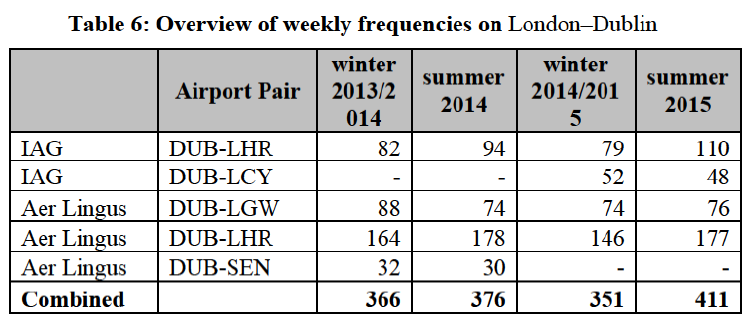
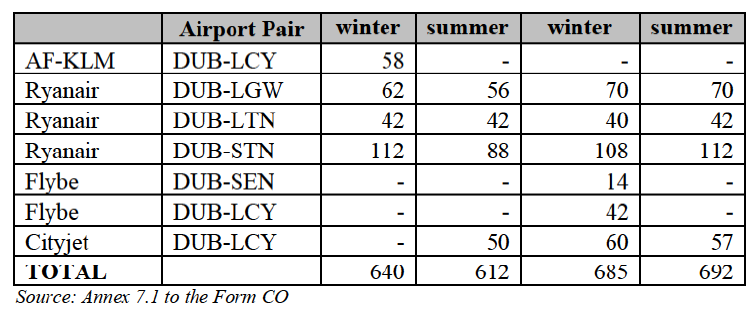
Market shares — capacity
(232) Table 7 below illustrates the total seat capacity offered by the Parties and the other carriers on this route in the winter 2013/2014, summer 2014, winter 2014/2015 and summer 2015 IATA seasons:
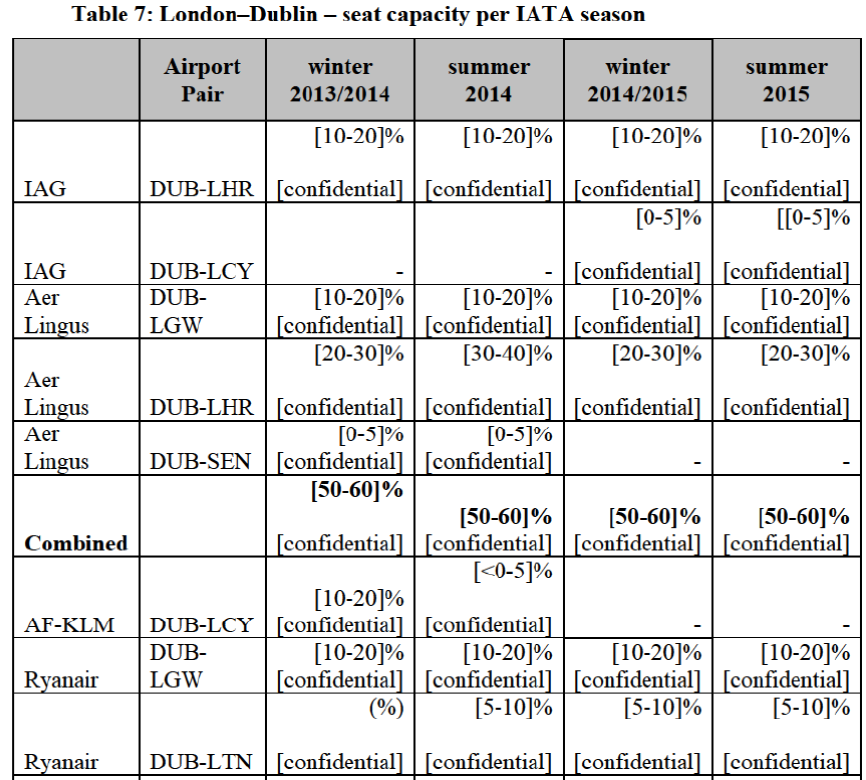


(233) Looking at operations at Heathrow, Gatwick and City ("London 3"), the Parties' combined capacity shares would be [60-70]% (with an increment of [20-301%) and [70-80]% (with an increment of [20-30]%) in the winter 2014/2015 and in the summer 2015 IATA season respectively.
Market shares — passengers
(234) Table 8 below displays the market shares of the Parties and their competitors on the London—Dublin route, looking at operations at all London airports:
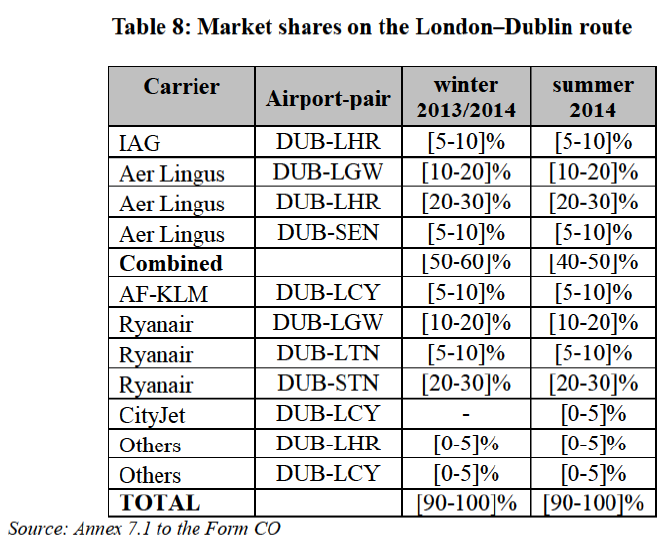
(235) Considering operations at London 3, the Parties' combined shares would be [70-80] % (with an increment of [10-201%) and [70-80]% (with an increment of [10-20]%) in the winter 2013/2014 and in the summer 2014 TATA seasons respectively.
(236) Looking at operations at Heathrow only, the Parties would have a monopoly in both seasons, with an increment of [20-30]% and of [20-30]% in the winter 2013/2014 and in the summer 2014 respectively.
(iii) Constraint exercised by competitors
Parties' views
(237) The Parties claim that IAG is not Aer Lingus' closest competitor on the London– Dublin route. To support this argument, they rely on the Commission's assessment of closeness of competition in case M. 6663 – Ryanair/Aer Lingus III, where it was stated that "[i]t is apparent that Aer Lingus is a closer competitor to Ryanair in comparison to IAG (British Airways) and CityJet [...]" in terms of product offerings, business models on this route and strong brand presence in Ireland. [Parties’ business strategy and monitoring activities].194
(238) In addition, the Parties claim that if operations to the London (three) airports or to other London airports are considered, the merged entity would face strong competition from other carriers such as Ryanair (from Gatwick, Luton and Stansted) and CityJet (from City).195
(239) In particular, the Parties state that Cityjet has increased its capacity by nearly [1020%] from the winter 2013 to the winter 2014 IATA seasons and by [5-10%] from the summer 2014 to the summer 2015 IATA seasons. Ryanair has increased its capacity at Gatwick by [10-20%] from the summer 2014 to the summer 2015 IATA seasons. According to the Parties, in the winter 2014/2015 IATA season, Ryanair's and CityJet's frequencies were convenient and represented a credible alternative to the Parties' flight times. The same would apply for their frequencies in the current summer 2015 IATA season.
Commission's assessment
(240) The assessment of the effects of the Transaction on this route will focus here on the extent to which the services offered by the Parties on this route can be considered close substitutes (see Section V.4)
(241) In this context, the Commission observes the following.
(242) When setting fares and capacities on the London–Dublin route, IAG monitors [Parties' business strategy] [196] [197] The monitoring focuses, inter alia, on competitor's fares and flight schedules, the airport(s) served and a competitor's position on a given route, including its market share and the capacity added or reduced on the route.198 Aer Lingus systematically monitors [Parties' business strategy].[199] With the exception of IAG, the remaining competitors monitored by Aer Lingus offer services to Dublin from London airports other than Heathrow.
(243) In addition, Aer Lingus tracks developments of fares and capacities across all London airports on this route. For example, [EI pricing strategy] [200]
(244) While the Parties' internal documents related to the London–Dublin route include certain references to all London airports, [Parties’ business strategy and monitoring activities].201 [202]
(245) In the assessment of the effects of the Transaction, the Commission considers that the fact that IAG and Aer Lingus monitor each other's fares and capacities as well as fares and capacities of the other carriers present on the London–Dublin route, and use information regarding the fares and capacities of the other carriers in their own decision-making as to pricing their own services is particularly relevant because it shows that IAG and Aer Lingus themselves see the other carriers as a competitive constraint on this particular route. Furthermore, such evidence indicates that all carriers on the London–Dublin route compete for the same customers.
(246) When promoting its services to London, IAG stresses that it serves Heathrow, using the new Terminal 5203, as well as other London primary airports well connected to the city centre: "British Airways flights serve all three major London airports; London Heathrow, London Gatwick and London City. With excellent transport options from each airport including the Tube, train or taxi, it's easy to reach the city centre and start discovering one of the world's most iconic cities".204 Aer Lingus' marketing strategy focuses simply on the city pair, without putting any emphasis on the particular airport served on this route.
(247) [205] [BA business and marketing information] [206]
(248) As regards the Parties' and their competitors' business models, over the last few years the differentiation gap between full-service network and low cost carriers has significantly diminished. Aer Lingus' operating model has evolved over time from a traditional full service carrier to a "value carrier", integrating features of both the low-cost and full-service carriers. For example, Aer Lingus, whose short-haul operations had until recently displayed characteristics of a low cost service, has announced the re-introduction of a short haul business class on top of its existing flexible fares.207
This move may be seen both as a response to Ryanair's new strategy to attract corporate travel,208 and as Aer Lingus' attempt to render its offering closer to that of British Airways on this route. Similarly, IAG's operating model has moved to the middle, by reducing the cost base and the level of service, in order to attract passengers for whom price is the primary driver of airline choice. For example, IAG (British Airways) has started to [IAG business strategy] and to introduce "hand baggage only" fares.209 On the other hand, Ryanair is upgrading its product offering, thereby moving closer to Aer Lingus, IAG and CityJet on this route, to appeal more to business passengers.
(249) Therefore, it appears, as also described in Section V.4.3, that since the decision in case
M. 6663 – Ryanair/Aer Lingus III the business models of carriers offering scheduled air transport services in short haul routes have tended to converge. As a result, those traditionally regarded as, respectively, full-service and low-cost carriers now offer services that, in the eyes of customers, are more comparable.
(250) On the London–Dublin route a relevant differentiating factor between the services offered by carriers appears to be the London airport served. It is logical to consider that while there is meaningful competition between airlines serving different airports across the London airports "competition within an airport pair is likely to be stronger than competition across airports in the same city".210
(251) A majority of corporate customers211 and competitors,212 indicated that Aer Lingus' closest competitor on this route is IAG, while travel agents213 stated that Aer Lingus' closest competitor is Ryanair, followed by IAG. A majority of the respondents to the market investigation indicated that the closest competitor of IAG on this route is Aer Lingus.214
(252) In its assessment of closeness of competition, the Commission also takes into account the market shares of the competitors on an affected market, as there is a strong presumption that two carriers are each other's closest competitors in those markets where each of the carriers are by far the largest competitors in terms of market shares. If operations from Heathrow, Gatwick, City, Luton and Stansted are considered, the market shares of the Parties and their competitors appear to indicate that Ryanair is likely to be closer to Aer Lingus. If operations from Heathrow, Gatwick and City are considered instead, in the summer 2014 IATA season, Aer Lingus and Ryanair would have higher market shares than IAG, which in terms of market share would be closer to CityJet.
(253) The Commission notes that the replies to the market investigation were mixed as to whether in case of a price increase at Heathrow consumers (meaning all passengers) would consider flights operated to Dublin from Gatwick, City, Luton, Stansted and Southend as valid alternatives for flights operated to the same destination from Heathrow.215 If passengers that are more time sensitive are considered, Heathrow seems to be a differentiated product compared to other London airports.216 Conversely, if passengers that are less time sensitive (and more price sensitive) are considered, a certain degree of substitutability exists between flights to Dublin from Gatwick and City on the one hand and from Heathrow on the other hand. 217
(254) Moreover, customers travelling for business seem to increasingly apply "cheapest on day policies" and choose low cost carriers for their business trips on short-haul routes.218 This means that low cost carriers exert a growing constraint on the Parties' operations on this route also in connection with business travel. In particular, Ryanair's flights ex Gatwick is to a certain degree already constraining the Parties' operations ex Heathrow also regarding more time sensitive passengers.
(255) [IAG's internal analysis on customers' purchases patterns][219]
(256) [EI business strategy]. The Parties' evidence also includes instances when a decrease of traffic share in Heathrow occurred simultaneously with a capacity increase in City airport, while no other capacity variations had occurred across other London airports.220
(257) Therefore, the Commission concludes that although operations from Heathrow to Dublin seem to be a somewhat differentiated product compared to operations to Dublin from other London airports (at least for certain more time-sensitive passengers), the evidence gathered during the market investigation indicates that the Parties' operations at Heathrow are constrained by other airlines' operations at Gatwick and City.
(258) Finally, the Commission considers that the replies to the market investigation were mixed as regards the degree of competition that would remain on this route post-Transaction and whether there would be sufficient competition to prevent the merged entity from raising prices.221
(259) In light of the above, the Commission assesses the effects of the Transaction considering operations at Heathrow, Gatwick and City, where the combined operations of the Parties would be significant. Generally, the Transaction would lead to the removal of the competitive rivalry existing between IAG and Aer Lingus, which has been an important source of competition on the London–Dublin route, for all passengers but also in particular for more time sensitive passengers.
(iv) Entry/expansion
(260) The London–Dublin route is subject to the barriers to entry described in Section V.5 above.
(261) The Parties claim that the economic situation in Ireland has significantly improved compared to the one existing at the time of the decision in case M. 6663 – Ryanair/Aer Lingus III. This upturn would favour entry and/or expansion at Dublin and specifically on the London–Dublin route.
(262) As an example of a recent entry, the Parties mention that IAG launched new services from Dublin to City for the winter 2014/2015 IATA season and subsequently expanded these services by adding a daily frequency.
(263) The Parties further submit that there is room for Ryanair and Cityjet222 to expand their capacity at Gatwick and City respectively, following the exit of Flybe as of May 2015. In addition, the Parties claim that Ryanair has been constantly expanding its operations at Dublin and will further increase its frequencies on the London–Dublin route.223
(264) Although Flybe has recently exited the route, the Parties argue that it would be well-placed to re-enter the route. Finally, they claim that carriers with bases in London, such as Norwegian, easyJet and Wizz air might easily enter the route if they wish to do so.
(265) Contrary to the above arguments, the Commission notes that some respondents to the market investigation also indicated that on this route barriers to entry are high, and specifically as regards to very limited access infrastructure (slots and terminals) at Heathrow and at Gatwick.224 As for Dublin, a majority of competitors estimated that there are no significant barriers to entry or expansion. Some competitors indicated however that Dublin is becoming increasingly constrained operationally, but others indicated that there are no slot barriers. 225 Overall, based on the evidence available to it, the Commission considers that while Dublin airport is capacity constrained during the peak morning hours, airlines possessing a significant percentage of the total slots available at the airport, including at peak hours, (as is the case for airlines with large bases at Dublin), would face a reduced barrier at that airport for entry or expansion on the London–Dublin route. However, such airlines would still face high barriers to entry or expansion at Heathrow and/or Gatwick.226
(266) In addition, the Commission did not identify during the market investigation any likely, timely and sufficient entry/expansion plans regarding the London–Dublin route that would be capable of adding sufficient competitive constraint on the Parties' operations at Heathrow, Gatwick and City, at least in the absence of relevant commitments.
(v) Conclusion on the London–Dublin route
(267) In light of the above and of the other available evidence, the Commission considers that the Transaction raises serious doubts as to its compatibility with the internal market with respect to the London–Dublin route.
(b) Belfast–London
(i) Route characteristics
(268) Approximately 2 million O& D passengers travel by air between Belfast and London each year. These O&D passengers account for around 95% of traffic on the route. The remainder are passengers using the service to transfer (at either Belfast and/or London) onto other services.227
(269) Around [500 000–1 000 000] and [1 200 000–1 300 000] passengers travelled
between Dublin and Belfast in the winter 2013/2014 and summer 2014 IATA seasons respectively, of which [90-100%] travelled in the O&D route respectively.228 In the winter 2013/2014 IATA season, [500 000–1 000 000] passengers travelled on the O&D route. The percentage of TS passengers out of the total number is insignificant.229 In the summer 2014 IATA season, a total of [1 100 000–1 200 000], passengers, including [60 000–70 000] TS passengers, travelled on the O&D route.230
(270) The nature of the route is a mix of business and leisure. The CAA survey shows that a relatively high proportion (approximately 35%) of O&D traffic on Belfast–London is travelling for business purposes.231
(271) In the winter 2013/2014 and summer 2014 IATA seasons, almost all of IAG's passengers on this route originated in the UK, up to [0-5]%; in the US and around [510]% in other parts of the world. In the winter 2013 IATA season, a majority of Aer Lingus' passengers on this route originated in Ireland232, while in the summer 2014 IATA season a majority of Aer Lingus' passengers originated in other parts of the world.233
(ii) Parties' and competitors' operations
(272) IAG and Aer Lingus overlap on an airport pair basis at both ends of the route, as they both offer direct services ex George Best Belfast Airport to Heathrow. Aer Lingus also offers services from George Belfast Airport to Gatwick.
(273) BA currently has a one-way, free flow codeshare with Aer Lingus which allows BA to place its code on Aer Lingus flights for connecting passengers flying on George Best Belfast City Airport and London Gatwick.
(274) Other carriers operating the route are easyJet and Flybe.
(275) easyJet operates flights from Belfast International Airport to Gatwick, Luton and Stansted. In the winter 2013/2014 IATA season, it also offered services from Belfast International Airport to Southend but ceased its operations in January 2014.
(276) Flybe has been offering services from George Best Belfast Airport to City since the summer 2014 IATA season. In the winter 2013/2014 IATA season, Flybe operated from George Best Belfast International to Gatwick.
Frequencies
(277) Table 9 below illustrates the weekly flights operated by the Parties and the other carriers on this route in the winter 2013/2014, summer 2014, winter 2014/2015 and summer 2015 IATA seasons:
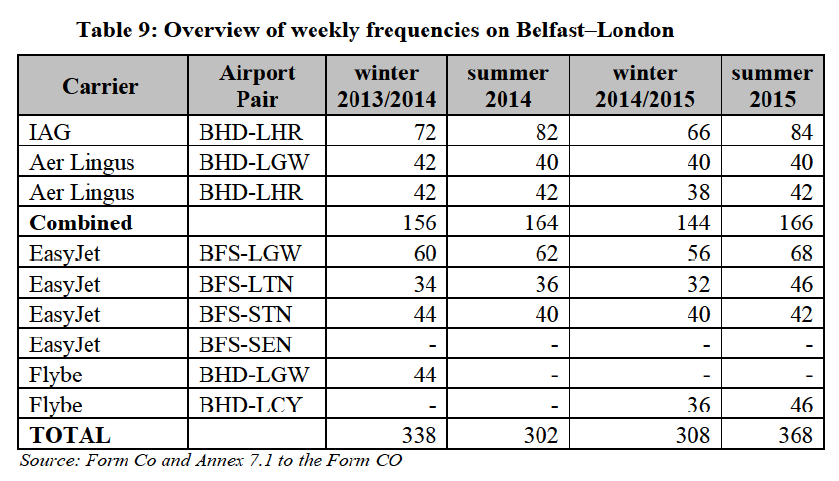
Market shares — capacity
(278) Table 10 below illustrates the market shares based in seat capacity of the Parties and the other carriers operating on this route in the winter 2013/2014, summer 2014, winter 2014/2015 and summer 2015 IATA seasons:
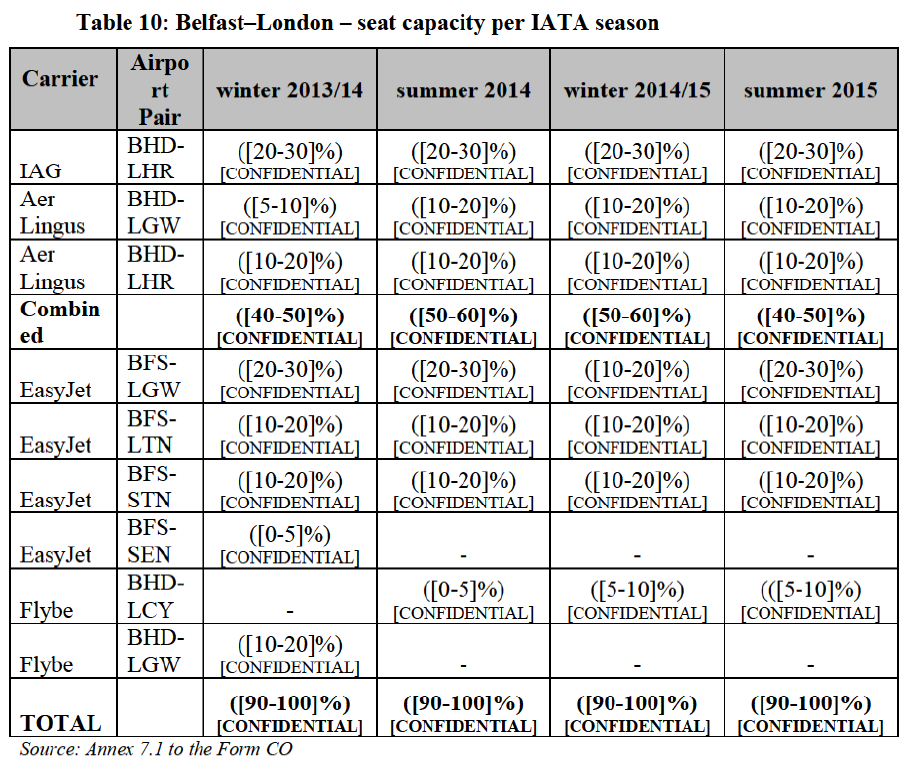
(279) Looking at operations at London 3, the Parties' combined capacity shares would be [60-70%] with an increment of [30-40%] and [60-70%] with an increment of [30-40%] in the winter 2014/2015 and in the summer 2015 IATA season respectively.
Market shares — passengers
(280) Table 11 displays the market shares of the Parties and their competitors on the London—Dublin route:
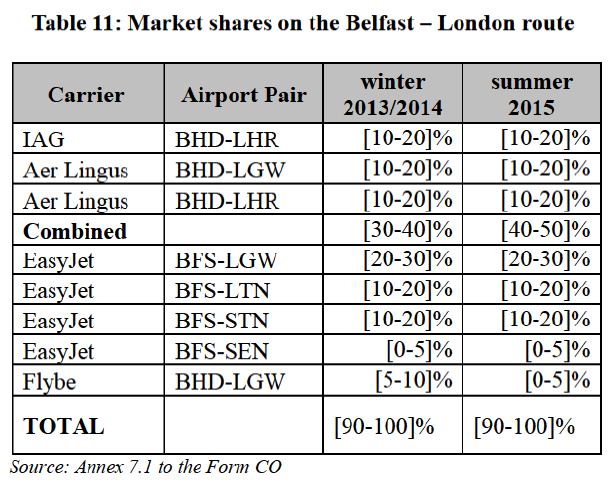
(281) Considering only operations to London 3, the Parties' shares would be [50-60%] (with an increment of [20-30%]) and [60-70%] (with an increment of [20-30%]) in the winter 2013/2014 and in the summer 2014 IATA season respectively.
(282) Considering operations to Heathrow only, the Parties would have a monopoly in both seasons, with an increment of [30-40%] and of [40-50%] in the winter 2013/2014 and in the summer 2014 IATA seasons respectively.
(iii) Constraint exercised by competitors Parties' views
(283) The Parties claim that LAG is not Aer Lingus' closest competitor on the Belfast — London route. To support this argument, they claim that Aer Lingus' service proposition and business model are closer to that of a point-to-point low cost carrier such as easyJet than a full-service network operator like IAG.234 [Parties' business strategy and monitoring activities].[235]
(284) In addition, the Parties claim that if operations to the London (three) airports or to other London airports are considered, the merged entity would face strong competition from strong players such as easyJet (from Gatwick, Luton and Stansted) and Flybe (from City).236
Commission's assessment
(285) The assessment of the effects of the Transaction on this route will focus on the extent to which the services offered by the Parties on this route can be considered close substitutes (see Section V.4).
(286) In this context, the Commission observes the following.
(287) [The parties’ respective strategies for the setting of fares and capacities] [237] [238]
(288) [The parties’ respective strategies for the setting of fares and capacities ].[239][240]
(289) [The parties’ respective strategies for the setting of fares and capacities]
(290) When promoting its services to London from Belfast, IAG stresses that its only flights serve Heathrow and in particular the new Terminal 5: "To improve. To invest. To create the terminal voted the world's best. Flights from Dublin and Belfast now arrive into London Heathrow Terminal 5".241 Conversely, Aer Lingus' marketing strategy focuses on the city pair, without putting any emphasis on the particular airport served on this route.
(291) [BA business and marketing information].[242] IAG's and Aer Lingus' brands are perceived as being the strongest brands on this route by a majority of respondents to the market investigation.243
(292) As also described in Sections V.4.3 and V.6.1, service offerings of airlines on short haul routes tend to converge. As a result, full-service and low-cost carriers tend to offer more comparable services in the eyes of customers. This applies clearly to the Belfast–London route.
(293) Similarly to the London–Dublin route, a differentiating factor between the services offered by carriers on this route appears to be the London airport served.244 It is logical to consider that while there is meaningful competition between airlines serving different airports across the London airports "competition within an airport pair is likely to be stronger than competition across airports in the same city".245
(294) A majority of corporate customers246 travel agents247 and competitors248, indicated that Aer Lingus' closest competitor on this route is IAG. A majority of the respondents to the market investigation indicated that the closest competitor of IAG on this route is Aer Lingus.249
(295) In its assessment of closeness of competition, the Commission will take into account the market shares of the competitors on an affected market, as there is a strong presumption that two carriers are each other's closest competitors in those markets where each of the carriers are by far the largest competitors in terms of market shares. If operations from Heathrow, Gatwick, and City are considered, the shares of the Parties and their competitors appear to indicate that easyJet is likely to be closer to Aer Lingus. If operations from Heathrow, Gatwick, City, Luton and Stansted are considered instead, in the summer 2014 IATA season, easyJet would have higher shares than each of the Parties.
(296) The Commission notes that the replies to the market investigation gave mixed results as to whether in case of a price increase at Heathrow consumers (meaning all passengers) would consider flights operated to Belfast from Gatwick, City, Luton, Stansted and Southend as valid alternatives for flights operated to the same destination from Heathrow. 250
(297) If passengers that are more time sensitive are considered, Heathrow seems to be a somewhat differentiated product compared to other London airports.251 Conversely, if passengers that are less time sensitive (and more price sensitive) are considered, a certain degree of substitutability exists between flights to Belfast from Gatwick and City on the one hand and from Heathrow on the other hand. 252
(298) Moreover, customers travelling for business seem to increasingly apply "cheapest on day policies" and choose low cost carriers for their business trips on short-haul routes.253 As observed in relation to the London–Dublin route (Section V.6.1.3), this means that low cost carriers exert a growing constraint on the Parties' operations on this route also in connection with business travel. In particular, easyJet's flights ex Gatwick is to a certain degree already constraining the Parties' operations ex Heathrow also regarding business passengers. This is the result of the recent easyJet's repositioning in the market, which focuses on being an alternative to full-service carrier for budget-conscious business travel.
(299) Therefore, the Commission concludes that although operations from Heathrow to Belfast seem to be a somewhat differentiated product compared to operations to Belfast from other London airports (at least for certain more time-sensitive passengers), the evidence gathered during the market investigation indicates that the Parties' operations at Heathrow are constrained by other airlines' operations at Gatwick and City.
(300) Finally, of the respondents to the market investigation that expressed a view on the degree of competition that would remain on this route post-Transaction, a majority considered that there will be sufficient competition to prevent the merged entity from raising prices.254
(301) In light of the above, the Commission assesses the effects of the Transaction considering operations at Heathrow, Gatwick and City, where the combined operations of the Parties would be significant. Generally, the Transaction would lead to the removal of the competitive rivalry existing between IAG and Aer Lingus, which has been an important source of competition on the Belfast–London route, for all passengers but also in in particular for more time-sensitive passengers.
(iv) Congestion at Belfast airports – Entry/expansion
(302) George Best Belfast City and Belfast International are designated as schedules facilitated (Level 2) airports under the EU Slot Regulation, meaning that there is potential for congestion at some periods of the day.
(303) The Parties claim that neither of the Belfast airports is coordinated nor congested and that there is capacity to start new flights or expand existing operations at any time of the day. 255
(304) The airport manager of Belfast City reported that while the airport is not slot-constrained, airlines might suffer certain limitations in accessing the airport due to the length of the runway and the operating hours (6:30-21:30, with extensions up to midnight).256
(305) The route Belfast–London is also subject to the barriers to entry described in Section V.5.
(306) However, as an example of recent entry, the Parties mention Flybe, which as of the summer 2014 IATA season re-entered the route from its new City base with three return flights per day, which will rise to four per day in 2015.257
(307) The Parties further claim that potential new entrants would be Jet2, which recently launched new international routes from Belfast International Airport258, Wizzair, which operates at Belfast International Airport and has recently announced new operations259, Norwegian, from its base at Gatwick and Ryanair, which has operations from City of Derry Airport (located at approximately 1 hour 30 minutes by car from Belfast) to Stansted.
(308) easyJet has recently announced that as of winter 2015 it will increase its capacity on the route by 125 000 seats as compared to winter 2014.260 However, easyJet's increment in capacity will be spread over three London airports, namely Gatwick, Stansted and Luton, only one of which is relevant for the assessment of the effects of the Transaction on the Belfast–London route. Therefore, the Commission does not consider easyJet's expansion plans capable of adding sufficient competitive constraint on the Parties' operations on the Belfast–London route.
(309) Respondents to the market investigation indicated that on this route barriers to entry are high, due to very limited access to relevant infrastructure (slots and terminals) at Heathrow and to certain extent at Gatwick.261
(310) Finally, the Commission did not identify during the market investigation likely, timely and sufficient entry plans regarding the Belfast – London route that, in addition to the expansion plans described above, would be capable of adding sufficient competitive constraint on the Parties' operations, at least in the absence of relevant commitments.
(v) Conclusion on the Belfast–London route
(311) In light of the above and of the other available evidence, the Commission considers that the Transaction raises serious doubts as to its compatibility with the internal market with respect to the Belfast–London route.
(c) Dublin–Madrid
(i) Route characteristics
(312) In the winter 2013/2014 and summer 2014 IATA seasons, a total of [300 000400 000] passengers travelled between Dublin and Madrid, of which [80-90%] travelled in the O&D route.262 The remainder are passengers connecting to/from behind/beyond routes (at either Dublin and/or Madrid). In the winter 2013/2014 IATA season, [100 000–200 000] passengers travelled on the O&D route. In the summer 2014 IATA season, a total of [200 000–300 000] passengers.263
(313) According to the Parties, the route has a strong leisure focus [Parties' cost and price structures].[264]
(314) The route has no significant seasonal patterns. 265
(315) Based on an analysis of point of sale, a majority of Aer Lingus' and IAG's passengers on this route originate at the Spanish end of the route, namely in Madrid. [40-50%] of Aer Lingus' passengers and only [10-20%] of IAG's passengers originated from Ireland in summer 2014 IATA Season.266
(ii) Parties' and competitors' operations
(316) Both Parties operate the route with non-stop services. Iberia and Aer Lingus overlap on an airport-to-airport basis, namely Dublin–Madrid Barajas.
(317) The Parties' only competitor on the route is Ryanair, Spain's largest carrier by passengers in the Spanish medium- and short-haul space, which also operates on the same airport-pair.
Frequencies
(318) Table 12 below illustrates the weekly flights operated by the Parties and the other carriers on this route in the winter 2013/2014, summer 2014, winter 2014/2015 and summer 2015 IATA seasons:
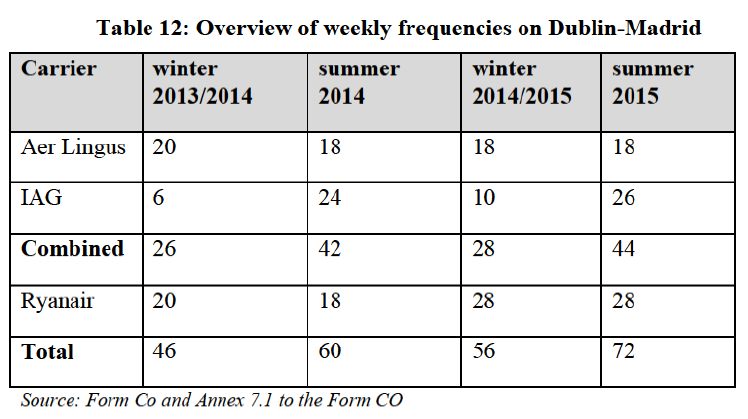
Market shares — capacity
(319) Table 13 below illustrates the market shares based in seat capacity of the Parties and the other carriers operating on this route in the winter 2013/2014, summer 2014, winter 2014/2015 and summer 2015 IATA seasons:
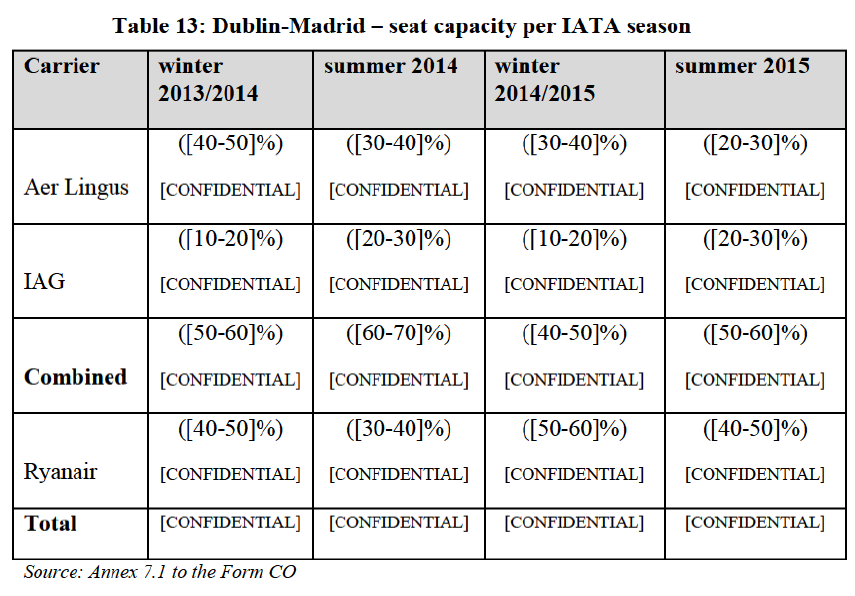
(320) Iberia operates significantly more capacity in the summer months whereas Aer Lingus and Ryanair have a more year-round proposition. The Parties argue that Iberia's business model is more of a traditional network model and, in contrast to the models of Ryanair and Aer Lingus, point-to-point passengers on this route are not IAG's only focus. With the introduction of Iberia Express onto the routes it also attracts O&D traffic, in particular in the peak summer months.267
Market shares — passengers
(321) Table 14 displays the market shares of the Parties and their competitors for all-passengers on the Dublin-Madrid route:
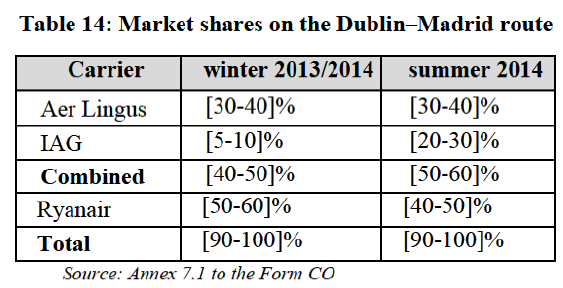
(iii) Constraint exercised by competitors
Parties' views
(322) The Parties claim that IAG is not Aer Lingus' closest competitor on the Dublin-Madrid route. In case M 6663 — Ryanair/Aer Lingus III, the Commission had considered that "Ryanair and Aer Lingus are each other's closest competitor on the Dublin-Madrid route. "268
(323) In addition, the Parties claim that the merged entity would face strong competition from Ryanair.269 They state that that Ryanair is Iberia's principal competitor on short-haul international flying in Madrid. In 2014, Ryanair carried 4 million passengers from Madrid, and introduced nine new routes and increased frequency on 13 existing routes to/from Madrid in IATA season summer 2015.
(324) The Parties also highlight that Ryanair has significantly increased its frequency on Dublin-Madrid in summer 2015 IATA season compared with summer 2014, with 10 extra flights (5 extra return flights) per week. According to the Parties, in the winter 2014/2015 IATA season, Ryanair's frequencies were convenient and represented a credible alternative to the Parties' flight times. The same applies for their frequencies in the current summer 2015 IATA season.
Commission's assessment
(325) ,[IAG inventory strategy and monitoring activities] [270].[271]
(326) [IAG business strategy and marketing information] [272]
(327) The results of the market investigation are mixed as regards closeness of competition on the route. While a majority of respondents indicated that Aer Lingus can be considered as IAG's closest competitor, notably due to the similarity of their business models and availability of interlining possibilities, a majority of respondents considered Ryanair as the closest competitor of Aer Lingus on this route, largely due to volume of frequencies and price considerations.273
(328) Finally, a majority of respondents to the market investigation that expressed a view on the degree of competition that would remain on this route post-Transaction considered that there will be sufficient competition to prevent the merged entity from raising prices.274
(329) On balance, considering the frequencies and the market shares in terms of capacities and passengers of the Parties and their competitor, as well as their competitive relationships, the Commission concludes that the merged entity would face a significant competitive constraint from Ryanair on the Dublin-Madrid airport pair.
(iv) Congestion at Madrid airport – Entry/expansion
(330) Madrid is designated as a fully coordinated airport under the EU Slot Regulation (Level 3). The airport currently has four terminals (T1, T2, T3 and T4) which together provide capacity for 70 million passengers a year. In 2014, Madrid accommodated around 42 million passengers. Regarding allocated slots at Madrid, IAG currently has the largest slot portfolio at the airport: in summer 2014 it held 132 slot pairs per day (23.2% of all available slots); Air Europa had the second largest portfolio with 42 slot pairs per day (7.4%); Ryanair had 20 daily slot pairs per day (3.6%); and Aer Lingus had 1.3 slot pairs per day (0.2%).275
(331) The Parties note that while the airport is slot constrained for arrivals between 08:0009:00, capacity exceeds utilisation at all other times of the day for arrivals and departures. 276
(332) AECFA, the slot coordinator at this airport, confirmed during the market investigation that Madrid airport is not slot constrained as such, except during particular peak times. The Commission came to the same finding in case M. 6663 – Ryanair/Aer Lingus III. 277 On average, AECFA indicated that three-five hours daily can be referred to as having severe levels of congestion, with less than 20% slot availability especially for morning and midday movements. While the growth of demand foreseen in the short-medium term (3-5 years) may strengthen some of the difficulties that airlines currently face to access airport capacity on the peak days and at the peak times, and the capacity is not expected to change during this period, Aena S.A, the airport manager, estimated that the airports it manages currently have enough capacity.278
(333) While no likely, timely and sufficient entry leading to significant additional competitive pressure on the Parties post-Transaction has been identified during the market investigation, the merged entity would still face a significant competitive constraint from Ryanair on the Dublin-Madrid airport pair.
(v) Conclusion on the Dublin-Madrid route
(334) In light of the above and of the other available evidence, the Transaction does not raise serious doubts as to its compatibility with the internal market with respect to the Dublin–Madrid route.
(d) Dublin–Barcelona
(i) Route characteristics
(335) In the winter 2013/2014 and summer 2014 IATA seasons, a total of [400 000– 500 000] passengers travelled between Dublin and Barcelona, of which [90-100]% travelled in the O&D route.279 The remainder are passengers connecting to/from behind/beyond routes (at either Dublin and/or Barcelona). In the winter 2013/2014 IATA season, [80 000–90 000] passengers travelled on the O&D route. In the summer 2014 IATA season, a total of [300 000–400 000] passengers travelled on the O&D route.280 These figures include Ryanair passengers from Girona-Costa Brava and Reus, as Ryanair not only operates to Barcelona El Prat airport, but also these latter airports
(336) According to the Parties, the route is a leisure route characterised by seasonal variations in capacity and frequent services by charter carriers 281
(337) Based on an analysis of point of sale, a majority of Aer Lingus' passengers on this route originate at the Irish end of the route, namely in Dublin. [50-60%] of Aer Lingus' passengers originate from Ireland. 282
(ii) Parties' and competitors' operations
(338) In summer 2015 IATA season, Vueling will enter the Dublin-Barcelona route, with a seasonal service of 4-6 return flights per week between Dublin and El Prat. Dublin-Barcelona is currently operated by Aer Lingus (as well as by Ryanair). Vueling and Aer Lingus therefore overlap on an airport-to-airport basis, namely Dublin—Barcelona El Prat.
(339) The Parties' only competitor on the route is Ryanair, which also operates on the same airport-pair, and at Girona-Costa Brava and Reus.
Frequencies
(340) Table 15 below illustrates the weekly flights operated by the Parties and the other carriers on the routes to Barcelona, Girona-Costa Brava and Reus in the winter 2013/2014, summer 2014, winter 2014/2015 and summer 2015 IATA seasons:
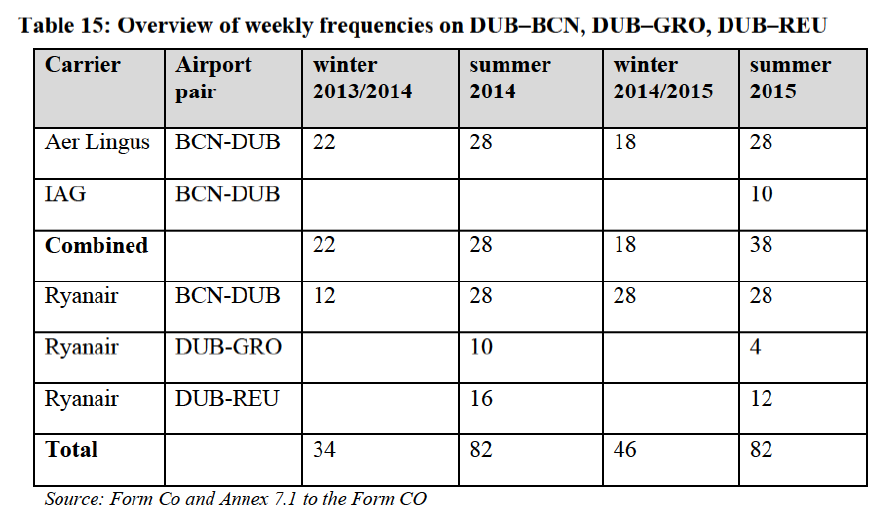
Market shares — capacity
(341) Table 16 below illustrates the market shares based in seat capacity of the Parties and the other carriers operating on the routes to Barcelona, Girona-Costa Brava and Reus in the winter 2013/2014, summer 2014, winter 2014/2015 and summer 2015 IATA seasons:
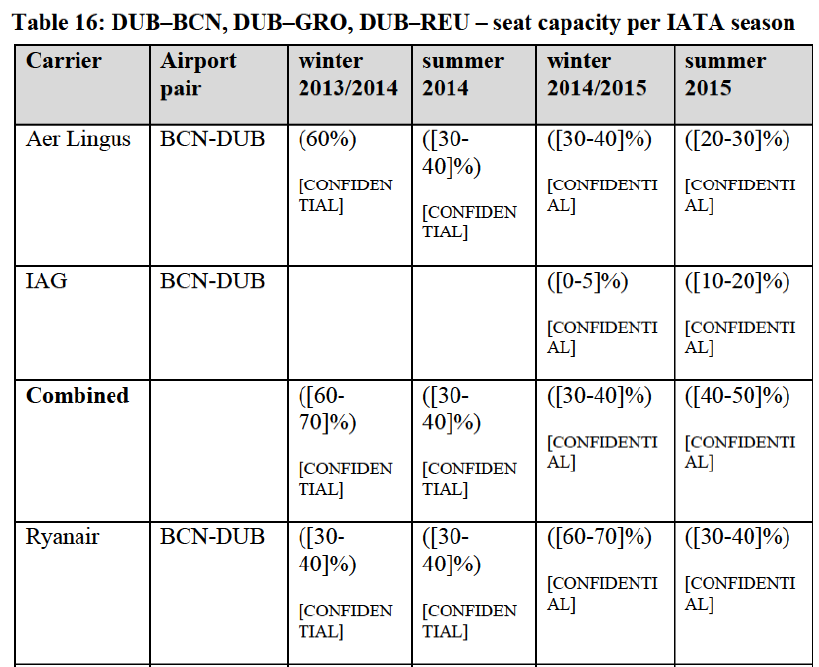
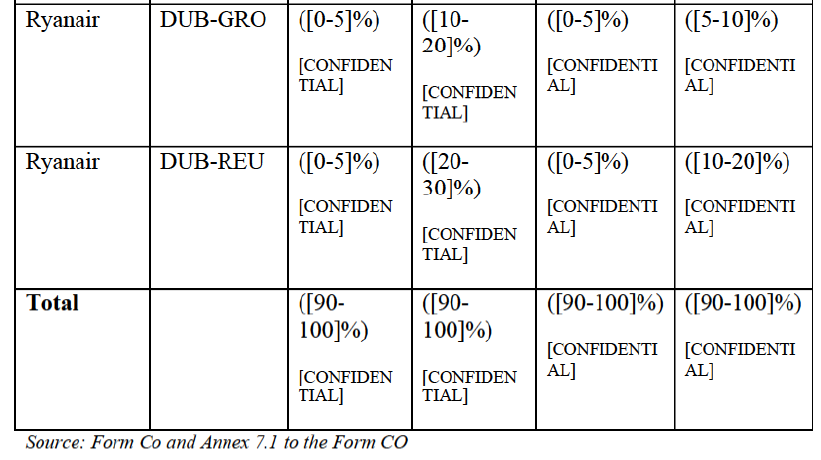
Market shares — passengers
(342) Table 17 displays the market shares of the Parties and their competitors for all passengers on the routes Dublin to Barcelona, Girona-Costa Brava and Reus:
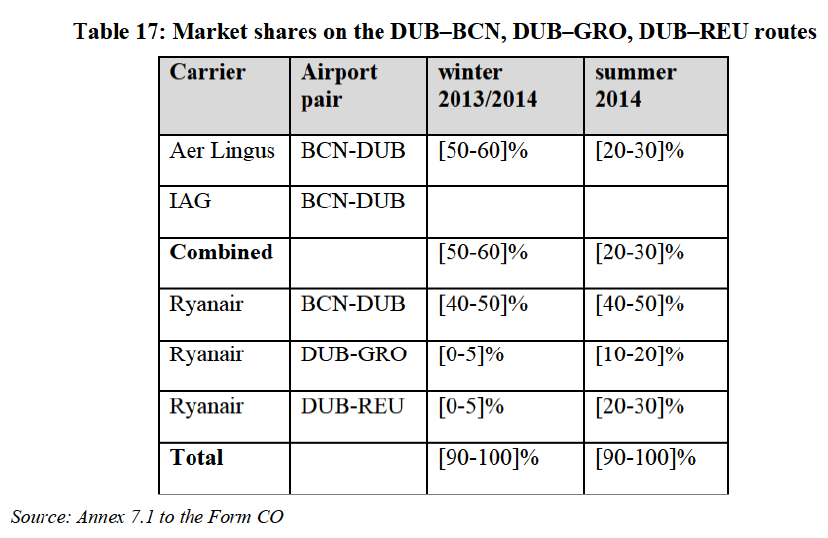
(iii) Constraint exercised by competitors
Parties' views
(343) The Parties claim that the merged entity would face strong competition from Ryanair, which they view as by far the strongest player on the route, operating out of all three Barcelona airports 283 Based on their experience with the launch of Vueling services to/from Brussels, following which Ryanair entered the same routes as Vueling with very low fares in the summer 2014 IATA season. the Parties argue that Vueling's entry is also likely to stimulate an aggressive pricing response from Ryanair.
(344) In case M. 6663 — Ryanair/Aer Lingus III, the Commission had pointed out the "very close competitive relationship between Ryanair and Aer Lingus and [...] the important competitive constraint that both carriers exert upon each other "284 on the Dublin-Barcelona route.
(345) According to the Parties, in the winter 2014/2015 IATA season, Ryanair's frequencies were convenient and represented a credible alternative to the Parties' flight times. The same applies for their frequencies in the current summer 2015 IATA season.
Commission's assessment
(346) [Parties' business strategy and monitoring activities] [285]
(347) [IAG business strategy and marketing information]. [286]
(348) The results of the market investigation are mixed as regards closeness of competition on the route. While a majority of respondents indicated that Aer Lingus can be considered as IAG's closest competitor upon Vueling's entry on the route, a majority of respondents considered Ryanair as the closest competitor of Aer Lingus on this route notably due to high frequencies of flights and comparable costs.287
(349) Finally, a majority of respondents to the market investigation that expressed a view on the degree of competition that would remain on this route post-Transaction considered that there will be sufficient competition to prevent the merged entity from raising prices.288
(350) On balance, considering the frequencies and the market shares in terms of capacities and passengers of the Parties and their competitor, as well as their competitive relationships, the Commission concludes that the merged entity would face a significant competitive constraint from Ryanair on the Dublin-Barcelona El Prat airport pair.
(iv) Congestion at airports in Barcelona – Entry/expansion
(351) Barcelona El Prat is a level 3 coordinated airport with some constraints at peak times. The airport currently has two terminals which together provide the airport with capacity for 55 million passengers a year. In 2014, Barcelona El Prat accommodated around 37.5 million passengers. The airport has three runways and is able to handle 72 movements per hour. The Parties note that while the airport is partly slot constrained between 08:00-11:00 and between 12:00-14:00, there is good slot availability outside these hours.289
(352) Regarding allocated slots, IAG currently has the largest slot portfolio at Barcelona El Prat; in summer 2014 it held 106 slot pairs per day (25.9% of all available slots); Ryanair had the second largest portfolio with 27 slot pairs per day (6.5%); easyJet had 17 slot pairs per day (4.1%); and Aer Lingus has 2 slot pairs per day (0.5%).290
(353) AECFA, the slot coordinator at this airport, confirmed during the market investigation that Barcelona El Prat is only slot constrained during particular peak times. The growth of demand foreseen in the short-medium term (3-5 years) may strengthen some of the difficulties that airlines currently face to access airport capacity on the peak days and at the peak times in this airport, but AECFA indicated that as from the seasons starting in 2015 (S15/W15 seasons), the airport manager, Aena S.A. is already providing increased capacity (airport capacity parameters) at Barcelona-El Prat which will alleviate the current limitations, at least partially. Aena S.A. estimated that the airports it manages currently have enough capacity.291
(354) Besides, neither Girona-Costa Brava nor Reus is coordinated and each has good availability throughout the day. Both airports are designated as scheduled facilitated (Level 2) airports under the EU Slot Regulation, meaning that although there is potential for congestion at some periods of the day, at present, the airports are not slot restricted or congested.
(355) Assessing the evidence collected in the market investigation, the Commission is of the view that no likely, timely and sufficient entry/expansion plans would lead to additional competitive pressure on the merged entity post-Transaction, besides the one already existing from its current competitors. However, as mentioned previously, the merged entity would still face a significant competitive constraint from Ryanair on the Dublin-Barcelona El Prat airport pair.
(v) Conclusion on the Dublin-Barcelona route
(356) In light of the above and of the other available evidence, even if the narrowest hypothetical geographic market definition is considered (i.e. only the Dublin-Barcelona El Prat airport pair), the Transaction does not raise serious doubts as to its compatibility with the internal market with respect to the Dublin–Barcelona route.
(e) Dublin–New York
(i) Route characteristics
(357) As discussed in Section IV.2.4.6, the Commission considers that the two relevant airports serving New York (JFK and Newark) belong to the same market.
(358) Approximately [500 000–1 000 000] passengers travelled between Dublin and New York in the winter 2013/2014 and summer 2014 IATA seasons, of which [60-70%] travelled on the O&D route.292 Over the same period, passengers travelling on indirect flights represented [5-10%] of the total passengers travelling on the O&D route.293 In the winter 2013/14 IATA season, [100 000–200 000] passengers, including [30 000 – 40 000] TS passengers, travelled on the O&D route.294 In the summer 2014 IATA season, a total of [200 000–300 000] passengers, including [70 000–80 000] TS passengers, travelled on the O&D route.295
(359) Approximately [500 000–1 000 000] passengers travelled between Dublin and New York in the winter 2013/2014 and summer 2014 IATA seasons, of which [60-70%] travelled on the O&D route.296 Over the same period, passengers travelling on indirect flights represented [5-10%] of the total passengers travelling on the O&D route.297 In the winter 2013/14 IATA season, [100 000-200 000] passengers, including [30 00040 000] TS passengers, travelled on the O&D route 298 In the summer 2014 IATA season, a total of [100 000-200 000] passengers, including [70 000-80 000] TS passengers, travelled on the O&D route 299
(360) The Parties consider that the travel between Dublin and New York is predominantly leisure travel.300
(ii) Parties' and competitors' operations
(361) Aer Lingus serves the route with its own aircraft and operates flights from Dublin to JFK. IAG serves the route through the JBA on flights operated by American Airlines to JFK. The Sky Team JV flies from Dublin to JFK. The Star Alliance JV operates flights to EWR. Pursuant to a codeshare agreement, the Star Alliance JV also sells tickets for flights operated by Aer Lingus to JFK.
(362) The JBA operated on the Dublin New York route during the winter 2013/2014 IATA season. However, the JBA's winter service was not resumed in the following winter IATA season [BUSINESS SECRETS]. Therefore, the JBA only operates on the route in the summer. Aer Lingus, the Sky Team JV, and the Star JV offer instead year round services.
Frequencies
(363) Table 18 below provides the number of weekly direct flights operated by the Parties and their competitors on the Dublin New York route.
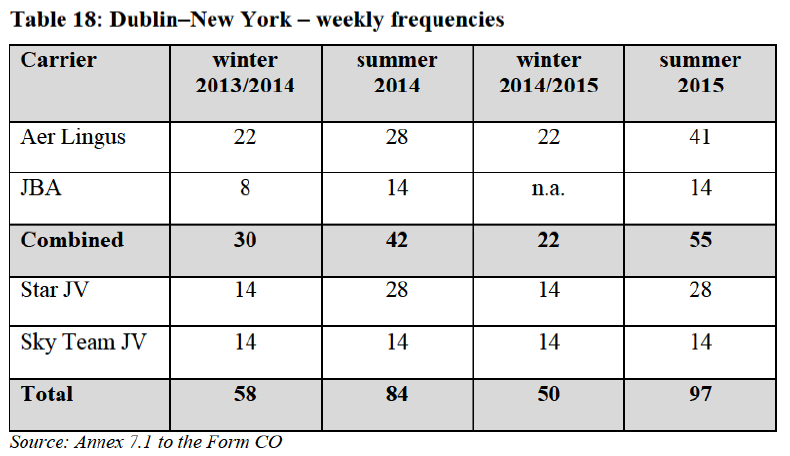
(364) Table 19 below provides the Parties' and their competitors' total capacity for direct flights on the Dublin New York route.
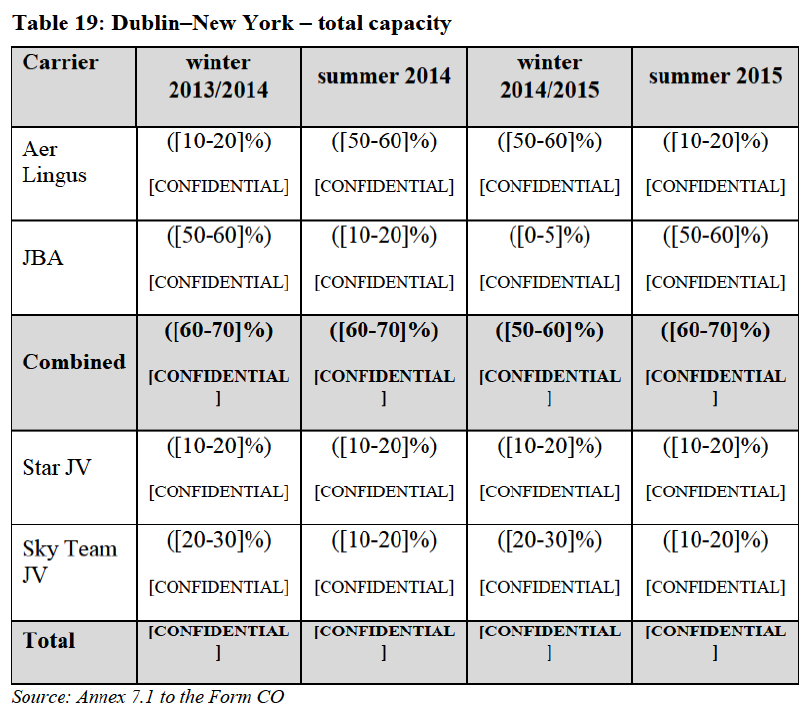
Market shares — passengers
(365) Table 20 and Table 21 below provide the market shares of the Parties and their competitors on the Dublin New York route for the two most recent 2014 IATA seasons for which data is available.301

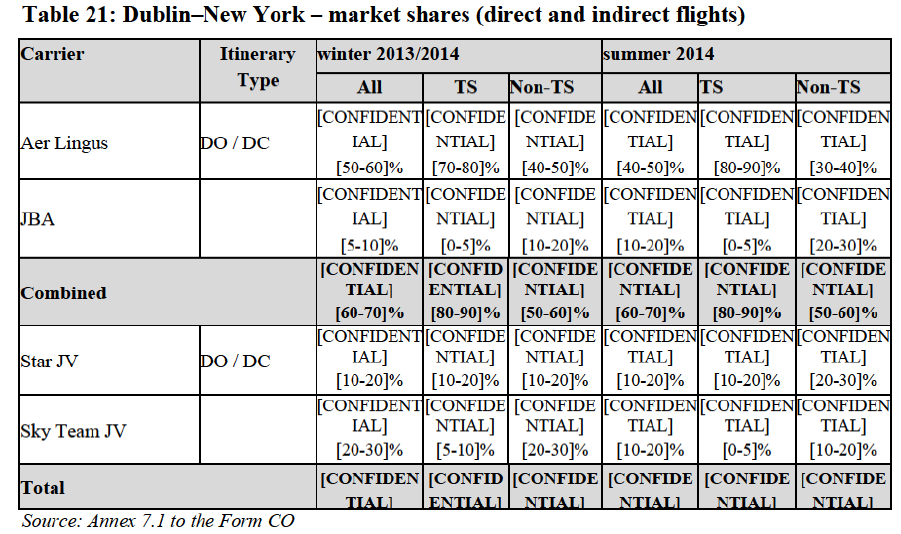
(366) As discussed above, the JBA only operates on the Dublin New York route in the summer IATA seasons [BUSINESS SECRETS] . Therefore, the Transaction does not give rise to a horizontal overlap on the Dublin–New York route in the winter IATA seasons.
(367) As it can be seen in Table 20 and Table 21 above, the Parties' and their competitors' market shares do not change materially irrespective of whether only direct flights or both direct and indirect flights are taken into account. Therefore, the assessment of the effects of the Transaction on the Dublin–New York route can be conducted only taking into account the Parties' and their competitors' direct operations.
(368) The Parties operated 42 weekly frequencies out of 82 and offered [60-70%] of the total capacity on the route.303 In the summer 2015 IATA season the Parties operate 55 weekly frequencies out of 97 and offer [60-70%] of the total capacity on the route.304
(369) In the summer 2014 IATA season, the Parties held a combined share of [60-70%] for all passengers, [80-90%] for TS, and [60-70%] for NTS.305 The increment to Aer Lingus' share brought about by the transaction would be of [10-20%] for all passengers and [10-20%] for NTS.306 As far as TS passengers are concerned, the increment would be modest and limited to only approximately [0-5%].
(iii) Constraint exercised by competitors
Parties' views
(370) The Parties submit that post-Transaction they will face strong competition from the Star JV and the Sky Team JV which offer non-stop services between Dublin and EWR and JFK respectively.
Commission's assessment
(371) [Parties' fare policy and monitoring activities] [307] [308][309][310]
(372) Based on data for the summer 2104 IATA season, the Parties' and their competitors' have similar departure and arrival times at both ends of the Dublin–New York route although Aer Lingus is the only carrier offering afternoon departures from Dublin (at 16:00 local time) and New York (at 17:30 local time).
(373) A majority of respondents to the market investigation have indicated that Aer Lingus holds the strongest brand among the carriers active on the Dublin–New York route.311
Furthermore, they consider that Aer Lingus and the JBA are close competitors and, in particular, that Aer Lingus is the JBA's strongest competitor.312 However, the Star JV and the Sky Team JV are also viewed as close competitors to both Aer Lingus and the JBA.313
(374) Furthermore, most of the customers that responded to the market investigation have indicated that before purchasing tickets for the Dublin–New York route they compare the offers made by Aer Lingus and the JBA,314 and most of them also look at offers made by other carriers.315
(375) Besides, the Star JV and the Sky Team JV have hubs in New York that would facilitate the reallocation of capacity and the up-gauging of aircraft on the Dublin– New York should the Parties increase prices and/or reduce capacity.
(376) Finally, a majority of respondents to the market investigation that expressed a view on the degree of competition that would remain on this route post-Transaction considered that there will be sufficient competition to prevent the merged entity from raising prices.316
(iv) Congestion at New York airports – Entry/expansion
(377) Dublin Airport is only subject to the generally low barriers to entry described in Section V.5.7 above for such types of routes. Both EWR and JFK are designated as fully coordinated (Level 3) airports under the IATA Worldwide Slot Guidelines. Therefore, new entrants on the Dublin–New York route, or carriers already active on the route which wish to increase the frequency of their flights, will have to obtain slots from the Federal Aviation Administration which is responsible for the allocation of slots at EWR and JFK. EWR is congested during peak hours, between 07:00–09:00 and between 12:30–21:30.317 JFK is also congested during peak hours, between 07:00–09:00 and between 14:00–22:00.318
(378) Certain of the Parties' competitors have indicated in the market investigation the unavailability of peak-time slots at Dublin, EWR, and JFK represents a material barrier to entry.319
(379) Assessing the evidence collected in the market investigation, the Commission is of the view that no likely, timely and sufficient entry/expansion plans would lead to additional competitive pressure on the merged entity post-Transaction, besides the one already existing from its current competitors. However, as mentioned previously, the merged entity would still face significant competitive constraints from the Star JV and the Sky Team JV on the route.
(v) Conclusion on the Dublin–New York route
(380) In light of the above and of the other available evidence, considering in particular that the Parties are faced with significant competition from competing alliances, the Commission concludes that the Transaction does not raise serious doubts as to its compatibility with the internal market under any possible market definition with respect to the Dublin–New York route.
(f) Dublin–Chicago
(i) Route characteristics
(381) Chicago is served by two airports – Chicago O'Hare International Airport (ORD) and Chicago Midway (MDW). As explained in Section IV.2.4.5, the Commission considers that it is not necessary to come to a conclusion as to the substitutability of these airports because there are no direct flights to MDW from Dublin.320 Therefore only flights from Dublin to ORD will be assessed in this Section.
(382) Approximately [300 000–400 000] passengers travelled between Dublin and Chicago in the winter 2013/2014 and summer 2014 IATA seasons of which [40-50%] travelled on the O&D route.321 The remainder are passengers connecting to/from behind/beyond routes (at either Dublin and/or Chicago). Over the same period, passengers travelling on indirect flights represented [5-10%] of the total passengers travelling on the O&D route.322 In the winter 2013/14 IATA season [30 000–40 000] passengers including [5 000–10 000] TS passengers travelled on the O&D route.323 In the summer 2014 IATA season a total of [100 000–200 000] passengers including [30 000–40 000] TS passengers travelled on the O&D route.324
(383) The Parties consider that the travel between Dublin and Chicago is predominantly leisure-oriented.325
(ii) Parties' and competitors' operations
(384) Aer Lingus serves the route with its own aircraft and is the only carrier to operate an all year direct service flights from Dublin to ORD. IAG serves the route through the JBA through a seasonal (summer) direct service operated by American Airlines to ORD. Therefore the Parties are the only operators currently operating non-stop services from Dublin to Chicago.
(385) However, the Star JV (United) which used to place the United code on the Aer Lingus service has launched its own direct (shorter than) seasonal service in summer 2015. This service will not be provided during the whole summer season but only from 4 June to 17 August 2015. United has not announced whether this service will be provided in the future.
(386) [Parties' business strategy].[326]
Frequencies
(387) Table 22 below illustrates the weekly direct flights operated by the Parties and the other carriers operating on this route in the winter 2013/2014, summer 2014, winter 2014/2015 and summer 2015 IATA seasons.
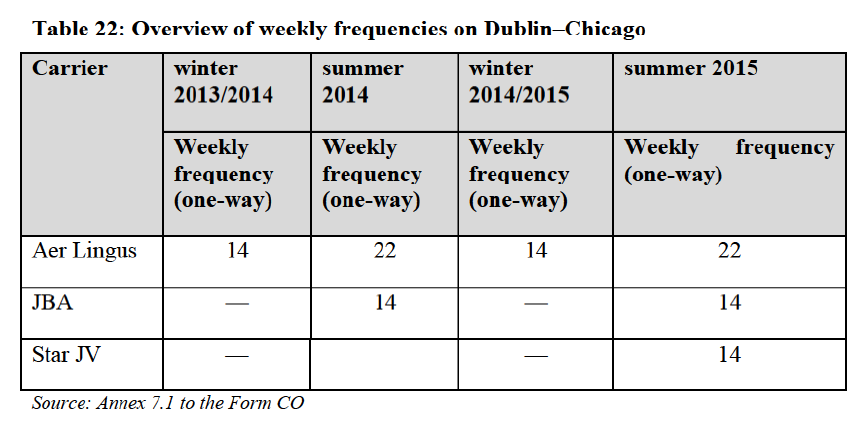
Market shares — Capacity
(388) Table 23 below illustrates the total seat capacity of the Parties and the other carriers operating for direct flights on this route in the winter 2013/2014, summer 2014, winter 2014/2015 and summer 2015 IATA seasons.
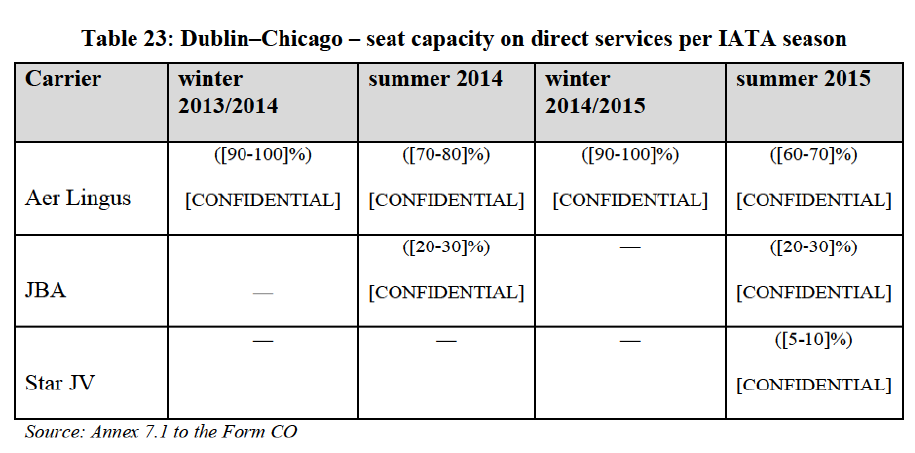
Market shares — passengers
(389) Table 24 and Table 25 below illustrate the market position of the Parties in the winter 2013/2014 and summer 2014 IATA seasons.
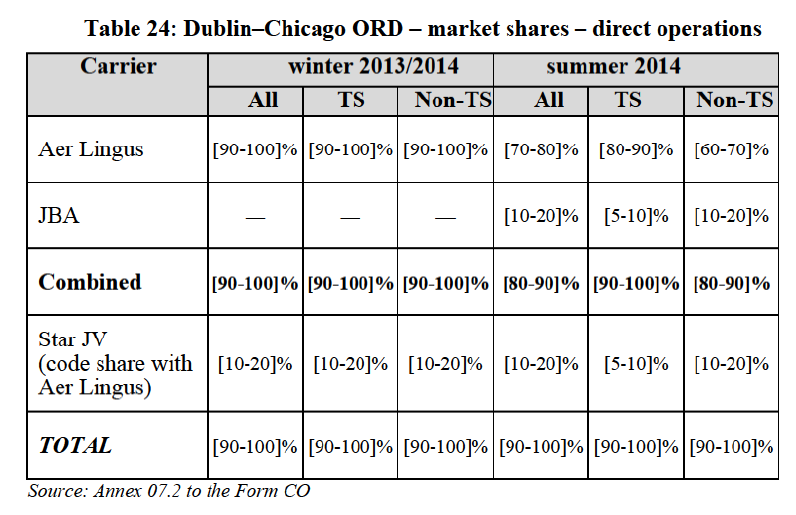
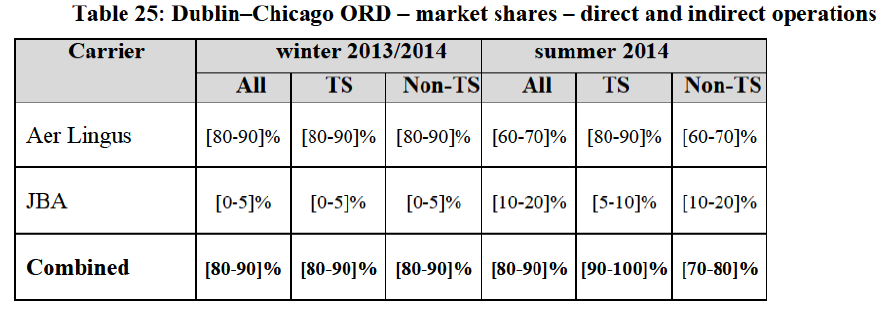
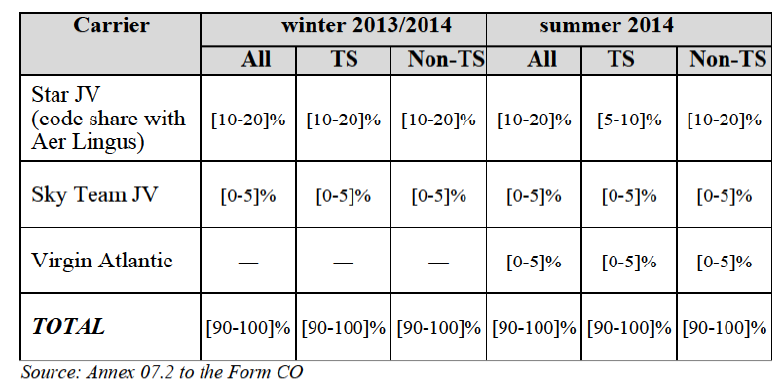
(390) On direct services only, during the winter 2013/2014 and summer 2014 IATA seasons, the Star JV was active on the route through a codeshare with Aer Lingus and achieved a market share of approximately [10-20%] and [10-20%] respectively in the all passengers segment. In the same period Aer Lingus held a share of [90-100%] and [70-80%] respectively.327 The JBA achieved [10-20%] in the summer 2014 IATA season and was not active in the winter 2013/2014 season.
(391) When looking at TS passengers the Parties held a combined share of approximately [90-100%] in the winter 2013/2014 IATA season and [80-90%] in the summer 2014 IATA season.
(392) The Parties' market shares in a market comprising direct and indirect services were high with [80-90%] and [80-90%] in the all passengers segment in the winter 2013/2014 and summer 2014 IATA seasons. Moreover, passengers transported on indirect services represented less than [ 10-20%] of the overall passenger numbers on the route. Therefore, the assessment of the likely effects of the Transaction on the Dublin—Chicago route can be conducted taking into account the Parties' and their competitors' direct operations only.
(393) The increments brought about by the Transaction remains small as far as TS passengers are concerned.
(394) The Parties operate 36 weekly frequencies out of 50 and offer [90-100%] of the total capacity on the route in the summer 2015 IATA season.328
(iii) Constraint exercised by competitors
Parties' views
(395) The Parties submit that post-Transaction they will face strong competition from the Star JV and potentially the Sky Team JV. Chicago O'Hare, which is the fifth busiest airport in the world, is a hub airport of United.329 As United (Star) is operating with this hub at one end of the route, it would according to the Parties be able to quickly and easily increase capacity on the route in the event it becomes commercially attractive to do so. The Sky Team JV is according to the Parties also well placed to enter the route either direct with services to ORD (where Delta has operations) or by increasing indirect services via JFK.
Commission's assessment
(396) Based on data for the summer 2014 IATA season, United (Star) and the Parties have similar departure and arrival times at both ends of the Dublin–Chicago route in the short period from 4 June to 17 August during which United (Star) offers its direct service.
(397) A majority of respondents to the market investigation indicate that Aer Lingus holds the strongest brand among the carriers active on the Dublin–Chicago route.330 Furthermore, they consider that Aer Lingus and the JBA are close competitors and, in particular, that Aer Lingus is the JBA's strongest competitor.331
(398) The Commission considers that the overlap between the Parties is seasonal only and does not cover the full summer season as the JBA is not operating for the full summer season (i.e. it operates only from 4 May until 19 October 2015). The competitive impact of the merger on competition on the route is therefore limited to part of the summer season only.
(399) United's own service is currently somewhat limited in scale. Nonetheless, United's entry shows that barriers to entry are not prohibitively high on the Dublin–Chicago route. Moreover, United's service during the summer season will exert some competitive constraint on the Parties. It shows that there is some degree of competition on the route despite Aer Lingus' strong position. Given the fact that United has a hub in Chicago it is well-placed to expand its operations. Under the right circumstances, United's service may develop into a significant competitive constraint on the Parties on this route.
(400) However, post-Transaction the Parties would indeed for the time being hold high market shares on the routes, both in terms of passenger numbers and capacity. The JBA would also still be a competitive constraint, even if limited, on Aer Lingus which would be removed through the Transaction. In addition, the Parties together would be in a position to offer a higher number of frequencies than their immediate competitor (United) could offer in the short term. Nevertheless, it is also noted that the JBA and United would operate similar weekly frequencies (see Table 22) when they are both active on the route.
(401) Finally, a majority of respondents to the market investigation that expressed a view on the degree of competition that would remain on this route post-Transaction considered that there will be sufficient competition to prevent the merged entity from raising prices.332
(iv) Congestion at Chicago airports – Entry/expansion
(402) Dublin Airport is subject to the generally low barriers to entry described in Section V.5.7 above for such types of routes. ORD is designated as a schedules facilitated (Level 2) airport under the IATA Worldwide Slot Guidelines. Therefore new entrants would not face significant slot constraints should they wish to expand their services between Dublin and Chicago.
(403) Beyond United's operations described above, no timely, likely and sufficient entry/expansion plans have been identified on the route during the market investigation.
(v) Conclusion on the Dublin–Chicago route
(404) In light of the above and of the other available evidence, the Commission considers that the Transaction raises serious doubts as to its compatibility with the internal market with respect to the NTS segment and the all passengers segment for the Dublin–Chicago route.
5.7. Direct/indirect overlap routes
(405) On the basis of the last four IATA seasons the Transaction gives rise to 36 direct/indirect overlaps on a city-pair level333 and to 8 direct/indirect overlaps on an airport-pair level.334
(406) On these 44 routes, serious doubts as to the compatibility of the Transaction with the internal markets can be excluded essentially either because of low combined market shares of the Parties (SectionV.7.1.1), the low market share increment brought about by the Transaction (Section V.7.1.2), and/or due to significant competitors active on the route (Section V.7.1.3).
(i) Low combined market shares
(407) Out of the 44 direct/indirect overlap routes, the following 4 city pairs set out in Table 26 do not give rise to serious doubts as to the compatibility of the Transaction with the internal market in view of the low combined market shares held by IAG and Aer Lingus.
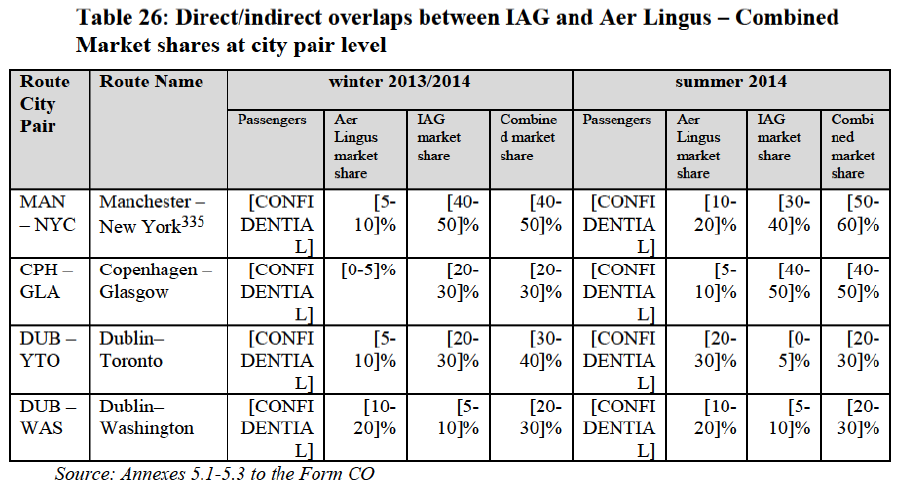
(408) The competitive assessment for the above mentioned routes would not change when looking at the narrowest possible market segmentation on the basis of airport pairs with combined market shares not being above [60-70%] in any given season and, for long-haul routes, if NTS and TS passengers are looked at separately.
(409) In particular, on Manchester—New York, where the overall market share in the winter 2013/2014 IATA season and in the summer 2014 IATA season amounted to [40-50%] and [50-60%] respectively, Star JV is a strong competitor operating direct services on the city pair, with a market share higher than the increment bought about by the Transaction, and at least one other competitor is offering in each season a direct service on the same airport pair O&D route as the Parties (three such competitors, also including Sky Team JV, offer such direct services during summer seasons).
(410) A majority of respondents to the market investigation indicated that there will be sufficient competition on the above mentioned direct/indirect routes to prevent the merged entity from raising prices post transaction, and that the Transaction would have no effect on the competitive situation on these routes (in terms of prices, level of service, etc.).336
(411) In light of all the above and the other available evidence, the Commission considers that the Transaction does not raise serious doubts as to its compatibility with the internal market on the direct/indirect Manchester–New York, Copenhagen–Glasgow, Dublin–Toronto, and Dublin–Washington routes under any possible market definition.
(ii) Low increment brought about by the Transaction
(412) Of the remaining 40 direct/indirect overlap routes, the 29 city pairs and 4 airport pairs assessed in this section generally do not give rise to serious doubts as to the compatibility of the Transaction with the internal market in view of the low increment in market share brought about by the Transaction.
(413) The sole exceptions are the Barcelona – Cork, Bilbao – Dublin, Boston – Madrid, Cork – Geneva, Dublin–Dubrovnik, and Malaga – Belfast routes in the winter 2013/2014 IATA season which are discussed separately below.
- On the Barcelona–Cork route, only [<1000] passengers travelled in the winter 2013/2014 IATA season, making it a highly seasonal route.337 Therefore in the winter IATA season that route does not constitute a substantial part of the internal market.
- On the Bilbao–Dublin route the increment would amount to [10-20%] in the winter 2013/2014 IATA season. However, the Parties' combined share would be [30-40%] only, and the route presents two competitors operating indirect services, one of which holds a share larger than the combined share held by the Parties.338
- On the Boston–Madrid route the increment in the all passengers segment would amount to [10-20%] in the winter 2013/2014 IATA season. However, the route presents three significant competitors operating indirect services which have significant operations in the US. Furthermore, two of the Parties' competitors on the route hold shares larger than the increment brought about by the Transaction.339
- On the Cork–Geneva route the increment would amount to [10-20%] in the winter 2013/2014 IATA season. However, the route presents one significant competitor operating indirect services and which holds a share larger than the increment brought about by the Transaction.340
- On the Dublin–Dubrovnik route, [<1000] passengers only travelled in the winter 2013/2014 IATA season, making it a highly seasonal route.341, Therefore in the winter IATA season that route does not constitute a substantial part of the internal market.
- On the Malaga—Belfast route, [<1000] passengers only travelled in the winter 2013/2014 IATA season, making it a highly seasonal route.342, Therefore in the winter TATA season that route does not constitute a substantial part of the internal market.
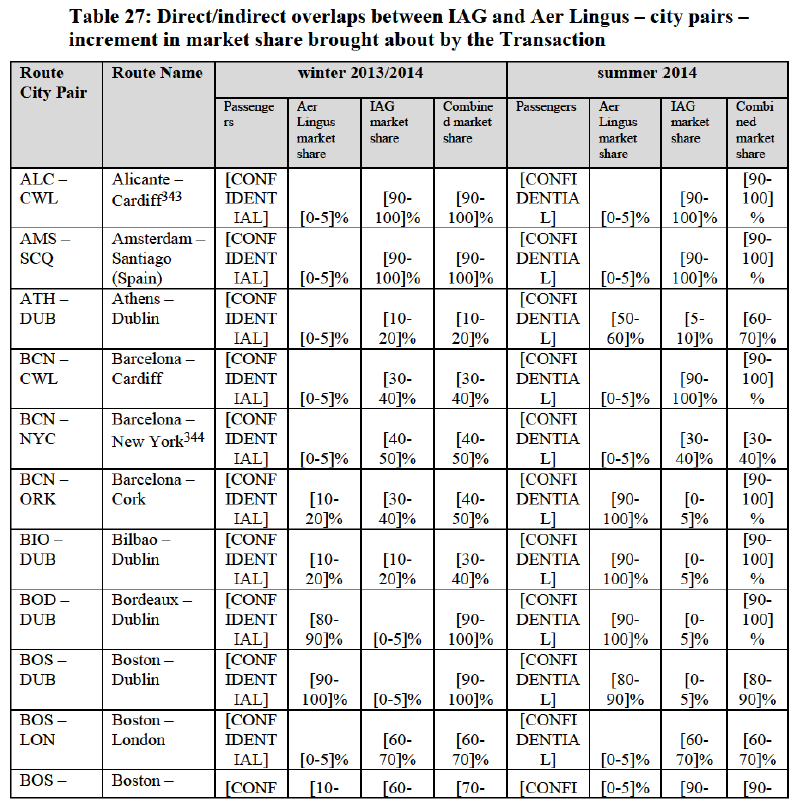
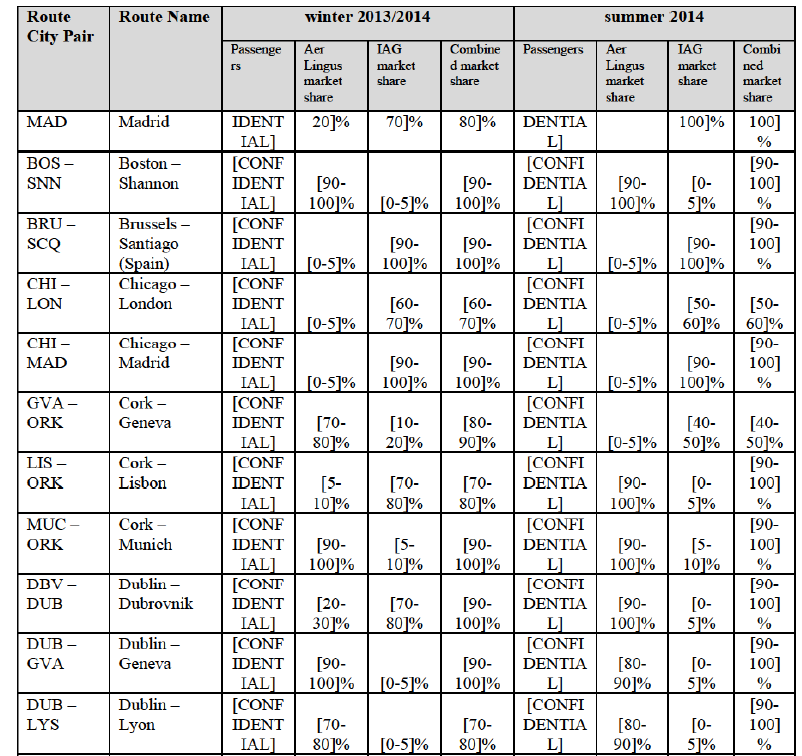
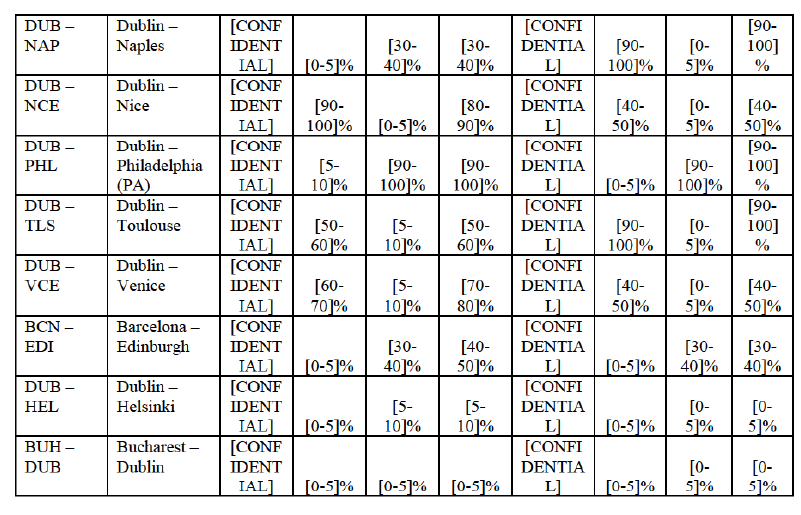
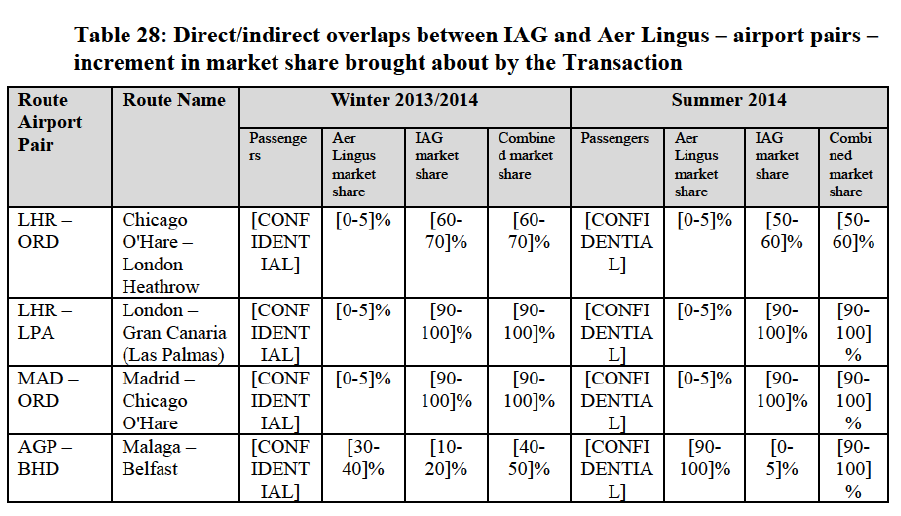
(414) The competitive assessment for the above mentioned routes would not change when looking at the narrowest possible market segmentation on the basis of airport pairs with increments not above 5% in any given season and, for long-haul routes, if NTS and TS passengers are looked at separately.
(415) A majority of respondents to the market investigation indicated that there will be sufficient competition on the above-mentioned direct/indirect routes to prevent the merged entity from raising prices post transaction, and that the Transaction would have no effect on the competitive situation on these routes (in terms of prices, level of service, etc.).345
(416) In light of all the above, the Commission considers that the Transaction does not raise serious doubts as to its compatibility with the internal market on the direct/indirect Alicante—Cardiff, Amsterdam—Santiago (Spain), Athens—Dublin, Barcelona—Cardiff, Barcelona—New York, Barcelona—Cork, Bilbao—Dublin, Bordeaux—Dublin, Boston—Dublin, Boston—London, Boston—Madrid, Boston—Shannon, Brussels—Santiago (Spain), Chicago—London, Chicago—Madrid, Cork—Geneva, Cork—Lisbon, Cork—Munich, Dublin—Dubrovnik, Dublin—Geneva, Dublin—Lyon, Dublin Naples, Dublin—Nice, Dublin—Philadelphia (PA), Dublin—Toulouse, Dublin—Venice, Barcelona—Edinburgh, Dublin—Helsinki, Bucharest—Dublin, Chicago O'Hare—London Heathrow, London—Gran Canaria (Las Palmas), Madrid—Chicago O'Hare, Malaga—Belfast, routes under any possible market definition.
(iii) Significant competitor(s)
(417) Out of the remaining 7 direct/indirect overlap routes, all discussed in this Section, none gives rise to serious doubts as to the compatibility of the Transaction with the internal market in view of the presence of significant competitors having a hub or significant operations at one end of the route.

(418) On the Chicago—Manchester route SAS, the Sky Team JV, and the Star JV offer a year-round indirect service. Furthermore, Virgin Atlantic offers a summer only indirect service on the route. In addition, United Airlines, a member of the Star alliance, has a hub in Chicago.346
(419) On the Dublin—Orlando route the Sky Team W, the Star JV, and Virgin Atlantic offer a year-round indirect service. Furthermore, the Sky Team W and, in particular, the Star W have significant operations in Orlando.351
(420) On the Dublin—San Francisco route the Sky Team W, the Star JV, and Virgin Atlantic offer a year-round indirect service. Furthermore, the Sky Team JV and, in particular, the Star JV have significant operations in San Francisco.351
(421) Furthermore, the Parties' competitors may benefit from Aer Lingus feeder traffic on the Chicago — Manchester, Dublin—Orlando, and Dublin—San Francisco routes post-Transaction pursuant to the SPA Commitments described in Section IX of this decision. Such Aer Lingus feeder traffic may contribute to maintaining effective competition on the Chicago — Manchester, Dublin—Orlando, and Dublin—San Francisco routes.
(422) In addition to the routes listed in Table 29 the Transaction also gives rise to horizontally affected markets on the routes linking London (including London Heathrow, London Gatwick, and London City Airport) to Alicante, Bilbao, Faro, and Malaga, on these routes significant competitors are active. On the London — Alicante, the London — Faro, and the London—Malaga routes, the Parties face competition from two or more competitors offering direct services.347 Furthermore, the share addition brought about by the Transaction is modest and for each of these routes is below 5%. On the London–Bilbao route, the Parties face competition from several significant competitors.348
(423) The competitive assessment for the above mentioned routes would not change when looking at the narrowest possible market segmentation on the basis of airport pairs in any given season and, for long-haul routes, if NTS and TS passengers are looked at separately.
(424) A majority of respondents to the market investigation indicated that there will be sufficient competition on the above mentioned direct/indirect routes to prevent the merged entity from raising prices post transaction, and that the Transaction would have no effect on the competitive situation on these routes (in terms of prices, level of service, etc.).349
(425) In light of all the above, the Commission considers that the Transaction does not raise serious doubts as to its compatibility with the internal market on the direct/indirect Chicago–Manchester, Dublin–Orlando, Dublin–San Francisco, London–Alicante, London–Bilbao, London–Faro, London–Malaga routes under any possible market definition.
5.8. Indirect/indirect overlap routes
(426) The activities of the Parties also overlap on 25 routes on a city-pair level350 and on 5 routes on an airport-pair level351 where both operate indirect flights.
(427) These routes are analysed with respect to combined market shares of the Parties and the market share increment brought about by the Transaction. In addition the presence and position of competitors and the number of passengers on each route are assessed.
(428) Market shares on these routes are in general broadly in the same ranges for TS and NTS passengers.352 Therefore the assessment will not further distinguish between these market segments.
(429) None of these routes gives rise to serious doubts as to the compatibility of the Transaction with the internal market for the following reasons.
(430) Indirect routes are often established in an opportunistic way by carriers and are modified from one IATA season to the next. Furthermore price increases or reductions of capacity could be countered by competitors who could start operating on these routes more easily than on direct/direct routes which require the deployment of aircraft dedicated to the O&D route.
(431) On the majority of these routes no competition concerns arise because either the Parties combined market shares are below 60% or the increment brought about by the Transaction is below 5% (so that no material merger-specific effect would likely exist).353 Given the low competitive constraint between indirect services, market shares below 60% on routes indicate that there is already prima facie sufficient competition from other carriers.
(432) On eight of the city-pair indirect/indirect overlap routes the Parties' combined market shares are higher (above 60% in at least one market segment in any of the past two IATA seasons) and the increment is non-negligible (more than 5%). These are
Boston–Manchester/Leeds/Liverpool, Dubrovnik–Edinburgh, Dublin–Phoenix,
Dublin–Seattle, Dublin–Vancouver, Glasgow–Orlando, Nice–Newcastle, and Newcastle–New York.
(433) These routes with the exception of Glasgow–Orlando are all thin routes (approximately 40 000 passengers per year or less). With the exception of Dublin– Phoenix, all of these routes are also highly seasonal (the summer season showing the higher passenger numbers). However, on all of these routes (including Glasgow– Orlando and Dublin–Phoenix), the Parties' market shares do not exceed 75% (except for Dubrovnik–Edinburgh in the IATA winter season 2013/2014 with overall [?1000] passengers only transported on the route). Furthermore, on all of these routes competitors like the Sky Team JV, the Star JV, Virgin Atlantic, WestJet Airlines or Thomas Cook are active with material market shares.
(434) No respondent in the market investigation raised substantiated concerns as to the existence of any competition problem whatsoever on the indirect-indirect overlap routes at issue.354
(435) In light of the above and of the other available evidence, the Commission considers that the Transaction does not raise any serious doubts as to its compatibility with the internal market under any possible market definition on any of the 30 indirect/indirect overlap routes.
5.9. IAG's position at London Heathrow post Transaction
(436) As mentioned in Section V.5.1, based on the slots allocated for the summer 2015 IATA season, IAG holds 53% of all the slots at Heathrow and is the largest slot holder at this airport355. Pursuant to the Transaction, IAG's slot holding at Heathrow would increase by 3%, accounting for 56-57%356 of all the slots at the airport.
(437) During the investigation, one competitor expressed concerns about the increased concentration of slots at Heathrow in the hands of IAG. In particular, the increased slot holding would enhance IAG's ability to engage in strategic behaviour to deter new entry or expansion, for example by re-timing services or increasing frequencies, and/or to compete with greater flexibility by boosting IAG's "shuffle power" (i.e. the ability to move slots around to optimise the schedule and slots' utilisation). This would lead to a competitor exit or lack of entry and would ultimately harm the consumers by means of a reduced choice and risk of higher fares. In addition, the increasing scale of IAG at Heathrow will also hamper access to airport infrastructure (such as terminals) to competing carriers, undermining their ability to compete effectively. According to another competitor, the transaction would harm their operations by further consolidating the dominant control by IAG of the slots and other critical airport infrastructure at London Heathrow airport. Yet another competitor indicated that this dominance could also extend to all oneworld carriers.357
(438) A majority of competitors responding to the market investigation indicated that the Transaction would have a negative impact on access to airport infrastructure at London-Heathrow airport. These competitors indicated that the Transaction would strengthen the merged entity's position at Heathrow. However, most of these competitors also appear to acknowledge that the impact of the Transaction on access to slots and airport infrastructure at Heathrow would rather be neutral, since pre-Transaction the airport is already heavily congested and the Transaction would not change fundamentally the situation.358
(439) Heathrow airport is managed by HAL, which runs the airport activities in compliance with strict regulations set by the UK Department for Transport. The prices charged to airlines are set by the Civil Aviation Authority. During the market investigation, HAL mentioned that "the Transaction will have a neutral impact on slot access and it may have a positive impact on airport infrastructure services where airline choose to consolidate support services such as ground handling and aircraft maintenance". In addition, HAL acknowledged that "the Transaction has the potential to improve
airport utilization if aircraft and passenger support services are consolidated".359
(440) The Commission considers that the relatively limited incremental share of slots brought about by the Transaction is unlikely to have any material impact on the market power of IAG at Heathrow.360 In particular, it seems that the Transaction would not significantly strengthen IAG's presence at Heathrow, nor would it significantly impair other carriers from growing their overall operations at this airport. Such a small increment would also marginally affect IAG's ability to "shuffle" slots across its portfolio.361
(441) To conclude, the strengthening of IAG's presence at Heathrow brought about by the Transaction, in particular through the additional slots acquired by IAG, does not give rise to serious doubts as to the compatibility of the Transaction with the internal market.
5.10. Feed traffic issues
(a) Introduction
(442) As explained in Section IV.2.5, in the air transport sector, there are a variety of agreements whereby tickets may be sold for indirect journeys including two legs operated respectively by each party to the agreement and for the purposes of the present analysis, the assessment is the same no matter whether the two carriers are engaged in a vertical relationship or are active in closely related markets. For the sake of simplification, the terminology of the input foreclosure theory will be used to conduct this assessment.
(443) The theory of harm examined in relation to feed traffic relates to a risk of foreclosure whereby IAG would deny or hamper access to its short-haul flights – or raise the price charged for such access – on routes currently operated by Aer Lingus for passengers connecting at a hub airport onto flights operated by another carrier to a destination to which IAG also offers services from the same hub airport, or from its own hub airport. For example, according to this theory of harm, IAG could deny or hamper access to its flights from Dublin to Heathrow for passengers connecting onto a flight operated by another carrier from Heathrow to San Francisco (a destination where IAG also operates). As a result, prices may increase on the Dublin–San Francisco air transport market and the competitive constraint on IAG may be reduced on that market as well as on the Heathrow – San Francisco market.362
(444) In order for foreclosure to occur and harm competition as a result of the Transaction, the latter must confer on IAG the ability and incentives to engage in such foreclosure, or increase such ability and incentives, and foreclosure must be likely to significantly impede effective competition.
(b) Commission's assessment
(i) Overview of feed traffic provided by the Parties
(445) IAG is a major long-haul carrier out of Heathrow and Gatwick. In the summer 2014 IATA season, it ranked first amongst long-haul marketing carriers in terms of number of passengers out of Heathrow, with [5 300 000–5 400 000] passengers, i.e. more than three times as many passengers as the second carrier, Virgin ([1 700 000–1 800 000] passengers). In the summer 2014 IATA season, IAG was also the first marketing carrier on long-haul destinations out of Gatwick, with more than [500 000–1 000 000] passengers, i.e. [30-40%] more passengers than the second carrier, Virgin ([500 000– 1 000 000] passengers).363 IAG also has significant long-haul operations at Dublin (especially through the operations of the JBA).364
(446) [IAG business strategy].[365]
(447) [IAG business strategy]. [366] [367]
(448) [IAG pricing structure].
(449) Aer Lingus, for its part, focuses on short-haul and mid-haul routes and from these routes, provides significant feed traffic to several long-haul carriers at several airports such as London Heathrow, Gatwick, Amsterdam, Shannon, and Manchester.
(450) From its hub in Dublin, Aer Lingus operates flights to all destinations in its network. Aer Lingus operates direct flights from Heathrow to Dublin, Cork, Shannon and Belfast and from Gatwick to Dublin, Belfast and Knock.
(451) In the present case a large share of Aer Lingus passengers connect at Heathrow.368
(452) Table 30 provides a selection of routes on which Aer Lingus operates from Dublin and Heathrow. The routes from Dublin listed in the table are the routes which recorded the highest number of connecting passengers (including online connecting passengers) in MIDT data for summer 2014, meaning that Aer Lingus provided or received feed at the destination airport. The routes listed from Heathrow are all those that Aer Lingus operates directly to/from the airport. This table indicates that a substantial number of connecting passengers flew on these Aer Lingus flights.
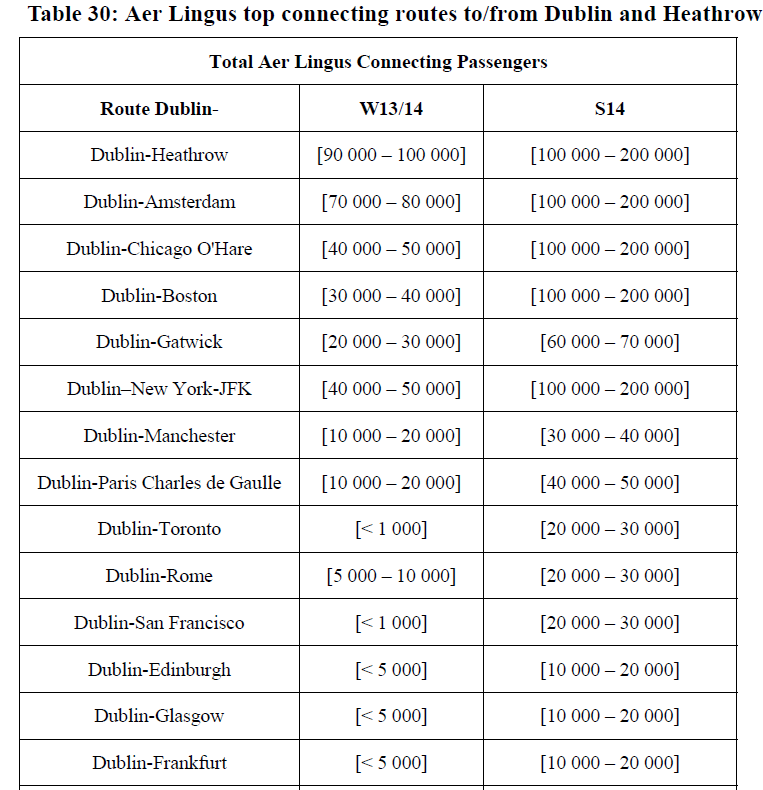
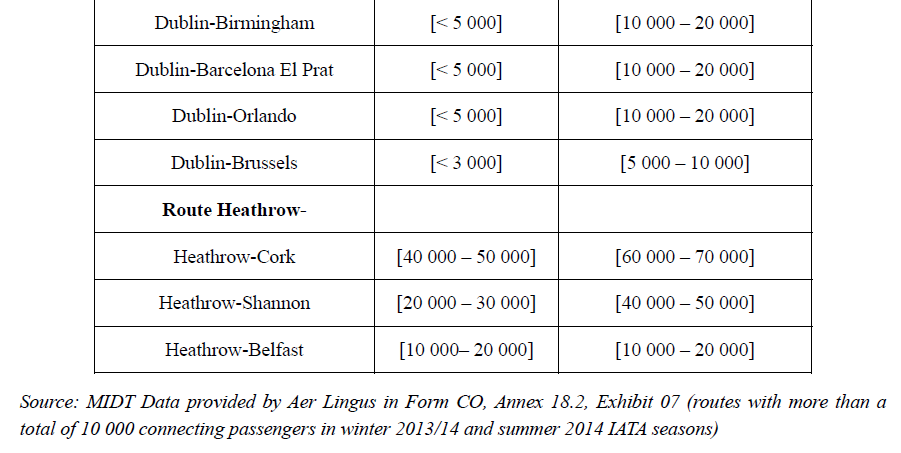
(453) Table 31 below provides an order of magnitude of Aer Lingus feed to/from various third party carriers in 2014 (only including routes where Aer Lingus provided more than 150 feed passengers in any of winter 2013/14 and summer 2014 IATA seasons).
On this selection of routes, Aer Lingus provided [500 000–1 000 000] feed passengers in 2014 to other carriers.
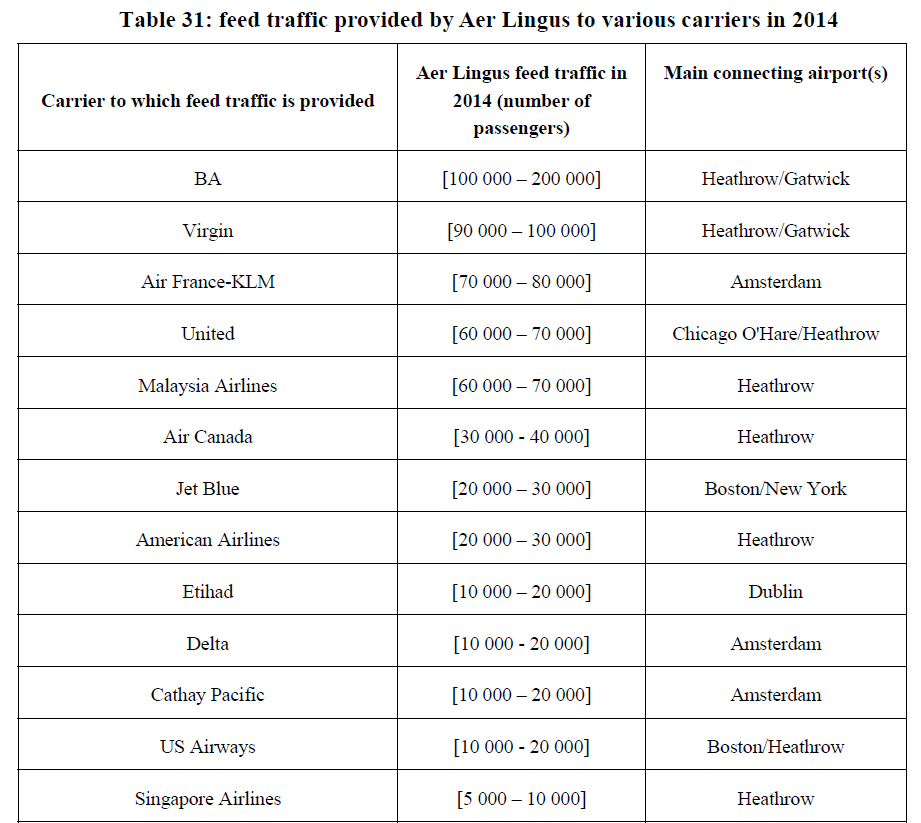

(454) When including all of Aer Lingus routes, each year, around [CONFIDENTIAL] passengers connect from Aer Lingus over London to/from BA services.
(455) In the context of the market investigation, serious concerns were expressed by certain competitors, corporate customers, travel agents and aviation authorities as regards the effects of the Transaction on feed traffic at Heathrow. A majority of corporate customers who expressed a view regarding the impact the Transaction would have, on their employees travelling from the UK or Ireland through Heathrow in order to take a connecting flight indicated that they expected a negative impact (higher prices, lower services, etc.). A majority of travel agents who expressed a view regarding the impact of the Transaction shared this view. A majority of corporate customers and of travel agents did however not consider that the impact would be negative for passengers originating in other regions than the UK or Ireland (ie. from elsewhere in Europe or from other international places). Finally, a majority of competitors who expressed a view regarding the impact the Transaction would have on passengers out of Heathrow, in particular on flights benefitting from the Parties' feed, indicated that the impact would be negative (in terms of prices offered, quality of services, etc.).369
(456) In particular, several respondents made references to the fact that Aer Lingus is not currently a member of oneworld and is an important provider of feed to third party carriers, which could potentially change due to the Transaction. For example, the CAA states that "Aer Lingus is currently non-aligned having left the oneworld alliance in 2006, having been a member for six years, which allowed it to develop code shares provide regional feeder traffic to other non-oneworld carriers at Heathrow. In particular, Aer Lingus shares Heathrow Terminal 2 with members of the Star Alliance. As a result, we consider that the competitive dynamics between oneworld and other carriers at Heathrow are extremely important as each alliance competes to develop their networks and attract both point-to-point and connecting (interline) passengers. Indeed, if we look at alliances, Star would be the obvious closest competitor to oneworld at Heathrow, albeit that their networks offer a number of different route choices in addition to those they overlap. The transatlantic market is particularly important in this regard, with business passengers valuing the simplicity of a "through ticket"." 370 The CAA further states: "The more "connecting" airlines such as bmi and Aer Lingus are gathered inside IAG (and arguably by extension oneworld), the more difficult will be for other carriers to compete with IAG at Heathrow, as the successful operation of routes at Heathrow are in part reliant on the ability to connect to a range of other destinations operated by "partner airlines"." 371
(457) Furthermore, the terms of the recommended cash offer by IAG for Aer Lingus include Connectivity Commitments which IAG has agreed with the Government of Ireland. The first condition of the Connectivity Commitments is about Aer Lingus slots at London Heathrow, thus indicating that Heathrow is the critical connecting hub for Irish traffic and that Aer Lingus' feed services between Heathrow and all Irish airports are critical to ensure adequate connectivity.372 While the terms of the announcement describe the intentions to grow Dublin as a hub, with "Ireland's location in the west of Europe mak[ing] it a natural gateway to connect Europe and North America"373, the concern to ensure that the relevant Heathrow slots will continue to be used for Irish services could be seen as implicitly recognising that non-stop transatlantic flights on their own are insufficient to ensure the necessary connectivity.
(458) In addition to concerns regarding the provision of feed traffic at Heathrow, during market investigation, certain customers and competitors also raised concerns regarding the provision of feed for certain long-haul routes from Gatwick, Manchester, Dublin, Amsterdam, and Shannon.374
(459) The theory of harm for routes departing from Gatwick is analogous to the theory of harm for routes departing from Heathrow. However, British Airways, Iberia and Vueling do not operate any direct long-haul services from Manchester, Dublin, Amsterdam or Shannon. The JBA operates two direct long-haul services from Manchester (Manchester – New York JFK and Manchester – Chicago O'Hare), one long-haul service from Amsterdam (Amsterdam – Philadelphia), and one seasonal long-haul service from Shannon (Shannon – Philadelphia).375 However, IAG does additionally operate long-haul services to/from several the same long-haul destinations from its hub airports at Heathrow and Gatwick.
(460) According to this theory of harm, IAG would redirect feed traffic provided by Aer Lingus to third parties at these airports to its own hub airports in Heathrow and Gatwick in order to feed its own long-haul operations to the same destinations. As passenger data provided by the Parties indicates that Amsterdam and Gatwick attract a significant share of connecting passengers from Ireland to specific destinations376, according to this theory of harm options available to connecting passengers to these destinations would be reduced if connecting traffic from Aer Lingus were to be redirected towards Heathrow as sole connecting hub.
(461) Table 32 provides a route-by-route overview of feed traffic provided by the Parties to third party carriers for a selection of international long-haul destinations to which IAG operates from the same connecting hub as the third party-carriers, or from its own hubs at Heathrow and Gatwick. These routes and carriers have been selected on the basis of thresholds reflecting the importance of the feeder traffic provided by the Parties relative to the total number of passengers travelling on the services provided by the carrier in question on the route, as well as on the basis of the market investigation.
(462) Consistent with the Commission's practice in the case IAG/bmi,377 the criterion applied to select the routes is that feeder traffic provided by the Parties to the service in question accounts for 3% of the total number of passengers, or the feeder traffic provided by Aer Lingus only accounts for 1% of the total number of passengers over winter 2013/14 and summer 2014 IATA seasons, when the third party receiving feed is not a member of oneworld. The connecting airports assessed by the Commission were all the airports where Aer Lingus provided more than 150 feed passengers for any long-haul route in any of winter 2013/14 and summer 2014 IATA seasons. In addition, only long-haul destinations to which IAG (or including the JBA) carried at least 10,000 passengers from the same connecting hub, or from Heathrow or Gatwick, were considered. These thresholds focus the Commission's analysis on the routes where (i) feed from Aer Lingus or from the Parties combined is higher than a de minimis proportion of total passengers on the route, and therefore where a hypothetical foreclosure may potentially impact the operations of the third party carriers; (ii) the third party carrier is not in the same alliance as IAG, and therefore IAG may theoretically have an incentive to foreclose; (iii) IAG's operations to/from the same long-haul destination/origin, from/to the same connecting hub or from/to its own hubs, are non-negligible and therefore IAG competes with the third party carrier.
(463) A number of routes meeting the above criterion as concerns feed passenger numbers, but where oneworld alliance members are the only ones concerned by the provision of feed from Aer Lingus and/or IAG (e.g. London Heathrow-Kuala Lumpur where Malaysia Airlines is the sole carrier receiving feed from the Parties) are not included in the list of routes in Table 32. This exclusion is adequate as IAG is unlikely to have any incentive to foreclose its partners from the same alliance. Routes where at least one third party which was not a member of oneworld received feed were not excluded through this criterion.
(464) The applied criterion is therefore adequate in the present case to focus the Commission's analyses of routes where feeder traffic could be a material aspect of operations for a third party carrier that is not in the same alliance as IAG.
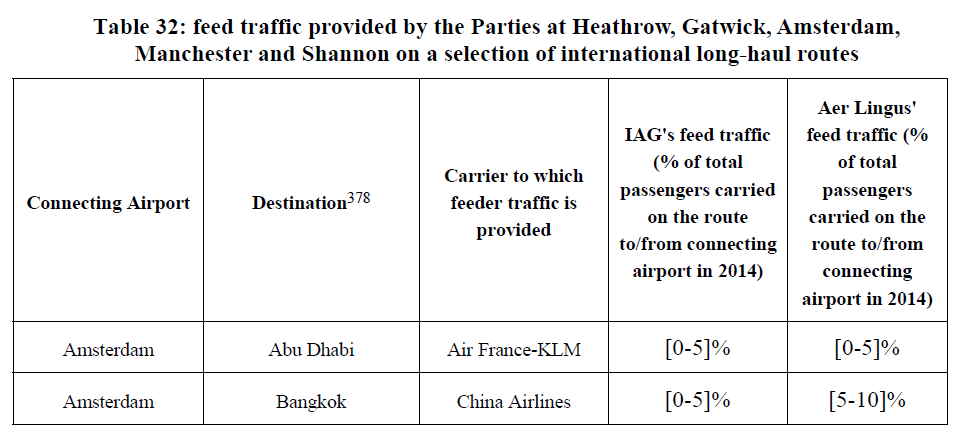
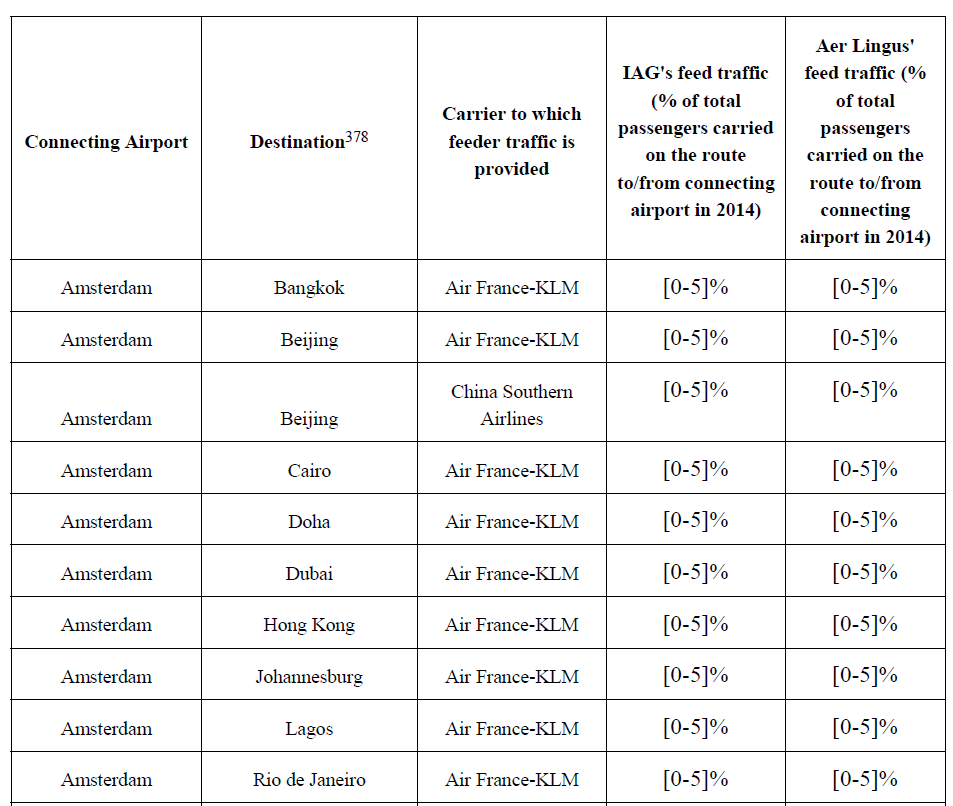
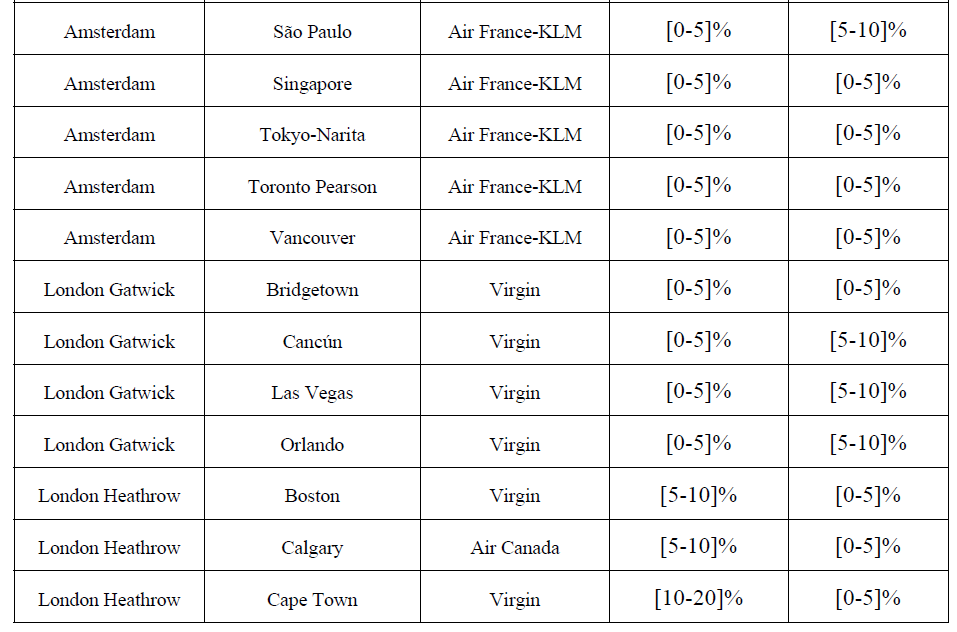

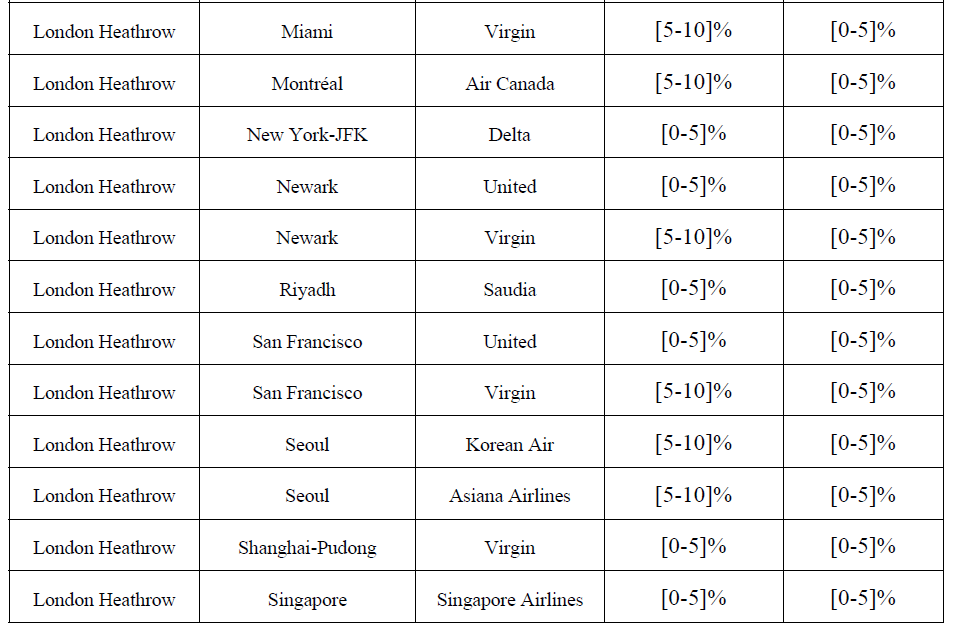
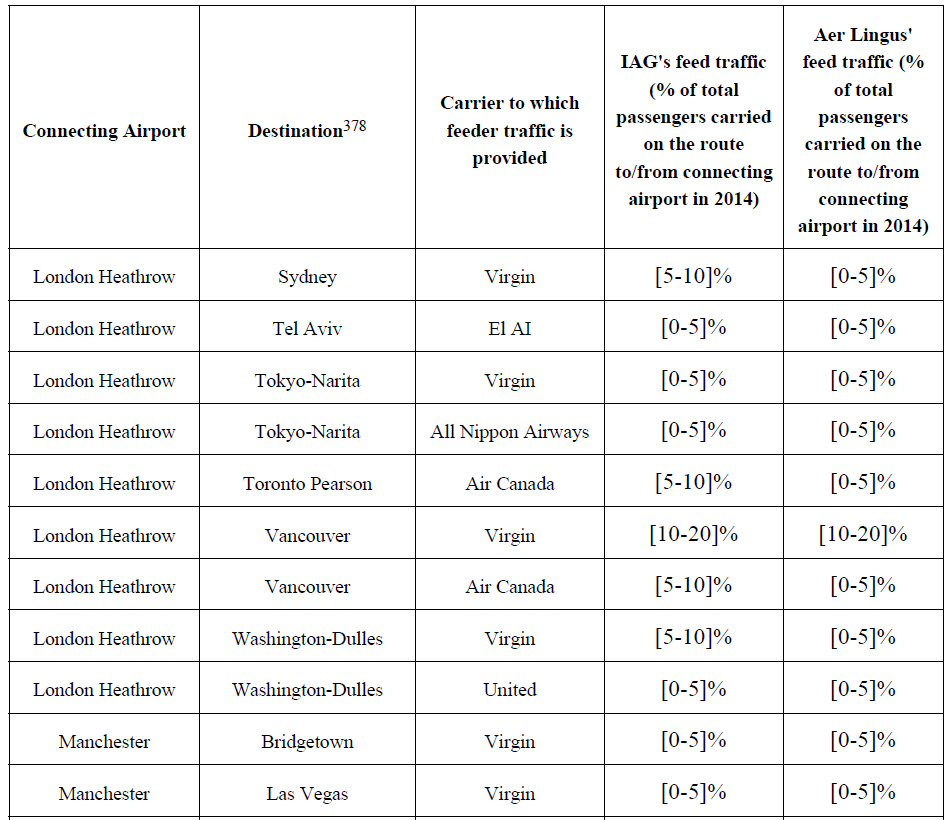

* Each box in the last two columns contains the percentage of feed traffic on the long-haul route both to and from the connecting airport for each of the Parties.
(465) As shown in Table 32 above, the feed traffic provided by Aer Lingus and the combined traffic provided by the Parties account for significant shares of the total number of passengers carried on certain long-haul routes by certain carriers. For example, in 2014, [0-5%] of the passengers carried by Air Canada and [10-20%] of the passengers carried by Virgin on their respective Heathrow-Vancouver routes were carried by Aer Lingus on its "feed routes".379 As another illustration, for Virgin, which is a significant recipient of feed traffic from the Parties at Heathrow, Gatwick and Manchester, this feed traffic accounted for approximately [CONFIDENTIAL] passengers on the routes listed in Table 32, with [CONFIDENTIAL] passengers from Aer Lingus in 2014. 380 Aer Lingus also provides significant feed at Amsterdam to Air France-KLM, and to certain other members of Sky Team on particular routes. This feed traffic from Aer Lingus accounted for approximately [CONFIDENTIAL] passengers for Air France-KLM on the routes listed in Table 32 in 2014. 381
(466) Overall, in addition to the concerns expressed during the market investigation, the magnitude of the feed traffic provided by the Parties to carriers competing with IAG on a number of long-haul routes out of Heathrow, Gatwick, Amsterdam, Manchester and Shannon warrants an assessment of a theory of harm relating to foreclosure of access to flights for connecting passengers.
(ii) Ability to foreclose
(467) To offer an indirect journey on a given city pair via a connecting hub, access to flights linking each end of the route with that connecting hub may constitute an essential input. Therefore, restriction of access to that input can potentially raise competition problems.382
(468) MITA and BITA agreements are typically open ended and have a 30 day notice/termination whereas SPAs are generally valid for one year and are renegotiated thereafter. It is also customary for SPAs to have a 30 day prior written notice termination clause that can be exercised by either carrier at any time, without cause. Codeshare agreements are typically open ended and have various termination clauses. Most termination clauses for codeshare agreements include 3 months, 6 months or 180 days prior written notice by either party.383
(469) Post-Transaction, IAG would therefore be able to terminate Aer Lingus' feed traffic agreements with third parties in the short term and, given this possibility, to impose on them a revision of such agreements on terms less favourable than pre-Transaction.
(470) Moreover, even without terminating or revising interlining arrangements, IAG may be able to restrict interlining partners' access to its flights for example by discriminating against them as regards how access is provided to its seats inventory. [IAG's inventory management system] [384] [385]
(471) Since IAG controls the system through which competing carriers book seats on its flights for connecting passengers, it seems possible for IAG to close punctually certain booking classes for passengers connecting onto another carrier's flight, possibly leaving open more expensive classes, or to reduce the number of seats available within certain fares classes to passengers wishing to connect to third parties' operations. It may not be immediately apparent to the other party to the interlining arrangement that the class in question is still open for passengers connecting onto flights operated by IAG.
(472) IAG's ability to foreclose access to its flights for connecting passengers on certain routes may be limited depending on the degree of market power that IAG would enjoy on these upstream markets.386 On behind/beyond routes from Cork and Shannon where Aer Lingus operates and IAG does not, Aer Lingus faces no competition (and thus enjoys market power). Therefore post-Transaction, IAG is likely to be able to foreclose access to flights to Heathrow for connecting passengers on these routes on which Aer Lingus currently operates.
(473) This is also likely to be the case for the two direct-direct overlap routes where the Parties currently operate alone to Heathrow, or have high combined market shares or frequencies on a Heathrow-only basis (i.e. from Dublin and Belfast). Indeed, on these routes, whereas currently, attempts by IAG to foreclose access to its own flights may result in carriers switching to Aer Lingus, this would not be the case post-Transaction.
(474) In addition, according to the market investigation and data submitted by the Parties, the routes from Dublin, Belfast, Cork, and Shannon appear as important routes in terms of provision of feeder traffic to other carriers at Heathrow.387
(475) Furthermore, based on evidence collected during the market investigation, routes from these airports also appear as important routes in terms of provision of feed traffic to other carriers at Gatwick, Amsterdam and Manchester. Routes from Heathrow and other regional UK airports appear important for the provision of feed at Dublin and Shannon.388
(476) As concerns feed:
a. at Gatwick, Aer Lingus is the only airline currently with interlining capabilities on flights from Dublin to Gatwick (its major competitor being Ryanair), from Belfast to Gatwick (its major competitor being easyJet), and is the only airline operating services from Knock to Gatwick.
b. at Amsterdam, Aer Lingus currently operates alone on the routes from Dublin and Cork;
c. at Manchester, Aer Lingus is the only airline currently with interlining capabilities on flights from Dublin to Manchester (its major competitor being Ryanair) and operates alone on the route Cork-Manchester;
d. at Shannon, Aer Lingus currently operates alone on the route from Heathrow and certain routes from UK regional airports that provide feed.
(477) Therefore post-Transaction, IAG is likely to be able to foreclose access to flights at Gatwick, Amsterdam, Manchester and Shannon for connecting passengers on these routes on which Aer Lingus currently operates.
(478) The Parties also claim that no competition concerns will arise as a result of the Transaction with respect to the availability of feed, because particularly for passengers connecting at Heathrow, subject to meeting the eligibility criteria, IAG is already committed to agree SPAs for the provision of feed passengers under the Article 9 Commitments given to the Commission in 2010 in the context of the BA/AA/IB transatlantic alliance case,389 as well as the EUMR Phase I commitments given to the Commission in 2012 in the context of the IAG/bmi case (together, the "bmi/JBA Commitments").390
(479) However, according to the Commission notice on remedies acceptable under Council Regulation (EC) No 139/2004 and under Commission Regulation (EC) No 802/2004 ("the notice on remedies"), where a concentration raises competition concerns, the parties may seek to modify the concentration in order to resolve the competition concerns and thereby gain clearance of their merger. The Commission has to assess whether the proposed remedies, once implemented, would eliminate the competition concerns identified. Remedies are therefore designed to address competition concerns for a specific concentration. The current Transaction triggers a distinct competitive assessment and specific issues and is without prejudice to the proper application of other commitments submitted by IAG to resolve other competition concerns.
(480) Furthermore, competition concerns at Gatwick, Manchester, Amsterdam and Shannon airports are not covered by the scope of previous commitments submitted by IAG.
(481) To conclude, post Transaction, IAG is likely to be able to hamper access to flights for passengers flying to/from certain long-haul destinations and connecting at Heathrow, Gatwick, Amsterdam, Manchester and Shannon from/to the routes currently operated by Aer Lingus from/to Dublin, Belfast, Cork, Shannon and Knock (and other European behind/beyond routes when Shannon is the connecting hub).
(iii) Incentive to foreclose
(482) The incentives for an airline to foreclose a competitor in the context of feed traffic were described by the Commission in the IAG/Bmi decision.391 In the present case, IAG could also deny or hamper access to its flights – or raise the costs392 of such access – for passengers connecting onto flights operated by another carrier on a route where this carrier would compete with IAG. An objective could be to raise the costs incurred by other carriers in offering certain indirect journeys (e.g. Dublin–San Francisco via Heathrow), which may allow IAG to raise prices for such indirect journeys. Another objective could be to divert away passengers from that competitor to IAG's own flights, with a view to increasing load factors but also to weaken that competitor and pave the way for price increases. For example, by applying such a foreclosure strategy on various "feed routes" to passengers connecting onto services offered by a competitor on the Heathrow – San Francisco route (where IAG also operates), IAG may reduce the number of passengers carried on this competitor's services between Heathrow and San Francisco. This competitor would then be weakened on this route and exerts less competitive pressure on IAG, thereby allowing it to raise prices, both for direct journeys out of Heathrow to San Francisco and for indirect journeys via Heathrow to San Francisco.
(483) Aer Lingus is currently providing a significant number of passengers to other carriers (in particular for the routes listed in Table 32 above). Control by IAG over such a significant portion of the total number of passengers carried by a competitor on a given route is likely to incentivise IAG to engage in a foreclosure conduct as such a conduct can be expected to have a significant impact on the profitability of this competitor and its ability to exert competitive constraint on IAG on the route.
(484) [IAG business strategy regarding feed provided to certain carriers].[393][394]
(485) However, one specific example of an interlining relationship is not necessarily representative of all such relationships, nor of IAG's overall incentive to foreclose, which needs to be based upon an assessment of these relationships as a whole. [IAG's business strategy], [example of benefit to IAG that could result from a foreclosure strategy].
(486) [IAG business strategy].[395][396][397]
(487) [EI business strategy].
(488) [EI business strategy].[398]
(489) The above shows that[, in the Commission's view,] IAG may well cause Aer Lingus to terminate many of its cooperation agreements with other carriers post-Transaction.
(490) The incentive to foreclose depends on the degree to which foreclosure would be profitable. IAG is expected to take into account how the provision of access to its flights for connecting passengers would affect its profits on that upstream market, but also its profits on the downstream air passenger transport market. IAG would face a trade-off between the profit lost in the upstream market due to a reduction of input sales to (actual or potential) rivals and the profit gain, in the short or longer term, from expanding sales downstream or, as the case may be, being able to raise prices to consumers. The trade-off is likely to depend on the level of profits the merged entity obtains upstream and downstream. Other things being equal, the lower the margins upstream, the lower the loss from restricting input sales. Similarly, the higher the downstream margins, the higher the profit gain from increasing.399
(491) IAG and Aer Lingus provided margin data for a selection of short-haul and international long-haul routes to/from Heathrow, Gatwick, Dublin, Manchester and Madrid, with the short-haul routes being the ones offering most feed traffic, and the long-haul routes the ones benefiting from most feed traffic by the Parties. The selection of short-haul routes includes in particular routes from Dublin, Belfast, Cork, Knock and Shannon. [Parties’ margin data].
(492) Therefore, if IAG undertook a foreclosure strategy on a given route, even a small number of passengers diverted away from a competitor onto one of its long-haul flights would likely make foreclosure profitable.400 [Parties’ inventory management systems and network contribution]401 [Parties’ inventory management systems and network contribution].402
(493) In order to assess IAG's incentives to engage in a foreclosure strategy, it is necessary to take into consideration the possibility that certain passengers may switch from services via Heathrow (e.g. Dublin–San Francisco via Heathrow) to services via other hubs (e.g. Dublin–San Francisco via Amsterdam). Such passengers would not be diverted to IAG's services. IAG provided data illustrating that both ends of the various routes operated by third parties from Heathrow, Gatwick, Manchester and Amsterdam would be well connected to a range of other European and non-European hubs, thus allowing the third party operators to generate feed at either end of the route to increase its load factor, and that there are realistic alternative routings to the same destinations within the third parties' networks.403
(494) Heathrow is an important connecting hub for passengers from Ireland. Virgin provided data indicating that 23% of passengers travelling to/from Ireland (19% of passengers travelling to/from Dublin) on a connecting journey to the rest of the world choose to fly via Heathrow, as compared to via other international connecting hubs. This percentage increases to 44% for passengers to/from Ireland excluding Dublin. In addition, Heathrow is also an important connecting hub among European airports, with 52% of passengers travelling to/from Ireland (46% of passengers travelling to/from Dublin) on a connecting journey via an European hub choosing to fly via Heathrow, as compared to via other European hubs. This percentage increases to 75% for passengers to/from Ireland excluding Dublin.404
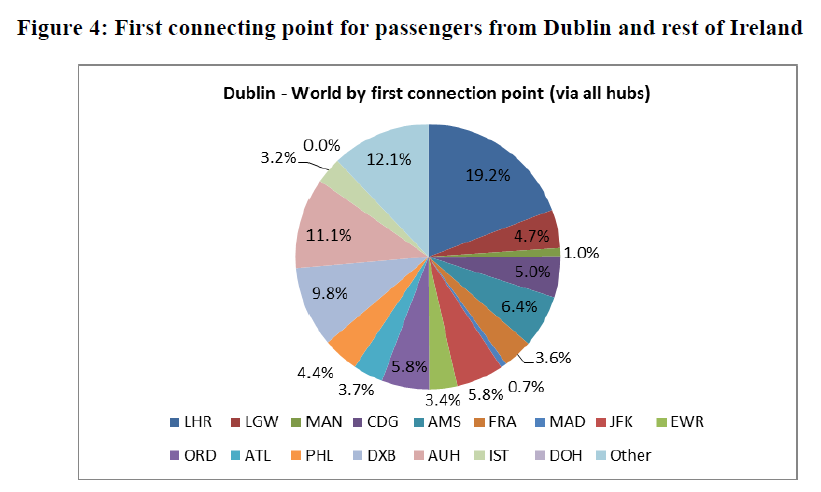
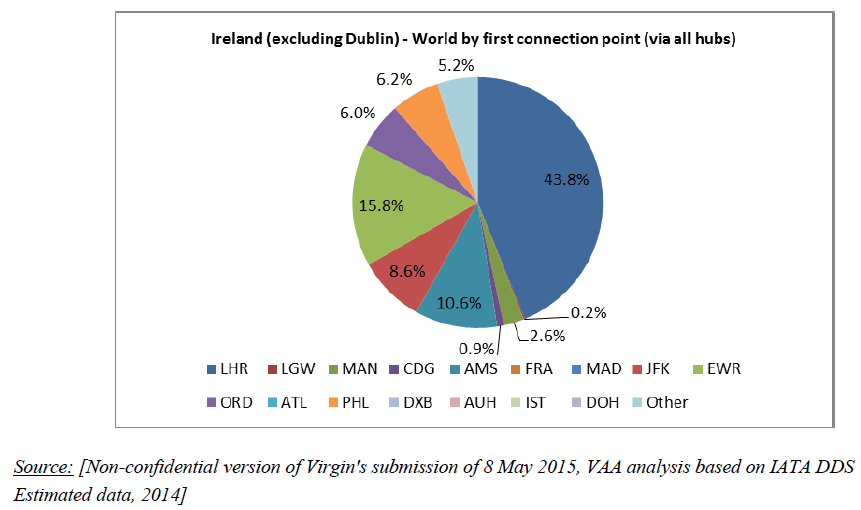
(495) Furthermore, Virgin provided data indicating that Heathrow offers a greater number of frequencies to certain international destinations than are available via other hubs. In particular, there are more flights between Heathrow and the US than there are between any other major hub in Europe and the US.405 Coupled with the larger number of daily frequencies from Ireland to/from Heathrow compared to frequencies between Ireland and other connecting hubs (including frequencies between Ireland and hubs in North America), this provides passengers connecting at Heathrow to a number of other long-haul destinations with a frequency advantage.
(496) IAG also provided data on the proportion of connecting passengers travelling respectively from Ireland, via Heathrow and other European or non-European hubs, to various geographical regions (e.g. Ireland-North America). According to IAG, those data show that in many cases, regardless of which region they are flying to, Irish passengers choose to connect over a range of hub airports and are not dependent on transferring at Heathrow, Gatwick or Manchester when flying to long-haul destinations outside Europe.406 For certain city-pairs, IAG also provided an analysis on feed provided by Aer Lingus at Heathrow and Gatwick, in light of other connecting passenger options. According to IAG, those data show that for these city-pairs, feed from Aer Lingus at Heathrow, Gatwick or Manchester is not an important factor to the sustainability of the third party's services on the long-haul sector. 407
(497) However, the Commission analysed these data, as well as data provided by Dublin Airport Authority regarding Dublin Airport onward connecting traffic in 2014, and found that for several of these city pairs, more than half of the passengers travel via London Heathrow. The frequency of services is also higher for passengers connecting through Heathrow.
(498) In addition, the proportion of connecting passengers to/from Ireland excluding Dublin travelling to the same destinations through Heathrow is often even greater. This constitutes an indication that at least in these cases, a foreclosure strategy leading to price increases for indirect journeys via Heathrow offered by IAG's competitors, may not trigger a major switch of customers to indirect services via other hubs but may rather entice a large proportion of passengers to switch to IAG's services.
(499) Furthermore, even in cases where the proportion of passengers travelling on the city pair via other hubs than Heathrow is higher, it has not been shown that a price increase for access to IAG's feeder flights would lead a large proportion of passengers to switch to services via these other hubs. In the framework of the market investigation, travel agents and corporate customers were asked whether when booking a flight which connects at Heathrow and for which the first leg is operated by Aer Lingus, they considered and compared prices of other carriers' flights to the same destination via other European hubs. A large majority of travel agents and corporate customers indicated that they would make such a comparison, for journeys either westwards or eastwards. Moreover, they mentioned various criteria used for the choice of a given itinerary, i.e. not only ticket prices but also overall travel time and connecting time and convenience at the hub. The fact that price clearly appears not to be the only criterion used to select a connecting hub is an indication that journeys on a given city-pair via two different hubs may be relatively differentiated services. This may limit the extent to which passengers would switch from services via Heathrow to services via another hub if they were facing a price increase.
(500) Moreover, the Commission also found that for several routes to specific destinations and regions of the world, Amsterdam, Manchester and Gatwick also attract a very high proportion of connecting passengers from Ireland. For example, when travelling to Asia, 21.4% of passengers from Ireland connect through Heathrow and 14.7% through Amsterdam, while the other passengers connect through non-European hubs to which the frequency of flights from Ireland is lower than through these two hubs.408 Similar percentages arise for specific routes through Gatwick and Manchester. Since these airports attract a significant share of connecting passengers from Ireland to specific destinations, options available to connecting passengers to these long-haul destinations would be reduced if connecting traffic from Aer Lingus were to be redirected towards Heathrow as connecting hub.
(501) Aer Lingus' Rule 2.5 announcement on IAG's recommended cash offer also states that "In addition to improving network options for IAG's customers and those of its oneworld partner airlines, IAG also expects to gain new feed from the Irish market to support the development of its London and Madrid hubs and help underpin its long haul routes into Asia-Pacific, Africa and Latin America." This illustrates IAG's incentive to divert feed from the other European hubs to Heathrow to feed its own long-haul operations.
(502) Another relevant element to assess IAG's incentives to foreclose access to its flights for passengers connecting onto a flight operated by another carrier on a long-haul route where IAG also operates is the presence of a hub of this carrier at the non-London end of the route, or at both ends. IAG argues that a carrier with a hub at both ends of a route should be at least equally well placed (if not significantly better placed) than IAG to provide feed passengers to its own services. Moreover, according to IAG, a carrier with a hub at the non-London end of a long haul route of concern would be able to leverage its provision of feed to IAG at its hub airport to secure feed from IAG.
(503) In particular, the Parties claim that in a number of cases, IAG receives significant feed traffic from competitors on the long-haul routes of concern that have a hub at the non-London end of the route.409 The Parties further claim that if IAG undertook a foreclosure strategy against their competitors on certain routes, this would expose the IAG carriers to the risk of retaliation, possibly in areas of their networks where they benefit disproportionately from interline arrangements with the same partner. Moreover, a carrier operating from a hub has in principle access to plentiful feeder traffic at its hub and, for that reason, would be unlikely to be significantly weakened by a foreclosure strategy undertaken by IAG. In particular, the Parties argue that when the interlining partner has a hub at the other end, IAG's incentives to engage in a foreclosure strategy targeting this kind of carriers would appear limited.410
(504) [BUSINESS SECRETS].[411] [412] Therefore, while IAG's incentives to foreclose appear to be lessened in cases where it competes with a carrier having a hub at the other end of the route (e.g. non-European end), situations might arise where imbalances in the flow of passengers could still lead to an incentive for IAG to engage in a foreclosure strategy on those routes.
(505) Finally, the Parties argue that from the supply-side, using feed at points behind/beyond a relevant long-haul sector is only one of several options available to an operator which operates a direct long-haul service in order to ensure that the sector has sufficient load-factor. In particular, the Parties argued that self-connecting is a viable and growing alternative for transatlantic passengers. The Parties referred to an analysis by Gatwick airport which found that "almost 1 million passengers connected at the airport to or from an [low-cost carrier] and that this was before the launch of Gatwick Connect, the dedicated self-connection service aimed at encouraging passengers on [low-cost carriers] to transfer at the airport." Gatwick Connect is a self-connection service413 aimed at facilitating passengers on LCCs to transfer at the airport.414 The parties also submitted a Centre for Aviation article which calls self-connecting "the next vital piece of the [airline] industry's development".415
(506) However, data provided by Gatwick Connect indicates that the number of such self-connections remains marginal and does not have an impact on the competitive assessment in this case. Only 45 000–50 000 passengers in total, of which 3 000– 4 000 passengers from/to Belfast and 6 000–7 000 from/to Ireland used Gatwick Connect in 2014.416
(507) The market investigation also points out that self-connections, while a growing trend, are still very limited as alternatives to feed417, notably due to the additional time required, the absence of services available on through-connections (baggage processing, check-in, etc.), an increased risk of missing connections and the fact that self-connecting passengers who travel via the UK would be liable for UK Air Passenger Duty, whereas passengers through-connecting from an international flight to another international flight who transit through the UK (e.g. routing Ireland-UK-United States, connecting at Heathrow) would not.418
(508) Therefore, the Commission considers that post-Transaction, IAG is likely to have the incentives to restrict access to its flights on some and possibly all the routes on which Aer Lingus currently operates for passengers connecting onto flights competing with IAG's services on certain routes, in particular the routes listed in Table 32, in view of the importance of feeder traffic brought by the Parties to these routes.
(iv) Overall likely impact on effective competition
(509) Anticompetitive foreclosure may occur when a vertical merger allows the parties to increase the costs of downstream rivals on the market thereby leading to an upward pressure on their sales prices. Significant harm to effective competition normally requires that the foreclosed firms play a sufficiently important role in the competitive process on the downstream market.419
(510) During the market investigation, Virgin argued that consumers travelling on connecting routes between Ireland and long-haul destinations outside of Europe will lose altogether, or experience a significant decrease in, choice of carrier for the long-haul leg of the connecting journey. Indeed, Virgin provided data indicating that, there is currently a significant volume of passengers who travel on such routes via a UK point who choose to fly with a carrier other than BA on the long-haul leg. Virgin's submission also argues that Virgin is an important provider of services for connecting passengers travelling between points in Ireland and long-haul destinations outside the EU, despite not operating directly to Ireland.
(511) In case of foreclosure, the Commission is of the view that some of these passengers could be harmed by the loss of choice. During the market investigation, some corporate customers and travel agents also expressed the view that, as a result of the Transaction, Aer Lingus may stop providing feeder traffic or may provide less feeder traffic to other competitors on some of the routes listed in Table 32. When asked whether such a reduction in feed would lead to a negative impact on their organization, certain respondents indicated that this would lead to less connecting options, in particular over Heathrow, and reduce the number of cheap alternatives for travellers.420
(512) Table 33 sets out for various routes listed in Table 32 the market share of various third party airlines which could be potentially foreclosed by IAG, as a percentage of total passengers travelling on the route. Furthermore, the Parties' combined market shares are very high on a number of routes, even taking into consideration the long-haul city pairs. If taking into account the airport pairs, these market shares are even higher for some destinations.
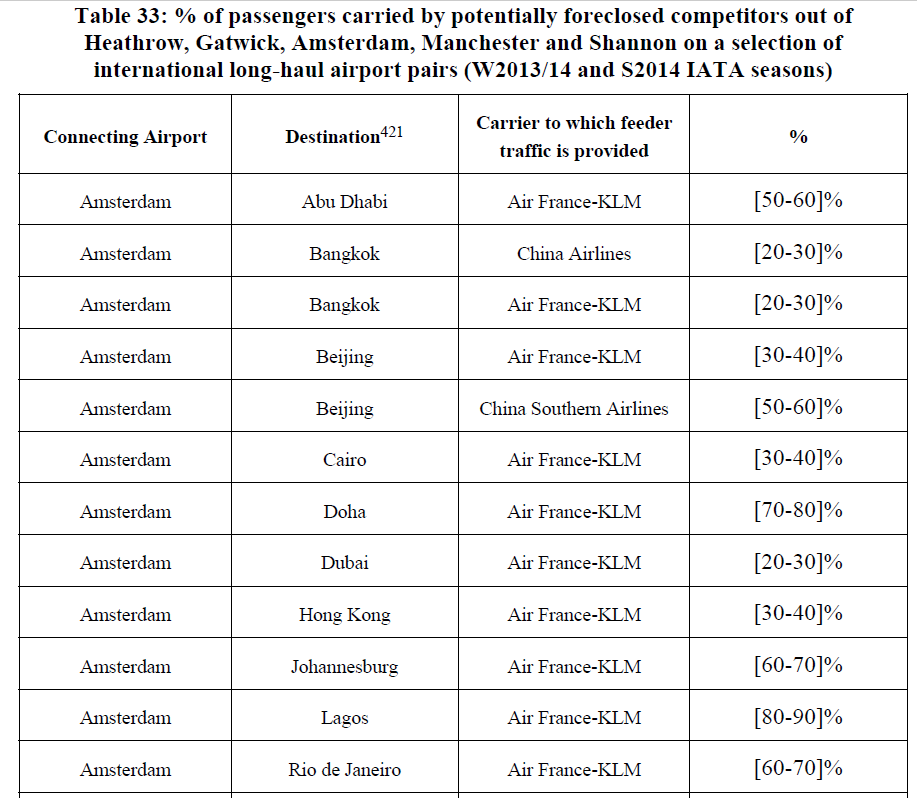
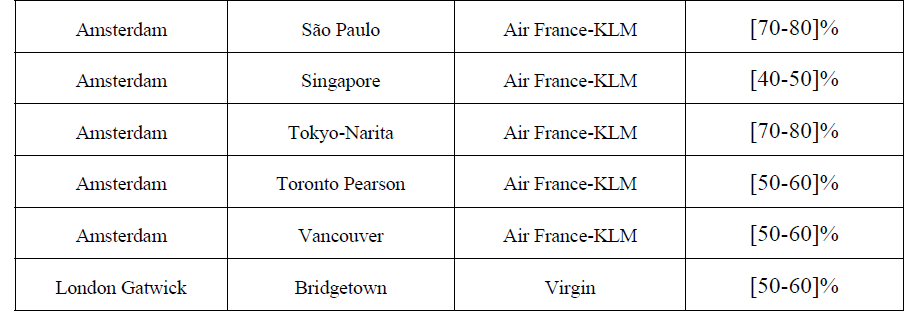
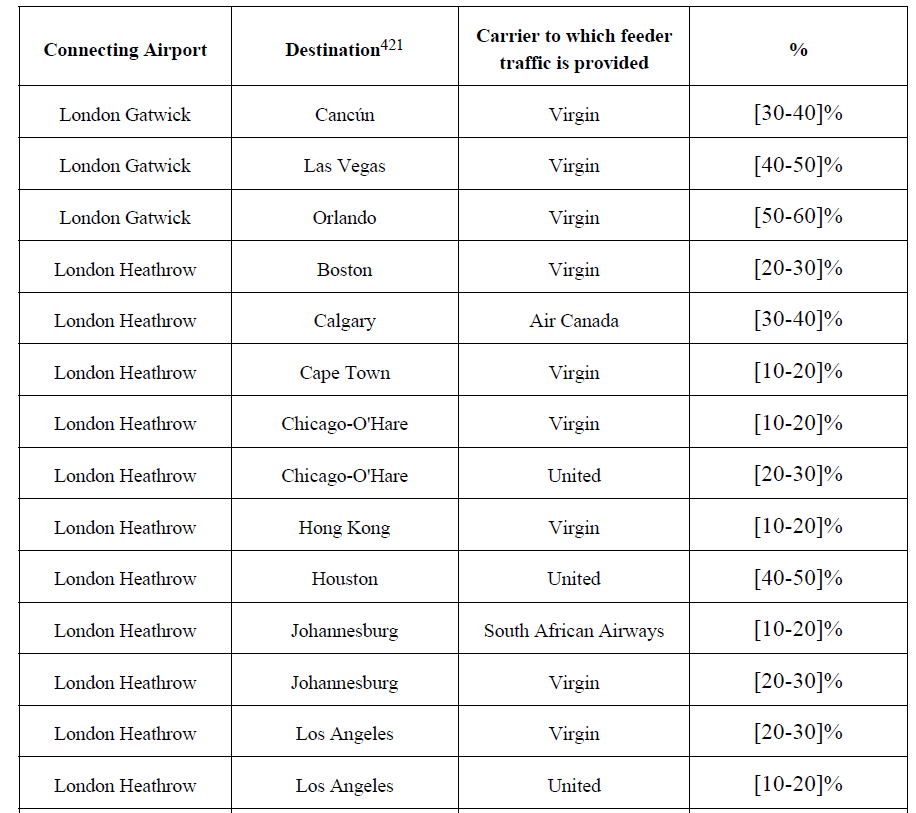
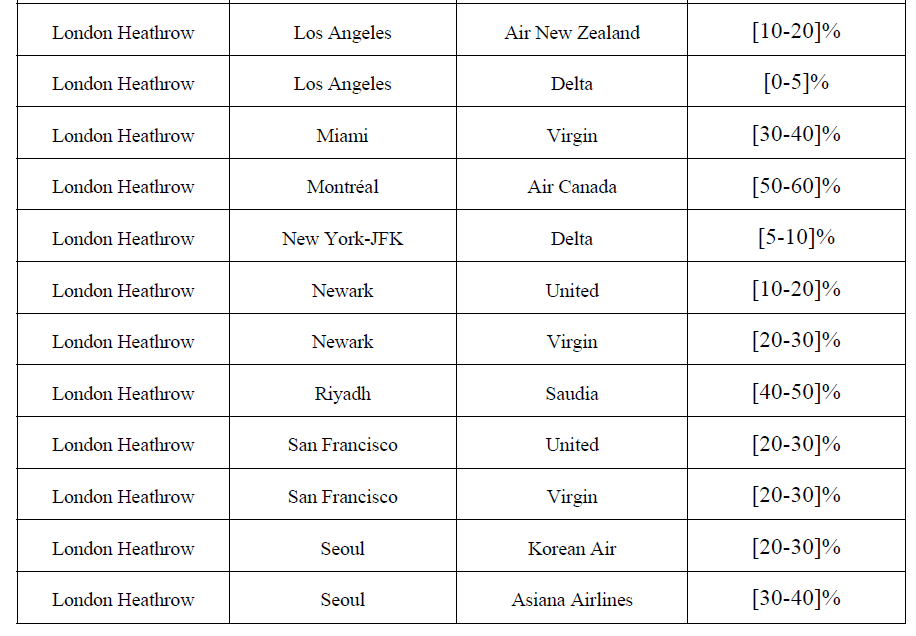
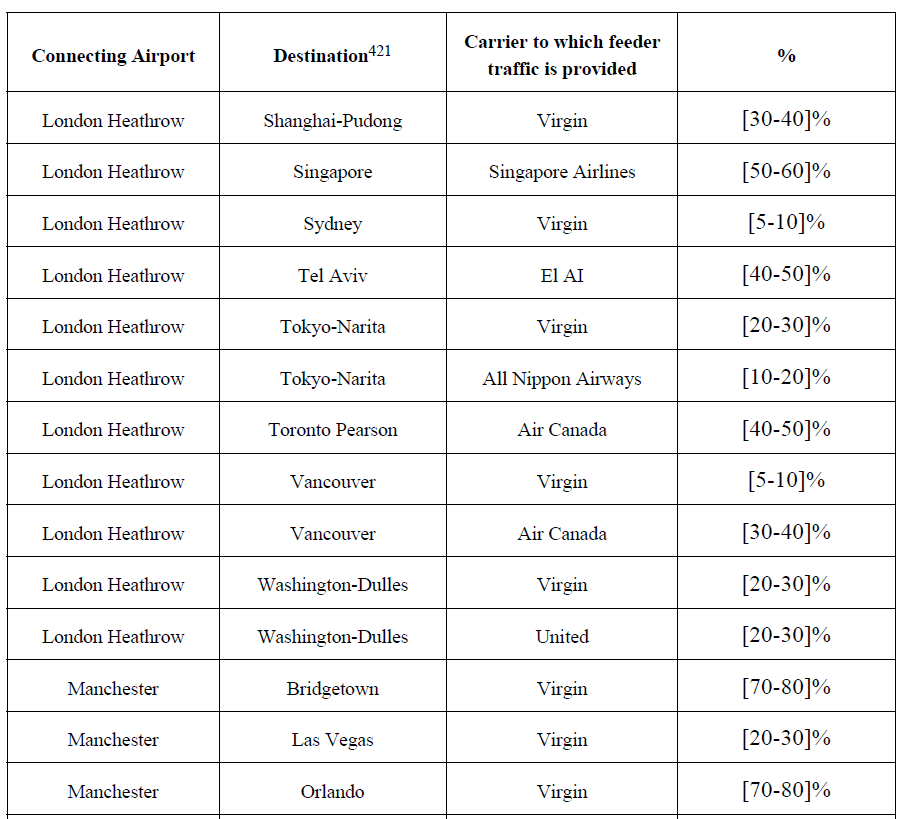

(513) In a number of routes, the percentage of total passengers carried by competing airlines which could be potentially foreclosed by IAG appear very significant, illustrating the important role played by the potentially foreclosed competitor in the competitive process on the routes. In such cases, foreclosure by IAG (achieved through raising the costs of the foreclosed rival or reducing the number of passengers it carries) is likely to weaken that competitor, lessen the competitive constraint it exerts on IAG, and eventually bring prices up on the route.
(514) Furthermore, Post-Transaction, a foreclosure strategy affecting such routes could result in foreclosing all rivals on relevant downstream markets (e.g. all carriers offering indirect journeys on the Dublin–San Francisco O&D via Heathrow could be foreclosed in view of the Parties' position on the Dublin–Heathrow route). This could result in significant price increase for such indirect journeys.
(515) As concerns the situation at Heathrow, a foreclosure strategy which would significantly reduce feed traffic (or increasing the costs incurred to keep this feed traffic) is likely to have detrimental effects on the long-haul routes out of Heathrow, considering in particular the importance of the aggregate feed traffic brought by Aer Lingus alone and / or by the Parties together to certain carriers for certain long-haul routes out of Heathrow. On some long-haul routes out of Heathrow, carriers which could be foreclosed by IAG appear to play an important competitive role. If these carriers were materially affected by foreclosure achieved by IAG, the competitive constraint that they would exert on other carriers active on the routes in question (including IAG) may be significantly reduced, bringing prices upwards.
(v) Conclusion
(516) The Transaction would likely lead IAG to engage in a foreclosure strategy consisting in restricting access to flights (or raising the costs of that access) for passengers ex Dublin, Belfast, Cork, Knock and Shannon, connecting at Heathrow, Gatwick, Amsterdam, Manchester and Shannon to services operated by other carriers in competition with IAG on various long-haul routes. Such a strategy is likely to have a detrimental impact on prices on these long-haul routes.
(517) In light of the above and of the other available evidence, the Commission therefore considers that the Transaction raises serious doubts as to its compatibility with the internal market as regards the provision of feed traffic to services operated by other carriers in competition with IAG on various long-haul routes out of the aforementioned connecting airports.
6. COMPETITIVE ASSESSMENT GROUNDHANDLING
(a) Horizontal relationships
(518) On IAG's side only Iberia currently provides ground handling services to third parties at a number of Spanish airports, as well as in Equatorial Guinea.422

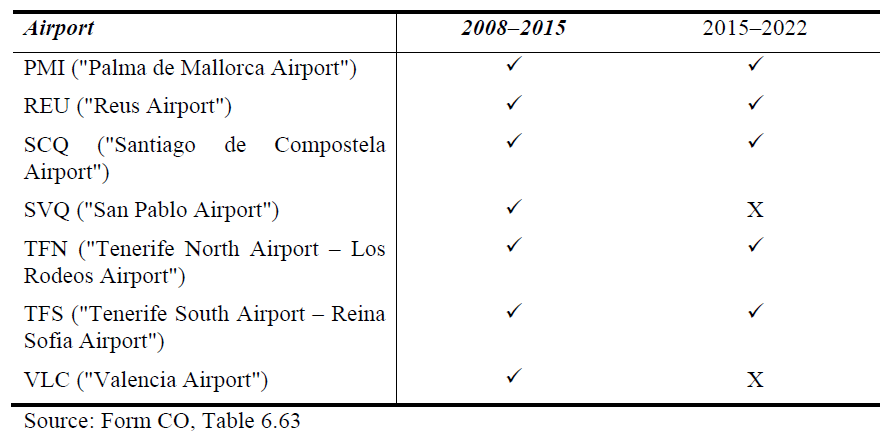
(519) At ACE and FUE,423 Iberia indirectly provides ground handling services to third parties via a Union Temporal de Empresas (UTE, a temporary business structure in Spain) with CLECE (parent company of Clever Handling, subsidiary through which CLECE provides handling services at AGP, ACE and FUE),424 and at BCN425 Iberia is part of a UTE with Globalia Handling.
(520) In Spain, suppliers of ramp services are selected for a period of seven years. A new call for tenders was launched in 2014, the results of which were announced on 13 May 2015 (and are set out in Table 6.63 below). The standard conditions of the tender establish, in principle, a four month deadline for new suppliers to start operating.
(521) As a result of these tenders, the UTEs referred to above will be dissolved following the implementation of the concession agreements and (i) Iberia will no longer supply ramp and airside cargo ground handling services to third parties at ACE and FUE;426 and (ii) Iberia will begin to supply third parties as an independent provider at BCN. In addition, Iberia will no longer be providing services at SVQ and VLC427 (as different providers have been appointed); and
(522) However this four month deadline has been suspended following an appeal filed by tender applicants excluded from the award.428 Suspension will last until the administrative court issues a ruling. Until the new concessions are implemented, current authorised suppliers will continue providing the ramp handling services.
(523) Aer Lingus provides intra-group ground handling services at certain Irish airports (DUB, ORK and SNN).429 Its provision of ground handling services to third parties is limited to the provision of passenger and ramp ground handling services to Ethiad at DUB and the provision of airside cargo handling services to Etihad at DUB and SNN430.
(524) Accordingly, the Transaction does not lead to any horizontal overlaps between the Parties.
(b) Vertical relationships
(525) As regards vertical relationships, Aer Lingus does not provide any ground handling services to third parties at airports at which IAG is a purchaser of groundhanding services.
(526) Aer Lingus does, however, purchase ground handling services exclusively from Iberia (or its consortia) at all airports at which Iberia (or its consortia) offers such services and Aer Lingus requires such services. That is, Iberia provides full ground handling services to Aer Lingus at AGP, ALC, BIO, IBZ, LPA, MAD, PMI, SCQ and TFS431. It also provides full ground handling services to Aer Lingus at FUE and ACE via its consortium with Clever Handling and at BCN432 via its consortium with Globia Handling. Following the implementation of the new concession agreements, Iberia will no longer be active in supplying Aer Lingus at ACE and FUE433 and therefore there will no longer be vertical relationships at these airports. Table 35 below sets out an overview of ground handling services provided to Aer Lingus by IAG in 2014.
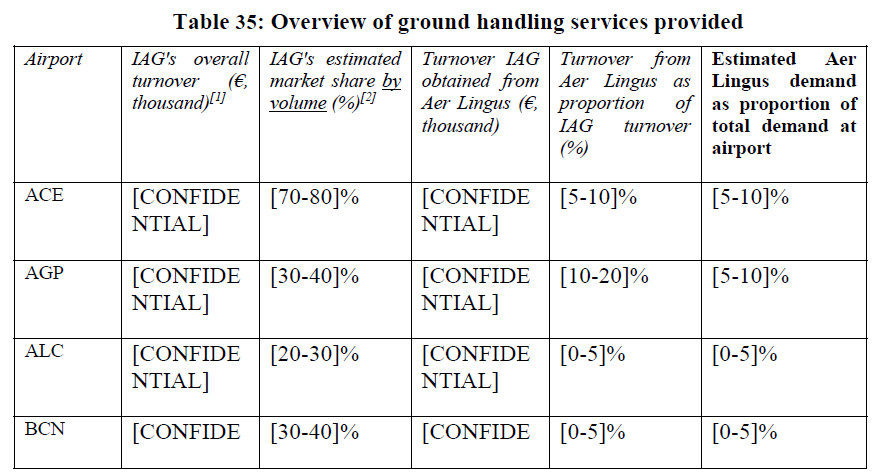
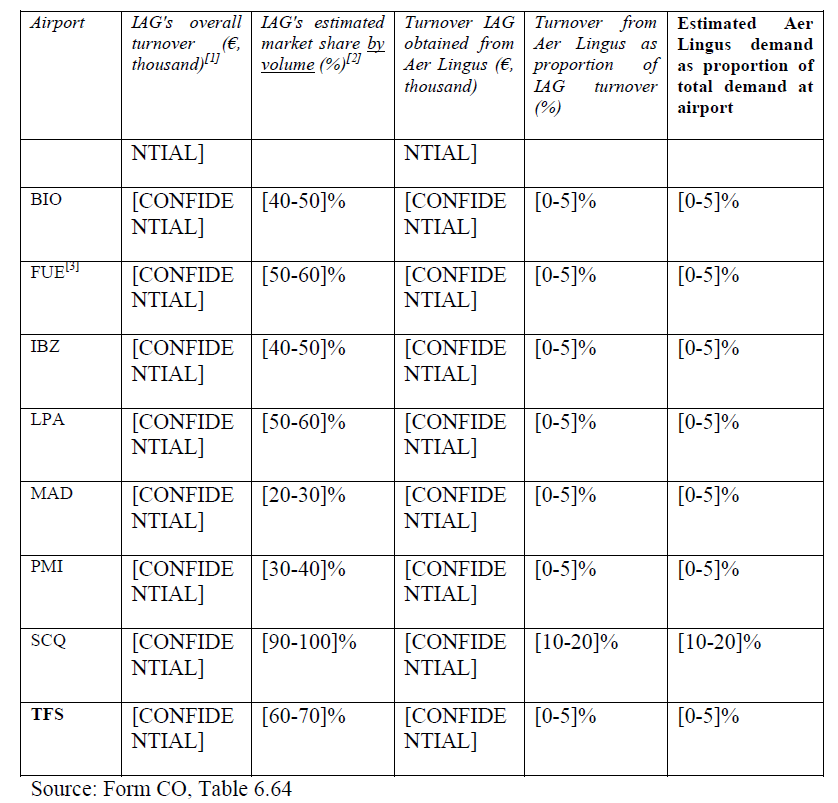
(527) If the narrowest geographic market definition is considered (i.e., the provision of ground handling services at individual airports) vertically affected markets arise only at ACE, AGP, BCN, BIO, FUE, IBZ, LPA, PMI, SCQ and TFS434 (as IAG's estimated market shares is over 30% at each of those airports). Should the new concession agreements be confirmed by the administrative court (see Section VI.1.1), Iberia would no longer be active in supplying ground handling services at ACE and FUE435 and therefore there would be no vertically affected airport ground handling markets at these airports.
(528) The Parties submit that as Aer Lingus already obtains all of its third-party ground handling services at relevant airports from IAG (at each airport at which IAG offers such services), the Transaction should not alter IAG's ability or incentives to engage in any hypothetical input foreclosure strategy. Furthermore, according to the Parties, the Transaction will simply internalise existing supply arrangements at the affected airports where IAG's incentives and ability to foreclose downstream rivals or other ground handling suppliers will not be affected by the Transaction.
(529) Suppliers of ramp services are selected for a period of seven years. Following the results of the latest tender process, the authorised ramp suppliers are set out in Table 36.
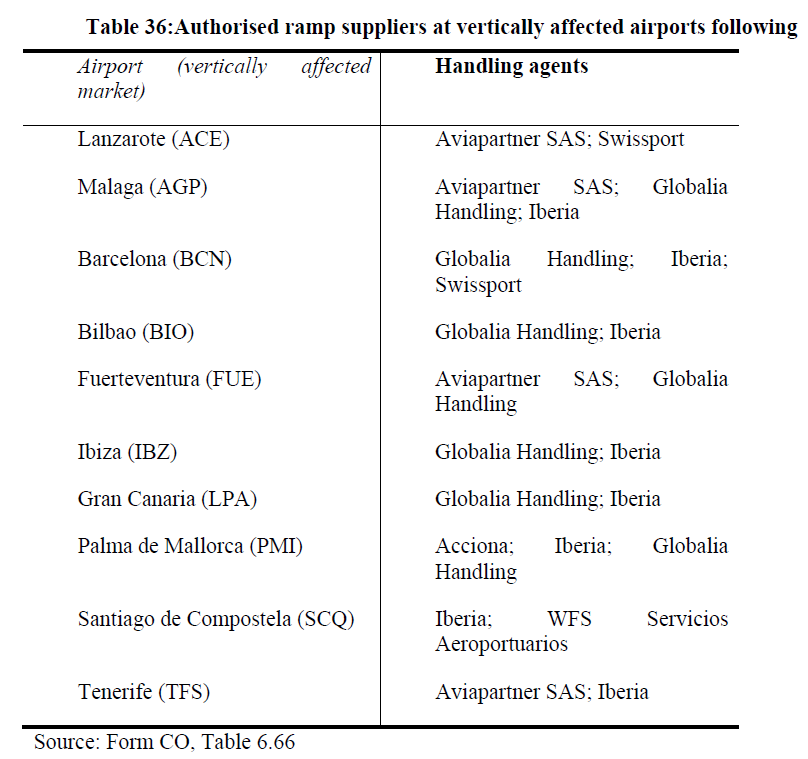
(530) In the Commission's market investigation, customers and competitors alike considered that the Transaction would have a neutral impact on the ground handling market in Spain.436 No substantiated competition concerns were raised by any competitor or customer.
(531) The Commission considers that ramp handling suppliers at Spanish airports have an obligation to provide all services requested by the carriers which are covered by the concession agreement.437 If a customer is not able to obtain the services from any of the suppliers at a given airport, AENA may impose on a supplier the obligation to provide the service at this airport.
(532) In addition, at each of the vertically affected airports (with the current exception of SCQ438) there will remain at least one alternative supplier of ground handling services and, following the implementation of the new concession agreement, there will be also be an alternative supplier at SCQ (WFS Servicios Aeroportuarios).
(533) Aer Lingus accounts for a maximum of [10-20%] of purchases of ground handling services at each Spanish airport at which it makes such purchases. Therefore, the Commission considers that the Transaction will not change IAG's current incentive to continue supplying its downstream rivals. For SCQ, at which there is currently no alternative ground handling supplier, Aer Lingus only accounts for [10-20%] of IAG's turnover. IAG would therefore still be incentivised to continue to supply the other [80-90%] of demand. Moreover, AENA recently announced that WFS Servicios Aeroportuarios will start to offer ground handling services at SCQ in 2015.
(534) Post-Transaction, IAG will also not have the ability to engage in customer foreclosure of other suppliers of ground handling services. Aer Lingus is a relatively small purchaser of ground handling services (a maximum of [10-20%], irrespective of the airport considered) and already obtains all of its third-party ground handling services from IAG (at each airport at which IAG offers such services). The Transaction would, therefore, not affect the ability that IAG would have to engage in a hypothetical customer foreclosure strategy.
(c) Conclusion
(535) In light of the above and of the available evidence, the Commission considers that the Transaction does not raise serious doubts as to its compatibility with the internal market with respect to the market for ground handling services under any plausible market definitions.
7. COMPETITIVE ASSESSMENT LANDSIDE CARGO HANDLING
(536) IAG supplies landside cargo handling services to third parties at BCN and MAD439 and Aer Lingus supplies landside cargo handling services to third parties at DUB and SNN440. Accordingly, the Transaction leads to no horizontal overlaps between the Parties.441
(537) The only vertically affected market for landside cargo handling is at BCN where Aer Lingus currently purchases landside cargo services from Swissport. IAG had an estimated share of [30-40%] of the total supply of landside cargo handling services at BCN in 2014, while Aer Lingus accounted for just [0-5%] of demand for third party landside cargo handling services. Post-Transaction, there will still be two strong suppliers of landside cargo services (Swissport and World Flight Services). These operators are part of larger multinational corporations and are, therefore, well placed to increase supply in the hypothetical event that, post-Transaction, IAG attempted to foreclose other airlines.
(538) Further, in 2014, IAG's turnover from landside cargo handling services at BCN was [CONFIDENTIAL] and Aer Lingus spent just [CONFIDENTIAL] on such services at BCN in 2014. The Transaction would, therefore, not affect any ability that IAG would have to engage in a hypothetical customer foreclosure strategy.
(539) In light of the above and of the available evidence, the Commission considers that the Transaction does not raise serious doubts as to its compatibility with the internal market with respect to the market for landside cargo handling services under any plausible market definitions.
8. COMPETITIVE ASSESSMENT MRO
(a) Horizontal relationships
(540) Table 37 provides a list of airports at which IAG provides MRO services442 to third parties.
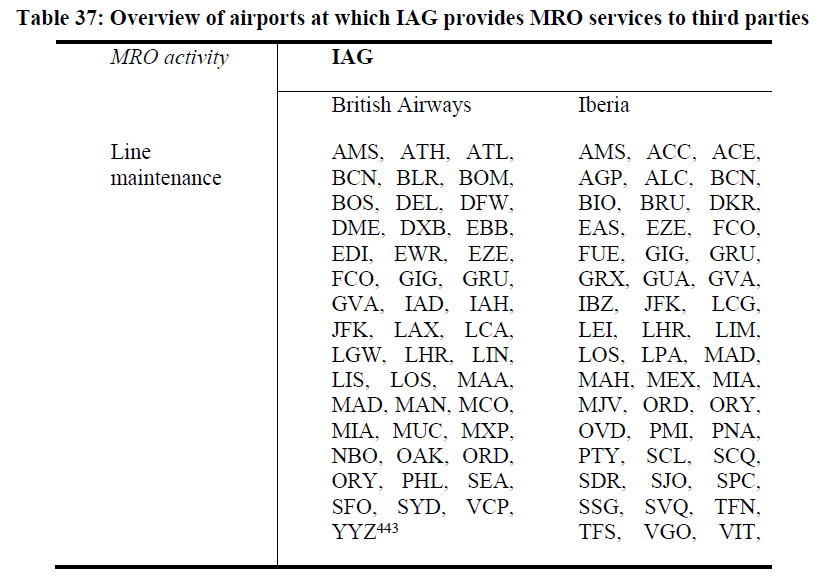
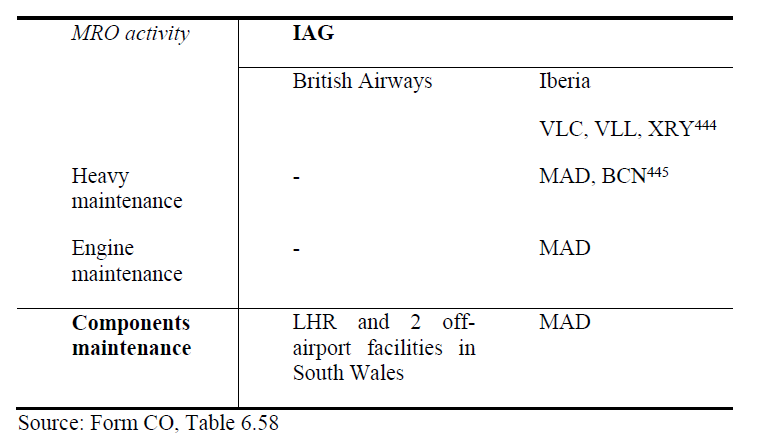
(541) Aer Lingus does not provide any MRO services to third parties. Therefore, the
Transaction does not give rise to horizontal overlaps in the MRO market segment.
(b) Vertical relationships
(542) Table 38 provides IAG's estimated market shares for the provision of heavy maintenance, engine maintenance and component maintenance at the national, EEA, and worldwide level.
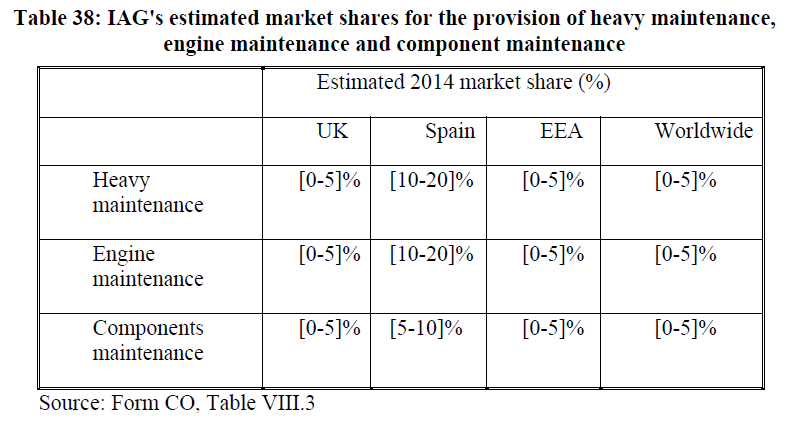
(543) As it can be seen in the table above, when looking at the national, EEA, and worldwide level IAG achieves its highest share for the provision of heavy maintenance, engine maintenance and component maintenance in Spain where it holds a share of [10-20%] for the provision of engine maintenance. Furthermore, the Parties submit that Aer Lingus' share of demand for such services is not such as to lead to vertically affected markets, be it at the national, EEA, or worldwide level.
(544) In addition, IAG does not provide heavy maintenance, engine maintenance or components maintenance to third parties at any airport at which Aer Lingus is a purchaser of such services. Therefore, at the individual airport level, which is the narrowest possible geographic market for these services, there are no vertical relationships between the air transport of passengers/cargo services provided by Aer Lingus, on the one hand, and the provision of heavy maintenance, engine maintenance, and components maintenance services provided by IAG, on the other.
(545) The Parties consider therefore that there are no affected markets in heavy maintenance, engine maintenance or components maintenance.446
(546) Table 39 lists the airports at which in 2014 (i) IAG provided line maintenance services to third parties; and (ii) Aer Lingus purchased such services (whether from IAG or a third party).
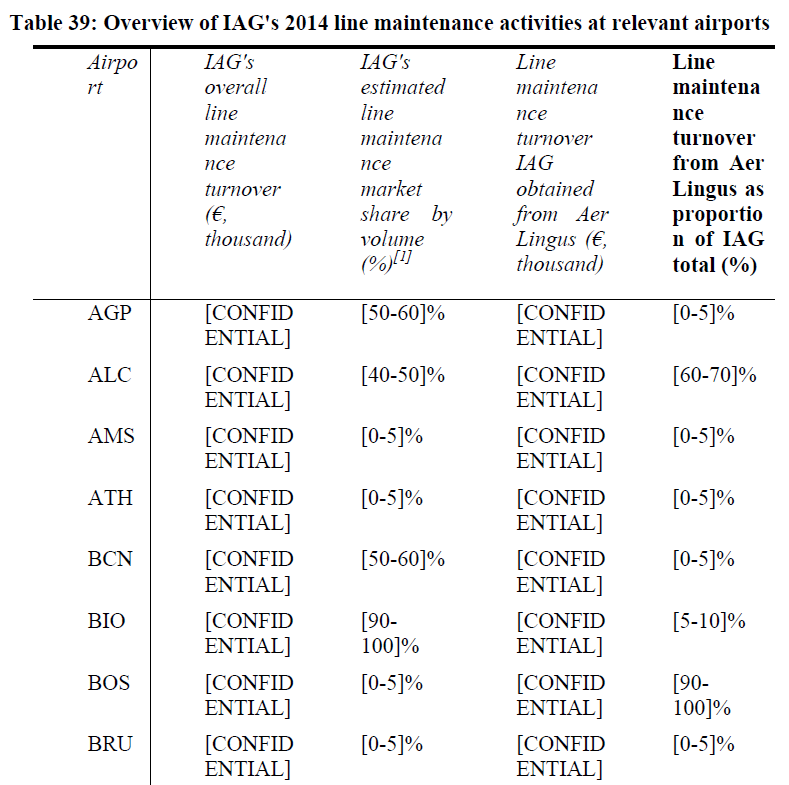
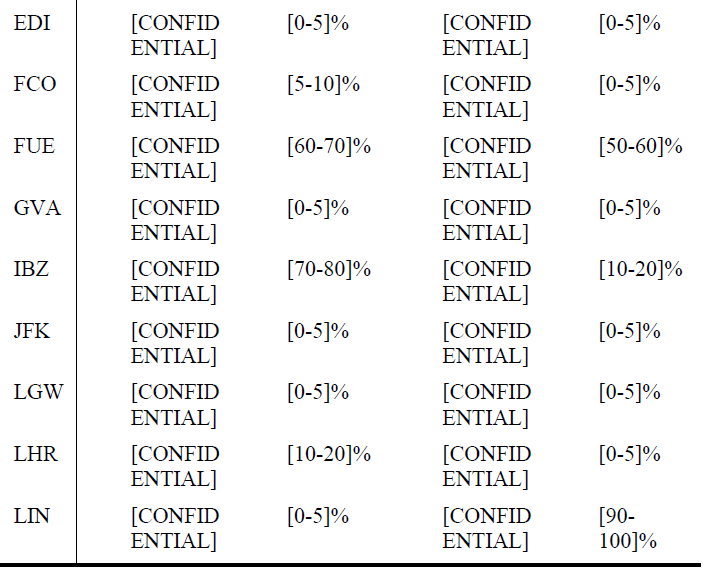
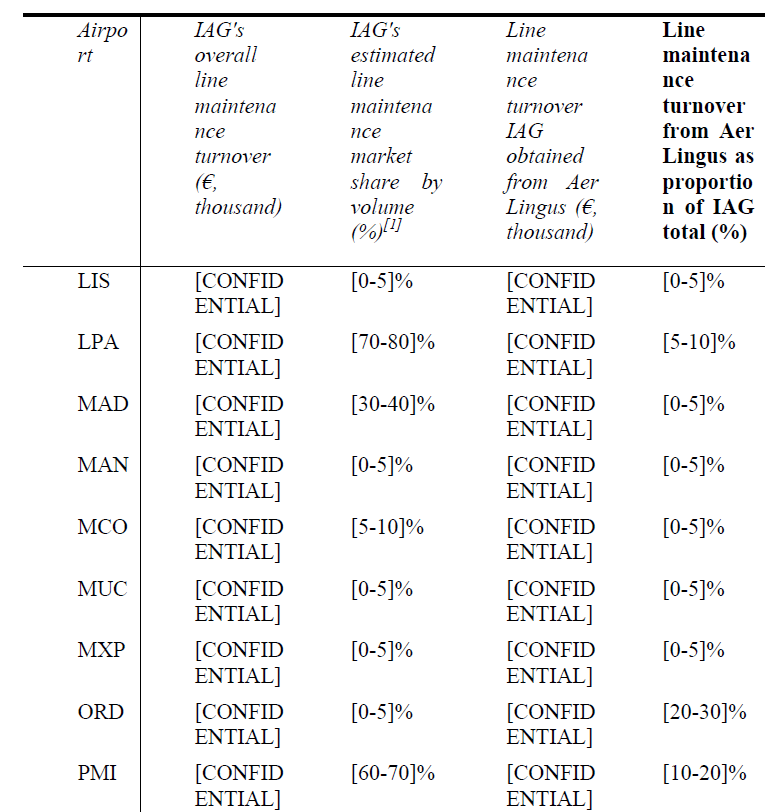

(547) If the narrowest geographic market definition is considered (i.e., the provision of line maintenance services at individual airports), vertically affected markets arise at the following airports: AGP, ALC, BCN, BIO, FUE, IBZ, LPA, MAD, PMI, SCQ, and TFS447.
(548) The Transaction is unlikely to raise input or customer foreclosure concerns at any of the vertically affected airports.
(549) The Transaction will not materially change IAG's incentives to restrict access for its competitors in the air transport sector to its line maintenance services. Aer Lingus represents only a small percentage of the demand at the vertically affected airports considering the limited number of flights it operates at these airports. Therefore, IAG will, still have the incentive to supply line maintenance services to third parties post-Transaction.
(550) Furthermore, even if IAG were to engage in input foreclosure it is unlikely that such strategy would adversely affect IAG's competitors. As it can be seen in Table 40 below, there are existing alternative suppliers of line maintenance services at each airport, with the sole exception of SCQ448, that could service IAG's competitors. In this respect, it must be noted that it is not mandatory for an airline to contract for line maintenance services at each airport to which it flies.
(551) In addition, if the market for line maintenance were to be considered regional in scope, there will be a number of alternative suppliers to IAG that could address the demand of its competitors for line maintenance services. Further, the existing third party providers of line maintenance services are well-placed to expand their current offering and/or to start offering services at additional airports (including SCQ449).
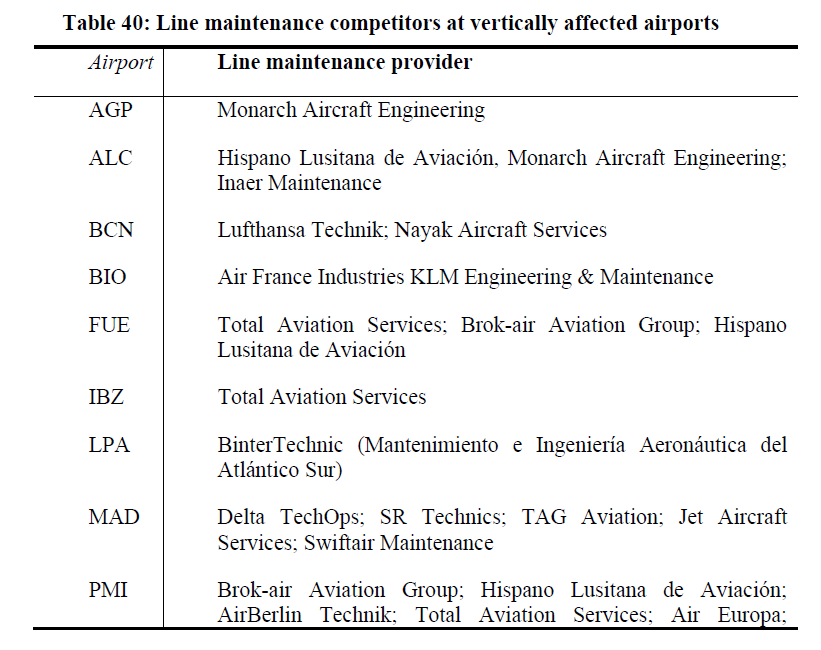

(552) As discussed above, Aer Lingus represents only a small percentage of the demand at the vertically affected airports therefore any customer foreclosure strategy by IAG would only have a limited impact on its competitors for the provision of line maintenance services.
(553) Respondents to the market investigation did not put forward any substantiated concerns in relation to MRO services.450
(554) In light of the above, the Commission considers that the Transaction does not raise serious doubts as to its compatibility with the internal market with respect to the market for MRO services under any plausible market definitions.
9. COMMITMENTS
9.1. PROPOSED COMMITMENTS
(555) In order to render the concentration compatible with the internal market, the undertakings concerned have modified the notified concentration by entering into the following commitments, which are annexed to this decision and form an integral part thereof.
(556) In order to address the serious doubts raised by the Transaction on feed traffic issues as well as on unilateral effects concerns on the Dublin–Chicago route, IAG submitted Special Prorate Agreements ("SPA") commitments on 24 June 2015.451 IAG submitted revised commitments on 28 June 2015. On 29 June 2015, the Commission launched a market test in order to gather the opinion of market participants.
(557) On 3 July 2015, to address the serious doubts raised by the Transaction on the unilateral effects on the London–Dublin and the Belfast–London routes, IAG submitted a revised remedy package, including slot commitments.452 On the same day, the Commission launched a market test in order to gather the opinion of market participants.
(558) Following the market tests, an improved final version of the commitments, encompassing both slot and SPA commitments) was submitted by IAG on 8 July 2015 (the "Final Commitments").
(559) The main aspects of the Final Commitments are summarised below.453
(a) The slot commitments
(i) Slot release on city pairs with competition concerns
(560) Under the Final Commitments, IAG commits to procure that slots are made available at London Gatwick to allow one or more Prospective Entrant(s) to operate up to five (5) new or additional daily Frequencies on the following city pairs (the "Relevant London-Irish City Pairs") as follows:
(a) two daily frequencies to/from Dublin; and
(b) one daily frequency to/from Belfast;
(c) with the remaining two (2) daily Frequencies to/from either Dublin or Belfast, or both.454
(ii) Conditions pertaining to the slots
(561) A prospective entrant shall be eligible to obtain slots from IAG only if it can demonstrate that it has exhausted all reasonable efforts to obtain the necessary slots to operate on the city pairs concerned through the normal workings of the normal slot allocation procedure. The prospective entrant shall be deemed not to have exhausted all reasonable efforts to obtain necessary slots if, inter alia, (a) slots at Gatwick were available through the general slot allocation procedure within 20 minutes of the times requested but such slots have not been accepted by the prospective entrant; or (b) slots at Gatwick were obtained through the normal slot allocation procedure more than 20 minutes from the times requested and the prospective entrant did not give IAG the opportunity to exchange those slots for slots within 20 minutes of the times requested; or (c) it has not exhausted its own slot portfolio at Gatwick.
(562) Slots will be released within 20 minutes (as relevant) of the time requested if IAG has such slots available. Otherwise, IAG must offer the slots closest in time to the request.
(563) However, IAG may refuse to offer any arrival slots at Gatwick after 23:30 (local time). If a prospective entrant requests an arrival slot at Gatwick after 23:30, IAG may offer a slot between 22:30 and 23:30 (local time). In addition, IAG shall not be obliged to release more than one (1) daily departure slot at Gatwick in any hour of the day (local time), i.e. no more than one (1) daily departure slot at Gatwick 06:00–07:00 (local time), no more than one (1) daily departure slot at Gatwick 07:00–08:00 (local time), etc. As an exception, in circumstances where no such departure slot has been granted or requested by any prospective entrant in the 06:00–08:00 (local time) period, two (2) departure slots may instead be requested in either the 08:00–09:00 (local time) period or the 09:00–10:00 (local time) period instead of one (1) in each of those two periods, provided that in circumstances where two (2) departure slots are so requested in the same such period: (a) the two such departure slots shall not be used on the same Relevant London-Irish City Pair; and (b) no more than one of the arrival slots at Gatwick released by IAG under the Final Commitments will be before 08:00 (local time).
(564) In the event that a prospective entrant requests departure slot timings which cannot be accommodated IAG shall offer the prospective entrant the next closest slot to the time requested. In addition, the five departure slots released by IAG should be spread throughout the day, including: no more than two slots in the period up until 12:00 local time, no more than two slots in the period after 12:00 and up until 16:00 local time, and no more than two slots in the period after 16:00 local time.
(iii) Grandfathering rights
(565) As a general rule, the slots obtained by a prospective entrant must be operated on the city pair(s) for which they have been requested from IAG and cannot be used on another city pair unless the prospective entrant has operated them during at least six full consecutive IATA seasons (the "Utilisation Period"). The prospective entrant would be deemed to have grandfathering rights for the slots once appropriate use of the slots has been made on the city pairs at issue, for the Utilisation Period. Once the Utilisation Period has elapsed, the prospective entrant will be entitled to use the slots obtained on the basis of the Final Commitments to operate services on any route connecting London with any other part of Europe (including the European Union, Iceland, Norway, Switzerland and the Channel Islands).
(566) During the Utilisation Period, the prospective entrant shall not be entitled to transfer, assign, sell, swap or charge in breach of the Final Commitments any slots obtained from IAG under the slot release procedure (except for changes to any such slots which are within the 20 minutes time window and which have been agreed with the slot coordinator). Provisions on misuse of slots also apply. In the event of a misuse, the prospective entrant shall have thirty days after such notice to cure the misuse, failure to which gives IAG the right to terminate the agreement and obtain restitution of the slots.
(iv) Consideration
(567) Since the slots released under the Final Commitments are at an airport where secondary trading takes place, the agreement with the prospective entrant may provide for monetary and/or other consideration, so long as such contractual provisions are clearly disclosed and comply with the Final Commitments and all other administrative requirements set out in the applicable legislation.
(b) The SPA commitments
(568) IAG commits that Aer Lingus would enter into SPAs with carriers which operate or will operate a non-stop service between the airports of Heathrow, Gatwick, Manchester, Amsterdam Shannon and/or Dublin (the "Relevant Airport Hubs") to certain long haul destinations identified in the Final Commitments. The SPAs will be applied to short-haul routes between certain airports in the island of Ireland (Belfast, Cork, Dublin, Knock and/or Shannon, the "Relevant Irish Airports") on the one hand, and London Heathrow, London Gatwick, Manchester and/or Amsterdam on the other hand. With respect to feeder routes to/from Shannon and/or Dublin, the SPAs will be applied to short-haul routes from/to airports in Europe from/to which Aer Lingus operates frequency to/from Shannon or Dublin (as relevant) at the time of an application for an SPA under the Final Commitments, and which continue to be so operated by Aer Lingus whilst the relevant SPA is in force.
(569) The Final Commitments relating to SPA will allow carriers currently receiving significant feed from Aer Lingus to continue to do so post-Transaction. Furthermore, they will also support new services to Chicago ex-Dublin by granting to the potential entrant(s) Aer Lingus' feed.
(570) IAG commits to procure that Aer Lingus would enter into an SPA with non oneworld airlines which provide or will provide a non-stop service between the Relevant Hub Airport and the following long-haul destinations (together, the "Relevant Long-Haul Destination/Origin Cities"):
i. from/to Heathrow to/from: Boston (BOS), Chicago (ORD), Houston (IAH), Los Angeles (LAX), Miami (MIA), New York (EWR and JFK), San Francisco (SFO), Washington (IAD), Calgary (YYC), Montreal (YUL), Toronto (YYZ), Vancouver (YVR), Hong Kong (HKG), Seoul (ICN), Shanghai (PVG), Singapore (SIN), Tokyo (NRT), Riyadh (RUH), Tel Aviv (TLV), Cape Town (CPT), Johannesburg (JNB) and Sydney (SYD);
ii. from/to Gatwick to/from: Las Vegas (LAS), Orlando (MCO), Cancun (CUN) and Bridgetown (BGI);
iii. from/to Manchester to/from: Las Vegas (LAS), Orlando (MCO) and Bridgetown (BGI);
iv. from/to Amsterdam to/from: Abu Dhabi (AUH), Doha (DOH), Dubai (DXB), Bangkok (BKK), Beijing (PEK), Hong Kong (HKG), Tokyo (NRT), Singapore (SIN), Cairo (CAI), Lagos (LOS), Johannesburg (JNB), Rio de Janeiro (GIG), São Paulo (GRU), Toronto (YYZ) and Vancouver (YVR);
v. from/to Shannon to/from: Chicago (ORD);
vi. from/to Dublin to/from: Chicago (ORD).
(571) The Final Commitments define a "Hub" as an airport at which an airline, airline joint business and/or Alliance operates long-haul and/or short-haul air passenger transport services and where there are a material number of connections between such services. The wording captures in an appropriate manner airports which involve material numbers of long-haul to long-haul connections (such as are sometimes operated by e.g. Gulf carriers) or material numbers of short-haul to short-haul connections (as are sometimes operated by e.g. US carriers).455
(572) In addition, the SPA will apply to up to 5 Aer Lingus-operated short-haul services between Shannon and certain points in Europe (the "Relevant Short-Haul Origin/Destination Cities") for the requesting airline non-stop services operated to/from Shannon to/from Chicago.
(573) Further, the SPA will apply to up to 20 Aer Lingus-operated short-haul services between Dublin and certain points in Europe (the "Relevant Short-Haul Origin/Destination Cities") for the requesting airline non-stop services operated to/from Dublin to/from Chicago. This commitment is meant to address the serious doubts of the Commission on the unilateral effects on the Dublin–Chicago route, by ensuring support for new third party services on this route until they are established.
(574) With respect to feeder routes to/from London Heathrow, London Gatwick, Manchester, and/or Amsterdam, the SPA will apply to Aer Lingus' frequencies operated during the winter 2014 and the summer 2015 IATA seasons. The number of frequencies shall be increased if, after the date of adoption of this decision, Aer Lingus operates additional frequencies on the relevant feeder route. The number of frequencies shall be decreased if, after the adoption of this decision, Aer Lingus operates fewer frequencies on the relevant feeder route, unless another airline within IAG increases its frequencies on the same feeder route in a given timeframe set out in the Final Commitments. In this case, the SPA will apply to the increased frequencies of the other airline belonging to IAG.
(575) The Final Commitments envisage certain restrictions as regards the eligibility of the requesting carrier. To be eligible, a requesting carrier should not be a member (or affiliated to a member of) of the oneworld alliance and should not have a hub at both ends of the Relevant Long-Haul Destination/Origin City for which it would be requesting feed.
(576) The requesting airline may also select the fare class(es) to which the SPA will apply, provided that each selected fare class is included in at least one existing special prorate agreement which Aer Lingus has agreed and applied with any other carrier for the same feeder route between the Short-Haul Origin/Destination City and the Relevant Airport Hub to provide feeder traffic for the same Long-Haul Airport Pair (subject to certain exclusions).
(577) Its terms would also have to be at least as favourable as those included in any special prorate agreements that Aer Lingus has in place with any other carrier for the same feeder route between the Relevant Short-Haul Origin/Destination City and the Relevant Airport Hub to provide feeder traffic for the same Long-Haul Airport Pair and in the same fare class (subject to certain exclusions).
(578) In addition, the SPA would grant the requesting carrier equivalent inventory access to that given by Aer Lingus under existing special prorate agreement with any other carrier for the same feeder route between the Relevant Short-Haul Origin/Destination City and the Relevant Airport Hub to provide feeder traffic for the same Long-Haul Airport Pair and in any event no worse than as between Aer Lingus and other IAG carriers.
(579) Any term included in the SPA (for example, rates and interline service charge, number of fare and booking classes included) can never be less favourable than the corresponding term in any special prorate agreement which Aer Lingus on the one part, and the requesting airline on the other part, have in place at the date of adoption of this decision (subject to certain exclusions).
(580) Aer Lingus may exclude any existing special prorate agreement which it has with any other carrier which it would be unreasonable to include, for example because de minimis or obsolete.
(581) Special provisions relate to an SPA which provides for Straight Rate Prorate terms456.
(582) The SPA shall have an effective duration of up to five years at the choice of the requesting carrier. Thereafter, the requesting carrier shall have the right to renew the agreement on an evergreen basis for further periods of up to two years (i.e. rolled over on the same terms) if certain conditions are met.
(583) With respect to the commitments relating to the provision of feed onto Dublin– Chicago services, any SPA may be terminated by Aer Lingus if the recipient carrier is operating an effective service.
(c) Other provisions
(584) IAG also committed to enter, at the request of an airline which started to operate new or increased services on any of the city pairs concerned by the slot commitments (whether or not such service uses slots released to that carrier pursuant to the Final Commitments), an agreement that arranges for fare combinability on the Relevant London-Irish City Pair. This agreement provides for the possibility for the airline concerned, or travel agents, to offer a return trip on the Relevant London-Irish City Pair comprising a non-stop service provided one way by IAG and a non-stop service provided the other way by the airline at issue.
(585) At the request of a carrier wishing to operate new or increased services on any of the routes concerned by the slot commitments that does not have a comparable frequent flyer program ("FFP") of its own, IAG would allow it to be hosted in its FFP for the relevant city pair(s) on which it has commenced or increased service. This would mean that the requesting airline may participate to IAG's FFP on equal terms as compared to other members of the oneworld alliance, and the requesting carrier's customers may accrue points (but also benefit from other services such as airport lounge access or priority bookings).
(586) A Monitoring Trustee will be appointed by Aer Lingus to monitor the correct execution of the Final Commitments, subject to previous approval by the Commission. The Monitoring Trustee will be independent of the Parties and all other members of the oneworld Alliance. Aer Lingus shall provide the Monitoring Trustee with such assistance and information, including copies of all relevant documents, as the Monitoring Trustee may reasonably require in carrying out its mandate. In particular, the Monitoring Trustee would have full and complete access to Aer Lingus' books, records, documents, management or other personnel facilities, sites and technical information necessary to fulfil its duties under the Final Commitments.
(587) The Final Commitments also contain provisions on fast-track dispute resolution according to which the new entrant can decide to settle any dispute with the Parties through arbitration. In the event of disagreement between the parties to the arbitration regarding the interpretation of the Final Commitments the arbitral tribunal shall seek the Commission's interpretation and shall be bound by that interpretation. Both the parties to the arbitration will then be bound by the decision of the arbitral tribunal.
9.2. ASSESSMENT OF THE FINAL COMMITMENTS
(588) As set out in the Commission Notice on Remedies,457 the Commission assesses the compatibility of a notified concentration with the internal market on the basis of its effect on the structure of competition in the European Union. Where a concentration raises serious doubts which could lead to a significant impediment to effective competition, the Parties may seek to modify the concentration so as to resolve the serious doubts identified by the Commission with a view to having the concentration cleared.
(589) According to the European Union Courts' case law, commitments must be likely to eliminate all competition concerns identified and ensure competitive market structures. The Commission enjoys a broad discretion in assessing whether commitments offered before the opening of proceedings constitute a direct and sufficient response capable of dispelling any serious doubts about the proposed merger.
(590) In assessing whether or not the commitments will maintain effective competition, the Commission considers inter alia the type, scale and scope of the remedies offered by reference to the structure and the particular characteristics of the market in which the Commission's serious doubts as to the compatibility of the Transaction with the internal market arise. It should be emphasised, however, that commitments offered prior to the initiation of proceedings can only be accepted when the competition problem that the concentration gives rise to is readily identifiable and can easily be remedied.
(591) Concerning the suitability of commitments aiming at facilitating entry of a new competitor, the Commission Notice on Remedies states that "[o]ften, a sufficient reduction of entry barriers is not achieved by individual measures, but by [...] a commitments package aimed at overall facilitating entry of competitors by a whole range of different measures".
(592) In airline cases, commitments are acceptable to the Commission where it is sufficiently likely that actual entry by new competitors will occur and where such entry would eliminate any serious doubts as to the compatibility of the concentration with the internal market. In this respect, account must be taken of the facts existing at the time when the decision is adopted and not in the light of subsequent events.458
(593) The Commission considers that the Final Commitments constitute a comprehensive package which takes into consideration past experience with commitments in merger cases in the aviation sector.
(594) For the reasons set out below and on the basis of the available evidence, the Commission has concluded that the Final Commitments address the serious doubts identified in this decision. As such, the Commission comes to the conclusion that the Final Commitments offered by IAG are sufficient to eliminate any serious doubts as to the compatibility of the Transaction with the internal market.
(a) The slot commitments
(595) In airline cases, slot release commitments are acceptable to the Commission where it is sufficiently clear that actual entry by new competitors that would eliminate any significant impediment to effective competition will occur. For such commitments to be acceptable, the notifying party need not identify a precise new entrant if competitors express an interest during the administrative procedure in entering the markets concerned in view of the proposed commitments.
(596) The Final Commitments relating to slots are based on the fact that the severely limited slot availability at Gatwick is an important entry barrier on the routes where competition concerns have been identified. Therefore, the Final Commitments are designed to remove (or at least reduce significantly) this barrier and foster sufficient, timely, and likely entries on the above-mentioned routes.
(597) It is important to note first that, given the significant level of congestion at Gatwick, slots are intrinsically attractive. In addition, the Final Commitments make entry interesting due to the prospect of acquiring grandfathering rights after six IATA seasons.
(598) The total number of five daily frequencies offered for both the Relevant London-Irish City Pairs was considered sufficient by a majority of all respondents to the market test. 459.The earmarked frequencies per route and the flexible frequencies that may be allocated between the two routes, were also considered sufficient to enable effective entry on the Relevant London-Irish City Pairs by a majority of all respondents to the market investigation.460 One competitor that did not manifest its interest in entering noted however that "5 flights per day are around 14% of the total flights from IAG and Aer Lingus which should be sufficient".461
(599) A majority of all respondents expressing an opinion also thought that the fare combinability commitment on the Relevant London-Irish City Pairs increases the likelihood that entry will take place on both the London–Dublin and Belfast–London routes.462 A majority of all respondents expressing an opinion also stated that they thought that the frequent flyer programmes commitment on the Relevant London-Irish City Pairs increases the likelihood that entry will take place on both the London– Dublin and Belfast–London routes.463
(600) Overall a majority of all respondents expressing an opinion considered that the commitments proposed by IAG clearly eliminated the competition concerns raised by the proposed Transaction on the London–Dublin route.464 In the same vein, a majority of all respondents expressing an opinion considered that the commitments proposed by IAG clearly eliminated the competition concerns raised by the proposed Transaction on the Belfast–London route.465
(601) Some competitors stated that the number of frequencies would be sufficient provided however that slots are secured at convenient times. In this respect, some criticism was expressed as regards the fact that initially, IAG was not obliged to release more than one departure slot in any hour of the day.466 These concerns have been appropriately addressed in the Final Commitments, where a greater flexibility has been introduced as regards the release of departure slots in the early morning, through Clauses 2.7 and 2.8. In this respect, the Final Commitments respond to evidence from the market investigation that, to enable a prospective new entrant to mount a competitive schedule, in particular as regards time sensitive passengers, early departure flights are crucial.
(602) Respondents to the market investigation confirmed that Gatwick is a very congested airport, specifically for movements at peak times which are very useful for carriers also wishing to address the needs of time-sensitive passengers.467 Consequently, given the level of congestion, the slot commitments offered by the Final Commitments appear particularly suitable to appeal prospective new entrants.
(603) Indeed, it appears unlikely that (absent the possibilities afforded by the Final Commitments) any prospective new entrant could obtain all the slots necessary to operate the above-mentioned routes to/from Gatwick with a sufficient number of frequencies from the first IATA season. In addition, a new entrant at Gatwick would have no guarantee of obtaining the slots at the most appropriate times, allowing for an optimised level of rotation of aircraft. By contrast, the slot allocation mechanism in the Final Commitments ensures that the prospective new entrant will be likely to receive the requested slots in a time window of +/?20 minutes.
(604) In this context and as also argued by the Parties,468 limiting the departures to no more than one an hour does not undermine any prospective entrant's ability to operate a viable new or expanded schedule from Gatwick: in the summer 2015 IATA season, Aer Lingus does not operate more than one departure in any given hour from Gatwick to Dublin or Belfast. 469 In the summer 2015 IATA season, Aer Lingus' departures from Gatwick are typically approximately 2–4 hours apart for Dublin and Belfast. Both Ryanair's departures from Gatwick to Dublin and easyJet's departures from Gatwick to Belfast are never less than 2 hours apart.
(605) As an exception to the general position of no more than one slot per hour, Clause 2.7 of the Final Commitments provides that where no departure Slot has been granted or requested by any Prospective Entrant in the 06:00–08:00 (local time) period, two departure slots may instead be requested in either the 08:00–09:00 (local time) period or the 09:00–10:00 (local time) period instead of one in each of those two periods. This exception is subject to two conditions: (a) the two such departure slots shall not be used on the same Relevant London-Irish City Pair; and (b) no more than one of the arrival slots at Gatwick released by IAG under the Final Commitments will be before 08:00 (local time).
(606) The exception ensures that there is enough flexibility to accommodate the needs of competitors' desiring to enter with a morning flight from Gatwick to either Dublin or London while maintaining an overall balanced approach in terms of availability and flexibility of slots.
(607) It is also appropriate, as submitted by the Parties,470 to limit arrival slot requests to before 23:30. At present, only BA lands at Gatwick after 23:30. However, these services are never from the island of Ireland and are an important feature of BA's overall aircraft rotation at Gatwick. In the summer 2015 IATA season, the latest arrival from either Dublin or Belfast to LGW is 21:45 (easyJet on BFS–LGW). Looking across all London airports, in the summer 2015 IATA season the latest arrival was at 23:05 (EasyJet on BFS–LTN and Ryanair on DUB–LTN).
(608) Moreover, Clause 2.28 of the Final Commitments ensures that departure slots to be released at Gatwick are spread throughout the day. This provision applies to each of London–Dublin and Belfast–London separately, so that sufficient time slots would be available for both routes. A majority of all respondents to the market test expressing an opinion stated that this clause did not constitute a material barrier to entry for both routes.471
(609) The possibility for carriers to pay a consideration for the slots offered by IAG does not reduce the attractiveness of the slots or preclude their award to the best applicants. Indeed, the possibility to offer consideration for the slots is not an obligation, but rather an option that carriers may use in order to have a chance to obtain the slots in the event that, following the Commission's evaluation, several applicants are deemed to provide similarly effective competitive constraints on services from/to Gatwick.
(610) In responding to the market test, some carriers expressed their interest to take the slots offered by IAG to operate air services on the London–Dublin and Belfast–London routes in a timely manner (i.e. within the next 4–6 IATA seasons). Some conditions to their entry were expressed. However, a significant portion of these conditions have been included in the Final Commitments, when relevant. In particular, the need for some flexibility relating to early morning slots at London Gatwick has been appropriately addressed.
(611) Aer Lingus' Strategy Document relating to the Ireland to London Market 2013-2015 describes Gatwick as follows: "Gatwick is London’s second busiest airport and in the World’s top ten busiest airports, with almost 34 million passengers passing through the airport in 2012. The airport hosts both short haul point-to-point carriers such as easyJet and Ryanair and leisure long haul services primarily operated by British Airways and Virgin Atlantic. Recent years have reported growth in long haul services with the entry of additional carriers including Emirates, Vietnam Airlines and Air China."472
(612) Gatwick (and also London City airport which is not generally slot-constrained) exerts a competitive constraint on Heathrow473. On the two routes where remedies are proposed, a significant share of time-sensitive passengers also embark at Gatwick airport.474 Both airports have a large overlap in terms of catchment area and are well connected to London's city centre (see Sections IV.2.4. and V.5).
(613) Especially for time-sensitive passengers, the Final Commitments will allow entrants to offer services from Belfast and Dublin to Gatwick that will be a suitable alternative: competitors will be able to offer competing services to Gatwick, including in the early morning and the evening peak hours on both of these routes, which are especially important for time-sensitive passengers.
(614) Given that in recent years, time-sensitive passengers have increasingly elected to fly with low cost carriers, which in turn have complemented their offering by packages tailored to the needs of time-sensitive passengers, the Final Commitments could potentially be taken up by low cost carriers as well as by full-service carriers.
(615) Therefore, the Commission is of the view that the slot commitments will be likely to lead to the provision of additional services by independent carriers on Dublin– Gatwick and Belfast–Gatwick.
(616) Considering the specific characteristics of the routes, and the nature of the likely entrants, the existing services on each of the Dublin–London 3475 and Belfast– London 3476 routes, as significantly reinforced by these additional services, will be likely to provide sufficient competition to prevent the Parties from increasing fares on their own services on the two routes at stake post Transaction.
(617) In light of the above, and on the basis of the information available to the Commission, in particular considering the interest demonstrated by competitors, it is concluded that the slot commitments (which are further strengthened by the other provisions of the Final Commitments) lead to likely entry by one or more airlines on the London– Dublin and Belfast–London routes in a timely manner, and that this entry is of a sufficient magnitude to dispel the serious doubts identified on these routes.
(b) The SPA commitments
(618) Overall, a majority of respondents to the market test agreed that that the SPA commitments – in the version that has been market tested – appropriately address the risk that IAG might provide significantly less feeder traffic following the Transaction, thus affecting the competitive constraint exerted on it by competitors on certain long-haul routes.
(619) However, several competitors questioned the effectiveness and ability of the SPA commitments to address the concerns raised by the Commission in a full and comprehensive manner.
(i) Routes and hubs covered by the SPA commitments
(620) Some competitors considered that the scope of the SPA commitments should be broadened to include additional long-haul routes, short-haul "feeder" routes, and connecting hubs.
(621) The Commission considers that the scope of the SPA commitments is sufficient to address the serious doubts raised by the Transaction as regards a possible foreclosure strategy undertaken by IAG post-Transaction in relation to feeder traffic. Indeed, as a consequence of this commitment, IAG would have to enter into SPAs with competing carriers in relation to the long-haul routes for which a risk of foreclosure has been identified.
(622) Pursuant to the SPA commitments, IAG commits to procure that Aer Lingus shall carry connecting passengers on all routes from/to Dublin, Belfast, Cork Shannon and Knock for passengers connecting at Heathrow, Gatwick, Manchester and Amsterdam, as well as on up to 20 routes for passengers connecting at Dublin, and up to 5 routes for passengers connecting at Shannon, among those routes operated by Aer Lingus at the time of the application for an SPA under the Final Commitments. These routes are all those for which a foreclosure risk was identified.
(623) Moreover, the fare classes included in the SPA would, at the applicant's request, cover all the fare classes included in any commercially negotiated SPAs entered into by Aer Lingus with any other carrier to provide feed to the Relevant long haul Destination/Origin Cities prior to the Transaction. This would allow the applicants to benefit from feeder traffic arrangements with the same scope as those previously entered into with Aer Lingus, and will prevent IAG from reducing the feeder traffic previously provided to the applicants by Aer Lingus for its services on the long-haul routes of concern.
(624) Moreover, the terms of the SPA would have to be at least as favourable as the terms of any similar agreement between Aer Lingus and any other carrier at the date of the request and the terms of any similar agreement between Aer Lingus and any other carrier existing at the date of adoption of the present decision, subject to reasonable indexation. This would prevent IAG from unduly raising the cost of access to its flights on the routes previously operated by Aer Lingus for passengers connecting at Heathrow, Gatwick, Manchester, Amsterdam and Shannon onto flights operated by the carriers that could potentially be targeted by foreclosure on the long-haul routes of concern.
(625) As regards the list of long-haul routes included in the scope of the SPA commitments, some competitors that replied to the market test called for the inclusion of additional routes or for open-scope commitments. In particular, competitors that replied to the market test also asked for the inclusion of long-haul routes ex-Amsterdam. Some of these long-haul routes have been added by IAG in the Final Commitments, including routes ex-Amsterdam, which has been added to the list of connecting hubs to which the SPAs commitments apply. For the other routes that have not been included, the Commission verified that they did not meet the passenger feed thresholds above which it considers that foreclosure concerns might arise.477
(626) As concerns the request for open-scope commitments, following the market test, Aer Lingus provided additional information indicating that its SPAs and interline relationships are constantly reviewed to determine whether they benefit Aer Lingus as a result of the reciprocity inherent in commercially negotiated SPAs. In particular, partnerships are evaluated at the time Aer Lingus enters into an SPA but are also under review each year as SPAs are generally renegotiated on a yearly basis. [Aer Lingus business strategy].
(627) Moreover, the Parties argued that the SPA commitments are designed to address the merger-specific effects of the current Transaction. The SPA commitments therefore provide for feed on the Relevant Long-Haul Destination/Origin Cities on the basis described above. It would move beyond the merger-specific effects of the Transaction if the SPA commitments allowed Eligible Air Services Providers (including those which may already have an SPA relationship with Aer Lingus) to cover feed onto any long-haul service they may choose to commence from a Relevant Airport Hub (i.e., one not affected by the Transaction).
(628) The Parties also described Aer Lingus' open network architecture as follows: "Aer Lingus does not currently, and has not previously, operated a freely open SPA structure. The concept of open network architecture reflects its current policy as an independent carrier to partner across the various alliances with a diverse range of partners offering connectivity through major hubs to worldwide destinations. It is however still selective in its partnerships and decides on a case-by-case basis whether an agreement is or continues to be commercially viable. Whilst there is some logic (and precedent) for requiring Aer Lingus to conclude SPAs with respect to feed for identified routes which have, prior to the Transaction, received (albeit often low levels) of feed from Aer Lingus, it is a significant extension to require Aer Lingus to conclude – in perpetuity – SPA arrangements for any services which a competitor may launch from a Relevant Airport Hub. This is particularly concerning where Aer Lingus may wish – and as part of realising the transaction synergies for the first time be able – to grow its own network but instead be forced to feed third party services."478
(629) In light of the above and of all other available evidence, the Commission considers that it is not appropriate to provide for open-scope commitments, as this would not be consistent with Aer Lingus' current policy towards such agreements and therefore with the likely competitive situation absent the Transaction.
(630) As regards the list of short-haul routes included in the scope of the SPA commitments, various competitors that replied to the market test called for the inclusion of additional routes. Routes from Knock airport have been included by IAG in the scope of the Final Commitments. The list of "feeder routes" has otherwise been considered appropriate by a majority of respondents to the market test. The limitation of the SPA commitment to 20 and 5 "feeder routes" to/from Dublin and Shannon respectively was also considered as appropriate by a majority of respondents to the market test.
(631) Finally, as regards the choice of connecting airports, some competitors asked for the SPA commitments not to be limited to specific connecting airports. However, the SPA commitments aim at addressing a risk of foreclosure of access to flights to/from specific connecting hubs, and not serious doubts on direct/indirect or indirect/indirect overlap routes (which have been separately assessed and ultimately excluded by the Commission). Furthermore, contrary to the claims of certain competitors who responded to the market test, the risk of switching by IAG of certain long-haul routes from Heathrow to Gatwick, or vice versa, would not lead to possible circumvention of the SPA commitments, as the list of long-haul routes receiving feed is based on the operations of third party services from these airports, and not on IAG's operations.
(632) Some competitors that replied to the market test also requested that the SPA commitments should apply across the operations of the Parties (and their joint venture partners, including IAG) so as to deter attempts at circumventing the commitments by IAG. However, the Commission is of the view that the extension of the SPA commitments to IAG would not be justified in the present case, as the Transaction leads to no material merger-specific effects when considering IAG's current agreements. The only instance where IAG's operations have been considered relevant for the SPA commitments relates to the number of frequencies of the feeder routes to which the SPA would apply.
(633) With respect to the feeder routes to/from Heathrow, Gatwick, Manchester and/or Amsterdam, the SPA commitments apply to the frequencies operated by Aer Lingus during the winter 2014/2015 and the summer 2015 IATA season. The number of frequencies in a given IATA season should be increased if after the adoption of this Decision Aer Lingus increased its frequencies on the relevant feeder route. The same would apply in case of reduced frequencies by Aer Lingus, unless another IAG-owned carrier increases its frequencies on the relevant feeder route less than two IATA seasons before or after Aer Lingus reduces its frequencies. In this case, the SPA commitments apply to the increased frequencies of the IAG-owned carrier. In the Final Commitments the relevant time to consider IAG's frequencies increase as linked to Aer Lingus's frequencies reduction has been increased from one to two years to address the concerns expressed by some competitor during the market test.
(634) In addition, some competitors argued that this provision would not cover the risk of reduction in capacity by Aer Lingus, which may also lead to circumvention of the SPA commitments by the Parties. Aer Lingus has fleet commonality with IAG, with a short-haul fleet of A320 aircraft and a long-haul fleet primarily of A330 aircraft.479 Hence, the Commission is of the view that the impact of such a risk of circumvention through capacity changes on short-haul routes would be insignificant. In addition, maintaining flexibility when adjusting capacity to respond to fluctuations in demand is common in the industry.480
(635) Finally, the Commission notes that pursuant to the SPA commitments, an SPA is concluded for up to 5 years and can be renewed upon request of the requesting carrier on an evergreen basis for further periods of up to two years. It can thus address the risks of foreclosure on a long-lasting basis.
(636) Overall, the Commission considers that the above-mentioned concerns relating to the scope of the routes and connecting hubs included in the SPA commitments have been comprehensively addressed by IAG in the Final Commitments, insofar as the SPA commitments apply to all long-haul and feeder routes that have been identified as potentially causing foreclosure concerns.
(ii) Exclusion of codeshare terms
(637) Aer Lingus may exclude, inter alia, "any codeshare or interline terms within an existing codeshare related agreement" from the relevant basket of agreements to be benchmarked in order to grant the requesting carrier terms which are at least as favourable as the terms agreed and applied by Aer Lingus under an existing SPA with any other carrier for the same feeder route between the Relevant Short-Haul Origin/Destination City and the Relevant Airport Hub to provide feeder traffic for the same Long-Haul Airport Pair.
(638) A majority of the respondents to the market test who expressed a view agreed that the exclusion above is appropriate.481
(639) During the market test, several competitors also argued that the Commission should impose on the Parties the maintenance of Aer Lingus' current codeshare agreements which have a broader scope and allow for more flexibility in terms of routes covered. Furthermore, one competitor claimed that the use of the terms in the codeshares currently existing between BA and Aer Lingus would be appropriate.
(640) However, the Commission is of the view that these competitors' demands regarding the maintenance of codeshare agreements would lock in Aer Lingus in a situation that is unlikely to prevail absent the Transaction. Moreover, the SPA commitments are designed to compensate for the merger-specific loss of competition, not to lock in Aer Lingus in commercial agreements that may soon need to be overhauled in a fast-changing business environment.
(641) Considering the above, the Commission is of the view that it is appropriate to exclude the conditions, and specifically the rates, offered by Aer Lingus to its codeshare partners under codeshare agreements from the relevant basket of agreements to be benchmarked under the SPA commitments. These agreements are indeed based on deeper commercial partnership and offer more beneficial terms than a normal special prorate agreement and thus it would be unreasonable and disproportionate to include them in the basket.
(iii) Inventory access and other issues
(642) In its assessment of feed traffic issues, the Commission has identified possible risks of restriction of access to feeder traffic even if an SPA is in place, in particular though punctual restrictions to seat inventories via revenue management systems.
(643) During the market test, one competitor argued that the SPA commitments lack clarity regarding group rates and booking numbers and terms which are unwritten but agreed in practice. However, Aer Lingus does not currently have any provisions for group bookings in its SPAs with third party airlines.482 Therefore, the Commission considers that it is adequate that no provision is made for group bookings in the Final Commitments. As regards ticketing terms, the Parties argue that practices concerning Ticketing Time Limits ("TTLs") are universally applied by carriers for their and SPA partners bookings and there is not, therefore, any discrimination between carriers. In any event, the Commission notes that the SPA commitments provide that any TTL applied to bookings made under any SPA entered into pursuant to the SPA commitments shall be no less favourable than the TTLs applied by Aer Lingus to any other bookings made on the applicable Aer Lingus-operated routes.
(644) Two competitors also emphasized the need for a mechanism aimed at ensuring that commitments on equivalent inventory access are adhered to.
(645) The Commission considers that the Final Commitments address this concern to a sufficient extent. First of all, Aer Lingus is obliged, in the context of an SPA entered into pursuant to the Final Commitments, to grant the applicant equivalent inventory access to that given within IAG. In addition, it shall not deconcur the other party to a SPA from routes and fare classes covered by that agreement. Undue restriction or discriminatory access to its seat inventory would thus be a breach of the Final Commitments on the part of Aer Lingus.
(646) Moreover, the Monitoring Trustee, whose role was considered adequate to ensure the effective implementation of the Final Commitments by a large majority of respondents to the market test483, will have full and complete access to Aer Lingus' books, records, documents, management or other personnel facilities, sites and technical information necessary to fulfill its duties. The Monitoring Trustee will thus be in a position to detect conduct such as discriminatory access to seat inventories, if it receives reasoned complaints by any third party carrier. The detection of such noncompliance would expose Aer Lingus to sanctions.
(647) In addition, while the SPA commitments are largely similar to a commitment made legally binding on IAG in 2012 in the context of the IAG/bmi decision, the Final Commitments would apply to Aer Lingus' inventory access and not to BA's. The Parties note that the rates and inventory access contained in the existing SPAs which Aer Lingus has negotiated with third party carriers pre-merger reflect Aer Lingus’ commercial requirements particularly the need to prioritise traffic on its own long-haul network. As such, the commercial terms and inventory access are differentiated to take account of the long-haul routes to which the third party carrier operates. The Parties argue that the Final Commitments in particular allow competitors who have pre-existing SPAs with Aer Lingus to retain those rates and conditions which they have negotiated at arm’s length pre-Transaction.484
(648) Furthermore, Aer Lingus will ensure equivalent inventory access as it does today within the fare class structure. [Aer Lingus' inventory access].[485] [Aer Lingus' inventory access].[486]
(649) In light of the above, the Commission is of the view that the SPA commitments ensure to an appropriate extent that the Transaction would not have an adverse impact on the terms and inventory access conditions on which third party carriers would obtain feed traffic from Aer Lingus.
(iv) Dublin–Chicago
(650) A majority of respondents to the market test that expressed an opinion (as an aggregate of all categories of respondents) stated that SPA commitments is suitable to dispel the serious doubts identified as regards the Parties' operations on the Dublin–Chicago route.487 Responses of competitors were however split on the issue.
(651) Following the market test, IAG restricted the possibility to terminate the SPA relating to the Dublin–Chicago route, by lowering (from 10% to 5%) one of the two thresholds to which termination is subject, thus enhancing the SPA commitments ability to better address competition concerns on this route.488
(652) The SPA commitments relating to Dublin–Chicago grant access to the significant Aer Lingus customer base. Furthermore, they may strengthen existing third-party service on the route or foster new entries by allowing third parties to benefit from passengers and connections made available by Aer Lingus.
(653) Therefore, the Commission considers that the Final Commitments adequately address the serious doubts on the Dublin–Chicago route.
(v) Conclusion
(654) In light of the above, and on the basis of the information available to the Commission, it is concluded that the SPA commitments will suffice to resolve the serious doubts identified with respect to the availability of feed traffic to other airlines flying from Heathrow, Gatwick, Amsterdam, Manchester and Shannon to specific long-haul destinations and with respect to the Dublin–Chicago route.
9.3. Overall conclusion on the Final Commitments
(655) For the reasons outlined above, the commitments entered into by the undertakings concerned are sufficient to eliminate the serious doubts identified during the Phase I investigation as to the compatibility of the Transaction with the internal market.
(656) Under the first sentence of the second subparagraph of Article 6(2) of the Merger Regulation, the Commission may attach to its decision conditions and obligations intended to ensure that the undertakings concerned comply with the commitments they have entered into vis-à-vis the Commission with a view to rendering the concentration compatible with the internal market.
(657) The achievement of the measure that gives rise to the structural change of the market is a condition, whereas the implementing steps which are necessary to achieve this result are generally obligations on the Parties. Where a condition is not fulfilled, the Commission’s decision declaring the concentration compatible with the internal market no longer stands. Where the undertakings concerned commit a breach of an obligation, the Commission may revoke the clearance decision in accordance with Article 8(6) of the Merger Regulation. The undertakings concerned may also be subject to fines and periodic penalty payments under Articles 14(2) and 15(1) of the Merger Regulation.
(658) The commitments in sections 2, 3, 4 and 5 of the Final Commitments constitute conditions attached to this decision, as only through full compliance therewith can the structural changes in the relevant markets be achieved. The other sections in the Final Commitments constitute obligations, as they concern the implementing steps which are necessary to achieve the modifications sought in a manner compatible with the internal market.
X. CONCLUSION
(659) For the above reasons, the Commission has decided not to oppose the Transaction as modified by the Final Commitments and to declare it compatible with the internal market and with the EEA Agreement, subject to full compliance with the conditions and obligations laid down in the Final Commitments annexed to the present decision. This decision is adopted in application of Article 6(1)(b) in conjunction with Article 6(2) of the Merger Regulation.
FOOTNOTES :
1 OJ L 24, 29.1.2004, p. 1 (the "Merger Regulation"). With effect from 1 December 2009, the Treaty on the Functioning of the European Union ("TFEU") has introduced certain changes, such as the replacement of 'Community' by 'Union' and "common market" by "internal market". The terminology of the TFEU will be used throughout this decision.
2 OJ L 1, 3.1.1994, p.3 (the "EEA Agreement").
3 The IATA airline code of Iberia is "BA".
4 The IATA airline code of Iberia is "IB".
5 The IATA airline code of Vueling is "VY".
6 IAG also includes Openskies (the IATA airline code of Openskies is "EC") a full-service airline owned by BA operating transatlantic services from Paris–Orly to New York (Newark and JFK). It has a fleet of three Boeing 757-200 aircraft configured in a "Business, Economy Plus, and Economy class" configuration.
7 Gatwick will stop functioning as an Aer Lingus base in summer 2015. Aer Lingus does not operate a base at LHR in the sense that crew are not based there but are Irish based crew who overnight at LHR. Aer Lingus has two aircraft which overnight at LHR in order to operate the early departures to Dublin and in that sense LHR can be described as an "operational base". However, it is not a base where crew are permanently stationed (Form CO, Annex 18.1 and email of Aer Lingus representatives of 26 May 2015).
8 The codeshare with Flybe is due to terminate on 24 October 2015.
9 Turnover calculated in accordance with Article 5(1) of the Merger Regulation and the Commission Consolidated Jurisdictional Notice (OJ C95, 16.04.2008, p1).
10 The methodologies used by IAG to calculate its turnover are the Point of Sale methodology, the Point of Departure methodology and the 50/50 methodology. The thresholds are met under the three methods. Aer Lingus only used the Point of Departure and the 50/50 methodologies as it proved very difficult for Aer Lingus to accurately calculate its turnover under the Point of Sale methodology due to the vast majority of Aer Lingus' sales being made online. The thresholds are met however under all methodologies.
11 The overlap between the Parties' activities in the provision of cargo air transport services does not lead to any affected market under any plausible definition and will, therefore, not be discussed any further in this Decision.
12 Case No M.7333 – Alitalia/Etihad, paragraphs 63 and following; Case No M.7270 – Cesky Aeroholding/Travel Service/Ceske Aerolinie, paragraph 16; Case No M.6663 – Ryanair/Aer Lingus III, recital 50; Case No M.6447 – IAG/bmi, paragraph 31; Case No M.6607 – US Airways/American Airlines, paragraph 8; Case No M.5889 – United Air Lines/Continental Airlines, paragraph 9; Case No M.5440 – Lufthansa/Austrian Airlines, paragraph 11; Case No M.5335 – Lufthansa/SN Airholding, paragraph 12.
13 The O&D approach to market definition has recently been reconfirmed by the General Court in its judgment T-162/10 – Niki Luftfahrt GmbH v European Commission, recitals 140 and following.
14 Form CO, paragraphs 1.14 and 6.2.
15 Replies to Q1 – Questionnaire to corporate customers, question 3; Replies to Q2 – Questionnaire to competitors – air transport, question 5; Replies to Q4 – Questionnaire to travel agents, question 3; Replies to Q5 – Questionnaire to consumer associations, question 3; Replies to Q6 – Questionnaire to airport managers, question 5; Replies to Q7 – Questionnaire to civil aviation authorities, question 1.
16 Case No M.6607 – US Airways/American Airlines, paragraph 10; Case No M.6447 – IAG/bmi, paragraph 31.
17 Replies to Q2 – Questionnaire to competitors, question 5.
18 Case No M.7333 – Alitalia/Etihad, paragraphs 67 and following; Case No M.7270 – Cesky Aeroholding/Travel Service/Ceske Aerolinie, paragraph 18; Case No M.6663 – Ryanair/Aer Lingus III, recital 50; Case No M.6447 – IAG/bmi, paragraph 31; Case No M.6607 – US Airways/American Airlines, paragraph 8; Case No M.5889 – United Air Lines/Continental Airlines, paragraph 9; Case No M.5440 – Lufthansa/Austrian Airlines, paragraph 11; Case No M.5335 – Lufthansa/SN Airholding, paragraph 12.
19 Case No M.7333 – Alitalia/Etihad, paragraphs 70 and following; Case No M.7270 – Cesky Aeroholding/Travel Service/Ceske Aerolinie, paragraph 20 and following; Case No M.6663 – Ryanair/Aer Lingus III, recital 382; Case No M.6607 – US Airways/American Airlines, paragraph 8; Case No M.6447 – IAG/bmi, paragraph 36; Case No M.6607 – US Airways/American Airlines, paragraph 8.
20 Form CO, Section 6.8.
21 Form CO, Section 6.4.
22 Form CO, Section 6.5.
23 Replies Q1 – Questionnaire to corporate customers, question 4; Replies to Q2 – Questionnaire to competitors, question 6; Replies to Q4 – Questionnaire to travel agents, question 4; Replies to Q5 – Questionnaire to consumer associations, question 4; Replies to Q6 – Questionnaire to airport managers, question 6; Replies to Q7 – Questionnaire to civil aviation authorities, question 2.
24 Replies to Q1 – Questionnaire to corporate customers, question 4.1; Replies to Q2 – Questionnaire to competitors – air transport, question 6.1; replies to Q4 – Questionnaire to travel agents, question 4.1; Replies to Q5 – Questionnaire to consumer associations, question 4.1 ; replies to Q6 – Questionnaire airport managers, question 6.1; Replies to Q7 – Questionnaire to civil aviation authorities, question 2.1.
25 Replies to Q2 – Questionnaire to competitors – air transport, question 6.1; replies to Q5 – Questionnaire consumer associations, question 4.1.; replies to Q7 – Questionnaire to civil aviation authorities, question 2.1.
26 Replies to Q2 – Questionnaire to competitors – air transport, question 6.1.; replies to Q4 – Questionnaire to travel agents, question 4.1; replies to Q5 – Questionnaire consumer associations, question 4.1.
27 Replies to Q1 – Questionnaire to corporate customers, question 4.1.; replies to Q2 – Questionnaire to competitors – air transport, question 6.1.; replies to Q4 – Questionnaire to travel agents, question 4.1.
28 Replies to Q1 – Questionnaire to corporate customers, questions 8 and 9; Replies to Q2 – Questionnaire to competitors, questions 7 and 8.
29 Replies to Q1 – Questionnaire to corporate customers, question 6; replies to Q2 – Questionnaire to competitors, questions 6.1.; Replies to Q4 – Questionnaire to travel agents, questions 6; replies to Q4 – Questionnaire to travel agents, questions 4.1.1.
30 Replies to Q1 – Questionnaire to corporate customers, question 5.1.
31 Replies to Q1 – Questionnaire to corporate customers, questions 4.1, 12 and 14; replies to Q2 – Questionnaire to competitors – air transport, questions 6.1, 11 and 13; replies to Q4 – Questionnaire to travel agents, questions 4.1, 9 and 11.
32 "Non-stop" flights are flights that take off at airport A and land at airport B where they load off passengers without any stops in between. By contrast, "direct" flights may entail a refuelling stop and/or a disembarking/re-embarking stop, but are marketed under a single flight code and are flown with a single aircraft. "One-stop" flights include direct flights that do not qualify as "non-stop", as well as indirect flights which are journeys that require a change of aircraft or a change of flight code.
33 Case No M.6663 – Ryanair/Aer Lingus III, recital 373.
34 Case No M.6663 – Ryanair/Aer Lingus III, recital 374; Case No M.6447 – IAG/bmi, paragraph 68.
35 Case No M.7333 – Alitalia/Etihad, paragraphs 75 and following; Case No M.6663 – Ryanair/Aer Lingus III, recital 375; Case No M.5440 – Lufthansa/Austrian Airlines, paragraph 25 and following; Case No M.5403 – Lufthansa/bmi, paragraph 17; Case No M.5335 – Lufthansa/SN Airholding, paragraph 37 and following.
36 Case No M.6607 – US Airways/American Airlines, paragraph 19; Case No M.5440 – Lufthansa/Austrian Airlines, paragraph 27.
37 Form CO, Section 6.16.
38 Replies to Q1 – Questionnaire to corporate customers, questions 10 and 11; Replies to Q2 – Questionnaire to competitors, questions 9 and 10; Replies to Q4 – Questionnaire to travel agents, questions 7 and 8; Replies to Q5 – Questionnaire to consumer associations, questions 5 and 6; Replies to Q6 – Questionnaire to airport managers, questions 7 and 8; Replies to Q7 – Questionnaire to civil aviation authorities, questions 3 and 4.
39 Replies to Q1 – Questionnaire to corporate customers, questions 10 and 11; Replies to Q2 – Questionnaire to competitors – air transport, questions 9 and 10; Replies to Q4 – Questionnaire to travel agents, questions 7 and 8; Replies to Q5 – Questionnaire to consumer associations, questions 5 and 6; Replies to Q6 – Questionnaire to airport managers, questions 7 and 8; Replies to Q7 – Questionnaire to civil aviation authorities, questions 3 and 4.
40 Replies to Q1 – Questionnaire to corporate customers, questions 12 and 13; Replies to Q2 – Questionnaire to competitors – air transport, questions 11 and 12; Replies to Q4 – Questionnaire to travel agents, questions 9 and 10; Replies to Q5 – Questionnaire to consumer associations, questions 7 and 8; Replies to Q6 – Questionnaire to airport managers, questions 9 and 10; Replies to Q7 – Questionnaire to civil aviation authorities, questions 5 and 6.
41 M.7333 – Alitalia/Etihad, paragraphs 82 and following; M.6663 – Ryanair/Aer Lingus III, recital 65 and following; M.4439 – Ryanair/Aer Lingus, recital 73 and following.
42 M.7333 – Alitalia/Etihad, paragraphs 85; M.6663 – Ryanair/Aer Lingus III, recital 56.
43 Case No M.5889 – United Air Lines / Continental Airlines; Case No M.6447 – IAG/bmi.
44 Case No M.5747 – Iberia/British Airways, paragraph 30.
45 Case No M.5830 – Olympic/Aegean Airlines, paragraph 1644.
46 The Commission, however, considered that London airports are not substitutable from a supply side point of view (in particular due to network aspects) and that a different conclusion might be reached if account were taken of connecting traffic rather than O&D point-to-point traffic. See case M. 4439 – Ryanair/Aer Lingus, paragraphs 109-125.
47 Case No M.6447 – IAG/bmi.
48 Case No M.6663 – Ryanair/Aer Lingus III recital 212 and following. This conclusion was reached on the basis of a possible market encompassing all passengers. See also Case No M.4439 – Ryanair/Aer Lingus, paragraph 109 and following.
49 Case No M.6828 – Delta Airlines/Virgin Group/Virgin Atlantic Airlines; Case No M.6607 – US Airways/American Airlines
50 The documents referred to by the Parties are (i) Civil Aviation Authority, "Airport market power assessments, Catchment area analysis", Working Paper, October 2011 and (ii) "Heathrow, Gatwick and Stansted – market power assessments", summary of the CAA's initial views – January 2012.The 2011 paper analyses the catchment areas of Heathrow, Gatwick, Luton and Stansted (due to its small size, narrow catchment area and focus on business passengers, City has been omitted from the analysis in the working paper) under three different angles: (i) it defined the airports' catchment areas in function of surface travel time to the airport; (ii) it looked at data about the districts from which passengers originated and (iii) it looked at the geographic distribution of actual airport usage. All three approaches suggested that there was a considerable extent of catchment area overlap between Heathrow, Gatwick, Luton and Stansted. The 2012 report indicates that "when attracting passengers, Heathrow operates in two different markets. First, for passengers travelling on direct services, Heathrow appears to be competing over a relatively broad geographic area, extending to include the South East and Greater London regions, and extending towards the west and north, particularly when attracting passengers to long-haul services. Consequently, there are very significant overlaps in the airport's catchment area with Gatwick, Stansted and Luton (amongst other smaller airports), although many passengers appear to have a strong preference for using services at Heathrow".
51 Competition Commission's report on the completed acquisition by Ryanair Holdings plc of a minority shareholding in Aer Lingus Group plc at Appendix D pages 2 and 3. Southampton airport, which is situated at 105 km and drive-time of 65 minutes from Heathrow and 87 minutes by car from central London, has also been considered as potentially substitutable with the others London airports.
52 Form CO, Annex 6, Airport Substitutability, Section 2.
53 Form CO, Annex 18.1, Response to RFI 1 of 13 February 2015, paragraph 11.8.
54 Form CO, Annex 18.1, Response to RFI 1 of 13 February 2015, Figure 11.2.
55 Form CO, Annex 18.1, Response to RFI 1 of 13 February 2015, paragraphs 11.10-11.12.
56 http://www.ryanair.com/en/flights-to-london/; Case No M.6663 – Ryanair/Aer Lingus III, recital 222.
57 Case No M.6447 – IAG/bmi, paragraphs 51 and 52; Case No M.6663 – Ryanair/Aer Lingus III, recital 86.
58 In its working paper of October 2011 on catchment area analysis, the CAA itself indicated that while catchment areas can provide useful evidence, they should not be taken as establishing which airports are within the same geographic market and supplementary evidence (notably on switching) would need to be considered when defining the relevant geographic market. It indicated in this respect that "Catchment area analysis is a way of estimating the geographic area from which a large proportion of an airport's outbound passengers originate, or inbound passengers travel to, and their geographic distribution within this area. The size of catchment areas and overlaps between catchment areas of neighbouring airports could provide useful evidence of the potential for, and strength of, competition between there airports. (...) By contrast, geographic market definition analyses the area over which passengers would substitute to other airports in light of a small but significant non-transitory increase in price of 5 to 10% above the competitive price level at the original airport".
59 IAG's internal document. Attachment D to the Form CO.
60 IAG's internal documents, Attachment D to the Form CO.
61 See replies to questions 17 of Q.1 – Questionnaire to corporate customers, 16 of Q.2 – Questionnaire to Competitors, 14 of Q.4 – Questionnaire to travel agents, 12 of Q.5 – Questionnaire to Consumer Associations, 13 of Q.6 – Questionnaire to Airport Managers and 9 of Q.7 – Questionnaire to Civil Aviation Authorities.
62 DAA's reply to question 12 of Q.6 – Questionnaire to Airport Managers.
63 Ryanair's reply to question 16.2 of Q.2 – Questionnaire to Competitors.
64 UK Civil Aviation Authority's reply to questions 12.1 and 13.1 of Q.5 – Questionnaire to Consumer Associations. The same was also acknowledged by Ryanair "The Commission should pay particular attention to the fact that in the case of short haul routes passengers are typically willing to only make short land journeys to reach airports" (Ryanair's reply to question 16.2 of Q.2 – Questionnaire to Competitors).
65 Due to data limitation it was possible to analyse only the competitive constraints exerted by Gatwick and City.
66 The analysis focused on three events to assess the competitive constraint on Heathrow: (i) the exit of bmi from the Heathrow-Glasgow route, which left BA as a monopolist on the airport pair since April 2011; (ii) the merger between IAG and bmi, which left BA as a monopolist on Heathrow-Aberdeen, Heathrow-Edinburgh and Heathrow-Manchester from April 2012 to April 2013, when VS entered the airport-pairs; (iii) the increase in competition in the Heathrow-Dublin route after the merger IAG/bmi, as substantiated by Aer Lingus' internal documents. (See, for example, Form CO, Attachment E_13, Strategy Document – Ireland to London Market 2013-2015.)
67 The Parties submitted various arguments to rebut the Commission's analysis. However, overall, the Commission does not consider the Parties' submissions to carry sufficient evidence to fully contradict the results of the Commission's analysis. For instance, the Parties did not provide sufficient evidence indicating that the city-pairs included in the analysis (particularly London-Edinburgh and London-Glasgow) would be substantially different than London–Dublin and Belfast–London. The Parties also submitted a price correlation analysis to argue in particular that at least five of the London airports belong to the same market (Heathrow, Gatwick, City, Luton, and Stansted) and that Luton and Stansted would be significant constraints on operations ex Heathrow, Gatwick and City. The Commission found several flaws in the Parties' study. Importantly, the Parties' correlation study did not account for common factors affecting the fare series simultaneously (e.g. common seasonality), and did not correct the non-stationary nature of the fare series. The Commission considers that the Parties' correlation analysis is inconclusive and uninformative for its purposes in the present case.
68 Response to RFI of 11 June 2015, Exhibit 2.
69 For this reason, the Commission considered the city-pair London-Madrid as not problematic in its competitive assessment of Iberia/British Airways. See Commission Decision M.5747 – Iberia/British Airways.
70 "Case Study: London – Glasgow" submitted on 21 June 2015.
71 Case No M.6663 – Ryanair/Aer Lingus III, recital 146. See also recitals 226–233 of Case No M.4439 – Ryanair/Aer Lingus I.
72 Form CO, Annex 6, Airport Substitutability, Section 4.
73 Aena S.A. non-confidential response to question 15.1 of Q6 – Questionnaire to airport managers.
74 Belfast International has one terminal, which provides capacity for six million passengers a year, and two runways.
75 George Best Belfast City has one terminal, which provides capacity for six million passengers a year, and one runway.
76 Form CO, Annex 6, Airport Substitutability, Section 3.
77 MCC report: Belfast International Airport Limited and Belfast City Airport Limited: A report on the merger contemplation Cm 3068 (9 January 1996) and OFT decision on the acquisition of BA Connect by Flybe dated 15 February 2007 at paragraph 24.
78 There are some indirect flights from Dublin to New York La Guardia the inclusion of which would not change the assessment of the Transaction.
79 Form CO, Annex 6, Section 5.
80 Case No AT.39595 – Continental/United/Lufthansa/Air Canada, 4.2.4 (30); Case No M.5889 – United/Continental, paragraph 14.
81 Replies to Q1 – Questionnaire to corporate customers, question 16.1; Replies to Q2 – Questionnaire to competitors, question 15.1; Replies to Q4 – Questionnaire to travel agents, question 13.1; Replies to Q5 – Questionnaire to consumer associations, question 11.1; Replies to Q6 – Questionnaire to airport managers, question 12.1; Replies to Q7 – Questionnaire to civil aviation authorities, question 8.1.
82 Form CO, Section 6, paragraph 6.40.
83 Form CO, Annex 8, Analysis of Aer Lingus feed at LHR, LGW, DUB and MAD, paragraph 1.5.
84 Case No M.6447 – IAG/bmi, paragraph 78.
85 Form CO, Section 6, paragraph 6.38.
86 Although MITA has a very large airline membership, being party to the agreement does not automatically mean that a carrier will take other members' issued tickets. The agreement to interline requires bilateral agreement between each pair of airlines. This means that airlines retain the ability to agree or to refuse to interline with any other airline.
87 There may also be Bilateral Interline Traffic Agreements (BITA), which give more freedom to the parties to agree specific terms.
88 They may be so-called "straight rate prorates", whereby the fare paid by the customer is typically allocated pro rata according to the proportion of the total journey distance carried on each carrier's metal (with an Interline Service Charge (ISC) also typically being payable to the ticketing carrier to cover agency selling costs). Alternatively, it may be a "net SPA", whereby a specified amount is payable for carrying a passenger in a particular ticket class on a particular sector (and, in some cases, an ISC is also payable to the marketing carrier). In either case there may also be separate codeshare commissions to pay if the SPA is attached to a codeshare agreement.
89 See Guidelines on the assessment of non-horizontal mergers under the Council Regulation on the control of concentrations between undertakings (OJ C 265, 18.10.2008, p. 6) (“Non Horizontal Merger Guidelines"), paragraph 91.
90 When a ticket for an indirect journey is sold by a third party rather by one of the two carriers, the theory of harm would take the form of foreclosure through tying. It refers to a situation where IAG would avoid selling one leg of the indirect journey in isolation from the second one, thereby preventing the sale of indirect journeys combining a leg operated by IAG and one of its competitors on a given route.
91 Replies to Q1 – Questionnaire to corporate customers, questions 31.1 and 31.2; Replies to Q4 – Questionnaire to travel agents, questions 27.1 and 27.2; Replies to Q5 – Questionnaire to consumer associations, questions 22.1 and 22.2; Replies to Q6 – Questionnaire to airport managers, question 24.1; Replies to Q7 – Questionnaire to Civil aviation authorities, question 18.1.
92 Case No M.3280 – Air France/KLM, paragraph 39; Case No M.5440 – Lufthansa/Austrian Airlines, paragraph 37; Case No M.5830 – Olympic/Aegean, recital 320.
93 Replies to Q11 – Questionnaire to competitors, question 5; Q12 – Questionnaire to customers, question 4.
94 Replies to Q11 – Questionnaire to competitors, question 6; Q12 – Questionnaire to customers, question 5.
95 Case No M.3374 – SR Technics/FLS Aerospace, paragraph 12.
96 Case No M.3280 – Air France/KLM, paragraph 40.
97 Case No JV.19 – KLM/Alitalia, paragraph 57.
98 Case No M.5440 – Lufthansa/Austrian Airlines, paragraph 39; Case No M.5747 – Iberia/British Airways at paragraph 49.
99 Case No M.7021 – Swissport/Servisair.
100 Replies to Q9 – Questionnaire to ground handling – competitors, question 5; Q10 – Questionnaire to ground handling – customers, question 4.
101 Case No M.7021 – Swissport/Servisair at paragraph 44; Case No M5747 – Iberia/British Airways at paragraph 46; Case No M.5830 – Olympic/Aegean at recital 314 and following.
102 Replies to Q9 – Questionnaire to competitors, question 6; Q10 – Questionnaire to customers, question 5.
103 Ground Handling Directive, OJ L 272, 25.10.1996, p. 36, Annex. See also the IATA Standard Ground Handling Agreement ("SGHA"), Annex A, Section 5.
104 Case No M.7021 – Swissport/Servisair, paragraph 32.
105 Case No M.1165 – Lufthansa/Menzies/LCC, paragraphs 10-11.
106 Case No M.7021 – Swissport/Servisair, paragraph 52.
107 IATA considers that BSP is a system designed to facilitate and simplify the selling, reporting and remitting procedures of IATA Accredited Passenger Sales Agents, as well as improve financial control and cash flow for BSP Airlines.
108 Case No M.6447 – IAG/bmi; Case No M.5889 – United Airlines/ Continental Airlines; Case No M.5747 – Iberia/ British Airways.
109 Case No M.7333 – Alitalia/Etihad, paragraphs 135 and following.
110 CAA surveys generally operate for twelve month periods with anywhere from 3,000 to 70,000 interviews being achieved, depending on airport size. The surveys usually follow a stratified sampling design (stratified by carrier, route and quarter), with interviews taking place in the gaterooms. The interviews are then weighted to actual traffic levels. (Less often, a random sample is obtained by interviewing at points in the lounge – in this instance a further level of weighting is required to account for the sampling proportion obtained during the shift). Further information is available at https://www.caa.co.uk/default.aspx?catid=1279&pagetype=90&pageid=7629
111 All of the Parties' competitors on the relevant transatlantic routes replied to this market reconstruction.
112 Form CO, Annex 18.4, paragraph 5.2.
113 The members of oneworld cooperate in various areas such as check-in, lounges, boarding experience, cabin crew, meals, seat comfort, punctuality, in-flight entertainment, aircraft cleanliness and baggage handling. They have combined ticket offices, check-in facilities and provide almost 550 lounges worldwide. Some members, including BA and IB, also codeshare with each other on certain routes and cooperate in relation to frequent flyer programmes; Form CO, paragraph 8.41.
114 Case No M.6607 – US Airways/ American Airlines, paragraph 28; Case No M.6828 – Delta Airlines/Virgin Group/Virgin Atlantic, paragraph 84; Case No M.5747 Iberia/British Airways, paragraphs 54–56; Case No M.5830 Olympic/Aegean I, recital 486.
115 Merger approved by the Commission on 5 August 2013 in Case No M.6607 – US Airways/American Airlines.
116 See e.g. Case No M.6828 – Delta/Virgin Atlantic.
117 Form CO, paragraph 6.52.
118 Form CO, paragraphs 6.53 and 6.54.
119 Guidelines on the assessment of horizontal mergers under the Council Regulation on the control of concentrations between undertakings ("Horizontal Merger Guidelines"), paragraph 9 (OJ C 31, 5.2.2004, p.5).
120 Case No M.7333 – Alitalia/Etihad, paragraphs 171 and following; Case No M.6828 – Delta/Virgin, footnote 77; Case No M.6607 – US Airways/American Airlines, paragraph 32; Case No M.5889 – United/Continental, footnote 25; Case No M.5830 – Aegean/Olympic I, footnote 365; Case No M.5747 – BA/Iberia, paragraph 117; Case No M.5335 – LH/SN Airholding, footnote 302.
121 Winter 2012/13, summer 2013, winter 2013/14, and summer 2014 IATA seasons.
122 See also Form CO, paragraph 6.16(ii).
123 Case No M.5335 – BA/Iberia, paragraph 117; Case No M.6828 – Delta/Virgin, footnote 77.
124 Case No M.6607 – US Airways/American Airlines, paragraph 32.
125 See also Form CO, paragraph 6.16(iii).
126 Case No M.6607 – US Airways/American Airlines, paragraph 32.
127 Form CO, paragraph 6.16(i).
128 Form CO, paragraphs 6.146 and following.
129 See paragraphs 28-30 of the Horizontal Merger Guidelines.
130 See the UK Civil Aviation Authority's response to Q7 – Questionnaire to civil aviation authorities, question 10.4; see also the Dublin Airport Authority's response to Q6 – Questionnaire to airport managers, question 9.1.
131 Case No M.6663 – Ryanair/Aer Lingus III, section 7.1.
132 Paragraph 90 and ff. of the Ryanair I 2010 Judgement.
133 Form CO, Annex 10, Aer Lingus' Interline Strategy.
134 Form CO, Annex 18.1, Exhibit 6, Part I; Form CO, Annex 18.6, Exhibit 2.
135 Form CO, Annex 18.1, Exhibit 7, paragraph 1.1.
136 Form CO, Section 8, IAG service proposition, Table 8.5; Aer Lingus service proposition, Table 8.6.
137 [EI passenger figures]; Form CO, Section 8, paragraph 8.20.
138 Form CO, Form CO, annex 18.1, Exhibit 6 Part IV, BA short haul strategy 2015-2019, p.17.
139 Form CO, Annex 18.1, Response to RFI 1 of 13 February 2015, paragraph 11.6 and following.
140 Form CO, Annex 18.1, Response to RFI 1 of 13 February 2015, paragraph 11.12.
141 Form CO, Annex 18.1, Response to RFI 1 of 13 February 2015, Figure 11.4.
142 Form CO, Annex 12, Overview of competitors, paragraph 1.2(iv).
143 Form CO, Annex 19.94.
144 See e.g. Form CO, Attachments E_46 and E_47, Aer Lingus Updated 5 Year Plans: [Business Secrets].
145 Form CO, Annex 12, Overview of competitors, paragraph 1.12; and http://www.easyjet.com/en/business .
146 Form CO, Annex 12, Overview of competitors, paragraph 1.15.
147 Form CO, Section 6, paragraph 6.87.
148 [BA business and marketing information].
149 [BA business and marketing information].
150 Replies to Q2 – Questionnaire to competitors – air transport, question 1.3.
151 Council Regulation (EEC) No 95/93 of 18 January 1993 on common rules for the allocation of slots at Community airports, OJ L 14, 22.1.1993, p. 1–6 and Regulation (EC) No 793/2004 of the European Parliament and of the Council of 21 April 2004 amending Council Regulation (EEC) No 95/93 on common rules for the allocation of slots at Community airports.
152 The Lufthansa group leases slot pairs totalling 16 movements per week at Heathrow in summer to Aer Lingus. These leased slots are excluded from Lufthansa's overall slot holding.
153 With the return of the slots currently operated by Little Red to BA or another IAG carrier, IAG's share of LHR slots would increase by 1.31% in summer and 1.36% in winter seasons (unless taken up by another carrier for the following season).
154 ACL, non-confidential reply to Q8 – Questionnaire to slot coordinators, question 5.1.
155 HAL non-confidential reply to Q. 6 – Questionnaire to airport managers, questions 16.1, and 16.3.
156 Among Heathrow's terminals, Terminal 5, opened in 2008 at a cost of £4 billion, is the largest of Heathrow's terminals. In 2014, 31.6 million passengers flew from Terminal 5 on 207,859 flights – more than from any other Heathrow terminal. Terminal 5 is capacity restricted, such that some BA flights leave from other terminals (for instance, BA flights to Amman and to Baku depart from T1; flights to Barcelona depart from T3).
157 Form CO, Annex 18.5, response to RFI 12 of 21 April 2015, paragraphs 4.2 and following.
158 Terminal 2 was opened in 2014 and is home to 26 airlines, 23 of which are members of the Star Alliance group of carriers, including Air China, Lufthansa and Turkish Airlines.
159 Form CO, Annex 10.
160 For instance, Virgin claimed that this limited access to infrastructure "affects the viability of remedies" and that "for carriers seeking to offer connecting services through LHR this acts as a significant
impediment to competition". Non-confidential version of Virgin's submission of 2 April 2015.
161 ACL, Reply to Q8 – Questionnaire to slot coordinators, question 6.
162 HAL non-confidential reply to Q. 6 – Questionnaire to airport managers, questions 16.2, 17.2 and 17.3.
163 HAL non-confidential reply to Q. 6 – Questionnaire to airport managers, question 19.1.
164 While there is a common ownership interest between IAG and Heathrow Airport Limited (HAL), there would not be merger-specific effects relevant for the assessment of the Transaction.
165 Form CO, Annex 13, Airport barriers to entry, paragraph 5.3.
166 Form CO, Annex 13, Airport barriers to entry, paragraph 5.2.
167 ACL, Reply to Q8 – Questionnaire to slot coordinators, question 6.
168 HAL non-confidential reply to Q. 6 – Questionnaire to airport managers, question 19.1
169 The Parties mention also the announcement of CityJet to fly 18 times weekly between Cork and London City from 1 October, with the 1st scheduled flight to depart at 7.40 am.
170 ACL, LCY S15 Start of Season report, available at:
http://www.acl-uk.org/reportsStatistics.aspx?id=98&subjectId=39.
171 Form CO, Annex 13, Airport barriers to entry, paragraph 6.2.
172 Form CO, Annex 13, Airport barriers to entry, paragraph 7.3.
173 ACL, LTN S15 Start of Season report, available at:
http://www.acl-uk.org/UserFiles/File/LTN%20S15%20Seasonal%20Report_v3.pdf .
174 Replies to questionnaire Q6 – Airport managers, question16.1.1 and 16.1.2.
175 Form CO, Annex 13, Airport barriers to entry, paragraph 7.2.
176 ACL, LCY S15 Start of Season report, available at:
http://www.acl-uk.org/reportsStatistics.aspx?id=98&subjectId=39.
177 Form CO, Annex 13, Airport barriers to entry, paragraph 8.2.
178 Form CO, Annex 13, Airport barriers to entry, paragraph 9.2.
179 Form CO, Annex 13, Airport barriers to entry, paragraph 2.1.
180 Form CO, Annex 13, Airport barriers to entry, paragraph 2.2.
181 Case No M.6663 – Ryanair/Aer Lingus III, recital 788 and following.
182 Form CO, Annex 13, Airport barriers to entry, paragraph 2.5.
183 Form CO, Annex 18.1, paragraph 50.1.
184 DAA non-confidential reply to Q. 6 – Questionnaire to airport managers, questions 16.1, and 17.1.
185 DAA non-confidential reply to Q. 6 – Questionnaire to airport managers, questions 16.3, 17.2 and 17.3.
186 IAG's response to RFI 3 of 9 June 2015, and, Annex 7.1 to the Form CO.
187 Form CO, Annex 7.1.
188 Form CO, paragraph 6.74.
189 The sales region of Ireland includes Northern Ireland.
190 Sales of point-to point traffic split by point of sale on a country basis. The point of sale is based on booking address. Form CO, Annex 18.4, paragraphs 6.1 and 6.2.
191 BA started operating the London—Dublin route in March 2012, following the acquisition of bmi, which was operating on the route. Before being acquired by BA, bmi, an independent competitor controlled since 2009 by Lufthansa, operated from Dublin to LHR and LGW before 2004 and to LCY since June 2008. bmi exited LGW and LCY in March 2009. (Case No M. 6663 Ryanair/Aer Lingus III, recital 1119).
192 The negotiations between BA and Aer Lingus started at least in July 2014 and are not linked to the Transaction.
193 Air France sold CityJet to German owners Intro Aviation in May 2014. CityJet operates a combined fleet of 30+ aircraft comprising Avro RJ85 and Fokker 50 aircraft. The airline operates a total of more than 680 weekly flights all over Europe throughout its entire network.
194 According to the Parties, Aer Lingus monitors and reacts to Ryanair's prices, whereas when assessing short-haul competitors, [IAG's business stragey]. See Form CO, paragraphs 6.86 and 6.87.
195 Flybe has stopped operating the route since the end of May 2015.
196 Flybe ceased operations on the route in May 2015. Flybe operated from Dublin to Southend.
197 Form CO, Annex 18.3. See also See IAG's response to preliminary concerns raised at the State of Play meeting regarding unilateral effects on London–Dublin and London Belfast of 26 June 2015.
198 Form CO, Annex 18.3, paragraph 3.4.
199 Form CO, Annex 18.3, Exhibit 8.
200 IAG's response to preliminary concerns raised at the State of Play meeting regarding unilateral effects on London-Dublin and London-Belfast, paragraph 3.10.
201 Form CO, Attachment E_13, Strategy Document – Ireland to London Market 2013-2015.
202 IAG submission of 8 July 2015, Further observations on LON-DUB and LON-BFS, paragraph 5.4 [EI business strategy and monitoring activities]
203 Form CO, paragraph 11.7 and Figure 11.2 "Advertisements for BA's Dublin/Belfast – London services".
204 IAG's destination page on London, available at: http://www.britishairways.com/en-be/destinations/london/flights-to-london.
205 Form CO, Annex 18.1, Exhibit 22, "Brand Equity Pyramids H1 2014 UK and US" and Form CO, Annex 18.3, paragraph 16.1.
206 Replies to of Q.1 – Questionnaire to corporate customers, question 23.1; replies to Q.2 – Questionnaire to competitors, questions 22.1; and replies to Q.4 – Questionnaire to travel agents, questions 20.1.
207 Form CO, paragraph 6.86.
208 Form CO, paragraph 6.86 and footnote 134.
209 See Form CO, paragraph 2.26 and Exhibit 2 to Annex 18.3 to the Form CO. The introduction of this lower fare on the London–Dublin route was perceived as an important threat by Aer Lingus, in particular as regards services offered by IAG from Heathrow. See Aer Lingus' internal document "BA entry to DUBLHR Market June 2012 – Impact" provided as Annex E.14 to the Form CO.
210 See UK CAA's reply to Q.5– Questionnaire to consumer associations, question 3.1. This would be consistent with the Commission's quantitative analysis of competitive interactions across airports (see section IV.2.4.2).
211 Replies to Q.1 – Questionnaire to corporate customers, questions 24.1.
212 Replies to Q.2 – Questionnaire to competitors, questions 23.1.
213 Replies to Q.4 – Questionnaire to travel agents, questions 21.1.
214 Replies to of Q.1 – Questionnaire to corporate customers, questions 25.1; replies to Q.2 – Questionnaire to competitors, questions 24.1; and replies to Q.4 – Questionnaire to travel agents, questions 22.1.
215 Replies to of Q.1 – Questionnaire to corporate customers, questions 17.1; replies to Q.2 – Questionnaire to competitors, questions 16.1; replies to Q.4 – Questionnaire to travel agents, questions 14.1; replies to Q. 5 – Questionnaire to consumer associations, question 12.1; replies to Q. 6 – Questionnaire to airport managers, questions 13.1; and replies to Q.7 – Questionnaire to civil aviation authorities, questions 9.1.
216 It should also be taken into account that some business passengers may consider Heathrow as being differentiated in so far as it offers unequalled connectivity opportunities. However, connectivity considerations are not relevant to assess the competitive constraint exerted on the Parties' operations by other carriers on this route, as the reference market comprises only point-to-point passengers.
217 Replies to of Q.1 – Questionnaire to corporate customers, questions 17.1; replies to Q.2 – Questionnaire to competitors, questions 16.1; replies to Q.4 – Questionnaire to travel agents, questions 14.1; replies to Q. 5 – Questionnaire to consumer associations, question 12.1; replies to Q. 6 – Questionnaire to airport managers, questions 13.1; and replies to Q.7 – Questionnaire to civil aviation authorities, questions 9.1. Respondents to the market investigation indicated also that operations from Luton, Stansted and Southend to Dublin exert a more limited constraint on operations from Heathrow to the same destination than flights from Gatwick and City do, irrespective of any possible passenger differentiation
218 Replies to Q1 – Questionnaire to corporate customers, questions 8 and 9; Replies to Q2 – Questionnaire to competitors, questions 7 and 8.
219 IAG's response to RFI 7, "BA, DOMs Performance and outlook, March 15", slide 11, on the London-Glasgow route.
220 See “Aer Lingus' observations on London–Dublin and London-Belfast” of 26 June 2015.
221 Replies to Q1 – Questionnaire to corporate customers, question 33; Replies to Q2 – Questionnaire to competitors, question 35; Replies to Q4 – Questionnaire to travel agents, question 29; Replies to Q5 – Questionnaire to consumer associations, question 24; Replies to Q7 – Questionnaire to civil aviation authorities, question 12.
222 CityJet has increased its seasonal capacity on the London–Dublin route from City by [5-10%] from the summer 2014 to the summer 2015 IATA seasons.
223 From 2013 to 2014, Ryanair expanded its overall operations at Dublin by 1 million seats. It will also increase its seasonal capacity by 10% from the summer 2014 to the summer 2015 IATA seasons. See Form CO, paragraph 6.89.
224 Replies to Q.2 – Questionnaire to Competitors, question 30.
225 Replies to Q.2 – Questionnaire to Competitors, question 30.
226 Respondents to the market investigation did not raise material issues as regards the level of congestion at City.
227 Form CO, paragraph 6.105.
228 IAG's response to RFI 3 of 9 June 2015 and Annex 7.01 to the Form CO.
229 Less than 100 passengers travelled for business purposes on this route in the winter 2013/2014 IATA season. See Form CO, Annex 7.1.
230 Form Co, Annex 7.1.
231 Form Co, paragraph 6.105.
232 The sales region of Ireland includes Northern Ireland.
233 Sales of point-to point traffic split by point of sale on a country basis. The point of sale is based on booking address. Form CO, Annex 18.4, paragraphs 6.1 and 6.2.
234 The Parties refer to Case No M. 6663 — Ryanair/Aer Lingus III, where at recital 628 it is stated that "[...1 Aer Lingus and Ryanair are very close competitors, if not each other's closest competitor; on all routes subject to this Decision".
235 According to the Parties, Aer Lingus monitors and reacts to Ryanair's prices, whereas when assessing short-haul competitors, RAG business strategy and marketing information] . See Form CO, paragraph 6.119.
236 Flybe has relocated its London operations from Gatwick to City since summer 2014.
237 Form CO, Annex 18.3.
238 Form CO, Annex 18.3, Exhibits 6 and 8.
239 IAG's response to preliminary concerns raised at the State of Play meeting regarding unilateral effects on London-Dublin and London-Belfast, paragraph 3.9.
240 See also the assessment made about internal documents in Section V.6.1. In Aer Lingus' Strategy Document relating to the Ireland, Ireland seems to refer to the Island of Ireland as it includes also the assessment of the Belfast–London route.
241 Form CO, Annex 18.1, paragraph 11.7 and Figure 11.2 "Advertisements for BA's Dublin/Belfast – London services".
242 Form CO, Annex 18.1, Exhibit 22, "Brand Equity Pyramids H1 2014 UK and US" and Form CO, Annex 18.3, paragraph 16.1.
243 Replies to of Q.1 – Questionnaire to corporate customers, question 23.3; replies to Q.2 – Questionnaire to competitors, question 22.3; and replies to Q.4 – Questionnaire to travel agents, questions 20.3.
244 See IAG's short haul strategy, December 2014, Exhibit 6 to Annex 18.1 of the Form CO and BA's short haul strategy 2014-2019 provided as Exhibit 6 to Annex 18.1 to the Form CO.
245 See UK CAA's reply to Q.5– Questionnaire to consumer associations, question 3.1.
246 Replies to Q.1 – Questionnaire to corporate customers, questions 24.3.
247 Replies to Q.4 – Questionnaire to travel agents, questions 21.3.
248 Replies to Q.2 – Questionnaire to competitors, questions 23.3.
249 Replies to of Q.1 – Questionnaire to corporate customers, questions 25.3; replies to Q.2 – Questionnaire to competitors, questions 24.3; and replies to Q.4 – Questionnaire to travel agents, questions 22.3.
250 Replies to of Q.1 – Questionnaire to corporate customers, question 18.1; to Q.2 – Questionnaire to competitors, question 17.1; to Q.4 – Questionnaire to travel agents, question 15.1; to Q.5 – Questionnaire to consumer associations, question 13.1; to Q. 6 – Questionnaire to airport managers, question 14.1; and to Q.7 – Questionnaire to civil aviation authorities, question 10.1.
251 It should also be taken into account that some business travel may consider Heathrow as being differentiated in so far as it offers unequalled connectivity opportunities. However, connectivity considerations are not relevant to assess the competitive constraint exerted on the Parties' operations by other carriers on this route, as the market of reference includes point-to-point passengers.
252 Replies to of Q.1 – Questionnaire to corporate customers, question 18.1; to Q.2 – Questionnaire to competitors, question 17.1; to Q.4 – Questionnaire to travel agents, question 15.1; to Q.5 – Questionnaire to consumer associations, question 13.1; to Q. 6 – Questionnaire to airport managers, question 14.1; and to Q.7 – Questionnaire to civil aviation authorities, question 10.1. Respondents to the market investigation indicated that operations from Luton, Stansted and Southend to Belfast exert a more limited constraint on operations from Heathrow to the same destination than flights from Gatwick and City do, irrespective of any possible passenger differentiation.
253 Replies to Q1 – Questionnaire to corporate customers, questions 8 and 9; Replies to Q2 – Questionnaire to competitors, questions 7 and 8.
254 Replies to Q1 – Questionnaire to corporate customers, question 33; Replies to Q2 – Questionnaire to competitors, question 35; Replies to Q4 – Questionnaire to travel agents, question 29; Replies to Q5 – Questionnaire to consumer associations, question 24; Replies to Q7 – Questionnaire to civil aviation authorities, question 12.
255 Form CO, Annex 13, Airport barriers to entry, paragraphs 3.2 and 4.3
256 Replies to Q.6 – Questionnaire to Airport Managers, question 16.3.
257 See Annex 19.22 to the Form CO, also available at http://www.Flybe.com/corporate/media/news/1404/Flybe-london-city-airport-deal htm/.
258 See Annex 19.23, also available at http://www.belfastairport.com/en/news/1/374/jet2com-announces-four-new-routes.html.
259 See Annex 19.24, also available at http://www.belfastairport.com/en/news/1/380/wizz-air-announces-second-new-route-from-belfast-international-airport.html.
260 See http://www.bbc.com/news/uk-northern-ireland-32133110.
261 Replies to Q.2 – Questionnaire to Competitors, question 30.
262 IAG Response to RFI 3 of 9 June 2015, Form CO, Annex 7.1.
263 In summer 2014, [10 000–20 000] TS passengers, travelled on the O&D route, whereas only [?1000] TS passengers travelled on the route in winter 2013/2014 IATA season. Form CO, Annex 7.1.
264 Form CO, Section 6, paragraph 6.94.
265 Form CO, Section 6, paragraph 6.94.
266 Form CO, Annex 18.4, paragraph 6.2. Point of sale is based on the booking address for Aer Lingus.
267 Form CO, Section 6, paragraph 6.99.
268 Case No M.6663 — Ryanair/Aer Lingus III, recital 1196.
269 Flybe has stopped to operate the route since the end of May 2015. Flybe's exit would reduce the number of competing carriers operating on a London (three) market from four to three. The same conclusion would apply if we were to consider a relevant market encompassing all London airports.
270 Form CO, Annex 18.3, paragraph 3.8.
271 Form CO, Annex 18.3, Exhibit 8.1.
272 Form CO, Annex 18.1, Exhibit 24.
273 Replies to Q1 – Questionnaire to corporate customers, questions 24.2 and 25.2; Replies to Q2 – Questionnaire to competitors, questions 23.2 and 24.2; Replies to Q4 – Questionnaire to travel agents, questions 21.2 and 22.2; Replies to Q5 – Questionnaire to consumer associations, questions 17.2 and18.2.
274 Replies to Q1 – Questionnaire to corporate customers, question 33; Replies to Q2 – Questionnaire to competitors, question 35; Replies to Q4 – Questionnaire to travel agents, question 29; Replies to Q5 – Questionnaire to consumer associations, question 24; Replies to Q7 – Questionnaire to civil aviation authorities, question 12.
275 Form CO, Annex 13, Airport barriers to entry, paragraph 10.2.
276 Form CO, Annex 13, Airport barriers to entry, paragraph 10.1
277 Case No M.6663 – Ryanair/Aer Lingus III, recital 1200.
278 Replies to Q6 – Questionnaire to airport managers, question 16; Replies to Q8 – Questionnaire to slot coordinators, question 9.
279 IAG's response to RFI 3 of 9 June 2015, Form CO, Annex 7.1.
280 Form CO, Annex 7.1.
281 Form CO, Section 6, paragraph 6.123.
282 Form CO, Annex 18.4, paragraph 6.2.
283 Form CO, Section 6, paragraph 6.125.
284 Case No M.6663 — Ryanair/Aer Lingus III, recital 1372.
285 Form CO, Annex 18.1, Exhibit 25.
286 Form CO, Annex 18.1, Exhibit 24.
287 Replies to Q1 – Questionnaire to corporate customers, questions 24.4 and 25.4; Replies to Q2 – Questionnaire to competitors, questions 23.4 and 24.4; Replies to Q4 – Questionnaire to travel agents, questions 21.4 and 22.4; Replies to Q5 – Questionnaire to consumer associations, questions 17.4 and18.4.
288 Replies to Q1 – Questionnaire to corporate customers, question 33; Replies to Q2 – Questionnaire to competitors, question 35; Replies to Q4 – Questionnaire to travel agents, question 29; Replies to Q5 – Questionnaire to consumer associations, question 24; Replies to Q7 – Questionnaire to civil aviation authorities, question 12.
289 Form CO, Annex 13, Airport barriers to entry, paragraph 11.3.
290 Form CO, Annex 13, Airport barriers to entry, paragraph 10.2.
291 Replies to Q6 – Questionnaire to airport managers, question 16; Replies to Q8 – Questionnaire to slot coordinators, question 9.
292 Form CO, Annex 7.1.
293 Form CO, Annex 7.1.
294 Form CO, Annex 7.1.
295 Form CO, Annex 7.1.
296 Form CO, Annex 7.1.
297 Form CO, Annex 7.1.
298 Form CO, Annex 7.1.
299 Form CO, Annex 7.1.
300 American Airlines' service giving rise to the overlap is only seasonal, further reflecting the leisure focus of the route (Parties' submission dated 19 June 2015, "Analysis of Transatlantic Routes").
301 As discussed above, the JBA operated on the Dublin New York route during the winter 2013/2014
IATA season. However, the JBA's winter service was not resumed in the following winter IATA season [BUSINESS SECRETS]. Therefore, the JBA only operates on the route in the summer.
302 Based on the information provided by the Parties, an additional 49 passengers who are not attributed to a specific airline travelled on the Dublin-New York route in the summer 2014 IATA season. However, the number of passengers unaccounted for is negligible and even if it were attributed to the Parties it would not affect the assessment of the effects of the Transaction on the Dublin-New York route.
303 Form CO, Annex 7.1.
304 Form CO, Annex 7.1.
305 Form CO, Annex 7.1.
306 Form CO, Annex 7.1.
307 Form CO, Annex 18.3.
308 Form CO, Annex 18.3, paragraph 3.4.
309 Form CO, Annex 18.3, paragraph 3.4.
310 Form CO, Annex 18.3, Exhibit 8.
311 Q1 – Questionnaire to Corporate customers, question 23.5; Q2 – Questionnaire to Competitors – Air transport, question 22.5; Q4 – Questionnaire to Travel Agents, question 20.5; Q5 – Questionnaire to Consumer Associations, question 16.5.
312 Q1 – Questionnaire to Corporate customers, questions 24.5 and 25.5; Q2 – Questionnaire to Competitors – Air transport, questions 23.5. and 24.5; Q4 – Questionnaire to Travel Agents, questions 21.5 and 22.5; Q5 – Questionnaire to Consumer Associations, questions 17.5. and 18.5.
313 Q1 – Questionnaire to Corporate customers, questions 24.5 and 25.5; Q2 – Questionnaire to Competitors – Air transport, questions 23.5. and 24.5; Q4 – Questionnaire to Travel Agents, questions 22.5 and 21.6; Q5 – Questionnaire to Consumer Associations, questions 17.5. and 18.5.
314 Q1 – Questionnaire to Corporate customers, question 21; Q2 – Questionnaire to Competitors – Air transport, question 20; Q4 – Questionnaire to Travel Agents, question 18.
315 Q1 – Questionnaire to Corporate customers, question 21; Q2 – Questionnaire to Competitors – Air transport, question 20; Q4 – Questionnaire to Travel Agents, question 18.
316 Replies to Q1 – Questionnaire to corporate customers, question 33; Replies to Q2 – Questionnaire to competitors, question 35; Replies to Q4 – Questionnaire to travel agents, question 29; Replies to Q5 – Questionnaire to consumer associations, question 24; Replies to Q7 – Questionnaire to civil aviation authorities, question 12.
317 Form CO, Annex 14.3.
318 Form CO, Annex 15.3.
319 Replies to Q2 – Questionnaire to competitors, questions 30 and 33.
320 Moreover, regarding indirect flights from Dublin to MDW, only negligible numbers of passengers flew in the last four IATA seasons (consistently fewer than 500 passengers).
321 Form CO, Annex 7.1.
322 Form CO, Annex 7.1.
323 Form CO, Annex 7.1.
324 Form CO, Annex 7.1.
325 American Airlines' service giving rise to the overlap is only seasonal (Parties' submission dated 19 June 2015, "Analysis of Transatlantic Routes").
326 Parties' submission dated 19 June 2015, "Analysis of Transatlantic Routes", p. 3.
327 The Parties' reply to RFI 18 of 21 October 2014, question 9.
328 Form CO, Annex 7.1.
329 United operates more than 580 daily flights out of ORD, including 60 daily nonstop flights to 40 international destinations (Parties' submission dated 19 June 2015, "Analysis of Transatlantic Routes").
330 Q1 – Questionnaire to Corporate customers, question 23.6; Q2 – Questionnaire to Competitors – Air transport, question 22.6; Q4 – Questionnaire to Travel Agents, question 20.6; Q5 – Questionnaire to Consumer Associations, question 16.6.
331 Q1 – Questionnaire to Corporate customers, questions 24.6 and 25.6; Q2 – Questionnaire to Competitors – Air transport, questions 23.6. and 24.6.; Q4 – Questionnaire to Travel Agents, questions 21.6 and 22.6; Q5 – Questionnaire to Consumer Associations, questions 17.6. and 18.6.
332 Replies to Q1 – Questionnaire to corporate customers, question 33; Replies to Q2 – Questionnaire to competitors, question 35; Replies to Q4 – Questionnaire to travel agents, question 29; Replies to Q5 – Questionnaire to consumer associations, question 24; Replies to Q7 – Questionnaire to civil aviation authorities, question 12.
333 These are the following 36 routes: Alicante–Cardiff, Amsterdam–Santiago (Spain), Athens–Dublin, Barcelona–Cardiff, Barcelona–Cork, Barcelona–Edinburgh, Barcelona–New York, Bilbao–Dublin, Bordeaux–Dublin, Boston–Dublin, Boston–London, Boston–Madrid, Boston–Shannon, Brussels– Santiago (Spain), Bucharest–Dublin, Chicago–London, Chicago–Madrid, Chicago–Manchester, Copenhagen–Glasgow, Cork–Geneva, Cork–Lisbon, Cork–Munich, Dublin–Dubrovnik, Dublin– Geneva, Dublin–Helsinki, Dublin–Lyon, Dublin–Naples, Dublin–Nice, Dublin–Orlando, Dublin– Philadelphia (PA), Dublin–San Francisco, Dublin–Toronto, Dublin–Toulouse, Dublin–Venice, Dublin–Washington, Manchester–New York.
334 Alicante–London, Barcelona–New York JFK, Bilbao–London Gatwick, Chicago O'Hare–London Heathrow, Faro–London Heathrow, London–Gran Canaria (Las Palmas), London–Manchester, Madrid–Chicago O'Hare, Malaga–Belfast, Malaga–London Heathrow, Manchester–Chicago O'Hare, New York JFK–Manchester, New York JFK–Shannon.
335 As explained above in Section 1V.2.4.6, for the purpose of the assessment of the Transaction the Commission considers that JFK and Newark belong to the same market. In addition, the Parties and their competitors also fly indirect services to LGA. The assessment of the effects of the Transaction on this route would not change irrespective whether LGA is included or not in the relevant market. Therefore this route is assessed at city pair level.
336 Replies to Q1 — Questionnaire to corporate customers, questions 34-36; Replies to Q2 — Questionnaire to competitors — air transport, questions 36-38; Replies to Q4 — Questionnaire to travel agents, questions 30-32; Replies to Q5 – Questionnaire to consumer associations, question 25-27; Replies to Q7 – Questionnaire to civil aviation authorities, question 13.
337 Only [<1000] passengers travelled on the route in the winter 2012/2013 IATA season.
338 AF-KLM and the Lufthansa group are active on the route and in the winter 2013/2014 IATA season held shares of [10-20%] and [40-50%] respectively.
339 Star JV, Sky Team JV, and Virgin Atlantic are active on the route and in the winter 2013/2014 IATA season held shares of [10-20%], [0-5%], and [0-5%] respectively.
340 AF-KLM is active on the route and in the winter 2013/2014 IATA season held a share of [10-20%].
341 Only [<1000] passengers travelled on the route in the winter 2012/2013 IATA season.
342 Only [<1000] passengers travelled on the route in the winter 2012/2013 IATA season.
343 On Alicante—Cardiff and Amsterdam—Santiago (Spain), the data provided by the Parties indicates that both Parties did sell tickets in the past two IATA seasons, and the routes are therefore indeed overlaps. However, the market shares of Aer Lingus are just slightly above [0-5%].
344 As explained above in Section IV.2.4.6, for the purpose of the assessment of the Transaction the Commission considers that JFK and Newark belong to the same market. In addition, the Parties and their competitors also fly indirect services to LGA. The assessment of the effects of the Transaction on this route would not change irrespective whether LGA is included or not in the relevant market. Therefore this route is assessed at city pair level.
345 Replies to Q1 — Questionnaire to corporate customers, questions 34-36; Replies to Q2 —
Questionnaire to competitors — air transport, questions 36-38; Replies to Q4 — Questionnaire to travel agents, questions 30-32; Replies to Q5 — Questionnaire to consumer associations, question 25-27; Replies to Q7 — Questionnaire to civil aviation authorities, question 13.
346 According to ACL statistics, an airline can rely on the pool to launch or extend services at Manchester in both the summer and winter seasons. For example in summer 2015 ACL were able to clear and allocate 98.8% of slots as requested. ACL, MAN S15 Start of Season report, available at: http://www.acl-uk.org/UserFiles/File/MAN%20S 15%20Start%20oP/o20Season%20Report.pdf
347 On the London — Alicante route, easyJet, Norwegian, Ryanair, and TUI offer direct year-round services. On the London — Faro route, easyJet and Monarch Airlines offer direct year-round services. On the London–Malaga route, easyJet, Norwegian, Monarch Airlines, and TUI offer direct year-round services.
348 On the London–Bilbao route, AF-KLM, Air Europa, and Lufthansa offer indirect year-round services.
349 Replies to Q1 – Questionnaire to corporate customers, questions 34-36; Replies to Q2 – Questionnaire to competitors – air transport, questions 36-38; Replies to Q4 – Questionnaire to travel agents, questions 30-32; Replies to Q5 – Questionnaire to consumer associations, question 25-27; Replies to Q7 – Questionnaire to civil aviation authorities, question 13.
350 These are the following 25 routes: Lanzarote–Paris, Bordeaux–Edinburgh, Boston– Manchester/Leeds/Liverpool, Boston–Milan, Copenhagen–Tenerife, Dubrovnik–Edinburgh, Dublin– Las Vegas (NV), Dublin–Los Angeles, Dublin–Portland (ME), Dublin–Phoenix, Dublin–Seattle, Dublin–Vancouver, Edinburgh–Hamburg, Edinburgh–Nice, Geneva–Glasgow, Glasgow–Milan, Glasgow–New York, Glasgow–Orlando, Glasgow–Rome Fiumicino, Geneva–Tenerife, Manchester/Leeds/Liverpool–Nice, Manchester/Leeds/Liverpool–San Francisco, Nice–Newcastle, Newcastle–New York, Newcastle–Rome.
351 Barcelona–Glasgow, Edinburgh–Rome, Rome Fiumicino–Glasgow, Rome Fiumicino–Newcastle, Brussels–San Francisco. This excludes five routes to New York JFK where the New York market comprises both JFK and EWR: Budapest–New York JFK, Hamburg–New York JFK, New York JFK–Milan Linate, New York JFK–Newcastle, New York JFK–Toulouse.
352 On the following long haul routes market shares for TS passengers are significantly higher than for NTS passengers: Dublin–Phoenix, Dublin–Seattle, Dublin–Vancouver, Newcastle–New York. All of these routes are very small (about 3 000 passengers per season at the highest) and competitors like the Star JV and the Sky Team JV are active on all of these routes. Therefore serious doubts do not arise on any of them.
353 These are the following 17 city pair routes: Lanzarote–Paris, Bordeaux–Edinburgh, Boston–Milan, Copenhagen–Tenerife, Dublin–Las Vegas (NV), Dublin–Los Angeles, Dublin–Portland (ME), Edinburgh–Hamburg, Edinburgh–Nice, Geneva–Glasgow, Glasgow–Milan, Glasgow–New York,
Glasgow–Rome Fiumicino, Geneva–Tenerife, Manchester/Leeds/Liverpool–Nice,
Manchester/Leeds/Liverpool–San Francisco, Newcastle–Rome; and the following 5 airport pair routes: Barcelona–Glasgow, Edinburgh–Rome, Rome Fiumicino–Glasgow, Rome Fiumicino– Newcastle, Brussels–San Francisco.
354 Responses to Q1 – Questionnaire to corporate customers, question 35; Q2 – Questionnaire to competitors, question 37; Q4 – Questionnaire to travel agents, question 31; Q5 – Questionnaire to consumer associations, question 26.
355 The market investigation has not highlighted sufficiently reasoned concerns regarding the situation at other airports.
356 Following the cessation of Little Red operations on two domestic UK routes operated under the commitments in case M. 6447 – IAG/bmi by the end of the summer 2015 IATA season, the slots returned by Little Red will revert to IAG. Unless these slots are taken up by another carrier in the following IATA seasons, they will increase IAG's slot portfolio at Heathrow by around 1%.
357 Virgin Atlantic's non-confidential submission of 2 April 2015. See also Sections 5.1.1 and 5.1.2 above.
358 Responses to Q.2 – Questionnaire to competitors, questions 30, 31 and 32.
359 See HAL' response to Q.6 – Airport managers, questions 19.1. and 26.1.
360 If the shares of slots held by IAG's integrated alliance partners (namely, American Airlines, Finnair, Japan Airlines, and US Airways) are aggregated with those of IAG, the slot holding would amount to around 58%. Therefore, the Commission's conclusion would not change fundamentally.
361 Moreover, shuffling power does not necessarily have only anti-competitive effects. Indeed, it can allow a carrier to react flexibly to changes in demand patterns or events such as exits or entries. Such adaptability can deliver benefits to consumers in particular in that it can allow for quick adaptation of supply to demand. See case M. 6447 – IAG/bmi, paragraph 500.
362 This risk does not depend on how the tickets for the indirect journeys are distributed.
363 Form CO, Annex 18.2, Exhibit 10.
364 Out of Dublin, in the same season, IAG ranked second among the biggest marketing carriers on long-haul destinations, with [100 000–200 000] passengers, after Aer Lingus ([500 000–1 000 000] passengers).
365 Form CO, Annex 18.1, Exhibit 06, Part I, "BA Short-haul Summary", December 2014, p.6.
366 [...].
367 Form CO, Annex 18.1, Exhibit 06, Part IV, [Document title]
368 For example, according to the CAA Passenger Survey 2013, [30-40%] on the DUB-LHR route, and [50-60%] on the BHD-LHR route, are connecting. Looking at PaxIS data from the Parties, [10-20%] of Aer Lingus and [40-50%] of BA passengers on the DUB-LHR route are connecting, on the BHD-LHR route, [5-10%] of Aer Lingus and [20-30%] of BA passengers are connecting.
369 Replies to Q1–Questionnaire to corporate customers, question 37.1; Replies to Q3–Questionnaire to competitors on feed traffic, questions 9 and 24; Replies to Q4–Questionnaire to travel agents, question 33.1; Replies to Q5–Questionnaire to consumer associations, question 19.
370 CAA Consumer Protection Group, non-confidential reply to Q5–Questionnaire to consumer associations, question 3.1.
371 CAA Consumer Protection Group, non-confidential reply to Q5–Questionnaire to consumer associations, question 29.1.
372 Aer Lingus Rule 2.5 announcement on IAG's recommended cash offer, available at : http://corporate.aerlingus.com/iagoffer/pdf/Rule-2-5-Announcement.pdf. The announcement further states "Strengthening of Ireland’s connectivity: The anticipated benefits to Aer Lingus’ long haul and short haul networks are expected by the Independent Aer Lingus Directors to enhance connectivity to and from Ireland. Increased traffic on Aer Lingus’ services between Ireland and London Heathrow will enhance the viability of all services."
373 Aer Lingus Rule 2.5 announcement on IAG's recommended cash offer, Section 7, Aer Lingus background to and reasons for recommending the Offer.
374 Replies to Q1–Questionnaire to corporate customers, questions 37.2 and 37.4; Replies to Q3– Questionnaire to competitors on feed traffic, questions 9, 10, 12, 13 and 24. Replies to Q6– Questionnaire to airport managers, question 23.
375 Form CO, Annex 8, Analysis of Aer Lingus feed at LHR, LGW, DUB and MAD, paragraph 1.40. and IAG response to RFI 2 of 2 June 2015, paragraph 1.7.
376 Form CO, Annex 9, Observations on Virgin Atlantic’s Submissions to the TCC, paragraph 3.33.
377 Case No M.6447 – IAG/bmi, footnote 227.
378 In summer 2014 IATA season, Aer Lingus launched its own direct Dublin–Toronto service and in summer 2015 IATA season, Aer Lingus launched a four time weekly service on Dublin–Washington. While these city-pairs would meet the criterion applied to select the routes for the feed analysis using winter 2013 and summer 2014 data, this would rely on data when Aer Lingus had only just commenced a Toronto service or before it had commenced a Washington service. [EI business strategy and change of incentive]. The Commission is of the view that it is likely that some of the passengers previously connecting to the United, Air Canada and WestJet's services would be diverted onto the Aer Lingus service, regardless of the present Transaction. Therefore, feed for these specific routes would not appear problematic in the context of this Transaction.
379 Form CO, Annex 18.2, Exhibit 2.
380 According to the same dataset as that used to produce Table 32.
381 According to the same dataset as that used to produce Table 32.
382 See Non-horizontal Merger Guidelines, paragraph 34.
383 Form CO, Annex 18.2, Exhibits 4.1 and 4.2, Type of agreement governing feed.
384 [Parties’ inventory management systems].
385 Form CO, Annex 8, Analysis of Aer Lingus feed at LHR, LGW, DUB and MAD, paragraph 1.14.
386 Non-horizontal Merger Guidelines, paragraph 35.
387 Form CO, Exhibit 18.2, Exhibits 5.1 and 5.2 and replies to Q3–Questionnaire to competitors on feed traffic, question 4.
388 Replies to Q3–Questionnaire to competitors on feed traffic, question 4.
389 Case COMP/39596 BA/AA/IB.
390 Form CO, Annex 8, Analysis of Aer Lingus feed at LHR, LGW, DUB and MAD, paragraph 1.10.
391 M.6447–IAG/bmi, paragraphs 535 and following.
392 The costs of such access depend on fares and financial settlement rules set in the relevant interlining and special prorate agreements.
393 Form CO, Annex 8, Analysis of Aer Lingus feed at LHR, LGW, DUB and MAD, paragraph 1.24.
394 Form CO, Attachment C, Part 2.
395 Form CO, Attachment D3, [Document title].
396 Form CO, Attachment D13, [Document title].
397 Form CO, Attachment D86, [Document title].
398 Aer Lingus, answer to Q2 of 13 May 2015, question 3.
399 Non Horizontal Merger Guidelines, paragraphs 40–41.
400 In comparison to the number of passengers which would be lost on short-haul flights as a result of foreclosure.
401 IAG, reply to RFI 4 of 9 June 2015, paragraph 4.1. The Parties also acknowledge that [IAG’s inventory management system] as well. Form CO, Section 6, paragraph 6.99.
402 In particular, in one such internal document it is stated that [EI’s inventory management system and revenue management], while [EI’s inventory management system and revenue management]. Aer
Lingus response to 29 April 2015 request, 21032014 Board Strategy Presentation, Doc Id 663).
403 Form CO, Annex 8, Analysis of Aer Lingus feed at LHR, LGW, DUB and MAD, paragraphs 1.33 and 1.38.
404 Non-confidential version of Virgin's submission of [8 May] 2015, Annex 2.
405 Non-confidential version of Virgin's submission of [8 May] 2015.
406 Form CO, Annex 9, Observations on Virgin Atlantic’s Submissions to the TCC, paragraph 3.33.
407 Form CO, Annex 9, Observations on Virgin Atlantic’s Submissions to the TCC, paragraphs 4.2 and following and Appendix 1.
408 Form CO, Annex 9, Table in paragraph 3.3.
409 Form CO, Annex 8, Analysis of Aer Lingus feed at LHR, LGW, DUB and MAD, paragraph 1.14.
410 Form CO, Annex 8, Analysis of Aer Lingus feed at LHR, LGW, DUB and MAD, paragraph 1.14.
411 Form CO, Annex 18.5, response to RFI 12 of 21 April 2015, paragraph 8.1.
412 An interim SPA is currently in place pending finalisation of a SPA pursuant to the terms of the IAG/bmi merger commitments.
413 Gatwick Connect is a free service that offers passengers to combine flights where they have already purchased their airline ticket (Gatwick Connect does not sell or issue airline tickets). Once passengers land at Gatwick, they collect their bags from the baggage reclaim hall and go to the Gatwick Connect desk, where they will be assisted in connecting to their next flight, allowing them to go straight to security without having to take their bags with them; http://www.gatwickairport.com/at-the-airport/Flight-Connections/gatwick-connect/ (retrieved 13July 2015).
414 Form CO, Section 6, paragraph 6.39.
415 IAG response to RFI 2 of 8 June 2015, Exhibit 2.
416 Gatwick Connect, Non-confidential submission of 24 April 2015.
417 Replies to Q1–Questionnaire to corporate customers, questions 31.1 and 31.2; Replies to Q4– Questionnaire to travel agents, questions 27.1 and 27.2; Replies to Q5–Questionnaire to consumer associations, questions 22.1 and 22.2; Replies to Q6–Questionnaire to airport managers, question 24.1; Replies to Q7–Questionnaire to Civil aviation authorities, question 18.1.
418 Section 4 of Excise Notice 550: Air Passenger Duty, available at https://www.gov.uk/government/publications/excise-notice-550-air-passenger-duty/excise-notice-550-air-passenger-duty#exemptions-from-apd .
419 Non Horizontal Merger Guidelines, paragraph 48.
420 Replies to Q1–Questionnaire to corporate customers, questions 28 and 30; Replies to Q4– Questionnaire to travel agents, questions 25 and 26; Replies to Q5–Questionnaire to consumer associations, questions 20 and 21.
421 In summer 2014 IATA season, Aer Lingus launched its own direct Dublin–Toronto service and in summer 2015 IATA season, Aer Lingus launched a four time weekly service on Dublin–Washington. While these city-pairs would meet the criterion applied to select the routes for the feed analysis using winter 2013 and summer 2014 data, this would rely on data when Aer Lingus had only just commenced a Toronto service or before it had commenced a Washington service. [EI business strategy and change of incentive]. The Commission is of the view that it is likely that some of the passengers previously connecting to the United, Air Canada and WestJet's services would be diverted onto the Aer Lingus service, regardless of the present Transaction. Therefore, feed for these specific routes would not appear problematic in the context of this Transaction.
422 BA is no longer active in the provision of ground handling to third parties and only provides such
services intra-group.
423 Arrecife Airport – Lanzarote and El Matorral Airport – Fuerteventura.
424 Málaga International Airport, Arrecife Airport – Lanzarote and El Matorral Airport – Fuerteventura.
425 Barcelona airport.
426 Arrecife Airport – Lanzarote and El Matorral Airport – Fuerteventura.
427 San Pablo Airport and Valencia Airport.
428 Email of the Parties of 22 June 2015, entitled "Case M.7541 IAG/Aer Lingus – Ground handling update [SANDM-CC.FID2716798]".
429 Dublin Airport, Cork Airport and Shannon International Airport.
430 Dublin Airport and Shannon International Airport.
431 Málaga International Airport, Alicante Airport, Bilbao Airport, Ibiza Airport, Gran Canaria International Airport, Madrid–Barajas Airport, Palma de Mallorca Airport, Santiago de Compostela Airport, Tenerife South Airport – Reina Sofia Airport.
432 Barcelona Airport.
433 Arrecife Airport – Lanzarote and El Matorral Airport – Fuerteventura.
434 Arrecife Airport – Lanzarote, Málaga International Airport, Barcelona Airport, Bilbao Airport, Fuerteventura Airport, Ibiza Airport, Gran Canaria International Airport, Palma de Mallorca Airport, Santiago de Compostela Airport, Tenerife South Airport – Reina Sofia Airport.
435 Arrecife Airport – Lanzarote and El Matorral Airport – Fuerteventura.
436 Responses to Q9–Questionnaire to Groundhandling competitors, question 20; Q10–Questionnaire to groundhandling customers, question 16.
437 Royal Decree 1161/1999 of 2 July 1999.
438 Santiago de Compostela Airport.
439 Barcelona Airport and Madrid-Barajas Airport.
440 Dublin Airport and Shannon International Airport.
441 Form CO, paragraphs 6.247 and following.
442 Maintenance, repair, overhaul (see Section IV.3).
443 Amsterdam Airport Schiphol (AMS), Athens International Airport (ATH), Hartsfield–Jackson Atlanta International Airport (ATL), Barcelona El Prat Airport (BCN), Bengaluru International Airport (BLR), Chhatrapati Shivaji International Airport – Mumbai (BOM), Logan International Airport – Boston (BOS), Indira Gandhi International Airport – Delhi (DEL), Dallas/Fort Worth International Airport (DFW), Domodedovo International Airport – Moscow (DME), Dubai International Airport (DXB), Entebbe International Airport (EBB), Edinburgh Airport (EDI), Newark Liberty International Airport (EWR), Ministro Pistarini International Airport – Ezeiza/Buenos Aires (EZE), Leonardo da Vinci–Fiumicino Airport – Rome (FCO), Rio de Janeiro-Galeão International Airport (GIG), São Paulo-Guarulhos International Airport (GRU), Cointrin International Airport-Geneva (GVA), Washington Dulles International Airport (IAD), George Bush Intercontinental Airport – Houston (IAH), John F. Kennedy International Airport – New York (JFK), Los Angeles International Airport (LAX), Larnaca International Airport (LCA), London Gatwick Airport (LGW), London Heathrow Airport (LHR), Linate Airport – Milan (LIN), Lisbon Portela Airport (LIS), Murtala Muhammed International Airport- Lagos (LOS), Chennai International Airport (Madras International Airport) (MAA), Madrid–Barajas Airport (MAD), Manchester Airport (MAN), Orlando International Airport (MCO), Miami International Airport (MIA), Munich Airport (MUC), Malpensa Airport – Milano (MXP), Jomo Kenyatta International Airport – Nairobi (NBO), Oakland International Airport (OAK), O'Hare International Airport – Chicago (ORD), Orly International Airport – Paris (ORY), Philadelphia International Airport (PHL), Seattle–Tacoma International Airport (SEA), San Francisco International Airport (SFO), Sydney Airport (SYD), Viracopos-Campinas International Airport (VCP), Toronto Pearson International Airport (YYZ).
444 Amsterdam Airport Schiphol (AMS), Kotoka International Airport – Accra (ACC), Lanzarote Airport (ACE), Malaga International Airport (AGP), Alicante Airport (ALC), Barcelona International Airport (BCN), Bilbao Airport (BIO), Brussels Airport (BRU), Léopold Sédar Senghor International Airport – Dakar (DKR), San Sebastián Airport (EAS), Ministro Pistarini International Airport – Ezeiza/Buenos Aires (EZE), Leonardo da Vinci–Fiumicino Airport – Rome (FCO), Fuerteventura Airport (FUE), Rio de Janeiro-Galeão International Airport (GIG), São Paulo-Guarulhos International Airport (GRU), Granada Jaén Airport (GRX), La Aurora International Airport – Guatemala City (GUS), Cointrin International Airport – Geneva (GVN), Ibiza Airport (IBZ), John F. Kennedy International Airport – New York (JFK), A Coruña Airport (LCG), Almería International Airport (LEI), London Heathrow Airport (LHR), Jorge Chávez International Airport – Callao (LIM), Murtala Muhammed International Airport – Lagos (LOS), Gran Canaria International Airport (LPA), Madrid-Barajas Airport (MAD), Mahon Airport – Menorca (MAH), Mexico City International Airport (MEX), Miami International Airport (MIA), Murcia-San Javier Airport (MJV), O'Hare International Airport – Chicago (ORD), Orly International Airport – Paris (ORY), Asturias Airport – Oviedo (OVD), Palma de Mallorca Airport (PMI), Pamplona Airport (PNA), Tocumen International Airport – Panama City (PTY), Comodoro Arturo Merino Benítez International Airport – Santiago (SCL), Santiago de Compostela Airport (SCQ), Santander – Parayas Airport (SDR), Juan Santamaría International Airport – San José (SJO), La Palma Airport (SPC), Malabo International Airport (SSG), San Pablo Airport (SVQ), Tenerife North Airport (TFN), Tenerife South Airport (TFS), Vigo-Peinador Airport (VGO), Vitoria Foronda International Airport (VIT), Valencia Airport (VLC), Valladolid Airport (VLL), Jerez Airport (XRY).
445 Madrid Barajas Airport, Barcelona Airport.
446 Form CO, paragraph 6.215
447 Málaga International Airport, Alicante Airport, Barcelona Airport, Bilbao Airport, Fuerteventura
Airport, Ibiza Airport, Gran Canaria International Airport, Madrid-Barajas Airport, Palma de Mallorca Airport, Santiago de Compostela Airport, Tenerife South Airport – Reina Sofia Airport.
448 Santiago de Compostela Airport.
449 Santiago de Compostela Airport.
450 See answers to Q11–Questionnaire to MRO competitors, question 15; Q12–Questionnaire to MRO customers, question 11.
451 A draft set of commitments was submitted on 23 June 2015 and discussed with the Commission on 24 June 2015. The version formally lodged on 24 June 2015 incorporates some comments made by the Commission relating to technical provisions (e.g. the inclusion or not of existing SPA terms with codeshare partners of Aer Lingus) and certain definitions.
452 A draft set of commitments was submitted on 2 July 2015 and discussed with the Commission on 3 July 2015. The version formally lodged on 3 July 2015 incorporates some comments made by the Commission relating to technical provisions (e.g. the use of slots for the two routes concerned) and certain definitions.
453 Capitalized terms used herein but not defined herein have the meaning ascribed to them in the Final Commitments attached to this Decision.
454 The Final Commitments therefore do not tie each slot released by IAG to a specific route, but rather provide for a certain degree of flexibility, allowing prospective entrants to take as many of the offered slots as they deem necessary to operate on the route(s) concerned. However, a minimum number of slots is guaranteed to be operated on each of the two routes.
455 The Parties do not consider that, as at the date of this decision, London Heathrow is a Hub for Virgin Atlantic; Form RM, paragraph 2.75.
456 See Clause 4.5 of the Final Commitments. In paragraph 2.70 of the Form RM. the Parties note that" given the difficulties surrounding straight rate proration that the oneworld airlines are in the process of moving off straight rate terms.
457 Commission notice on remedies acceptable under Council Regulation (EC) No 139/2004 and under Commission regulation (EC) No 802/2004, OJ C 267, 22.10.2008, p. 1.
458 Cf. point 63 of the Commission Notice on Remedies, and Case T-177/04 easyJet v Commission [2006] ECR II-1931, para 197 ff. Point 63, footnote (4), of the Commission Notice on Remedies state that, in air transport mergers, a mere reduction of barriers to entry by a commitment of the parties to offer slots on specific airports may not always be sufficient to ensure the entry of new competitors on those routes where competition problems arise and to render the remedy equivalent in its effects to a divestiture.
459 Replies to R1 – Market test questionnaire to competitors, question 1, replies to R2 – Market test questionnaire to other market participants, question 1.
460 Replies to R1 – Market test questionnaire to competitors, question 1, replies to R2 – Market test questionnaire to other market participants, question 1.
461 Replies to R1 – Market test questionnaire to competitors, question 1.
462 Replies to R1 – Market test questionnaire to competitors, question 10, replies to R2 – Market test questionnaire to other market participants, question 9.
463 Replies to R1 – Market test questionnaire to competitors, question 11, replies to R2 – Market test questionnaire to other market participants, question 10.
464 Replies to R1 – Market test questionnaire to competitors, question 15.1, replies to R2 – Market test questionnaire to other market participants, question 14.1.
465 Replies to R1 – Market test questionnaire to competitors, question 15.2, replies to R2 – Market test questionnaire to other market participants, question 14.2.
466 Replies to R1 – Market test questionnaire to competitors, question 3.
467 See Section V.5.2.
468 Form RM, paragraph 2.8(iii).
469 Aer Lingus does, however, operate an 08:50 service to DUB and BHD, a 16:50 service to DUB and BHD and a 19:00 service to DUB and BHD. Whilst a Prospective Entrant would not be entitled to two slots in the same time, there is nothing to prevent a Prospective Entrant from operating in consecutive hour periods.
470 Form RM, paragraph 2.8.(v).
471 Replies to R1 – Market test questionnaire to competitors, question 4, replies to R2 – Market test questionnaire to other market participants, question 4.
472 Form CO, Attachment E_13, Strategy Document – Ireland to London Market 2013-2015.
473 In Case No. D2/38.479 – British Airways/ Iberia/ GB Airways, the Commission has previously concluded that remedies consisting essentially of seven slot pairs at Gatwick and not at Heathrow were sufficient so as not to raise serious doubts for five point-to-point routes between London Heathrow/Gatwick and Spain where O&D traffic was substantial, the parties held high combined market shares and the existence of entry barriers, notably in terms of slot shortage at one or both ends, rendered potential competition difficult, especially for time-sensitive passengers.
474 Considering for the two routes concerned only operations from Heathrow and Gatwick, Gatwick has a share of time-sensitive passengers between 25%-45%.
475 IAG, Aer Lingus, Ryanair ([10-20%] and [10-20%] capacity in the winter 2014/2015 and in the summer 2015 IATA season respectively) and CityJet ([10-20%] and [5-10%] capacity in the winter 2014/2015 and in the summer 2015 IATA season respectively) operate on this route.
476 IAG, Aer Lingus, easyJet ([20-30%] and [20-30%] capacity in the winter 2014/2015 and in the summer 2015 IATA season respectively) and Flybe ([5-10%] and [5-10%] capacity in the winter 2014/2015 and in the summer 2015 IATA season respectively) operate on this route.
477 See Section V.10.
478 Form RM, paragraph 2.58.
479 In February 2015, the Aer Lingus fleet consisted of: 4 Airbus A319-100, 33 Airbus A320-200, 3 Airbus A321-200, 3 Airbus A330-200, 4 Airbus A330-300
480 The Final Commitments would not apply to the "Aer Lingus Regional" franchise with Stobart Air. Aer Lingus Regional/Stobart Air is separately owned and operated.
481 Replies to Q1 – Questionnaire to competitors final, question, 7 and replies to Q2 – Questionnaire to other market participants final, question 7.
482 [Aer Lingus' SPA booking practices] Form RM, paragraph 2.79, footnote 40.
483 Replies to Q1 – Questionnaire to competitors final, question, 11.1 and replies to Q2 – Questionnaire to other market participants final, question 11.1.
484 Form RM, paragraph 2.69.
485 Aer Lingus Reply to RFI 10 of 9 July 2015.
486 Form CO, Annex 18.2, footnote 28. [Aer Lingus' inventory access]
487 Replies to Q1 – Market test questionnaire to competitors, questions 3 and 4; Q2 – Market test questionnaire to other market participants, questions 3 and 4.
488 The Final Commitments provide that any SPA entered into for feed at Dublin for the Chicago route may be terminated by Aer Lingus on 30 days' notice in the event that the recipient(s) of the feed traffic account(s) for 30% or more of all passengers (including connecting passengers) travelling on the Dublin-Chicago airport pair in two consecutive IATA seasons in which the recipient carrier’s service is operated. This is subject to the proviso that, in each relevant IATA season, Aer Lingus feed did not account for more than 5% of the total number of passengers travelling on the recipient carrier’s Dublin-Chicago service. The Commission is of the view that the 30% threshold is adequate in light of the increment brought about by the Transaction. As regards the second percentage, IAG lowered it from 10% to 5% to better address competition concerns following the market test.
M.7541 – IAG / AER LINGUS
COMMITMENTS TO THE EUROPEAN COMMISSION
Pursuant to Article 6(2) of Council Regulation (EEC) No. 139/2004 (the “Merger Regulation”), International Consolidated Airlines Group, S.A. (“IAG”) hereby provides the following Commitments (the “Commitments”) in order to enable the European Commission (the “Commission”) to declare the proposed acquisition by IAG of Aer Lingus Group plc (“Aer Lingus” or “EI”) compatible with the internal market and the EEA Agreement by a decision pursuant to Article 6(1)(b) of the Merger Regulation (the “Decision”).
The Commitments shall take effect upon the date of adoption of the Decision.
This text shall be interpreted in the light of the Decision to the extent that the Commitments are attached as conditions and obligations, in the general framework of European Union law, in particular in the light of the Merger Regulation, and by reference to the Commission Notice on remedies acceptable under Council Regulation (EEC) No. 139/2004 and under Commission Regulation (EC) No. 802/2004.
1. DEFINITIONS
For the purpose of the Commitments, the terms below shall have the following meaning:
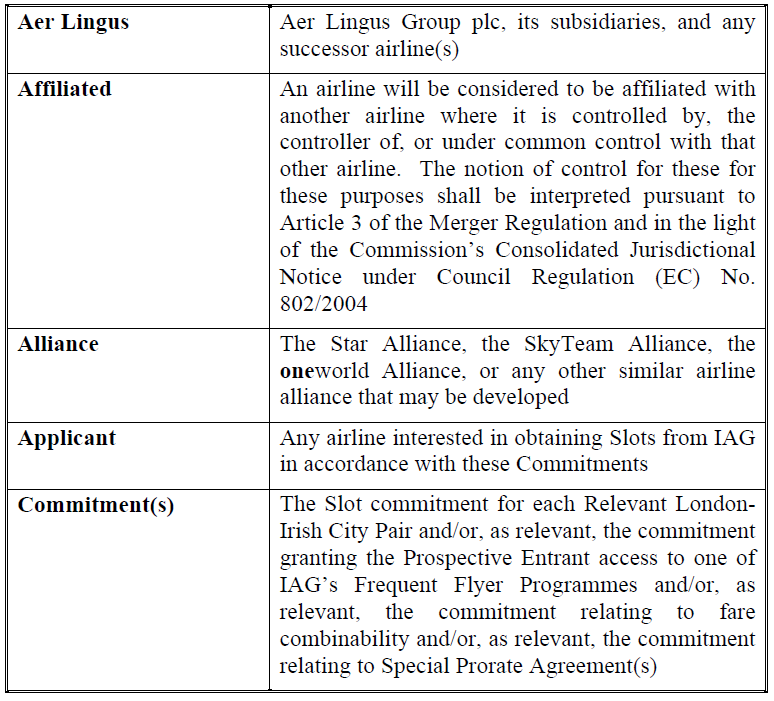
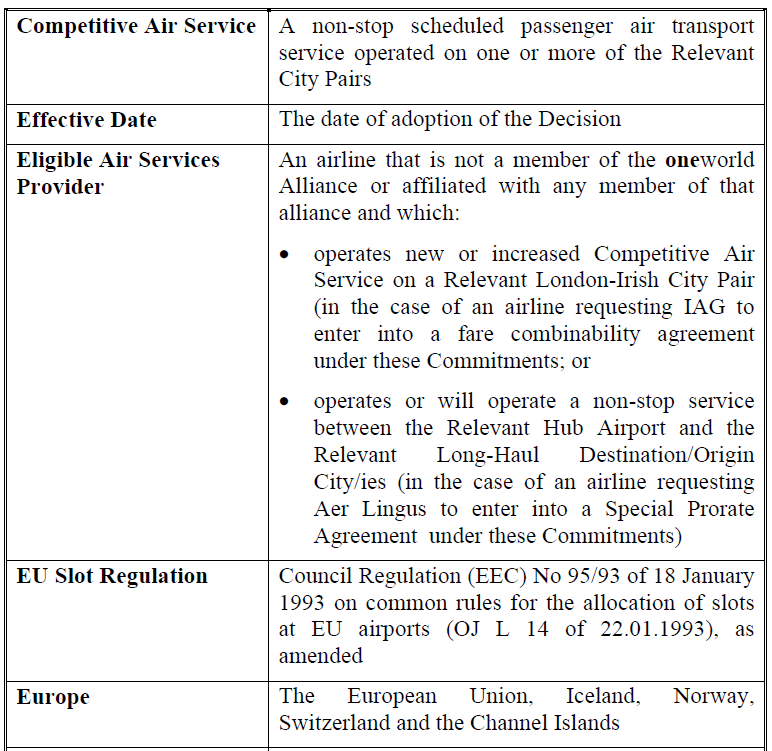
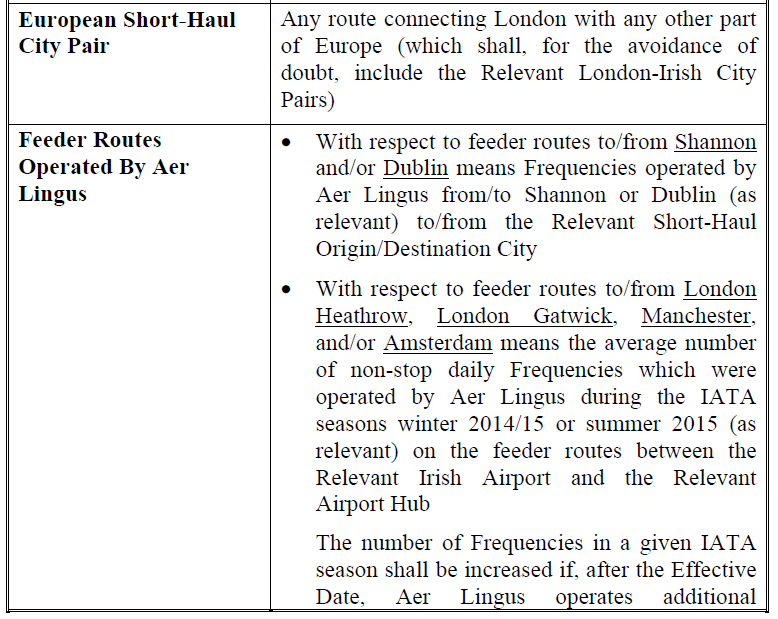
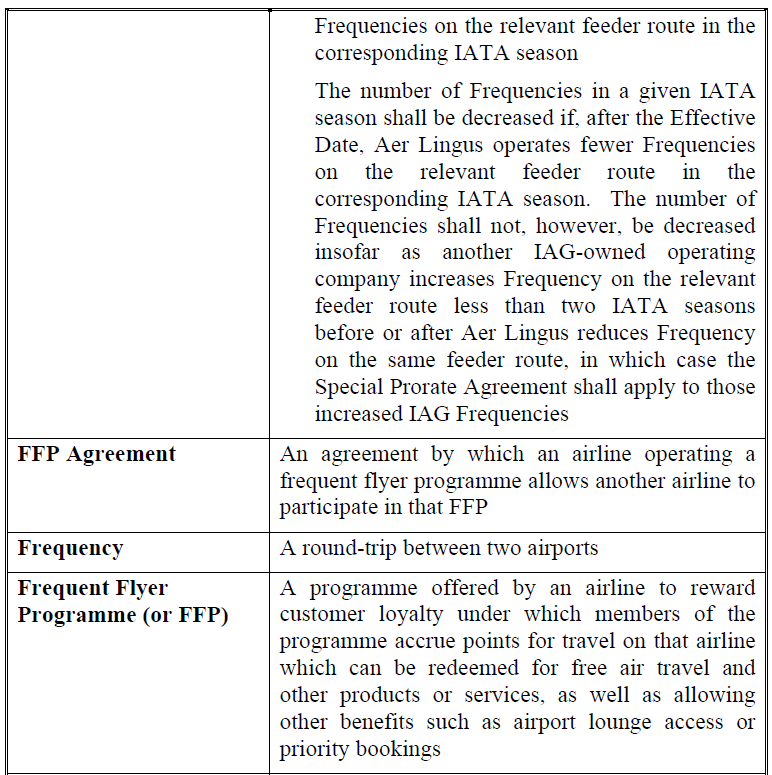
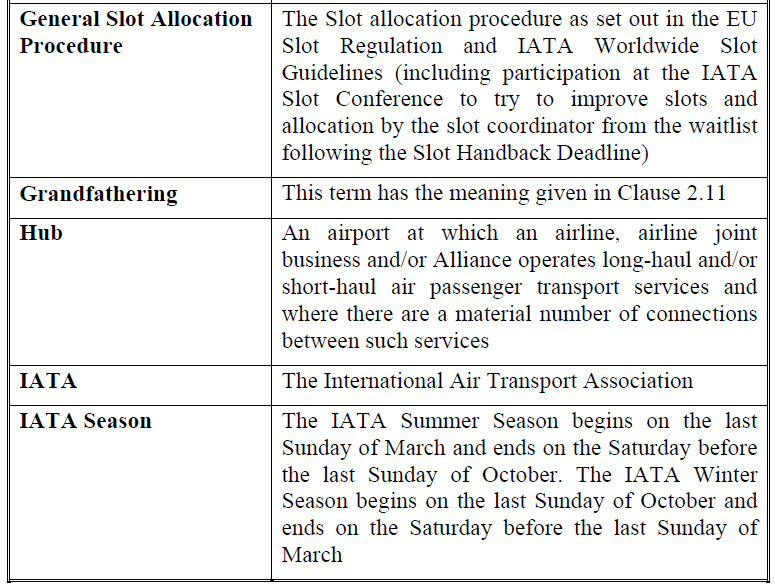
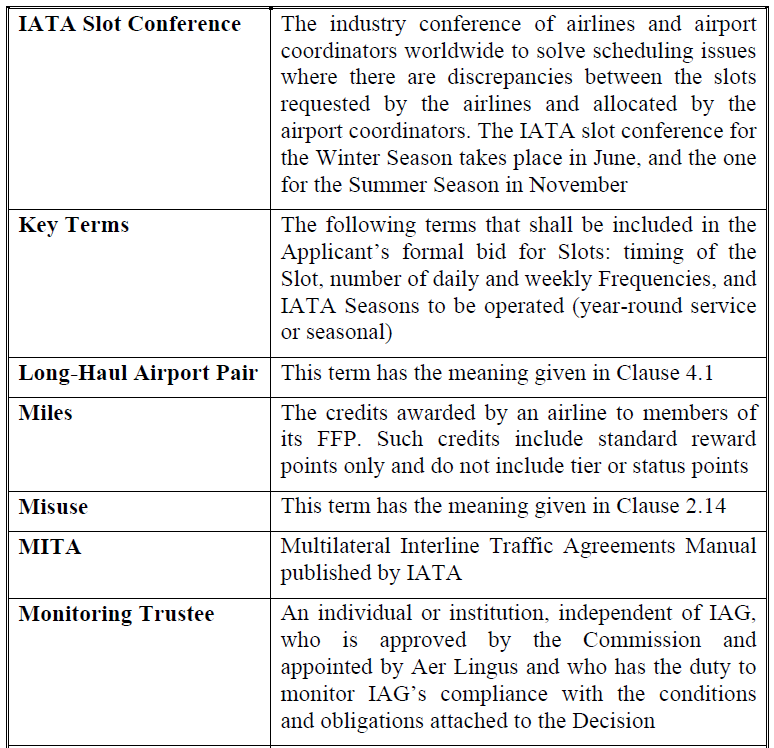
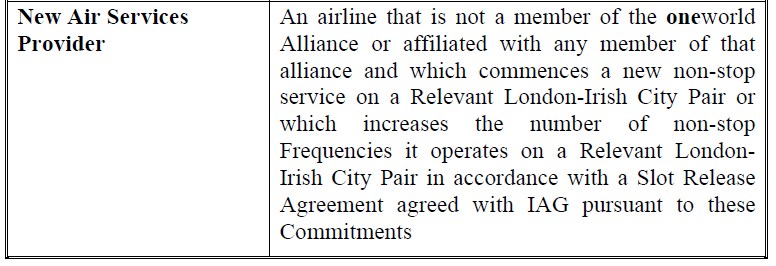
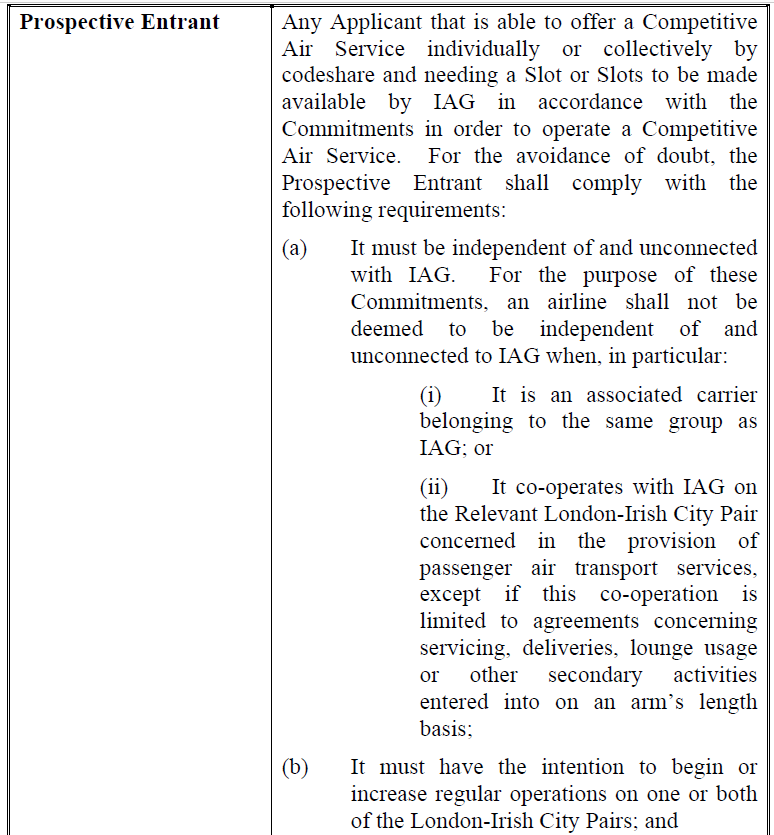
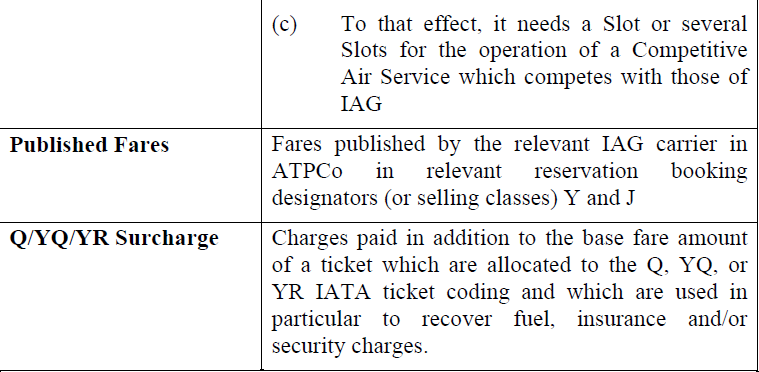
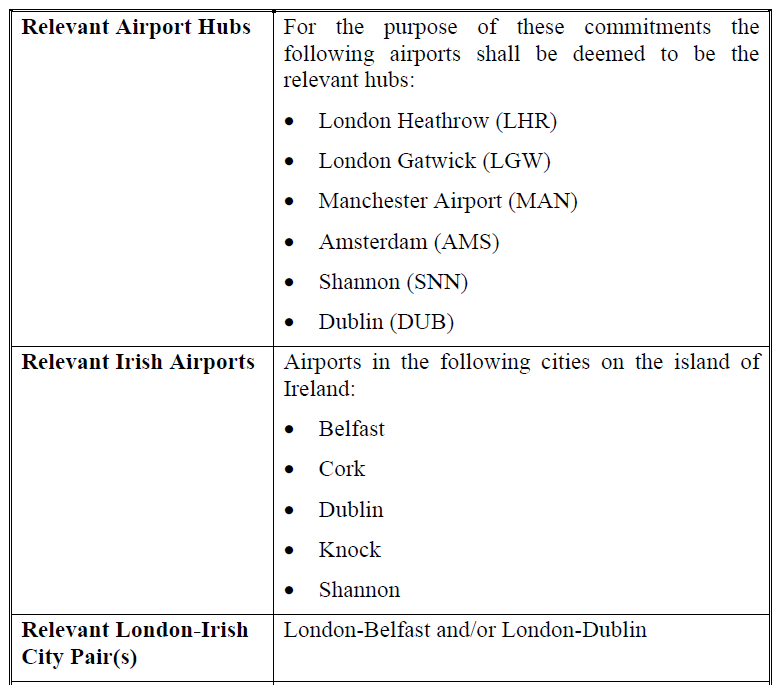
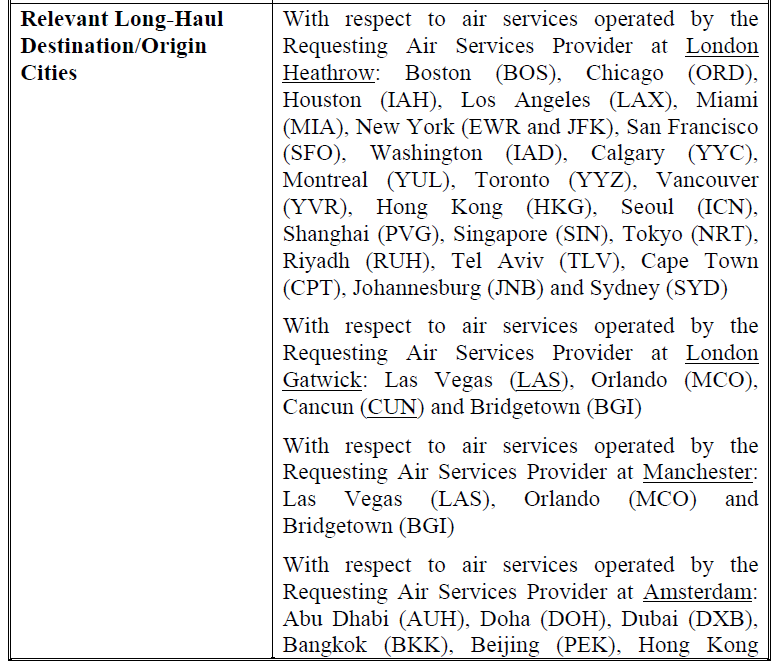
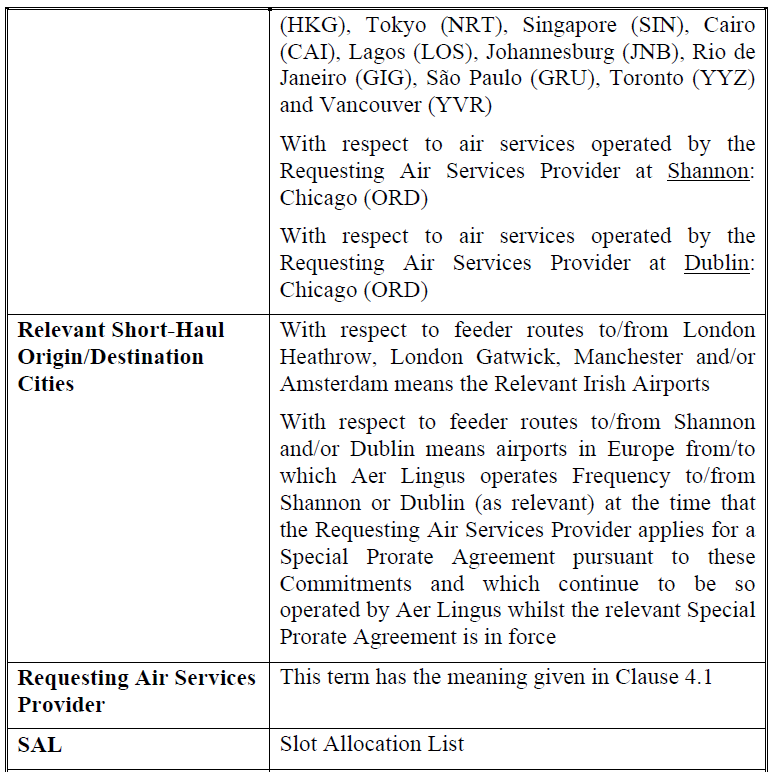
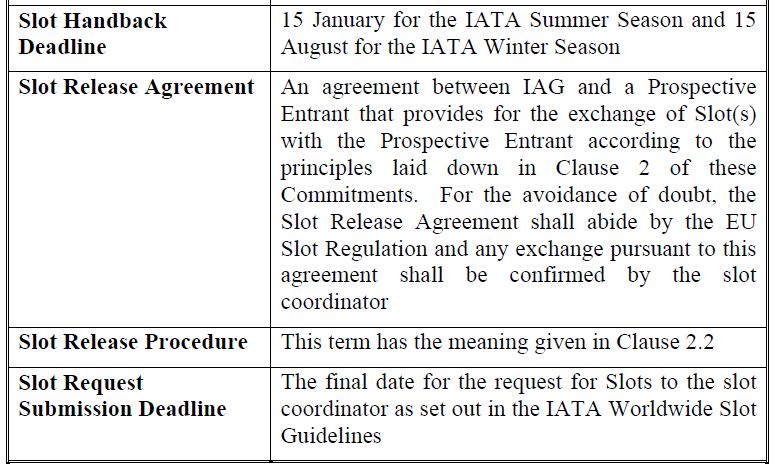
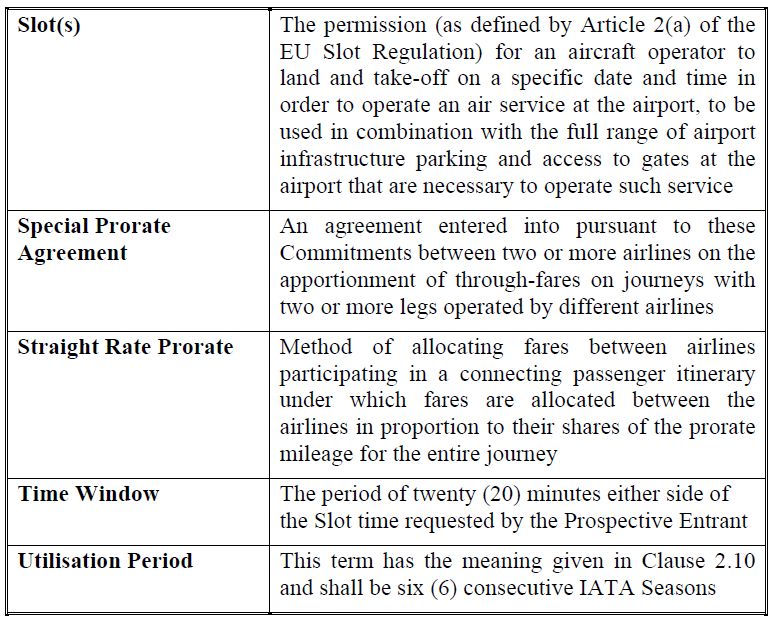
2. SLOTS
Slots At London Gatwick
2.1. IAG undertakes to procure that Slots are made available at London Gatwick to allow one or more Prospective Entrant(s) to operate up to five (5) new or additional daily Frequencies on the Relevant London-Irish City Pairs as follows:
(a) Two (2) daily Frequencies to/from Dublin; and
(b) One (1) daily Frequency to/from Belfast;
with the remaining two (2) daily Frequencies to/from either Dublin or Belfast, or both.
Conditions Pertaining To Slots
2.2. Each Prospective Entrant shall comply with the following procedure to obtain Slots from IAG (“Slot Release Procedure”).
2.3. The Prospective Entrant wishing to commence/increase a Competitive Air Service on one or both of the Relevant London-Irish City Pairs shall:
(a) Apply to the slot coordinator for the necessary Slots through the General Slot Allocation Procedure; and
(b) Notify its request for Slots to the Monitoring Trustee, within the period foreseen in Clause 2.20.
The Prospective Entrant shall be eligible to obtain Slots from IAG pursuant to these Commitments only if it can demonstrate that it has exhausted all reasonable efforts to obtain the necessary Slots to operate on the Relevant London-Irish City Pairs through the normal workings of the General Slot Allocation Procedure.
2.4. The Prospective Entrant shall be deemed not to have exhausted all reasonable efforts to obtain necessary Slots if:
(a) Slots at the same airport were available through the General Slot Allocation Procedure within the Time Window but such Slots have not been accepted by the Prospective Entrant; or
(b) Slots at the same airport (for use to operate a Competitive Air Service on the Relevant London-Irish City Pair) were obtained through the General Slot Allocation Procedure outwith the Time Window and the Prospective Entrant did not give IAG the opportunity to exchange those Slots for Slots within the Time Window; or
(c) It has not exhausted its own Slot portfolio at the airport. For these purposes, a carrier will be deemed not to have exhausted its own Slot portfolio:
(i) If the carrier has Slots at the airport within the Time Window which are being leased-out to or exchanged with other carriers (unless that lease or exchange was concluded before the Effective Date or the carrier can provide reasonable evidence satisfying the Commission (following consultation with the Monitoring Trustee) that there are bona fide reasons for this being done rather than its being a pretext to enable the carrier to present itself as needing Slots to operate a Competitive Air Service on a Relevant London-Irish City Pair); or
(ii) If the carrier has Slots at the airport which are outwith the Time Window and which are leased-out to other carriers, in which case the Prospective Entrant shall be entitled to apply for Slots from IAG, but only if:
* That lease was concluded before the Effective Date; or
* It can provide reasonable evidence satisfying the Commission (following consultation with the Monitoring Trustee) that there are bona fide reasons for leasing the Slot out in this way rather than using it itself; or
* It gives IAG an option to become the lessee of the leased-out Slot at the earliest possible time allowed under the applicable lease (on terms substantially the same as that lease and for a duration that runs in parallel with the Slot Release Agreement). If the Slot Release Agreement with the Prospective Entrant does not provide for monetary compensation, then the lease to IAG will likewise not provide for monetary compensation.
For the purposes of Clause 2.4(c)(i) and 2.4(c)(ii), the bona fide reasons for leasing out (or, as relevant, exchanging) Slots by the Applicant shall include, but shall not be limited to, a situation where the Applicant can provide clear evidence of an intention to operate those Slots on a specific route and clear and substantiated evidence of its reasons for not currently doing so.
2.5. If the Prospective Entrant obtains Slots through the General Slot Allocation Procedure but after the IATA Slot Conference:
(a) Which are within the Time Window; or
(b) Which (in the case of Slots obtained at both ends of the route) are not compatible with the planned flight duration of the Applicant's operation on the route,
the Prospective Entrant shall remain eligible to obtain Slots from IAG provided that it gives an option to IAG to use the obtained Slots on terms substantially the same as the terms of the Slot Release Agreement, and for a duration that runs in parallel with the Slot Release Agreement (provided that such use by IAG is compatible with Article 8a(3) of the EU Slot Regulation).
2.6. Without prejudice to these Commitments (and, particularly, to this Clause 2) IAG shall not be obliged to honour any agreement to make available the Slots to the Prospective Entrant if:
(a) The Prospective Entrant has not exhausted all reasonable efforts in the General Slot Allocation Procedure to obtain the necessary Slots to operate a new or increased service on the Relevant City Pair; or
(b) The Prospective Entrant has been found to be in a situation of Misuse (as described in Clause 2.14 below).
2.7. Subject to the provisions of Clauses 2.8 and 2.9, IAG undertakes to make available Slots within the Time Window (if it has such Slots). In the event that IAG does not have Slots within the Time Window, it shall offer to release the Slots closest in time to the Prospective Entrant’s request. IAG does not have to offer Slots if the Slots which the Prospective Entrant could have obtained through the General Slot Allocation Procedure are closer in time to the Prospective Entrant’s request than the Slots that IAG has. The arrival and departure Slot times shall be such as to allow for reasonable aircraft rotation, taking into account the Prospective Entrant's business model and aircraft utilisation constraints.
2.8. IAG may refuse to offer any arrival Slots at Gatwick after 23:30 (local time). If a Prospective Entrant requests an arrival Slot at Gatwick after 23:30, IAG may offer a Slot between 22:30 and 23:30 (local time). In addition, IAG shall not be obliged to release more than one (1) daily departure Slot at Gatwick in any hour of the day (local time), i.e. no more than one (1) daily departure Slot at Gatwick 06:00-07:00 (local time), no more than one (1) daily departure Slot at Gatwick 07:00-08:00 (local time), etc. As an exception, in circumstances where no such departure Slot has been granted or requested by any Prospective Entrant in the 06:00-08:00 (local time) period, two (2) departure Slots may instead be requested in either the 08:00-09:00 (local time) period or the 09:00-10:00 (local time) period instead of one (1) in each of those two periods, provided that in circumstances where two (2) departure Slots are so requested in the same such period:
(a) The two such departure Slots shall not be used on the same Relevant London-Irish City Pair; and
(b) No more than one of the arrival Slots at Gatwick released by IAG under these Commitments will be before 08:00 (local time).
2.9. In the event that a Prospective Entrant requests departure Slot timings which cannot be accommodated within the parameters of Clause 2.8, IAG shall offer the Prospective Entrant the next closest Slot to the time requested in accordance with Clause 2.2. In the event that different Prospective Entrants make such requests for different Relevant London-Irish City Pairs which cannot all be accommodated within the parameters of Clause 2.8, IAG shall give priority to the Prospective Entrant proposing to operate multiple daily Frequencies (where relevant) on the Relevant London-Irish City Pair and shall, in accordance with Clause 2.2, offer the next closest Slot to the time requested to each Prospective Entrant whose request cannot be accommodated within the parameters of Clause 2.8.
Grandfathering Of Slots
2.10. As a general rule, the Slots obtained by the Prospective Entrant from IAG as a result of the Slot Release Procedure shall be used only to provide a Competitive Air Service on the Relevant London-Irish City Pair for which the Prospective Entrant has requested them from IAG through the Slot Release Procedure. These Slots cannot be used on another city pair unless the Prospective Entrant has operated the Relevant London-Irish City Pair for which these Slots have been transferred for a number of full consecutive IATA Seasons (“Utilisation Period”).
2.11. The Prospective Entrant will be deemed to have grandfathering rights for the Slots once appropriate use of the Slots has been made on the Relevant London-Irish City Pair for the Utilisation Period. In this regard, once the Utilisation Period has elapsed, the Prospective Entrant will be entitled to use the Slots obtained on the basis of these Commitments exclusively to operate services on any European Short-Haul City Pair (“Grandfathering”).
2.12. Grandfathering is subject to approval of the Commission (advised by the Monitoring Trustee). The Commission’s approval shall be conditional on the Prospective Entrant committing that if it ceases to use the Slots in question for the purposes described in Clause 2.11, it will return the Slots in question to IAG or, if IAG does not want the return of the Slots, to the slot coordinator.
2.13. During the Utilisation Period, the Prospective Entrant shall not be entitled to transfer, assign, sell, swap or charge in breach of these Commitments any Slots obtained from IAG under the Slot Release Procedure, except for changes to any such Slots which are within the Time Window and which have been agreed with the slot coordinator.
2.14. During the Utilisation Period, Misuse shall be deemed to arise where a Prospective Entrant which has obtained Slots released by IAG decides:
(a) Not to commence services on the Relevant London-Irish City Pair(s);
(b) To operate fewer daily Frequencies than those to which it committed in the bid in accordance with Clause 2.26 on a Relevant London-Irish City Pair(s) or to cease operating on a Relevant London-Irish City Pair(s) unless such a decision is consistent with the “use it or lose it” principle in Article 10(2) of the EU Slot Regulation (or any suspension thereof);
(c) To transfer, assign, sell, swap, sublease or charge any Slot released by IAG on the basis of the Slot Release Procedure, except for changes to the Slot which are within the Time Window and which have been agreed with the slot coordinator;
(d) Not to use the Slots on a Relevant London-Irish City Pair(s), as proposed in the bid in accordance with Clause 2.26; or
(e) Not to use the Slots properly: this situation shall be deemed to exist where the Prospective Entrant (i) loses the series of Slots at the airport as a consequence of the principle of “use it or lose it” in Article 10(2) of the EU Slot Regulation or (ii) misuses the Slots at the airport as described and interpreted in Article 14(4) of the EU Slot Regulation.
2.15. If IAG or the Prospective Entrant which has obtained Slots under the Slot Release Procedure become aware of or reasonably foresee any Misuse by the Prospective Entrant during the Utilisation Period, it shall immediately inform the other and the Monitoring Trustee. The Prospective Entrant shall have 30 days after such notice to cure the actual or potential Misuse. If the Misuse is not cured, IAG shall have the right to terminate the Slot Release Agreement and the Slots shall be returned to IAG. In cases (a) and (b) of Clause 2.14, IAG shall then use its best efforts to redeploy the Slots in order to safeguard the historic precedents. If despite its best efforts, IAG is not able to retain the historic precedent for these Slots, or in case of a Misuse as defined in cases (c), (d) or (e) of Clause 2.14, the Prospective Entrant shall provide reasonable compensation to IAG as provided for in the Slot Release Agreement.
2.16. For the avoidance of doubt, the Slot Release Agreement may:
(a) Contain prohibitions on the Prospective Entrant transferring its rights to the Slots to a third party, making the Slots available in any way to a third party for the use of that third party, or releasing, surrendering, giving up or otherwise disposing of any rights to the Slots; and/or
(b) Provide for reasonable compensation to IAG in case of Misuse during the Utilisation Period. If for any reason (including, but without limitation, the insolvency of the Prospective Entrant) IAG is unable to receive reasonable compensation for the Slots being either lost or not returned within sufficient time for IAG to preserve its grandfathering rights, such Slots shall be counted against the maximum number of Slots to be released in accordance with the Commitments.
2.17. In view of the Commission's Communication of 30 April 2008, which stated that: “The text of the current Regulation is silent on the question of exchanges with monetary and other consideration” and that the Commission would therefore “not intend to pursue infringement proceedings against Member States where such exchanges take place in a transparent manner, respecting all the other administrative requirements for the allocation of slots set out in the applicable legislation”, and to the extent that the Slots released under the Slot Release Procedure are at an airport where secondary trading takes place, the Slot Release Agreement with the Prospective Entrant may provide for monetary and/or other consideration, so long as such Slot Release provisions are clearly disclosed and comply with these Commitments and all other administrative requirements set out in the applicable legislation.
2.18. The Slot Release Agreement shall provide that the Prospective Entrant will be able to terminate the agreement at the end of each IATA Season without penalty, provided the Prospective Entrant notifies the termination of the agreement to IAG in writing no later than two (2) weeks after the IATA Slot Conference.
2.19. Selection Procedure, Role Of Monitoring Trustee And Approval By Commission
2.20. At least seven (7) weeks before the Slot Request Submission Deadline, any airline wishing to obtain Slots from IAG pursuant to the Slot Release Procedure shall:
(a) Inform the Monitoring Trustee of its proposed Slot request (indicating the arrival and departure times);
(b) Submit to the Monitoring Trustee the list of its leased out or exchanged Slots at the airport, along with the date at which the leases or exchanges were concluded. The Monitoring Trustee or the Commission may also request additional information from the Applicant to enable assessment of its eligibility pursuant to Clause 2.4(c) and Clause 2.23;
(c) Indicate to the Monitoring Trustee if it has any confidentiality concerns which would justify keeping its identity anonymous vis-à-vis IAG, in which case it must provide a reasoned explanation of those concerns together with its request for anonymity. In the event that such a request is made, the Monitoring Trustee shall:
(i) Immediately inform the Commission of that request;
(ii) Within one (1) week of that request advise the Commission whether or not that request should be granted; and
(iii) Within three (3) weeks of the request, in consultation with the Commission, determine whether or not the Applicant’s Slot request may be treated anonymously (and, if so, to what extent, subject to what conditions and for what period).
2.21. At least six (6) weeks before the Slot Request Submission Deadline, the Monitoring Trustee shall forward the Slot request to IAG and the Commission. Until the beginning of the IATA Slot Conference, the Monitoring Trustee shall not disclose to IAG the Relevant London-Irish City Pair for which the Slot is requested. Once informed of the Slot request, IAG may discuss with the Applicant the timing of the Slots to be released and the types of compensation which could be offered. IAG shall copy the Monitoring Trustee on all correspondence between it and the Applicant which relates to the Slot Release Procedure. IAG shall not share any information about such discussions with other Applicants and may require the Applicant not to share any such information with other Applicants. At least six (6) weeks before the Slot Request Submission Deadline, the Monitoring Trustee shall also inform the manager of the airport and the slot coordinator of the Slot request and, subject to the Applicant’s consent, disclose to them any relevant information regarding the Slot request. The Monitoring Trustee shall ask the manager of the airport and the slot coordinator to inform it of any likely impediments to the satisfaction of the request, in particular due to the availability of terminal facilities and infrastructure.
2.22. If the Applicant has made a request for anonymity in accordance with Clause 2.20(c), the Monitoring Trustee shall not disclose to IAG the identity of the Applicant for so long as that request is pending or has been granted. In such a case, the procedure set down in Clauses 2.22-2.33 shall apply, save that, until the beginning of the IATA Slot Conference, any communication or correspondence between IAG and the Applicant shall go through the Monitoring Trustee, who shall ensure the protection of the anonymity of the Applicant.
2.23. After being informed of the Slot request in accordance with Clause 2.21, the Commission (advised by the Monitoring Trustee) shall assess whether the Applicant meets the following criteria:
(a) The Applicant is independent of and unconnected to IAG; and
(b) The Applicant has exhausted its own Slot portfolio at the airport.
If the Commission decides that the Applicant does not fulfil the above criteria, the Commission shall inform the Applicant and IAG of that decision at least two (2) weeks before the Slot Request Submission Deadline.
2.24. At least one (1) week before the Slot Request Submission Deadline, IAG shall indicate to the Monitoring Trustee and each Applicant which Slots at the airport they would release, if necessary, during the Time Window.
2.25. By the Slot Request Submission Deadline, each Applicant shall send its request for Slots (at the same time(s) as those requested through the Slot Release Procedure) to the slot coordinator in accordance with the General Slot Allocation Procedure.
2.26. By the Slot Request Submission Deadline, each Applicant shall also submit its formal bid for the Slots to the Monitoring Trustee. The formal bid shall include at least:
(a) The Key Terms (i.e. timing of the Slots and number of daily Frequencies to be operated on a year-round service); and
(b) A detailed business plan. This plan shall contain a general presentation of the company including its history, its legal status, the list and a description of its shareholders and the two most recent yearly audited financial reports. The detailed business plan shall provide information on the plans that the company has in terms of access to capital, development of its network, fleet etc. and detailed information on its plans for the Relevant London-Irish City Pair(s) on which it wants to operate. The latter should specify in detail planned operations on the Relevant London-Irish City Pair(s) over a period of at least two (2) consecutive lATA Seasons (size of aircrafts, seat configuration, total capacity and capacity by each class, number of daily Frequencies operated, pricing structure, service offerings, planned time-schedule of the flights) and expected financial results (expected traffic, revenues, profits, average fare by cabin class). The Monitoring Trustee and/or the Commission may also request any additional information and documents from the Applicant required for their assessment, including a copy of all cooperation agreements the Applicant may have with other airlines. Business secrets and confidential information will be kept confidential by the Commission and the Monitoring Trustee and will not become accessible IAG, other undertakings or the public.
2.27. In parallel, if an Applicant is offering compensation for the Slot(s) it has requested pursuant to these Commitments, it will send IAG, copying the Monitoring Trustee, a detailed description of the compensation which it is willing to offer in exchange for the release of the Slots for which it has submitted bids. Within three (3) weeks, IAG shall provide the Monitoring Trustee with a ranking of these offers.
2.28. Having received the formal bid(s), the Commission (advised by the Monitoring Trustee) shall:
(a) Assess whether each Applicant is a viable existing or potential competitor, with the ability, resources and commitment to operate services on the Relevant London-Irish City Pair(s) in the long term as a viable and active competitive force; and
(b) Evaluate the formal bids of each Applicant that meets (a) above, and rank these Applicants in order of preference.
2.29. In conducting its evaluation in accordance with Clause 2.28, the Commission shall give preference to the Applicant (or combination of Applicants) which will provide the most effective overall competitive constraint on the Relevant London-Irish City Pair(s), without regard to the country in which the Applicant(s) is licensed or has its principal place of business. For these purposes, the Commission shall take into account the strength of the Applicant’s business plan and in particular give preference to Applicants meeting one or more of the following criteria:
(a) A pricing structure, capacity (measured in seats), and service offerings that would provide the most effective competitive constraint on the Relevant London-Irish City Pair(s); and
(b) Plans to offer feed to third party carriers operating services from London Gatwick to one or more of the Relevant Long-Haul Destination/Origin Cities.
2.30. The Commission (advised by the Monitoring Trustee) shall also ensure that the departure Slots at Gatwick to be made available under Clause 2.1 for the same Relevant London-Irish City Pair are spread throughout the day, including: no more than two (2) Slots in the period up until 12:00 local time, no more than two (2) Slots in the period after 12:00 and up until 16:00 local time, and no more than two (2) Slots in the period after 16:00 local time.
2.31. In advance of the beginning of the lATA Slot Conference, the Monitoring Trustee shall inform each Applicant (if the latter did not receive slots within the Time Window as indicated through the SAL) and the slot coordinator:
(a) Whether the Applicant qualifies for the Slots Commitment; and
(b) The Applicant’s ranking.
In any case, the Applicant shall attend the lATA Slot Conference and try to improve its Slots. Following confirmation of the Commission’s approval pursuant to Clause 2.28), the Applicants and IAG shall be deemed to have agreed the Key Terms of the Slot Release Agreement, as well as any compensation which was offered by the Applicant to IAG under Clause 2.27. The Key Terms may only be changed after such date by mutual agreement between the Applicant and IAG if the Monitoring Trustee confirms that the changes are not material or if the Commission (advised by the Monitoring Trustee) approves the changes.
2.32. Within two (2) weeks of the end of the lATA Slot Conference, each Applicant shall inform the Monitoring Trustee and IAG whether it will commit to operate the Slots offered eventually by IAG in case it has not obtained them through the General Slot Allocation Procedure.
2.33. Within three (3) weeks of the end of the lATA Slot Conference, the Monitoring Trustee shall confirm to the highest ranked Applicant(s) that has provided the confirmation in accordance with Clause 2.32 that it is entitled to receive Slots from IAG. IAG shall offer the dedicated Slots for release to such Applicant. The Slot Release Agreement shall be subject to review by the Monitoring Trustee and approval of the Commission. Unless both IAG and the relevant Applicant agree to an extension and subject to Clause 2.5, the Slot Release Agreement shall be signed and the Slot release completed within six (6) weeks after the lATA Slot Conference, and the slot coordinator shall be informed of the Slot exchange in order to obtain the required confirmation.
3. FARE COMBINABILITY
3.1. At the request of an Eligible Air Services Provider which, after the Effective Date, has started to operate new or increased Competitive Air Service on a Relevant London-Irish City Pair (whether or not such service uses Slots released to that carrier pursuant to these Commitments), IAG shall enter into an agreement that arranges for fare combinability on that Relevant London-Irish City Pair. This agreement will provide for the possibility for the Eligible Air Services Provider, or travel agents, to offer a return trip on the Relevant London-Irish City Pair comprising a non-stop service provided one way by an IAG carrier and a non-stop service provided the other way by the Eligible Air Services Provider. At the request of the Eligible Air Services Provider, the agreement shall apply in relation to all of the Eligible Air Services Provider’s services on the Relevant London-Irish City Pair.
3.2. Any such agreement shall be subject to the following restrictions:
(a) It shall provide for fare combinability on the basis of IAG’s Published Fares. Where this provides for a published round-trip fare, the fare can be comprised of half the round-trip fare of IAG and half the round-trip fare of the Eligible Air Services Provider;
(b) It shall provide for the appropriate division or recovery of any applicable Q/YQ/YR Surcharges;
(c) It shall be limited to true origin and destination traffic on the Relevant London-Irish City Pair operated by the Eligible Air Services Provider; and
(d) It shall be subject to the MITA rules.
3.3. Subject to Clause 3.7, any term included in the agreement (for example, interline service charge, number of booking classes included) can never be less favourable than the corresponding term in any fare combinability agreement which IAG and the Eligible Air Services Provider have in place as at the Effective Date.
3.4. Subject to seat availability in the relevant fare category, IAG shall carry a passenger holding a coupon issued by an Eligible Air Services Provider for travel on a Relevant London-Irish City Pair. IAG may require that the Eligible Air Services Provider or the passenger, where appropriate, pay the (positive) difference between the fare charged by IAG and the fare charged by the Eligible Air Services Provider if IAG was not the original ticketed carrier on the Relevant London-Irish City Pair. In cases where the Eligible Air Services Provider’s fare is lower than the value of the coupon issued by it, IAG may endorse its coupon only up to the value of the fare charged by the Eligible Air Services Provider. An Eligible Air Services Provider shall enjoy the same protection in cases where IAG’s fare is lower than the value of the coupon issued by it.
3.5. A fare combinability agreement entered into pursuant to this Clause 3 for a particular Relevant London-Irish City Pair shall have an effective duration of up to five (5) years at the choice of the Eligible Air Services Provider, or if it elects to have a shorter initial duration than that to which it is entitled pursuant to this Clause 3.5, the Eligible Air Services Provider shall have a right to renew the agreement on an evergreen basis for further periods of one (1) year (i.e. rolled over on the same terms) as long as these Commitments are in force, provided it exercises its right of extension by informing IAG in writing no later than thirty (30) days before the expiry of the agreement. The Eligible Air Services Provider also has a right to terminate the agreement, at any time during the initial term or the extensions, upon thirty (30) days’ written notice.
3.6. All agreements entered into pursuant to this Clause 3 for a particular Relevant London-Irish City Pair shall lapse automatically in the event that the Eligible Air Services Provider ceases to operate the new or increased service on that Relevant London-Irish City Pair.
3.7. The conclusion of the fare combinability agreement shall be subject to the approval of the Commission, as advised by the Monitoring Trustee, in particular as to whether its terms are reasonable.
4. SPECIAL PRORATE AGREEMENTS
4.1. At the request of an Eligible Air Service Provider, Aer Lingus shall enter into a Special Prorate Agreement with such airline (the “Requesting Air Services Provider”), for traffic with a true origin/destination at the Relevant Short-Haul Origin/Destination City, and a true destination/origin in one or more of the Relevant Long-Haul Destination/Origin Cities. At the request of the Requesting Air Services Provider, the Special Prorate Agreement shall apply to all of the non-stop air services operated by the Requesting Air Services Provider between a Relevant Airport Hub and a Relevant Long-Haul Destination/Origin City (the “Long-Haul Airport Pair”).
4.2. In order to be eligible for a Special Prorate Agreement, the Requesting Air Services Provider must not, alone or in combination with carriers who are members of the same Alliance (or who are Affiliated with members of the same Alliance) as the Requesting Air Services Provider, have Hubs at both ends of the Long-Haul Airport Pair.
4.3. Subject to Clause 4.1, for each Relevant Long-Haul Destination/Origin City for which it proposes to enter into a Special Prorate Agreement with Aer Lingus pursuant to these Commitments, the Requesting Air Services Provider may request a Special Prorate Agreement to/from one or more of the Relevant Short-Haul Origin/Destination Cities to one or more of the Relevant Long-Haul Destination/Origin Cities via the Relevant Airport Hub(s). In the case of travel via Heathrow, Gatwick, Manchester and/or Amsterdam, this is limited to the Relevant Irish Airports, in the case of travel via Shannon, this is limited to up to five (5) Relevant Short-Haul Origin/Destination Cities and in the case of travel via Dublin, this is limited to up to twenty (20) Relevant Short-Haul Origin/Destination Cities. It is understood that the Special Prorate Agreement shall only apply to Frequencies on the Feeder Routes Operated By Aer Lingus (as defined).
4.4. The Requesting Air Services Provider may also select the fare class(es) to which the Special Prorate Agreement will apply, provided that each selected fare class is included in at least one existing special prorate agreement which Aer Lingus has agreed and applied with any other carrier for the same feeder route between the Relevant Short-Haul Origin/Destination City and the Relevant Airport Hub to provide feeder traffic for the same Long-Haul Airport Pair, excluding any agreements (or terms therein) which are excluded pursuant to Clause 4.8. Subject to the previous sentence of this Clause 4.4, the number of fare classes that the Requesting Air Services Provider may select shall be up to the maximum number of fare classes that is granted by Aer Lingus under an existing special prorate arrangement of the same type (Straight Rate Prorate or fixed rate as the case may be) to any other carrier.
4.5. If the Special Prorate Agreement provides for Straight Rate Prorate terms:
(a) Straight rate proration shall apply only to published fares;
(b) It shall include arrangements for the proration or remittance of any applicable Q/YQ/YR Surcharges;
(c) It shall include conditions or provisos (such as minimum rates) at least as favourable as those granted to any other carrier under an existing special prorate agreement which Aer Lingus has agreed and applied with any other carrier for the same feeder route between the Relevant Short-Haul Origin/Destination City and the Relevant Airport Hub to provide feeder traffic for the same Long-Haul Airport-Pair (other than if the terms are excluded by virtue of Clause 4.8); and
(d) It shall not prohibit Aer Lingus from making adjustments to ATPCo chart 2 in accordance with normal business practices in managing Straight Rate Prorate agreements. Any such adjustments to ATPCo chart 2 shall be communicated by Aer Lingus to the Requesting Air Services no fewer than 30 days prior to the adjustment being put into effect. Should the Requesting Air Services Provider believe that Aer Lingus has made adjustments to ATPCo chart 2 which are not in accordance with normal business practices but rather an attempt by Aer Lingus to restrict the Requesting Air Services Provider's inventory access, it may ask the Monitoring Trustee to verify whether Aer Lingus’ adjustments comply with these Commitments.
4.6. Subject to the provisions of the rest of this Clause 4, the Special Prorate Agreement shall:
(a) Be on terms (e.g. rates and interline service charges) which are at least as favourable as the terms agreed and applied by Aer Lingus under an existing special prorate agreement with any other carrier for the same feeder route between the Relevant Short-Haul Origin/Destination City and the Relevant Airport Hub to provide feeder traffic for the same Long-Haul Airport Pair and in the same fare class (excluding any codeshare or interline terms within an existing codeshare-related agreement and any other terms excluded by virtue of Clause 4.8). If Aer Lingus does not have an equivalent rate with any other carrier, the rate shall be determined in accordance with Clause 4.9;
(b) Grant the Requesting Air Services Provider equivalent inventory access to that given by Aer Lingus under existing special prorate agreement with any other carrier for the same feeder route between the Relevant Short-Haul Origin/Destination City and the Relevant Airport Hub to provide feeder traffic for the same Long-Haul Airport Pair and in any event no worse than as between Aer Lingus and other IAG carriers (other than, in each case, if the terms are excluded by virtue of Clause 4.8); and
(c) Ensure minimum connection times which are based on standard practices at the airport and terminal in question, and which are reasonable.
4.7. Subject to Clause 4.17, any term included in the Special Prorate Agreement (for example, rates and interline service charge, number of fare and booking classes included) can never be less favourable than the corresponding term in any existing special prorate agreement which Aer Lingus has in place with the Requesting Air Services Provider on the Effective Date, other than any terms excluded by virtue of Clause 4.8. To take account of adjustments in fare class usage, for the purposes of Clause 4.4 and Clause 4.6(a), the fare classes selected by the Requesting Air Services Provider need not be the same fare classes as those specified in any special prorate agreement which is in place as at the Effective Date provided that the requested fare classes reasonably correspond to such specified fare classes.
4.8. For the purposes of Clause 4.4, Clause 4.5 and Clause 4.6(a) and 4.5(b) and Clause 4.7, Aer Lingus may exclude any existing special prorate agreement which Aer Lingus has with any other carrier where:
(a) The agreement is de minimis (in that fewer than 1,000 sectors were flown on the relevant airline’s metal pursuant to that agreement in the last two IATA seasons); and/or
(b) The agreement is obsolete or has expired.
In addition, the Monitoring Trustee shall exclude any existing special prorate agreements or any individual terms of such agreements which Aer Lingus has demonstrated, to the satisfaction of the Monitoring Trustee, that it would be unreasonable to include because, due to exceptional circumstances, the relevant agreements or terms are exceedingly favourable.
4.9. For the purposes of Clause 4.6(a):
(a) Where at least one existing special prorate agreement which Aer Lingus has agreed and applied with another carrier for the same feeder route between the Relevant Short-Haul Origin/Destination City and the Relevant Airport Hub to provide feeder traffic for the same Long-Haul Airport Pair and which has not been excluded pursuant to Clause 4.8, but is included in a different fare class to the one selected by the Requesting Air Services Provider, the terms will be calculated by applying a ratio of the average difference in fares as between the fare class selected by the Requesting Air Services Provider and the fare class on which terms with another carrier are available;
(b) Where any existing special prorate agreements which Aer Lingus has agreed and applied with other carriers do not include the same feeder route and/or are not or have not been used for providing feeder traffic for the relevant Long-Haul Airport Pair, the rate for providing feeder traffic for the relevant Long-Haul Airport Pair will be either the rate agreed by Aer Lingus and the Requesting Air Services Provider or the most favourable rate (considering factors such as yield and length of haul) which is included in an existing special prorate agreement of Aer Lingus and is used for feed on the most comparable Long-Haul Airport Pair from/to the same Relevant Airport Hub. In the event that Aer Lingus can establish that clear and material differences exist between the selected Long-Haul Airport Pair and the most comparable Long-Haul Airport Pair, the Monitoring Trustee may make appropriate adjustments to the rate.
4.10. Clauses 4.4 and 4.7 in conjunction with Clauses 4.8 and 4.9, shall, subject to Clause 4.18, be applied on the basis of the more favourable (to the Requesting Air Services Provider) of the following:
(a) Special prorate agreements (and the terms therein) between Aer Lingus and any other carrier as existing on the Effective Date, subject to reasonable indexation that takes account of standard industry practices; and
(b) Special prorate agreements (and the terms therein) between Aer Lingus and any other carrier as existing at the date of the request for negotiation or renegotiating of the Special Prorate Agreement.
4.11. Subject to Clause 4.16 the Special Prorate Agreement shall have an effective duration of up to five (5) years at the choice of the Requesting Air Services Provider. Thereafter, or if it elects to have a shorter initial duration than that to which it is entitled pursuant to this Clause 4.11, the Requesting Air Services Provider shall have a right to renew the agreement on an evergreen basis for further periods of up to two (2) years (i.e. rolled over on the same terms) as long as these Commitments are in force, provided it exercises its right of extension by informing Aer Lingus in writing no later than thirty (30) days before the expiry of the agreement. The Requesting Air Services Provider also has a right to terminate the agreement, at any time during the initial term or the extensions, upon thirty (30) days’ written notice.
4.12. Within four (4) weeks of the date of the request for a Special Prorate Agreement by a Requesting Air Services Provider, Aer Lingus shall propose a draft Special Prorate Agreement to the Monitoring Trustee in compliance with this Clause 4. At the same time, Aer Lingus shall submit supporting evidence, as necessary, in particular with regard to Clauses 4.6, 4.8, 4.9 and 4.10.
4.13. Considering the comments of the Requesting Air Service Provider and after having consulted the Commission, the Monitoring Trustee may request clarification and further evidence from Aer Lingus. Aer Lingus shall provide the requested clarification and evidence within two (2) weeks of the request from the Monitoring Trustee, unless Aer Lingus presents bona fide reasons for the Commission to extend this deadline.
4.14. If the Monitoring Trustee confirms that the provided clarification and evidence are sufficient, Aer Lingus shall revise the draft Special Prorate Agreement, as necessary, within two (2) weeks of the confirmation from the Monitoring Trustee. If the Monitoring Trustee requests further clarification and evidence, Aer Lingus shall proceed in accordance with Clause 4.13.
4.15. Upon the request of the Requesting Air Service Provider, the draft Special Prorate Agreement proposed by Aer Lingus under Clause 4.12 may be applied provisionally without prejudice to subsequent negotiations on the Special Prorate Agreement.
4.16. All Special Prorate Agreements entered into pursuant to this Clause 4:
(a) Shall lapse automatically with respect to the relevant Long-Haul Airport Pair in the event that the Requesting Air Services Provider: ceases to operate a service on the relevant Long-Haul Airport Pair; or joins an Alliance, or becomes Affiliated with a member of an Alliance, with Hubs at both the Relevant Airport Hub and at the Relevant Long-Haul Destination/Origin City.
(b) In the case of any Special Prorate Agreement entered into pursuant to these Commitments in order to provide feeder traffic for the Dublin-Chicago Relevant Long-Haul Airport Pair, such an agreement may also be terminated on 30 days’ notice in the event that the Requesting Air Services Provider’s service(s) account(s) for 30% or more of all passengers (including connecting passengers) travelling on the Dublin-Chicago Relevant Long-Haul Airport Pair in two consecutive IATA seasons (calculated by using Amadeus Marketing Information Data Tapes (MIDT) data). This is subject to the proviso that, in each relevant IATA season, feeder traffic provided by Aer Lingus pursuant to the Special Prorate Agreement did not account for more than 5% of the total number of passengers travelling on the Requesting Air Services Provider’s Dublin-Chicago service(s) (calculated by reference to the Requesting Air Services Provider’s actual passenger number data). For the avoidance of doubt:
(i) Where the Requesting Air Services Provider’s is seasonal, consecutive means a summer or winter IATA season followed by the next summer or winter IATA season;
(ii) Any bookings made under the terms of the Special Prorate Agreement prior to the date of service of the notice of termination will be honoured.
(c) May with the agreement of the Monitoring Trustee, be subject to annual renegotiation. Clause 4.10 (in conjunction with the other Clauses referred
to therein) shall be applicable to each annual re-negotiation.
4.17. Should the Requesting Air Services Provider believe that the terms proposed by Aer Lingus do not comply with this Clause 4, it may ask the Monitoring Trustee to verify whether those terms comply with these Commitments.
4.18. The conclusion of the Special Prorate Agreement shall be subject to the approval of the Commission, as advised by the Monitoring Trustee, in particular as to whether its terms are reasonable.
4.19. For the avoidance of doubt:
(a) Aer Lingus shall not deconcur the Requesting Air Services Provider from routes and fare classes covered by the Special Prorate Agreement.
(b) Aer Lingus shall also not deconcur the Requesting Air Services Provider from particular fare classes or routes which it currently prorates under the IATA MPA where the Requesting Air Services Provider’s rates cover Aer Lingus’ marginal costs of carriage.
(c) Any Ticketing Time limits (“TTLs”) applied to bookings made under any Special Prorate Agreement entered into pursuant to these Commitments shall be no less favourable than the TTLs applied by Aer Lingus to any other bookings made on the applicable Aer Lingus-operated routes.
5. FREQUENT FLYER PROGRAMMES
5.1. At the request of a New Air Services Provider that does not have a comparable FFP of its own, IAG shall allow it to be hosted in its FFP for the Relevant London-Irish City Pair(s) on which the New Air Services Provider has commenced or increased service. The FFP Agreement with the New Air Services Provider shall be on terms such that the New Air Services Provider shall have equal treatment vis-à-vis the accrual and redemption of Miles on the particular Relevant London-Irish City Pair as compared with other members of the oneworld Alliance.
5.2. Any agreement relating to a particular Relevant London-Irish City Pair and entered into pursuant to this Clause 5 shall:
(a) Lapse automatically in the event that the New Air Services Provider ceases to operate the new or increased service on that Relevant City Pair; and
(b) Have an effective duration of up to five (5) years at the choice of the New Air Services Provider. Thereafter, or if it elects to have a shorter initial duration than that to which it is entitled pursuant to this Clause 5.2, the New Air Services Provider shall have a right to renew the agreement on an evergreen basis for further periods of one (1) year (i.e. rolled over on the same terms) as long as these Commitments are in force, provided it exercises its right of extension by informing IAG in writing no later than two (2) weeks after the IATA Slot Conference preceding the requested extension. The New Air Services Provider also has a right to terminate the agreement, at any time during the initial term or the extensions, upon thirty (30) days' written notice.
5.3. Subject to Clause 5.4, any term included in the frequent flyer agreement entered into pursuant to this Clause 5 can never be less favourable than the corresponding term in any FFP agreement which IAG and the New Air Services Provider have in place as at the Effective Date.
5.4. The conclusion of the FFP agreement shall be subject to the approval of the Commission, as advised by the Monitoring Trustee, in particular as to whether its terms are reasonable.
6. MONITORING TRUSTEE
Appointment Of Monitoring Trustee
6.1. A Monitoring Trustee shall be appointed by Aer Lingus on the terms and in accordance with the procedure described below and, once approved by the Commission, shall perform the functions of monitoring Aer Lingus’ fulfilment of the Commitments and further obligations that may be contained in the Decision.
6.2. The Monitoring Trustee shall be independent of Aer Lingus and all other members of the oneworld Alliance, must be familiar with the airline industry, and have the experience and competence necessary for this appointment (e.g. investment bank, consultant specialised in the air transport sector, or auditor, provided in all cases that they are able to demonstrate sufficient industry expertise). In addition, it shall not be exposed to any conflict of interest and shall not have had any direct or indirect work, consulting or other relationship with Aer Lingus or IAG in the last three (3) years and shall not have a similar relationship with Aer Lingus or IAG for three (3) years after completing its mandate. For the avoidance of doubt, the performance of the role of monitoring trustee in other Commission proceedings shall not be an obstacle to the appointment as Monitoring Trustee.
6.3. Aer Lingus shall ensure that the Monitoring Trustee’s remuneration shall be sufficient to guarantee the effective and independent compliance of its mandate.
6.4. Within one (1) week of the Effective Date, Aer Lingus shall submit to the Commission for approval a list of one or more persons whom Aer Lingus considers adequate to fulfil the duties of the Monitoring Trustee. The proposal shall contain sufficient information for the Commission to verify that the proposed Monitoring Trustee fulfils the requirements set out above and shall include:
(a) The full terms of the proposed mandate, which shall include all provisions necessary to enable the Monitoring Trustee to fulfil its duties under these Commitments; and
(b) The outline of a work plan which describes how the Monitoring Trustee intends to carry out the tasks assigned to it.
6.5. The Commission shall have the discretion to approve or reject the proposed Monitoring Trustee and to approve the proposed mandate subject to any modifications it deems necessary for the Monitoring Trustee to fulfil its obligations. If only one name is approved, Aer Lingus shall appoint the individual or institution concerned as Monitoring Trustee. If more than one name is approved by the Commission, Aer Lingus shall be free to choose the Trustee to be appointed from among the names approved. The Monitoring Trustee should be appointed within one (1) week of the Commission’s approval, in accordance with the mandate approved by the Commission.
6.6. If all the proposed Monitoring Trustees are rejected by the Commission, Aer Lingus shall submit the names of at least two more individuals or institutions within one (1) week of being formally informed of the rejection by the Commission.
6.7. If all further proposed Monitoring Trustees are rejected by the Commission, the Commission shall nominate a Monitoring Trustee, whom Aer Lingus shall appoint in accordance with the mandate approved by the Commission.
Monitoring Trustee’s Mandate
6.8. The Monitoring Trustee’s mandate shall include, in particular, the following obligations and responsibilities:
(a) To monitor the satisfactory discharge by Aer Lingus of the obligations entered into these Commitments in so far as they fall within the scope of these Commitments;
(b) To propose to Aer Lingus such measures as the Monitoring Trustee considers necessary to ensure Aer Lingus’ compliance with the conditions and obligations attached to the Decision;
(c) To advise and make a written recommendation to the Commission as to the suitability of the Special Prorate Agreement submitted for approval to the Commission under Clause 4;
(d) To provide written reports to the Commission on Aer Lingus’ compliance with these Commitments and the progress of the discharge of its mandate, identifying any respects in which Aer Lingus has failed to comply with these Commitments or the Monitoring Trustee has been unable to discharge its mandate; and
(e) At any time, to provide to the Commission, at its request, a written or oral report on matters falling within the scope of these Commitments.
6.9. For the avoidance of doubt, subject to Clause 6.8, there is no requirement for the Monitoring Trustee to be involved in the commercial negotiations between Aer Lingus and a third party carrier entering into any of the agreements under the Commitments. Any such agreements however remain subject to the Commission’s approval.
6.10. Any request made by a third party carrier for the Monitoring Trustee to verify Aer Lingus’ compliance with these Commitments must be reasonable. In particular, the Monitoring Trustee may refuse to conduct such a verification where the third party carrier fails to produce any evidence of a suspected breach of the Commitments and/or appears to be making a vexatious request.
6.11. Aer Lingus shall receive a non-confidential version of any recommendation made by the Monitoring Trustee to the Commission (as provided for in Clause 6.8(b)).
6.12. The reports provided for in Clauses 6.8(b) to 6.8(d) shall be prepared in English. The reports provided for in Clause 6.8(c) shall be sent by the Monitoring Trustee to the Commission within ten (10) working days from the end of every IATA Season following the Monitoring Trustee’s appointment or at such other time(s) as the Commission may specify and shall cover developments in the immediately preceding lATA Season. Aer Lingus shall receive a non-confidential copy of each Monitoring Trustee report.
6.13. Aer Lingus shall provide the Monitoring Trustee with such assistance and information, including copies of all relevant documents, as the Monitoring Trustee may reasonably require in carrying out its mandate. Aer Lingus shall pay reasonable remuneration for the services of the Monitoring Trustee as agreed in the mandate.
6.14. The Monitoring Trustee shall have full and complete access to Aer Lingus’ books, records, documents, management or other personnel facilities, sites and technical information necessary to fulfil its duties under these Commitments.
6.15. Aer Lingus shall indemnify the Monitoring Trustee (and, where appropriate, its employees, agents and advisors) (each an “Indemnified Party”) and hold each Indemnified Party harmless, and hereby agrees that an Indemnified Party shall have no liability to Aer Lingus for any liabilities arising out of the performance of the Monitoring Trustee’s duties under the Commitments, except to the extent that such liabilities result from the wilful default, recklessness, gross negligence or bad faith of the Monitoring Trustee (or, where appropriate, its employees, agents and advisors).
6.16. At Aer Lingus’ expense, the Monitoring Trustee may appoint advisors, subject to the Commission’s prior approval, if the Monitoring Trustee reasonably considers the appointment of such advisors necessary for the performance of its duties under the mandate, provided that any fees incurred are reasonable and upon which Aer Lingus has been consulted.
6.17. If the Monitoring Trustee ceases to perform its functions under the Commitments or for any other good cause, including the exposure of the Monitoring Trustee to a conflict of interest:
(a) The Commission may, after hearing the Monitoring Trustee, require Aer Lingus to replace the Monitoring Trustee; or
(b) With the prior written approval of the Commission, Aer Lingus may replace the Monitoring Trustee.
6.18. If the Monitoring Trustee is removed, it may be required to continue its functions until a new Monitoring Trustee is in place to whom the Monitoring Trustee has effected a full hand-over of all relevant information. The new Monitoring Trustee shall be appointed in accordance with the procedure referred to in Clause 6.17.
6.19. Aside from being removed in accordance with Clause 6.17, the Monitoring Trustee shall cease to act as Monitoring Trustee only after the Commission has discharged it from its duties. However, the Commission may at any time require the reappointment of the Monitoring Trustee if it subsequently appears that the Commitments have not been fully and properly implemented.
7. FAST-TRACK DISPUTE RESOLUTION PROCEDURE
7.1. The agreements concluded to implement the Commitments in accordance with Clause 1 to 6 shall provide for a Fast-Track Dispute Resolution procedure (the “Fast-Track Dispute Resolution Procedure”) described in this Clause 7. In the event that an Eligible Air Services Provider or a Requesting Air Services Provider, as relevant, has reason to believe that Aer Lingus is failing to comply with the requirements of the Commitments vis à-vis that party, this Fast-Track Dispute Resolution Procedure will apply.
7.2. Any Eligible Air Services Provider or Requesting Air Services Provider, which wishes to avail itself of the Fast-Track Dispute Resolution Procedure (the “Requesting Party”) shall send a written request to Aer Lingus (with a copy to the Monitoring Trustee) setting out in detail the reasons leading that party to believe that Aer Lingus is failing to comply with the requirements of the Commitments (the “Request”). The Requesting Party and Aer Lingus will use their best efforts to resolve all differences of opinion and settle all disputes that may arise through cooperation and consultation within a reasonable period of time not to exceed fifteen (15) working days after receipt of the Request.
7.3. The Monitoring Trustee shall present its own proposal (the “Trustee Proposal”) for resolving the dispute within eight (8) working days, specifying in writing the action, if any, to be taken by Aer Lingus in order to ensure compliance with the Commitments vis-à-vis the Requesting Party, and be prepared, if requested, to facilitate the settlement of the dispute.
7.4. Should the Requesting Party and Aer Lingus fail to resolve their differences of opinion through cooperation and consultation as provided for in Clauses 7.2 and 7.3, the Requesting Party shall serve a notice (the “Notice”), in the sense of a request for arbitration, to the International Chamber of Commerce (the “ICC”) (the “Arbitral Institution”), with a copy of such Notice and request for arbitration to Aer Lingus.
7.5. The Notice shall set out in detail the dispute, difference or claim (the “Dispute”) and shall contain, inter alia, all issues of both fact and law, including any suggestions as to the procedure, and all documents relied upon shall be attached, e.g. documents, agreements, expert reports, and witness statements. The Notice shall also contain a detailed description of the action to be undertaken by Aer Lingus (including, if appropriate, a draft contract comprising all relevant terms and conditions) and the Trustee Proposal, including a comment as to its appropriateness.
7.6. Aer Lingus shall, within ten (10) working days from receipt of the Notice, submit its answer (the “Answer”), which shall provide detailed reasons for its conduct and set out, inter alia, all issues of both fact and law, including any suggestions as to the procedure, and all documents relied upon, e.g. documents, agreements, expert reports, and witness statements. The Answer shall, if appropriate, contain a detailed description of the action which Aer Lingus proposes to undertake vis-à-vis the Requesting Party (including, if appropriate, a draft contract comprising all relevant terms and conditions)and the Trustee Proposal (if not already submitted), including a comment as to its appropriateness.
Appointment Of The Arbitrators
7.7. The Arbitral Tribunal shall consist of three persons. The Requesting Party shall nominate its arbitrator in the Notice; Aer Lingus shall nominate its arbitrator in the Answer.
7.8. The arbitrators nominated by the Requesting Party and Aer Lingus shall, within five (5) working days of the nomination of the latter, nominate the chairman, making such nomination known to the parties and the Arbitral Institution which shall forthwith confirm the appointment of all three arbitrators. Should the Requesting Party wish to have the Dispute decided by a sole arbitrator it shall indicate this in the Notice. In this case, the Requesting Party and Aer Lingus shall agree on the nomination of a sole arbitrator within five (5) working days from the communication of the Answer, communicating this to the Arbitral Institution. Should Aer Lingus fail to nominate an arbitrator, or if the two arbitrators fail to agree on the chairman, or should the parties to the Arbitration fail to agree on a sole arbitrator, the default appointment(s) shall be made by the Arbitral Institution. The three-person arbitral tribunal or, as the case may be, the sole arbitrator, are herein referred to as the “Arbitral Tribunal”.
Arbitration Procedure
7.9. The Dispute shall be finally resolved by arbitration under the ICC rules, with such modifications or adaptations as foreseen herein or necessary under the circumstances (the “Rules”). The arbitration shall be conducted in London, England in the English language.
7.10. The procedure shall be a fast-track procedure. For this purpose, the Arbitral Tribunal shall shorten all applicable procedural time-limits under the Rules as far as admissible and appropriate in the circumstances. The parties to the Arbitration shall consent to the use of e-mail for the exchange of documents.
7.11. The Arbitral Tribunal shall, as soon as practical after the confirmation of the Arbitral Tribunal, hold an organisational conference to discuss any procedural issues with the parties to the Arbitration. Terms of Reference shall be drawn up and signed by the parties to the Arbitration and the Arbitral Tribunal at the organisational meeting or thereafter and a procedural time-table shall be established by the Arbitral Tribunal. An oral hearing shall, as a rule, be established within two (2) months of the confirmation of the Arbitral Tribunal.
7.12. In order to enable the Arbitral Tribunal to reach a decision, it shall be entitled to request any relevant information from the parties to the Arbitration, to appoint experts and to examine them at the hearing, and to establish the facts by all appropriate means. The Arbitral Tribunal is also entitled to ask for assistance by the Trustee in all stages of the procedure if the parties to the Arbitration agree.
7.13. The Arbitral Tribunal shall not disclose confidential information and apply the standards attributable to confidential information under the Merger Regulation. The Arbitral Tribunal may take the measures necessary for protecting confidential information in particular by restricting access to confidential information to the Arbitral Tribunal, the Trustee, the Commission and outside counsel and experts of the opposing party.
7.14. The burden of proof in any dispute under these Rules shall be borne as follows: (i) the Requesting Party must produce evidence of a prima facie case and (ii) if the Requesting Party produces evidence of a prima facie case, the Arbitral Tribunal must find in favour of the Requesting Party unless Aer Lingus can produce evidence to the contrary.
Involvement Of The Commission
7.15. The Commission shall be allowed and enabled to participate in all stages of the procedure by:
(a) Receiving all written submissions (including documents and reports, etc.) made by the parties to the Arbitration;
(b) Receiving all orders, interim and final awards and other documents exchanged by the Arbitral Tribunal with the parties to the Arbitration (including Terms of Reference and procedural time-table);
(c) Giving the Commission the opportunity to file amicus curiae briefs; and
(d) Being present at the hearing(s) and being allowed to ask questions to parties, witnesses and experts.
The Arbitral Tribunal shall forward, or shall order the parties to the Arbitration to forward, the documents mentioned to the Commission without delay. In the event of disagreement between the parties to the Arbitration regarding the interpretation of the Commitments, the Arbitral Tribunal shall seek the Commission’s interpretation of the Commitments before finding in favour of any party to the Arbitration and shall be bound by the interpretation.
Decisions Of The Arbitral Tribunal
7.16. The Arbitral Tribunal shall decide the dispute on the basis of the Commitments and the Decision. The Commitments shall be construed in accordance with Merger Regulation, EU law and general principles of law common to the legal orders of the Member States without a requirement to apply a particular national legal system. Issues not covered by the Commitments and the Decision shall be decided (in the order a stated) by reference to the Merger Regulation, EU law and general principles of law common to the legal orders of the Member States without a requirement to apply a particular national system. The Arbitral Tribunal shall take all decisions by majority vote.
7.17. Upon request of the Requesting Party, the Arbitral Tribunal may make a preliminary ruling on the Dispute. The preliminary ruling shall be rendered within one (1) month of the confirmation of the Arbitral Tribunal. The preliminary ruling shall be applicable immediately and, as a rule, remain in force until the final decision is issued.
7.18. The final award shall, as a rule, be rendered by the arbitrators within six (6) months after the confirmation of the Arbitral Tribunal. The time-frame shall, in any case, be extended by the time the Commission takes to submit an interpretation of the Commitment if asked by the Arbitral Tribunal.
7.19. The Arbitral Tribunal shall, in their preliminary ruling as well as the final award, specify the action, if any, to be taken by Aer Lingus in order to comply with the Commitments vis-à-vis the Requesting Party (e.g. specify a contract including all relevant terms and conditions). The final award shall be final and binding on the parties to the Arbitration and shall resolve the Dispute and determine any and all claims, motions or requests submitted to the Arbitral Tribunal.
7.20. The arbitral award shall also determine the reimbursement of the costs of the successful party and the allocation of the arbitration costs. In case of granting a preliminary ruling or if otherwise appropriate, the Arbitral Tribunal shall specify that terms and conditions determined in the final award apply retroactively.
7.21. The parties to the Arbitration shall prepare a non-confidential version of the final award, without business secrets. The Commission may publish the non-confidential version of the award.
7.22. Nothing in the arbitration procedure shall affect the powers of the Commission to take decisions in relation to the Commitments in accordance with its powers under the Merger Regulation and the TFEU.
8. GENERAL PROVISIONS
8.1. The Commitments shall take effect on the Effective Date. However, no IAG carrier shall be required to enter into any agreement pursuant to these
Commitments prior to the completion of IAG’s acquisition of Aer Lingus.
8.2. IAG shall promptly report to the Commission once IAG’s acquisition of Aer Lingus has completed.
9. REVIEW CLAUSE
9.1. The Commission may, where appropriate, in response to a request from IAG showing good cause and accompanied by a report from the Monitoring Trustee:
(a) Grant an extension of the time periods foreseen in the Commitments; or
(b) Waive, modify or substitute, in exceptional circumstances, one or more of the undertakings in these Commitments.
9.2. Where IAG seeks an extension of a time period, it shall submit a request to the Commission no later than one month before the expiry of that period, showing good cause. Only in exceptional circumstances shall IAG be entitled to request an extension within the last month of any period.
Date: 8 July 2015
Signed